Teaching East Asia: Korea and Korean American History
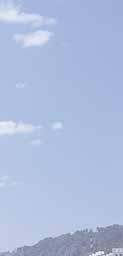


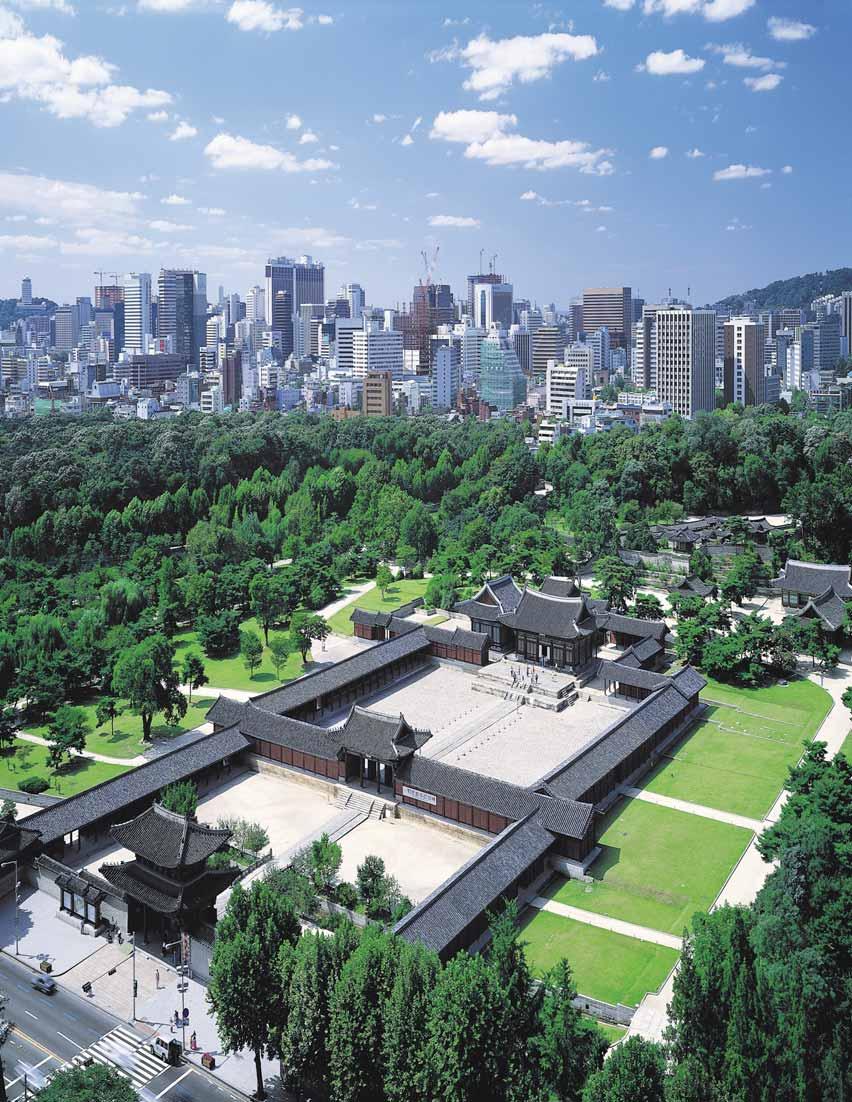
Lessons and Resources for K-12 Classrooms
Editor: Mary E. Connor

National Korean Studies
Korean Cultural Center Los Angeles
Seminar
Reviews of Teaching East Asia: Korea
“Fortunately, thanks to the excellent Teaching East Asia, Korea, Lessons and Resources for K-12 classrooms,instructors will find that with a minimal investment of time and energy, they can teach Korearelated units that are factually accurate, of interest to students, and relevant to the world in which we live….Developing such an excellent resource…was most likely no easy task, as special consideration had to be made so as to make sure that everything could be seamlessly integrated into a classroom while following the necessary standards, something that this work does very well ….(The book provides)... accurate and relevant information with practical applications on how to apply its lessons in a classroom setting in accordance with government-issued standards, often in creative and interesting ways. And considering that the e-book version of this text is freely available,any educator teaching K-12 who is interested in integrating Korea into their classes would find it well worth their time to have a look at this book.” (Franklin Rausch, Assistant Professor, Department of History and Philosophy (Lander University) Anextensive review of this book was published in Education About Asia (Spring, 2018).
Teaching East Asia: Korea by Mary Connor is a rich resource for educators at all levels. With her many years of experience as a teacher and advocate for revised teaching standards in California, she is uniquely qualified to guide the reader on incorporating Korea into the all levels of the K-12 curriculum. Ms. Connor shows how Korea can be included in not only history and social science units, but also how Korea's many contributions in science and technology, popular culture, arts, and literature can be used to help our students become more knowledgeable global citizens. I recommend this e-book for teachers who want to explore how they can bring Korea into their classroom, as well as for those who are looking for more in-depth materials at the more advanced levels. (Jennifer Jung-Kim, UCLA Center for Korean Studies and Department of Asian Languages & Cultures)
“Thank you for the terrific guide you have assembled on teaching about Korea. The sensitivity to skill development and content acquisition is superb. It’s a great collection. Congratulations on it and thank you for sharing a copy. We greatly appreciate it.” (Clayton Dube,
Director,
USC US-China Institute)
Teaching East Asia: Korea is a welcome resource for teachers wishing to include more breadth to their curriculum on East Asia by including Korea. Offering lessons and background material for all subjects, the resource is available not only in print, but also as a downloadable e-book: www.nationalkoreanstudies.org.(Roberta Martin, Director, Asia for Educators.(Columbia University)
Teaching East Asia: Korea is a very well-written resource book for K-12 teachers. This edition covers a diverse set of curriculum on Korean art, history, language arts, religion, science, technology, and Korean American identities. Best of all, the presentation materials help with implementing lesson plans. Ms. Connor has held many K-12 teachers’ workshops on Korean Studies over ten years at the University of Washington, Center for Korea Studies and her knowledge and devoted energy on this topic is tremendously reflected in this third edition. Congratulations! (Young Sook Lim, Associate Director, Center for Korean Studies, JSIS, University of Washington)
Teaching East Asia: Korea is such a great resource for Korean school teachers who teach Korean American students in the US where there are not many chances to learn about Korean history and culture. It covers a wide variety of subjects from literature to art and science, so students can gain a broader understanding of Korean culture. The presentation materials in the e-book are a gem. We distributed the book to local teachers at our annual teacher seminar and received great feedback. I am very excited that more instructors will be able to access these resources in the third edition and deeply thankful for Mrs. Connor’s dedication. (Rosa Kim, Principal, Silicon Valley Korean School)
4
Teaching East Asia: Korea and Korean American History
Lessons and Resources for K-12 Classrooms
Editor: Mary E. Connor
National Korean Studies Seminar
Korean Cultural Center Los Angeles
Publisher: National Korean Studies (http://www.koreanseminar.org)
Sponsor: Korean Cultural Center Los Angeles (http://www.kccla.org )
Photo Contributor: Korea Tourism Organization, Los Angeles (http://english.visitkorea.or.kr/)
Editor: Mary Connor, National Korean Studies (http://www.koreanseminar.org )
Project Director: Sung Soon Kim, National Korean Studies (http://www.koreanseminar.org )
Technical Support: Jini Shim, Assistant Seminar Director
Book Designers: In Hoe (Jessica) Chang, Multimedia Designer
Printing Company: EXCEL Printing USA
Copyright: April 2022
All rights reserved. No part of this publication may be reproduced for profit or use by an organization or university without the permission of the National Korean Studies Seminar. K-16 educators may reproduce the articles, lessons, and resources for personal or classroom use.
Although every precaution has been taken to verify the accuracy of the information contained herein, the editor and the publisher assume no responsibility for any errors or omissions. No liability is assumed for damages that may result from the use of the information contained within.
Mary Connor (maryconnor3838@gmail.com)
Sung Soon Kim (sungkim271@gmail.com)
Cover Photograph: Gyeongbokgung Palace buildings in Seoul, South Korea (Courtesy of the Korea Tourism Organization, Los Angeles)
Fourth Edition
Printed in the United States
About the Editor
Mary Connor taught United States history and Asian Studies for 35 years. She was President and Program Director of the Korea Academy for Educators from 2004 to 2012. Since 2014, she has served as the advisor to the National Korean Studies Seminar. Connor has organized nearly 100 days of workshops on Korea from coast to coast and published two library reference books (The Koreas: A Global Studies Handbook and Asia in Focus: The Koreas). She received the Republic of Korea’s Prime Minister’s Award and was recognized by the Korean Consulate General Los Angeles for her efforts to educate Americans about Korea. She has accepted awards from the Council of Korean Studies at Michigan State University, the Peace Corps Association, and the Organization of American Historians. Since 2009, Connor has served as an editor of Education About Asia, the leading journal for educators who teach about Asia.
Acknowledgements
I have many individuals to thank for assisting me over the past twenty years in pursuing my interest in Korean history and culture. I particularly want to express my gratitude to my husband, Gerry Fallon, for editing two library reference books and numerous articles that have appeared in educational journals. I appreciate the support of the Korean Cultural Center Los Angeles (KCCLA), the Korean Consulate General Los Angeles, and the Korea Society for my two fellowships to South Korea. I wish to thank Lucien Ellington, Editor of Education About Asia (EAA), for encouraging me to write The Koreas: A Global Studies Handbook and Asia in Focus: The Koreas and for publishing many of the articles, lessons, and reviews that I submitted to EAA. I am also very grateful to the many contributors who enriched this resource book.
Additionally, I would like to express my gratitude to Sangwon Jung, Director of KCCLA, for his sustained support and Daniel Kim, Education General Manager, the first person to suggest publishing this resource book for educators. I also wish to thank Sung Soon Kim, Project Director, who obtained the funding to make this book a reality and provided valuable assistance in the editing process. I also wish to thank our graphic designer, In Hoe (Jessica) Chang and Jini Shim for her major role in finalizing this edition of this book. The Executive Director of the Korea Tourism Organization in Los Angeles, Tae Shik Kim, and his staff provided the exquisite photographs contained in this publication. Ernest Lee, Executive Director of Korean Friendship Bell Preservation Committee, provided the historical information related to the Friendship Bell. It is my hope that teachers will not only bring Korea into their classrooms, but that some will also make plans to study, travel, and even experience teaching in Korea.
Teaching East Asia: Korea includes references to the California History-Social Science Framework. While each state has its own framework, I believe that the California Framework will be a very helpful and inspiring guide for educators throughout the United States.
Teaching East Asia: Korea is dedicated to the mutual friendship between the people of the United States of America and the people of the Republicof Korea and for the bond forged by their shared history and sacrifice.
Bell of Friendship (Korean Friendship Bell, San Pedro, California)

Enduring Legacy of Liberty, Friendship, and Peace
Inscribed on the surface of the massive bronze bell are these words that embody the spirit and purpose of presenting the Bell of Friendship to the People of the United States.
The people of the Republic of Korea present this bell to the people of the United States of America in celebration of the American Bicentennial Jubilee and in commemoration of Century of Friendship and Trust Between our two peoples.
The people of the United States have built upon the foundation of their pioneer spirit and aspiration for independence, a free and prosperous nation on a new continent.
Their achievements serve as an impetus and inspiration for the development of all mankind.The traditional amity between our two peoples has been established upon this shared faith in freedom and independence When Korea suffered under the yoke of foreign rule, the people of the United States came forward as encouraging friends With the victory of the United States in World War II, Korea’s unflagging patriotic struggle finally attained the goal of National Liberation.
In striving to preserve freedom, the United States and the Republic of Korea are inseparable allies linked by ties forged in blood. This is a fraternity of mutual trust, which shall remainforever unchanged.
May this bell ring and sound forth the hope and resolve of our two nations in their common devotion to enduring prosperity, liberty and peace.
Korean Friendship Bell, San Pedro, California (Courtesy of Ernest Lee, Executive Director, Korean Friendship Bell Preservation Committee)
The Bell of Friendship, also known as the Korean Friendship Bell or Korean Bell of Friendship, is a massive and intricately-decorated bell and pavilion that was donated in 1976 to the people of the United Stated by the people of the Republic of Korea to celebrate the bicentennial of the U.S. independence, honor veterans of the Korean War, and to consolidate traditional friendship between the two countries. The bell is patterned after the Bronze Bell of King Songdok, which was cast in 771 A.D. and is still on view in South Korea today.
The Korean friendship Bell was cast in Korea and then shipped to the United States. Weighing over 17 tons, with a height of twelve feet and a diameter of 7-1/2 feet, the bell is made of copper and tin, with gold, nickel, lead and phosphorous added or tone quality. As it had been the first time in over a millennium that a bell of this size had been cast, a team of nine bell masters were assembled to construct the Bell. They mobilized over 2,000 people to help with the construction and casting process. It took them two tries, as the first bell they cast cracked during a test ringing. The second bell was successfully cast and rung on the fourth of July, 1976 in Korea before it was shipped to its current location.
Four pairs of figures, each pair consisting of the Goddess of Liberty holding a torch, and a Korean representation of an angel, are engraved in relief on the body of the bell. Each of the Korean angels holds up a different symbol: a symbolic design of the Korean flag; a branch of the Rose of Sharon, Korea’s national flower; a branch of laurel, symbol of victory; and a dove of peace.
Professor Kim Se Jung is credited with sculpting the relief and other decorations on the exterior of the bell. The bell has no clapper, but is struck from the outside with a wooden log.
The bell is hung in a concrete and stone pavilion, that was constructed on the site by thirty craftsmen flown in from Korea and it took ten months to complete. The pavilion is supported by twelve columns representing the twelve designs of the Asian zodiac animals that stand guard at the base of each column.
On May 3, 1978, the City of Los Angeles designated the bell and the pavilion a Los Angeles Historic-Cultural Monument No. 187.The entire pavilion structure was initially painted white, but colorful “dan-cheong” decorations were added in 1982 to commemorate the centennial of opening the U.S.
Korea diplomatic relationship in 1882.
In 2013, the bell and the pavilion underwent an extensive restoration process. A twelvemember crew of artisans and craftsmen flew in from Korea and worked on site for four months to restore the bell and the pavilion. It was rededicated during a special ceremony on January 10, 2014. Resting peacefully at the grassy knoll overlooking the Port of Los Angeles from which U.S. troops sailed to the Pacific, the bell site grants an unsurpassed 270 degrees view of the Los Angeles harbor, the Catalina Channel and the sea terraces of San Pedro hill.
The site, a part of US Military base known as the Upper Reservation of Fort MacArthur, bears another interesting connection to Korea. The fort was named after Lt. General Arthur MacArthur, whose son, Marshall Douglas MacArthur, led the US Forces in the Pacific against Japan during World War II and he commanded the UN Forces to defend the Republic of Korea against communist North Korea during the Korean War.
The bell is officially rung only five times each year: the Fourth of July, August 15 (Korean Liberation Day) and New Year’s Eve, January 13 (Korean American Day) and every September to coincide with bell ringing around the country to celebrate Constitution Day.
–
Contents
(Kindergarten to Grade 12 and Beyond)
Chapter 1 History and Culture
Map of Korea
Korea and the 2016 History Social Science Framework for Grades K-12 (Includes references to lessons and resources for all grades)
Chronological Table (China, Japan, Korea and Other Civilizations)
Brief Time Line of Korean History with Explanation about Romanization
Teaching Early Korean History, Silla and the Silk Road (Teaching the Silk Road is included in the California History-Social Science Framework on the secondary level)
Was Silla Part of the Silk Road? Why Study Silla? A Case Study in Creativity
Where to Include Silla Korea and Teaching the History and Significance of the Silk Road
Silla Korea and the Silk Road: Golden Age, Golden Threads (An e-book located on the Korea Society website or by a Google search using the title)
Research Projects on the Silla Dynasty (57 BCE-935 CE), (secondary)
Four Famous Koreans (for upper elementary through high school) The lesson includes an introduction and a bibliography)
Values Lesson: How Currency Reveals Cultural Values (upper elementary and secondary)
Korea in Global Perspective; The Mongols and Korea (secondary)
Admiral Yi Sun-Shin, The Turtle Ships, and Modern Asian History (high school)
Bringing Korea into the Curriculum for United State, World, and European History (Advanced Placement World History)
Japanese Occupation of Korea (1910-1945)
(Background information for European History, World History, and United States History)
17
3-99 3 4-11 12-13
14-15 16
18-23 24 25-30 31-36 37-40 40-41 42-48 49-52 53-56
Japanese Occupation of Korea and Its Legacy
(Document-based essay question (European History, World History, and United State History)
The Korean War, Document-based essay question (World History and United States History)
A State of Mind (North Korea) Documentary Video, Netflix, and two segments on You Tube (secondary)
Tears of Blood (North Korea), (secondary)
Economic Development and the Democratization of South Korea (World History)
Korea’s Economic Development: A Document-Based Essay (Advanced Placement World History and 12th grade Economics
History Today Talk Shows: East Asia Today (World History, United States History)
Bringing Asian Culture in the Classroom (elementary, secondary and school assemblies)
Bringing Korea Film into Class (elementary and secondary)
Korea
History:
Korean Etiquette Chapter 2 Language Historical Background
on the Korean Language Characteristics of the Korean Language Romanization Simple Korean Expressions Korean Vowels Korean Consonants Korean Compound Vowels Hangeul Chart: Combination of
Vowels and
Vowels Making Korean Letters Using Consonants and Vowels 57-61 62-66 67 68-69 70-77 78-83 84-86 87-88 93-94 95-96 97-99 103-113 103-104 105-106 107 108 109 110 111 112 113
in World
Key Issues in Asian Studies (book review)
and Information
14
10
Chapter 3 Korean Literature and Lessons for All Grades
Bee-bim Bop! (elementary)
The Name Jar (elementary)
Dear Juno (elementary)
The Firekeeper’s Son (elementary)
The Kite Fighters (elementary)
Good Fortune in a Wrapping Cloth (elementary)
A Single Shard (upper elementary and middle school)
Seesaw Girl (elementary and middle school)
A Bully in the Classroom: Teaching Our Twisted Hero: A Modern Classic (secondary)
Lost Names (Japanese Occupation of Korea), high school)
Teaching Lost Names (middle and high school)
Brother’s Keeper (inspirational story about a courageous girl during the Korean War) (middle and high school)
Waxen Wings (anthology of short fiction for high school)
Pachinko (adults)
Reading and Writing Sijo Poetry (secondary)
Chapter 4 Korean Art for All Grades
A Study of Korean Art and Architecture: Opportunities for Research (secondary)
A Comparative Study of East Asian and American Landscape Paintings (secondary Art and Advanced Placement Art History students)
Korean Folk Art (elementary and secondary)
Symbolism in Korean Folk Art (elementary and secondary)
Art Lessons
(The Tiger and the Magpie for the celebration of the Korean New Year, Korean Ducks (for weddings) and the Dragon (keeps the evil spirits away), (all ages)
117-167 117 118-119 120-121 122-123 124-130 131-133 134-137 138-142 143-146 147-149 150-154 155-156 157-158 159-160 161-167 171-194 171-176 177-181 182-184 185 186-188
Art and Technology: Nam June Paik (secondary and Advanced Placement Art History)
Installation Art and Choi Jeong Hwa (a possible school-wide project, all grade levels)
Creating Korean Bojagi in the Classroom (refer to the lesson on Good Fortune in a Wrapping Cloth)
Chapter 5 Music and the Korean Wave
Korean Traditional Music (background information for music teachers)
Arirang, Korea’s Most Famous Folk Song (all ages)
Arirang Musical Score (all ages)
Arirang, Two Versions in English (all ages)
Korean Wave: Korean Pop Culture Phenomenon (secondary)
Chapter 6 Religion and Philosophy
Korean Spirituality
Korean Religions
The Founders of the United States and Confucius
Korea and Confucianism (lesson for middle and high school students)
Korea and Buddhism (lesson for middle and high school students)
Chapter 7 - Science and Technology
Science and Technology: The Past (secondary)
Science and Technology: The Present (secondary)
189 190-191 192-194 197-211 197-201 202-203 204 205 206-211 215-235 215 216-224 225 226-231 232-235 239-244 239-242 243-244
Chapter 8 Korean American History
Inclusion of Korean American History, 2016 California History-Social Science Framework
A Concise History of Korean Americans and Resources, Edward T. Chang, Ethnic Studies, UC Riverside
Chapter
A Short List of Highly Recommended Books
Teaching East Asia: Korea, Editor, Mary Connor, A review by Franklin Rausch
9 Tourism Tourism in South Korea: Places to Visit
Chapter 10 Resources
A Partial List of PowerPoint Lectures on the National Korean Studies Website Websites: List of Highly Recommended Sites
in Focus:
Permission to Publish 247-258 247-250 251-258 261-267 261-267 271-283 271 272-273 274-281 282-283 284 285
Asia
The Koreas, Editor, Mary Connor, A review by Todd Golding
Replica of Admiral Yi Sunsin’s turtle boat, Korean War Museum, Seoul (Courtesy of Justin Lee at http:// tinuyurl.com/) One of the greatest heroes in Korean military history, Admiral Yi and his famous turtle boats defeated the Japanese in 1592. With only twelve ships in his fleet, the admiral was able to destroy over three hundred of his enemy’s ships. As the Japanese retreated, Yi Sunsin was killed by a stray bullet.
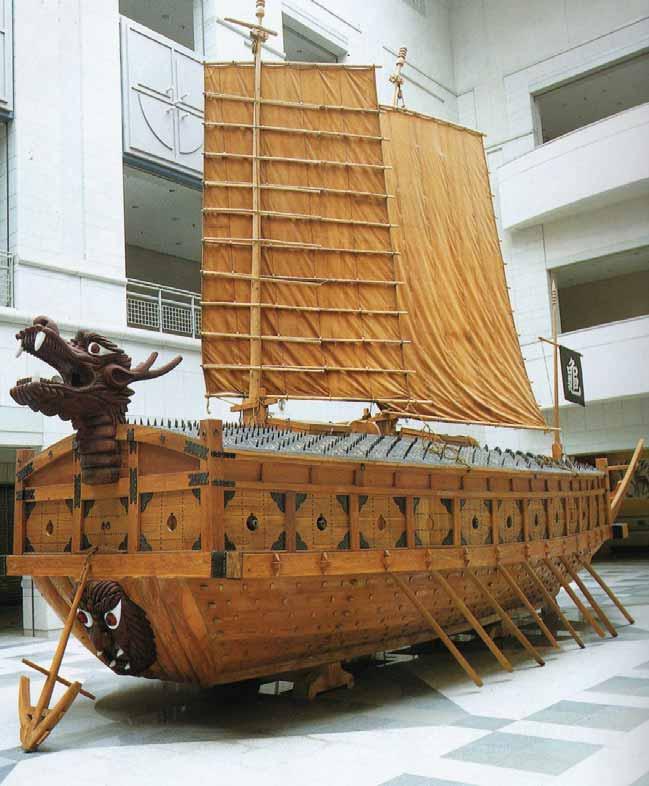
Chapter 1 History and Culture

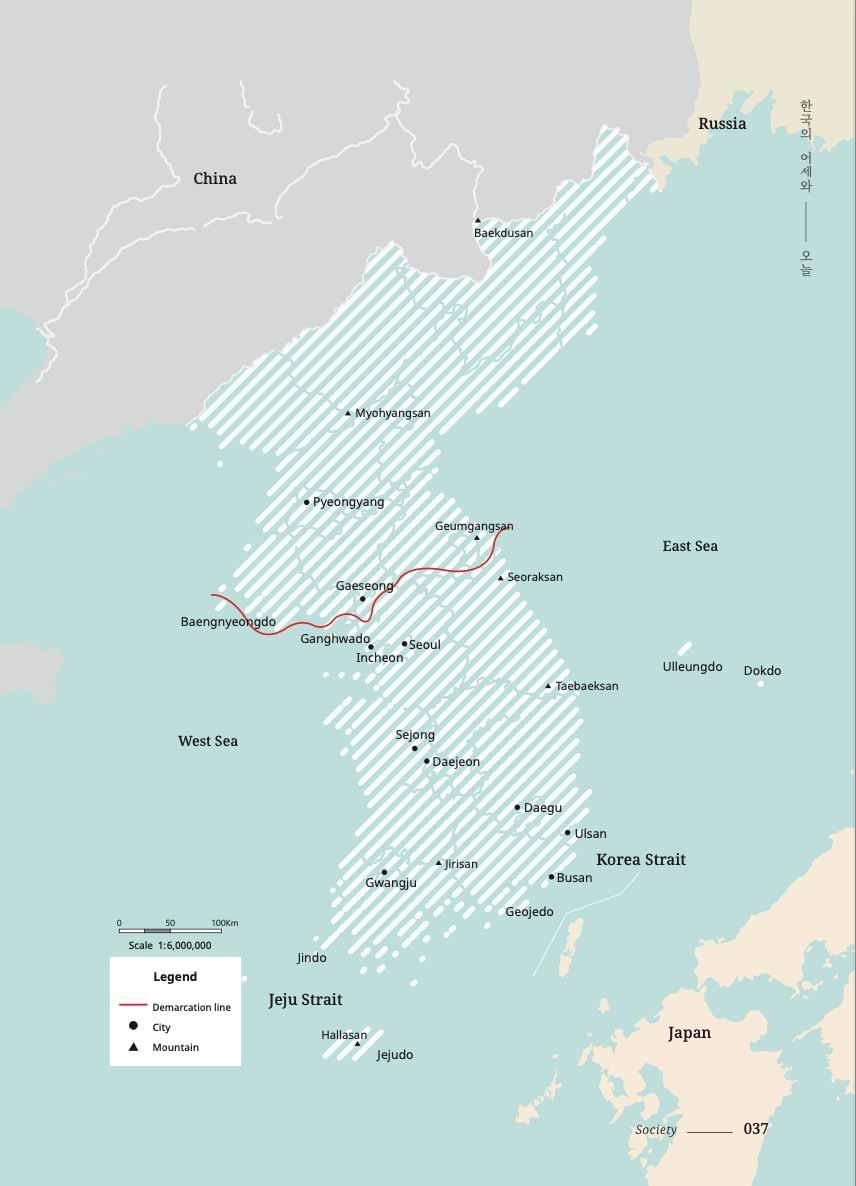
3
Teaching East Asia: Korea
Lessons and Resources for K-12 Classrooms
Standard K.1 Students understand that being a good citizen involves acting incertain ways.
a. To support ideas of good citizenship, teachers could introduce stories, fairy tales, and nursery rhymes that incorporate conflict and raise values that are both interesting and understandable for young children. This would be an opportunity to read Korean folktales that reveal Confucian values on respect and benevolence, filial devotion, and loyalty. See www.kscpp.net for book or audio book, Chung Hyo Ye (Tales of filial devotion, loyalty, respect and benevolence from the history and folklore of Korea) and/or www.KoreaSociety.org,Korean Studies, Monographs and Lesson Plans, Introduction to Korea through Art and Folk Tales (Lessons for K-6 grades).
b. Students further their study of good citizenship by learning about people who exhibit honesty, courage, determination, individual responsibility, and patriotism in American and world history. Teachers may introduce students to important historical figures who exhibit these characteristics such as King Sejong and Admiral Yi. See lesson on Four Famous Koreans and books on King Sejong, Admiral Yi, and Queen Seondok available through Korean Spirit and Culture Promotion Project (www.kscpp.net.). You may see the links to download these books on the website section of the book.
Standard 1.4 (3) Recognize similarities of earlier generations in such areas as work (inside and outside the home), dress, manners, stories, games, and festivals, drawing from biographies, oral histories, and folklore.
This allows for stories from parents and grandparents on what life was like at an earlier time.
Standard 1.5 (3) Compare the beliefs, customs, ceremonies, traditions, and social practices of the varied cultures, drawing from folklore.
Grade One Standards recommend Frances Carpenter’s Tales of a Korean Grandmother and Cinderella stories from varied cultures. This allows for the inclusion of “The Korean Cinderella” by Shirley Climo. Refer also to suggestions for Kindergarten.
Quality literature books may be shared to help students acquire deeper insights into life in the 4
past and the cultures from which the families came: the stories, games, and festivals parents or grandparents might have enjoyed as students.
Standard2.1 (1) Trace the history of a family through the use of primary and secondary sources, including artifacts, photographs, interviews, and documents.
Standard 2.1(2) Compare and contrast their daily lives with those of their parents, grandparents, and/or guardians.
Students may share family photographs, artifacts, and interview their parents and grandparents. They can locate on a map where their ancestors lived, describing when their Korean family came to America, and how and why they left Korea.
Standard 2.5 Students understand the importance of individual action and character and explain how heroes long ago and the recent past have made a difference in others’ lives. (This will allow for an opportunity for students to learn about famous Korean Americans past and present.)
Dear Juno
Teaching East Asia: Korea includes a lesson on Dear Juno.
Standard 3.3 (1) Research the explorers who visited here, the newcomers who settled here, and the people who continue to come to the region, including their cultural and religious traditions andcontributions.
Standard 3.3 (3) Trace why their community was established, how individuals and families contributed toits founding and development, and how the community has changed over time, drawing on maps, photographs, oral histories, letters, newspapers, and other primary sources.
Explain the first Korean immigrants and their settlement in Hawaii and the mainland. See http://arirangeducation.com/main. Accessing this site will provide an interactive classroom activity with lessons about Korean American history. The DVD of the Arirang’s classroom activity can be purchased. Teaching East Asia: Korea includes a chapter on Korean Americanhistory.
If a school is located in a Koreatown, there isan opportunity to examine the growth of this area and the Korean American experience. See Amazon.com for Katherine Kim’s Los Angeles’s Koreatown.
Standard 4.4 (3) Discuss immigration and migration to California between 1850 and 1900, including the diverse composition of those who came; the countries of origin and their relative locations; and conflicts and accords among the diverse groups (e.g., the 1882 Chinese Exclusion Act).
Standard 4.4 (4) Describe rapid American immigration, internal migration, settlement, and the
5
growth of towns and cities (e.g. Los Angeles).
The history of California is rich with ethnic, social, and cultural diversity, economic energy, geographic variety, and growing civic community. The study of California history inthe fourth grade provides students with foundational opportunities to learn in depth about their state, including the people who live here, and how to become engaged and responsible citizens.
This clearly allows for teaching Korean American history and showing the Arirang Classroom DVD that includes four lessons and interviews. See http://arirangeducation.com/main Teaching East Asia: Korea incorporates a chapter on Korean American history.
Standard 5.5 Students explain the causes of the American Revolution
Students could compare the American Independence Movement with the Korean Independence Movement.
Standard 5.8 Students trace the colonization, immigration, and settlement patterns of the American people from 1789 to the mid-1800s, with emphasis on the role of economic incentives, effects of the physical and political geography, and transportation systems.
Teaching East Asia: Korea includes a chapter on Korean American history.
Standard 6.6 (3) Know about the life of Confucius and the fundamental teachings of Confucianism and Daoism.
Standard 6.6 (7) Cite the significance of the trans-Eurasian “silkroads” in the period of the Han Dynasty (206 B.C.E. – 220 C.E.) and Roman Empire (27 B.C.E.-476 C.E.) Since the Silk Road began in ancient times and began to play a significant role in trade and travel as early as 100 BCE, students could view selected segments of Silla Korea and the Silk Road on the Korea Society’s website (See Chapter on Resources).
Students can learn how China influenced Korea’s Three Kingdoms: Goguryeo (37 B.C.E.-668 C.E.), Baekche (18 B.C.E – 660 C.E.) and Silla(57 B.C.E. – 935 C.E.). The silk industry reached Korea with the arrival of Chinese immigrants in 200 BCE. Buddhism and Confucianism were transported to Goguryeo and Baekche from China in the 4th century CE. In the 5th century Silla adopts Buddhism as a state religion. Throughout the lifetimes of the Three Kingdoms and 6
afterwards Korea maintained a close relationship with China. Each kingdom eagerly sought cultural innovations from China yet retained distinct cultural elements unique to it.
Teaching East Asia: Korea incorporates a lesson onConfucianism (See Chapter on Religion and Philosophy) that could be adapted for use in six grade classrooms. Students will learn that Confucianism still has a strong influence in Korea and continues to influence the Koreans who live in the United States. Teaching East Asia: Korea also includes an article titled “The Founders of the United States and Confucius.”
All of the following Standards allow for the inclusion of Korean history and culture:
Standard 7.3 (1) Describe the reunification of China under the Tang Dynasty and reasons for the spread of Buddhism in Tang China, Korea, and Japan.
Standard 7.3 (2) Describe agricultural, technological, and commercial developments during the Tang and Song periods.
Standard 7.3 (3) Analyze the influences of Confucianism and changes in Confucian thought during the Song and Mongol periods.
Standard 7.3 (4) Understand the importance of both overland trade and maritime expeditions between China and other civilizations in the Mongol Ascendancy and Ming Dynasty.
Standard 7.3 (5) Trace the historic influence of such discoveries astea,the manufacture of paper, wood-block printing, the compass, and gunpowder.
Korea
Under the Tang dynasty, China expanded its trade and cultural influence to Japan, and Southeast Asia. At sites of encounter, these societies adopted and adapted Chinese ideas and institutions and combined those with their own ideas and institutions to build distinct civilizations. In the fourth century, three kingdoms emerged to rule the population, and in 676, one of those kingdoms, Silla, unified the whole peninsula. Silla was closely connected to the Tang dynasty of China. elites used Chinese as a written language, but later devised a phonetic script for the language called Hangul. In 936, the Koryo kingdom took over rule in and adopted a civil service exam system similar to that of China. merchants were engaged in trade with Japan and China, and through those networks, to Indian Ocean and Afroeurasian trade networks as well. The Korea Societ y PowerPoint, “ ,” has images and archaeological evidence that provide opportunities for students to analyze cultural interaction and trade across Eurasia. To locate the PowerPoint, access www.koreasociety.org or Silk Road PowerPoint lectures at www.koreanseminar.org.
In a similar manner, Japan was influenced by China and but adapted outside institutions and ideas to fit with its own indigenous culture… Between the third and sixth centuries, when China was politically fragmented, many Chinese and migrated to Japan in search of refuge or opportunity. Those newcomers introduced many innovations, including advanced
7
metallurgy, writing, silk production, textile manufacture, paper-making, and Buddhism. China’s immense power under the Tang Dynasty stimulated Japanese interest inChinese and culture. Literary scholars, officials, and Buddhist monks traveled to Japan. In turn, Japanese intellectuals went west to seek knowledge, learn Confucian statecraft, and acquire Buddhist texts, some made in with some of the earliest known wood-block printing technology. From about 1000 CE, the Japanese aristocratic class creatively combined Chinese and ideas with Japanese ways to form a new civilization with distinctive institutions, literature, and arts. Exchanges with China and grew, as merchants traded luxury goods in return for Japanese silver, copper, timber, and steel swords. By 1300, East Asia was an interconnected region dominated economically and culturally by China.
Teaching East Asia: Korea incorporates the following lessons that relate to history from 500
1789): (“Four Famous Koreas”) about Queen Sondok (reign 632-647) and King Sejong (reign 1419-1450) and a lesson (“Values Lesson Plan”) that reveals Korean cultural values, particularly the value of being well educated. There are lessons (Research Project: Silla and Science and Technology: The Past) that include information on Korea’s wood-block printing technology and the invention of moveable type 200 years before Gutenberg. The book also includes lessons and information on a Power Point lecture on the Silk Road and how early Korea influenced Japan. There are several lessons on Silla (57 BCE- 935 CE) in the art, history, and science chapters. Lessons also relate to the following: 1) Unified Silla experienced a golden age for its achievements and for a time, along with Tang China, was probabl y more advanced than any area of Europe except for the Byzantine Empire. What did Unified Silla achieve and how might this have been possible? 3) After viewing the Korea Society’s PowerPoint lecture and reading an article on the Silk Road, students will examine how Unified Silla experienced a period of early globalization. What were the probable challenges and benefits for the people of Silla? What are the challenges and benefits of globalization today? 4) What were Korea’s early achievements in printing? How were they remarkable? (See Science and Technology chapter)
Standard 8.12 (7) Identify the new sources of large-scale immigration and the contributions of immigrants tothe building of cities and the economy; explain the ways inwhichnew social and economic patterns encouraged assimilation of newcomers into the mainstream amidst growing cultural diversity; and discuss the new wave of nativism.
The Framework discusses the waves of immigrants and migrants to the American West inthe 19th century.
Teaching East Asia: Korea has a chapter on Korean American history that contains information on two famous Koreans, such as Ahn Chang Ho (Korean Independence Movement) and Young Oak Kim (World War II hero who led the famous 100th Infantry Battalion of the U.S. Army).
–
8
There is no listed course on Asian Studies in the California History-Social Science Framework. There are few schools (public or private) in California that offer courses in Asian Studies. Some schools are listed as having Asian Studies, but upon contacting many of these schools most responded that they are no longer teaching Asian Studies. If they claim to be teaching Asian Studies, itis usually within a geography class, such asAdvanced Placement Human Geography. The more than two hundred and fifty year period covered by the tenth grade course highlights the intensification of a truly global history as people, products, diseases, knowledge, and ideas spread around the world as never before.
Standard 10.4 (2) Discuss the locations of the colonial rule of such nations as England, France, Germany, Italy, Japan, the Netherlands, Russia, Spain, Portugal, and the United States.
Standard 10.4 (3) Explain imperialism from the perspective of the colonizers and the colonized and the varied immediate and long-term responses by the people under colonial rule. Since Japanese colonial rule is mentioned, this provides an opportunity to include the ) and the possible adoption of either Linda Sue Park’s When MyName was Keoko or Richard Kim’s Lost Names for World History or Language Arts classes
Standard 10.9 (3) Understand the importance of the Truman Doctrine and the Marshall Plan, which established the pattern for America’s postwar policy of supplying economic and military aid to prevent the spread of Communism and the resulting economic and political competition in areanas such as Southeast Asia (i.e. , Vietnam War, Cuba, and Africa). Korea isnot mentioned in the revised Framework for 10th grade, but it can be taught since the Korean War is mentioned inthe Standards.
Standard 10.11 Students analyze the integration of countries in the world economy and the information, technological, and communications revolutions (e.g. television, satellites, and computers).
- Appeasement of Hitler finally came to an end when Germany invaded Poland on September 1, 1939, and World War II began in Europe. By then, Japan, an imperial power thathad already colonized in 1910 and occupied Manchuria in1931, invaded China.
The 2016 Framework makes reference for the first time to the a euphemism that describes women who were forced into sexual service by the Japanese Army in occupied territories before and during the war. “Comfort Women” can be taught as an example of institutionalized sexual slavery; estimates on the total number of comfort women vary, but most argue that hundreds of thousands of women were forced into these situations during Japanese occupation. On December 28, 2015, the Governments of Japan and the entered into an agreement regarding the issues of comfort women. This document canbe found at http://www.mofa.go.jp/a_o/na/kr/page4e_000364.html.See lesson on occupation.
A new reference to Korea in the 2016 Framework is as follows: Although globalization has bound societies together in ties of mutual interdependence, it has also involved the spread of multinational corporations whose activities far transcend the jurisdictions of individual nation- 9
states…. Apple’s iPod, for example, is designed in northern California and assembled in China, out of components that originate inJapan, Taiwan, Singapore, and many other countries. A leading example of “modular” production, the iPod’s cosmopolitan origins reflect the new realities of the integrated twenty-first century economy.
The revised framework also states the following: China, Singapore, Hong Kong, and Japan) has become a notable economic success story.
Teaching East Asia: Korea incorporates lessons in the history chapter on late 19th century imperialism, Japanese occupation, a document based lesson on the Korean War, and a documentbased-lesson on economic and technological development. Teaching East Asia: Korea includes a lesson that reveals Korean cultural values (“Values Lesson Plan”) andthe emphasis that Koreans and Korean Americans place on education.
Standard 11.7 Students analyze America’s participation in World WarII.
Standard 11.9 Students analyze U.S. foreign policy since World War II.
Standard 11.9 (3) Trace the origins and geopolitical consequences (foreign and domestic) of the Cold War and containment policy. (The Korean War is one of seven developments listed)
A majority of the American prisoners were later transported in the hulls of unmarked vessels termed as “Hell Ships” to Japan, China, Formosa and where they worked as slave laborers.
Students examine the nuclear arms race and buildup, Berlin blockade and airlift, United Nations’ intervention in , Eisenhower’s conclusion of the , and his administration’s defense policies based on nuclear deterrence and the threat of massive retaliation, including the CIA-assisted coup in Iran as part of early Cold War history. The framework recommends two books based on oral histories, memoirs, and other primary sources that represent soldiers’and refugees’ experiences during the Linda Granfield’s I Remember Korea, and Rudy Tomedi’s NoBugles, No Drums.
Teaching East Asia: Korea incorporatesa document-based essay on the Korean War.
Standard 12.9 Students analyze the origins, characteristics, and developments of different political systems across time, with emphasis on the quest for political democracy, itsadvances andobstacles.
Standard 12.9 (5) Identify the forms of illegitimate power that twentieth century African, Asian,
10
and Latin American dictators used to gain and hold office and the conditions and interests that supported them.
Standard 12.9 (8) Identify the successes of relatively new demo cracies in Africa, Asia, and Latin America and the ideas, leaders, and general societal conditions that have launched and sustained, or failed to sustain them.
Students can utilize what they learned in grade ten about communism, the Russian Revolution, the dictatorship of Joseph Stalin, and the expansion of Soviet power after World War IItorecall the components of non-elected government in twentieth-century Russia…. Students can also address authoritarian regimes in recent times places like Cuba, Laos, Vietnam, Sudan, Syria, and China, with attention to similarities and differences from one another, such as the need for control of information, and the difficulties such regimes face in maintaining control of information given modern technology, such as the Internet and cell phones.
Attention also should be given to historical and contemporary movements that overthrew tyrannical governments and/or movements toward democratic government in countries such as Spain, Poland, Mexico, Argentina, Chile, the Philippines, ,Guatemala, El Salvador, South Africa, Turkey, and Egypt. However, as each case illustrates, democracy is a process and must be understood on a spectrum and in its own geopolitical and temporal context.
Teaching East Asia: Korea includes instructionsfor History Today news shows that allow for students to investigate issues related to Japanese occupation and current tensions among East Asian nations.
12.6Students analyze issues of international trade and explain how the U.S. economy affects, andis affected by economic forces beyond the borders of the United States.
Teaching East Asia: Korea includes a document-based essay on South Korea’s economic and technological development. The book also includes information on South Korea’s scientific and technological achievement.
Apple’s iPod, for example, is designedin northern California and assembled inChina, out of components that originate in Japan, Taiwan, , Singapore, and many other countries. A leading example of “modular” production, the iPod’s cosmopolitan origins reflect the new realities of the integrated twenty-first century economy.
Overseas markets have been even more vital to the growth of smaller “PacificRim” economies such as Singapore, Taiwan, and in the 1980s and 1990s. In contrast to China’s experience, economic growth and market reforms in these countries coincided with political reform.
Teaching East Asia: Korea includes a document-based essay on South Korea’s economic and technological development and states how it compares to other Asian countries that have experienced rapid economic development.
11
Paleolithic Age
Neolithic Age
Bronze Age Jomon Culture Sumer and Egypt
Dan’gun Shang Dynasty
Zhou Dynasty
Bronze Age Iron Age Greek Civilization
Founding of Rome
Iron Age Confucius Buddha
Old Joseon Qin Conquest Bronze Age Alexander the Great
Western Han Dynasty
Three Kingdoms (traditional dates):
Silla 57 B.C.E. – 935 C.E.
Goguryeo 37 B.C.E. – 668 C.E.
Baekje 18 B.C.E. – 660
Confucianism established
Kaya(42-564) Xin Dynasty
Eastern Han Dynasty
Three Kingdoms
Jin Dynasty Iron Age
Buddhism recognized in Goguryeo (372)
Buddhism recognized in Baekje (384)
Jesus Christ
Northern and Southern Fall of Rome (410) Dynasties
Kaya absorbed Sui Dynasties Asuka Period by Silla (532-562)
Buddhism recognized in Silla (ca.535) Buddhism recognized in Japan (552)
Balhae (698-926) Tang Dynasty Nara Period Mohammed Unified Silla (668-935)
Oldest woodblock print (ca.751) Heian Period
Charlemagne
Goryeo (918-1392) Song Dynasty
First Crusade
Kamakura Period begins
Mongols invade Korea Yuan Dynasty (1271)
Movable type (1234)
Yuan Dynasty ends (1368) Marco Polo
12
Oldest Extant Movable Type Book (1377)
Joseon (1392-1910) Ming Dynasty Ashikaga Pd. Gutenberg
Hangeul (1446) Columbus 1492
Hideyoshi Invasions Momoyama Martin Luther
Manchu Invasion Qing Dynasty Tokugawa Pd. Thirty Years’ War
Sirhak scholars
American Revolution
Western Learning Opium War Perry opens Japan
Kanghwa Treaty(1876) Taiping Rebellion Meiji Restoration American Shufeldt Treaty(1882) Japan defeats China Civil War
Tonghak Rebellion(1894)
Kabo Reforms (1894-1896)
Independence Club(1896) Taft-Katsura Treaty (1905)
Boxer Rebellion Russo-Japanese War
Annexation by Japan (1910)
Qing ends 1912 Rule of Korea (1910-1945)
World War I
March First Twenty-One Fourteen Points Movement (1919) Demands
Great Depression Japan seizes Manchuria
Civil War China World War II
Division of Korea (1945) Cold War begins U.S./U.S.S.R. occupation (1945-1948) (1945) U.S. occupation of Japan
Republic of Korea (1948)
Democratic People’s Republic of Korea (1948)
People’s Republic of China (1949) Indo-China War
Korean War (1950-1953)
Miracle on the Han (1960s)
Seoul Olympics (1988)
Death of Kim Il Sung(1994)
Asian Economic Crisis (1997)
June Summit between North and South Korea (2000)
War in Vietnam
End Cold War (1989)
13
Romanization is the translation of sounds of a foreign language into English letters. Our English alphabet does not have sufficient symbols to cover the Korean sound system. It is not possible to convey the exact Korean pronunciation by means of the English alphabet.
Romanization of Korean words allows those who cannot read Korean to phonetically pronounce it. There are two systems of rules of Romanization for transliterating from Korean to English. One system, McCune-Reischauer, was adopted in 1984. Another system was recommended more recently by the Korean government. This chart will first mention the newer system followed by the McCune-Reischauer system.
Ancestors of Koreans migrated into the peninsula around 4,000 B.C.E.
Creation myth – Tangun (Dangun) and Mt. Paektu
Three Kingdoms Period: Goguryeo, Baekje, and Silla (Koguryo, Paekche, and Silla) (Tributary system with China/constant warfare between the three kingdoms)
Silla Kingdom (57 B.C.E. - 935 C.E.) - and
Shamanism, Buddhism and ConfucianismSilk Road (migrations and trade with the Middle East, India, China and Japan)
Four Famous Koreans
With unification the groundwork for a national culture is established Silk Road trade flourishes.
Gyeongju (ancient capital) and royal tombs (Kyongju)
Bulguksa and Sokkuram Grotto (Pulguksa)
Buddhism influence very strong
Construction of Haeinsa
Publication of Buddhist scriptures 1087
13th century – movable type
Oldest existing book in world printed on metal type – 1377
Celadon
Mongol Invasions
(1418-1450) Korea’s greatest king -
The Firekeeper’s Son, Good Fortune in a Wrapping Cloth, The Kite Fighters, and Seesaw Girl
–
14
Hangeul
Rise of Neo-Confucianism
Women’s position declines
Hideyoshi invasions – 1592
Admiral Yi Sun-sin and the turtle boats
Manchu invasions – 17th century
Hermit Kingdom – policy of isolation in response to the Japanese and Manchurians (17th-19th -century)
Practical Learning and Tonghak Movements grow in responses to Korea’s economic, political and social problems. Folk Culture evolves/music, art, dance
Catholicism arrives in 18th century
Japan (1876) forces Korea to open to trade
U.S. Treaty of Friendship – Shufeldt Treaty (1882)
Protestant missionaries
1895 – Japan defeats China
1905 – Japan defeats Russia
1905 – Portsmouth Treaty (Teddy Roosevelt)
1905 – Taft Katsura Agreement
1910
Annexation of Korea by Japan -
1910-1945 Japanese Colonial period -
1945 – Division of Korea
1948 – Creation of the Republic of South Korea and the Democratic People’s Republic of North Korea (DPRK)
1950-1953 Korean War - and Brother’s Keeper (Literature chapter)
1960s/1970s – Rapid economic growth –
1966-1973 – Korean soldiers fight in Vietnam
1948-1961 First and Second Republics (Syngman Rhee)
1948-1994 – Kim Il Sung (DPRK)
1963-1979 Third and Fourth Republics (General Park Chung Hee)
1980-1988 Fifth Republic (General Chun Doo Hwan)
1988-1993 Sixth Republic (Roh Tae Woo) – democratic reforms and membership in the United Nations
1994 Death of Kim Il Sung and Kim Jung Il assumes leadership at a later date
1993-1998 Civilian Government, Kim Young Sam
1998- 2003 Kim Dae-jung
2000 Summit Meeting between Kim Dae-jung and Kim Jung Il in Pyongyang A State of Mind Lesson
2003-2008 Roh Moo-hyun, President of South Korea
2008-2013 Lee, Myung-bak, President of South Korea
2011 - Kim Jong-un, leader of North Korea
2013-2017 Park Geun-hye, President of South Korea
2017- 2022 Moon Jae-in, President of South Korea
2022- Yoon Suk-yeol, President of South Korea
–
15
Early Korean History: Silla Korea (57 B.C.E-935 C.E.) and the Silk Road
“Silla survived for nearly 1,000 years and for a period of time, and along with Tang China, was more advanced than probably any area of Europe except for the Byzantine Empire” (Asia in Focus: The Koreas)
The Lesson: Silla Korea and the Silk Road (Grades: 7, 9 and 10)
Subjects: Ancient History, Asian Studies, Geography and World History
Time: Two or more class periods
Objectives: 1. Prove how Korea was part of the Silk Road. 2. Present an Eastern instead of a Western view of the Silk Road trade and a time period that produced one of the world’s “Golden Ages.” 3. Provide an understanding of the circumstances that help to create a “Golden Age.” 4. Recognize that many of today’s issues related to globalization were also present for past cultures. 5. Provide an opportunity for students to understand the impact of globalization on their own lives and their country.
The following pages together with a PowerPoint lecture (Silla Korea and the Silk Road: Globalization Then and Now) and the Korea Society’s PowerPoint lecture (Silla Korea and the Silk Road) can be downloaded (http://www.koreanseminar.org). These resources will show Korea’s integral involvement in Silk Road trade, the transmission of Silk Road ideas and goods, and their possible impact at the time. They will facilitate achieving the objectives of the lesson. The Globalization PowerPoint is appropriate for secondary students and available with our materials at this resource site.
The 2016 California History-Social Science Framework recommends a study of the Silk Road and the use of the Power Point lectures for the “images and archaeological evidence that provide opportunities for students to analyze cultural interaction and trade across Eurasia.” The Korea Society’s eBook, Silla Korea and the Silk Road: Golden Age, Golden Threads, provides additional information (http://www.koreasociety.org) or more easily accessed by using Google search.
For homework and discussion: Ask your students where their cars, cell phones, clothing, computers, shoes, and household possessions are made. What languages are spoken in their homes and neighborhoods? What types of food do they enjoy? What developments have occurred that have particularly influenced their lives? What are the benefits and challenges of globalization in terms of their own lives? What are the current challenges of globalization for the United States? Class discussions will help prepare students for the PowerPoint lecture titled Silla Korea and the Silk Road: Globalization Then and Now. (The Korea Society has given permission to include pages from Silla Korea and the Silk Road: Golden Ages, Golden Threads).
In various periods in world history, opportune meetings of trade and talent have created golden ages of literature and thought. Examples include the golden age of Athens, Greece, Renaissance Italy, and Elizabethan England. While historians have focused on Renaissance Italy as an example of a civilization with access to new routes of open trade, little has been done to show the ways in which earlier trade routes stimulated other cultures into an era of unprecedented cultural and philosophical development. Silla represents an Eastern version of a golden age which flourished in part as the result of trade and cultural exchange.
What makes Silla unique? Early Korean history depicts constant tension with its large neighbor China, and Silla’s history is marked by both accommodation and resistance to Chinese influence. By the fifth century, the Korean Peninsula was divided into the Three Kingdoms—Koguryo (37 BCE–668 CE), Paekche (18 BCE–660 CE) and Silla (57 BCE–668 CE). Of the Three Kingdoms, Koguryo had the greatest military skill and bore the brunt of repelling Chinese attempts to conquer the Korean peninsula. It seemed most likely to unify the peninsula. Paekche, known for its design and construction of pagodas and temples and for its friendly ties to Japan, resisted Koguryo and, for a time, allied itself with Silla.
Internal problems in China gave the Three Kingdoms respite, but the creation of the Sui dynasty (581–618 CE) and the Tang dynasty (618–907 CE) meant a full frontal attack on Koguryo. The eventual result was that Koguryo expended its resources and suffered heavy casualties while the Paekche-Japanese trade alliance was challenged by Silla. Meanwhile, Silla was able to spend its resources on developing forts, a naval fleet and an army, thus successfully conquering Kaya, the land of iron, seizing the heart of the peninsula on the west coast, a gateway to China and driving far up the West coast to achieve a position on Koguryo’s flank. In 668 CE Silla, with the support of Tang China, defeated Koguryo and unified the Korean peninsula. Then for the next nine years, the Tang forces unsuccessfully tried to annex Silla into China by using their “divide and conquer” tactics. Thus Silla, which had seemed the least likely to unify the Korean peninsula, became the state to do so.
By uniting all Three Kingdoms, Silla incorporated Koguryo’s military skills and Paekche’s artisans to design and build pagodas and temples. Moreover, Silla was able to maintain diplomatic ties with Tang China, thereby benefiting from the trade routes and cultural exchanges passing through China along the Silk Road. Silla, from her long alliance with China, did not see the Tang as a total enemy and new ideas flowed from China and its Silk Road contacts. At the same time, the people of Silla were aware that to accept too much would merely make them a province of China itself. The balance between these two positions may be one of the reasons for the golden age of Silla.
Handout 1 17
TEACHING THE HISTORY AND SIGNIFICANCE OF THE SILK ROAD IN THE POST-CLASSICAL ERA (CA.500–1450 CE)
by Ane Lintvedt McDonogh School Owings Mills, Maryland
In many world history survey courses and introductory textbooks, Korea comes into the historical narrative only as a flashpoint for the Cold War in the mid-20th century. This, of course, doesn’t quite do justice to a people’s history. But few teachers have been taught anything about Korea, and in consequence they can’t teach anything about Korea. Drawing on Silla Korea and the Silk Road and a few other sources, I’m going to suggest ways to incorporate Korean history into that great Classical and Post-Classical topic of World History, the Silk Road.
Everyone knows that the Silk Road began in China and went westward by land and water routes, across Eurasia. Although scholars and teachers may have their “favorite parts” of the Silk Road to explore with our classes, we all tend to teach that the land-based silk routes began in Chang’an (or Xi’an) China and ended in the bazaars and marketplaces of the eastern Mediterranean area. Some adventurous souls went through the Khyber Pass into the Indian subcontinent, and others sailed the sea-based routes of the Indian Ocean Basin.
I’m going to argue that including/inserting Korea, although east of Chang’an, into the history of the Silk Road is easy to do, is important to do, and adds to our students historical understanding of East Asian history in total as well as their appreciation for the intricacies of interactions along Silk Road in the Classical and Post-Classical eras.
I’m going to approach this task thematically. First, historians “use” the Silk Road as a way to discuss cross-cultural diffusion—the conditions that allow for the spread of ideas, peoples, merchandise, technologies, diseases—from point A to point B and all the way through point Z. Second, we discuss the reasons and processes by which people—individually or as a significant part of the whole society—adopt or adapt pieces of foreign cultures and blend them into their own cultures. (This is a process that Jerry Bentley termed syncretism in his book Old World Encounters. )
In the Classical era, the Korean peninsula was divided for centuries into three small kingdoms (cf. map on p. 6). There was a good deal of contact with China. All three used Chinese writing, with transcription systems for Korean words; there was a Confucian academy founded in Koguryo in 372. 1 One kingdom, the Silla (57 BCE–668 CE), began military
18
and political moves to conquer the other two kingdoms in the 6th century CE, and with the help of the Tang Chinese dynasty, succeeded in conquering/uniting most of the peninsula in 668 CE. The Tang, however, had helped Silla merely as part of a divide-and-conquer strategy, and in turn began to fi ght the Silla. The Silla forces fought and defeated the Tang forces by 676, and thereby uni fi ed most of the peninsula under the single, aristocratic government of the Silla kingdom. For Korean scholars, the Uni fi ed Silla kingdom (668–935 CE) presents a golden age of the development in Korean culture, uni fi ed and separate from Chinese domination. 2
Silla was a prosperous kingdom: its economy was based on agriculture, but there were gold mines, iron mines and a complex handicraft industry orchestrated by the royal government. 3 The capital at Kyongju “became a large and splendid city, having a million inhabitants at its height.” 4
Although Silla Korea was politically independent from Tang China, there was almost constant diplomatic, economic and cultural contact between Korea and China. Korea also became the conduit of Chinese ideas to Japan. Economically, the Silla became part of the Tang tributary system, and there was also much cultural borrowing between the two empires. 5 Silla Koreans borrowed and adapted thoughtfully, melding Chinese systems with native practices—a process Jerry Bentley termed syncretism. 6
When one teaches Tang China (usually as part of the triumvirate of Sui, Tang, Song China), it’s not hard to mention that other places in East Asia developed sophisticated urban economies in this era. Furthermore, one usually emphasizes the westward expansion of the Tang, and its control over the East and South China Seas. It’s easy to insert a piece about Tang’s eastward expansion, its unusual defeat and its accommodation of the Silla. This also gives some complexity to the idea of creating and maintaining a tributary empire and what it meant to be a tributary state. This is easy to do, and it sets up Korea as a political unit in East Asian history, and begins to familiarize students with Korea as a unit of analysis in World History. This leads us to the Silk Road.
SILK ROAD
The Silk Road was not really a single interstate highway, of course, but a series of trading routes. The fi rst and easiest thing a teacher can do is to acquire a map that includes Korea and Japan (cf. maps on pp. 5 & 34). A map will make the obvious point that the trade routes extended eastward from Chang’an as well as westward. The Eurasian trade routes of the Post-Classical period also extended into the waterways. The Indian Ocean Basin trade networks connected with the East Asian/South China Sea networks, and the foreign merchant port communities of southeast China became hubs of cross-cultural interactions between the Koreans and the wider Eurasian world.
When I discuss imperial roads and signi fi cant trade routes—Roman, Persian, Incan, transSaharan, Indian Ocean basin and the Silk Road—I give my students a little mantra: “What travels across the roads? Military, merchants and missionaries.” While this may not cover everything and everyone, it works really well for my students, and they have a ready handle with which to grasp the complicated interactions across “trade routes.”
19
MERCHANTS & MERCHANDISE
Since trade and travel along the Silk Road were handled like a long distance relay, and merchants very rarely traveled the length of Eurasia with their goods, it’s not surprising that Koreans didn’t generally travel very far west to conduct their trade. Korean merchants traveled to China and Japan, primarily.
By the late Tang dynasty, however, there were large numbers of Korean merchants living in the port cities of southeast China, especially Guangdong and Fuzhou (cf. map on p. 34).7 “As foreign trade was usually monopolized by the local government and only special envoys dispatched by the royal house could travel and barter abroads, the majority of all businessmen active on the Guangdong market were those from overseas.”8 Persians and Arab traders were the majority of traders there, followed by those from India, Ceylon, Malay, Rome and Korea.9 Korean merchants of the Silla era had access to the merchandise from all these areas, which highlights Korean involvement in the maritime Eurasian trade routes. 10 Some Korean merchants also traveled significantly westward: a Silla envoy is depicted in a wall painting in Samarkand.11 Even though the Silla merchants may not have traveled past the Chinese coast, they were well connected with the Eurasian trade routes.
EXPORTS
From the early Silla kingdom through the Unified Silla Kingdom, Koreans exported their own goods to China as either tributary payments or as trade goods. They probably traveled in flat-bottom boats across the comparatively shallow Yellow Sea. 12 These items included bronze, iron and metalware (including such things as scissors and candle snuffers), wool, livestock (dogs, horses and exotic birds), medicines and perfumes, paper, candles, honey, pine nuts, ginseng and slaves.13 The Koreans had obtained sericulture from China during
Types of Merchandise Imported and Exported During the Silla Period
IMPORTED GOODS (from China)EXPORTED GOODS (to China and Japan)
silk (cloth and threads), buddhist relics, gold, silver ornaments, books (paper), tea, peonies, bells (silver, gold, bronze), mirrors, weapons, ceramics, musical instruments from Central Asia, gold daggers from Central Asia, transparent glassware and jewelry from the Mediterranean, etc.
wood, iron, bronze bells, perfume, medicines, metals, tools, spices, scissors, copper needles, candle-snuffers, fabric dye, paper, Buddhist statuaries, silk, gold and glass, crystal jewelry, weapons, armor, horse trappings, etc.
TRIBUTARY TRADE (with Tang China)
livestock (exotic birds, horses), books, paper, highly crafted silver and gold pieces, bells, knives and hair pieces, silk (embroidered, finely decorated), ginseng, pinenuts, medicines, etc.
20
the Han dynasty (probably from Chinese immigrants/smugglers) and had their own indigenous silk-making industries.14 Koreans sometimes sent Korean-made silk to China, especially if it was elaborately embroidered.15 Chinese silk, however, seems to have been more valued than domestic silk in Korea: there are some sources that speak of Silla kings giving Chinese silk as a high-level gift.16 Korean exports to China have a slightly utilitarian flavor to them.
Horses were very important to Silla Korea, and were exported to China in large numbers. Gilt-bonze saddle fittings and iron stirrups, as well as vessels decorated with horses have been found in Silla tombs, and there were Silla sumptuary laws stipulating who could own horses and how luxurious their fittings could be.17 (The horses were probably the sturdy Mongolian variety, which had been exported to China, probably by the Koguryo since their territory had included some Manchurian steppe lands, since the late Han period.) 18 In 669, there were 174 horse farms in Silla, 22 of which were allocated to the palace, 10 to government offices, and the rest distributed to local aristocrats.19 Animals were a small but important part of the Eurasian trade routes, and Silla was one of the few places where they could be easily obtained by the Chinese and the Japanese.
In contrast, Koreans exported both utilitarian items and luxury goods to Japan. The luxury goods were obtained from Chinese trade via the Silk Road, with Korean merchants serving as the middlemen. Koreans sold everything to the Japanese, including metalware, weaponry and armor, and jewelry. The Koreans brought silk to Japan and eventually silk production secrets, perhaps as early as the 4th century CE.20
I think the export of paper is also noteworthy: the production of paper as well as wood-block printing were well developed in Korea by the 10th century; and Koreans developed cast metal type in the 13th-century, well before Gutenberg in the Holy Roman Empire, ca. 1485.21
IMPORTS
Koreans imported luxury goods that merchants had brought to China from the Silk Road. Wild mountain ponies from Manchuria were obtained from the northern nomads and domesticated in Silla Korea. Many were later re-exported as domestic animals along the Silk Roads by the Silla government and merchants. Aristocratic and royal tombs show Central Asian musical instruments, an elaborate gold and jeweled dagger from the steppes of Turkmenistan; highly crafted bells, mirrors, silver and gold jewelry, and transparent glass vases and beads from the Mediterranean.22 These luxury goods supported the status of the Korean aristocracy as well as the coffers of the merchants.
The Silla elite’s desire for gold ornaments originally arose from contacts with various kingdoms of China and with the nomadic cultures of the northeast. Gold, the raw material, initially was imported but eventually must have been produced within the Silla territories to satisfy the huge demand. Scythian gold ornaments make an intriguing and visually convincing precursor to Silla gold—witness the use of the ubiquitous tree-branch motif on their respective gold crowns. Exotic objects made in Central Asia and further west to the Mediterranean have been found in several Silla tombs, testimony to the vibrant international exchanges of the time. Close similari-
21
ties between the gold ornaments and crystal and jade necklaces of Silla and Japan illustrate the deep ties shared by the elites of the two neighboring kingdoms and the eastern flow of artisans and goods.23
In the National Museum of Korea, there are stunning gold crowns from the 5th century in shapes reminiscent of deer antlers or tree branches, which was an ancient symbol of a shaman’s ability to bridge the worlds of earth and heaven (cf. photos on pp. 49 & 74).24
In their design—notably the vertical projections that suggest antlers, dangling pendants, and treelike shapes—and goldworking techniques, Korean crowns are similar to ones excavated from various parts of the Eurasian steppes, suggesting not only connections between these regions but also that Korean shamanism derived from Scytho-Siberian shamanism. The existence of active land and sea trade linking Korea with lands far to the west and south is evidenced by glass vessels and beads, some of which are imported from as far away as the Mediterranean. Pure gold earrings uncovered from Silla and Kaya tombs display a variety of designs and accomplished techniques, from simple cut gold sheet to complicated filigree and granulation. The ultimate source of such elaborate techniques as granulation is probably the Greek and Etruscan goldsmiths of western Asia and Europe, whose skills were transmitted to northern China and later to Korea. The resemblance of earrings found in Japan in the Kofun period (ca. 3rd century—538 CE.) to those from Silla and Kaya tombs suggests that such articles were imported from Korea.25
Excavated Silla tombs reveal not only gold crowns, but long gold belts, bronze shoes, gold earrings, bracelets, finger and toe rings on the elite and royal corpses.26
In an Arabic work of the 9th century, Silla was referred to as the “gold-glittering nation.”27 Many tomb objects, like these crowns, do not appear in Chinese tombs, “suggesting direct Silla contact by sea and land with Mediterranean and Arab traders, rather than the ‘down-theline’ trade which is usually implied.”28
SPREAD OF WORLD RELIGIONS: BUDDHISM & CONFUCIANISM
One of the crucial cultural interactions along the Silk Road was the spread of world religions (and philosophies) from their places of origin to new places, and the syncretism (blending of the new with the old) that took place within the new cultures.
Chinese Buddhist monks brought Buddhism into the three kingdoms. The Koguryo court was the first to accept the religion in 372. The Paekche king followed suit twelve years later. 29 Buddhism became the official religion of the kingdom of Silla in 527. Monks, sponsored by the northern Korean kingdom of Paekche, spread Buddhism to Japan in 552.30 Korea needs to be mentioned as the recipient as well as the conduit of Buddhism.
The conversion of the rulers to Buddhism no doubt hastened the conversion of the aristocrats and the common peoples. It also may have helped several prominent Silla rulers, especially its queens, solidify their power to rule, since Buddhism was considerably less
22
gender-conscious than Confucianism.31 Buddhism was used by Silla royalty to accentuate their claims of authority: Buddhism required a single community of believers, and if the rulers were the most important sponsors of Buddhism, then the believers would also be united behind a Buddhist leader.32 With its acceptance of nuns and female Bodhisattvas, Buddhism presented no philosophical problems for Silla queens, of which there were at least three. In Korean culture, bone-rank (bloodlines) trumped gender hierarchies: women ruled and participated in Korean public life.33 Here is another example of cultural syncretism in the Post-Classical era.
Koreans of Unified Silla saw a veritable building boom of beautiful temples, and an influx of relics, artifacts and sculpture designed to compliment and adorn the temples, especially in the Silla capital of Kyongju. “Throughout the peninsula, the increasingly close association of Buddhism and the state is signaled by the erection of temples and crafting of icons at royal expense.”34 Gandharan art—the Buddha presented with Greco-roman robes with Indian facial characteristics—was also brought to Korea and placed in Silla-built temples. 35 “Many eminent monks journeyed to Tang China or even to far away India to study the way of the Buddha.”36 Korean monks can be added to the Chinese monks who made the arduous treks eastward along the Silk Road. Korean scholars also traveled to China and even to India to learn from other masters and to collect texts. Buddhism also in fluenced Silla Korean art forms: art and architecture of the period reflected Buddhist spirituality with its concepts of idealized beauty and contemplation.37
Not surprisingly, given Unified Silla’s close contacts with Tang China, Confucianism came to rival Buddhism as an alternate system of thought during the Unified Silla period. The establishment of a national Confucian college in 682 was one result of this development. “This national educational institution made possible the inauguration of a state examination system for the selection of government officials in 788, and candidates who passed this examination were given appointments on the basis of their proficiency in reading Chinese texts.”38
Confucianism was especially appealing to the lesser aristocrats, whose bone-rank dictated fixed positions in the government hierarchies. The examination system, on the other hand, held out the idea of a meritocracy, thereby bypassing one’s bone-rank. 39 Korean scholars traveled to China for ideas and for books.
Korean scholars had already adapted Chinese script, and paper books imported from China made the information exchange even easier.40 Silla Korea “developed wood block printing into order to reproduce a variety of texts, especially Buddhist sutras and classical Confucian writing.”41 The world’s earliest extant wood-block printed text is a Korean Buddhist spell sutra from a pagoda dating to 751.
This article is based on a presentation delivered at The Korea Society in August 2006.
23
Traditional and Cont empor ar y Korean Popular Cul ture
Silla Korea and the Silk Road Golden Age,Golden Threads
YONG JIN CHOI: PROJECT DIRECTOR
NEW YORK: KOREA SOCIETY, 2006
194 PAGES, ISBN0-9720704-1-X, PAPERBACK
Reviewed by Alan Whitehead
Silla Korea and the Silk Road, Golden Age, Golden Threads, a curriculum guide designed for world history, geography, and Asian studies high school courses, lucidly demonstrates the normally neglected role of Korea in the history of the Silk Road.The Korea Society has a well-deserved reputation for the very high quality of everything it sponsors and publishes. This guide is no exception.The work focuses on, but is not limited to,the Unified Silla Kingdom period (668–935 CE) usually referred to as Korea’s Golden Age.
Content and activities in the guide make clear that Silla Korea’s trade in products and ideas both shaped Korean culture and influenced other parts of Asia as well. Korean livestock, silk, wool, medicine, ginseng,and superbly crafted gold and silver ornaments and utensils reached China and Central Asia.Products ranging from calendars, clocks, and paper—to Central Asian and Mediterranean art objects— reached Silla from the Silk Road and related maritime trade. Architectural and artistic styles from foreign cultures, most notably Buddhist inspired works, also reached Silla through the Silk Road, and then were transmitted to Japan.
A complete copy of the guide, 194 glossy pages full of excellent photographs, handouts, drawings, maps and text, in pdf format, is also included on a CD which accompanies the guide. A pdf version of the guide is also available online on the Korea Society Web site at http://www.koreasociety.org.
This work consists of seven major parts.In Part One, “Was Silla Part of the Silk Road?” a convincing historical case is made that Koreans participated in trading a variety of products and ideas via the Silk Road.Part Two,“Did the Silk Road Create Silla’s Golden Age?” provides an overview of six major elements of the Golden Age that reflect Silk Road influences.The third major topic consists of biographical sketches of twelve individuals whose lives and achievements represent the Silk Road legacy of Silla Korea.
The remaining four sections of the book include Part Four, a concluding exercise where students debate the question, “Does international trade hurt or help a culture?”Ten statements supporting each side of the question are furnished and three suggestions are given as to how a class might address the question.This thought provoking exercise guides students through a systematic examination of both the intended and unintended consequences of international economic interactions using Silla as a historical case study.
Part Five is a collection of five articles for advanced readers.This section includes important related events in northern and western China.While Part 5 is intended to bean entire unit, each of the articles within the unit could be addressed separately. (Early Japan’s Korean connection is particularly interesting.)Also in Part Five, discussion of
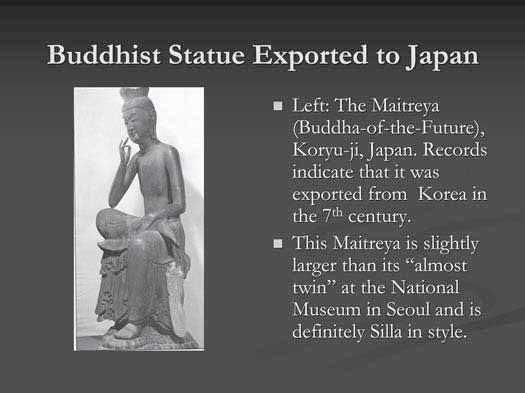
the annotated timeline for important events in northern and western China may be used as an excellent enrichment activity.
Part Six “Teaching the History and Significance of the Silk Road in the Post Classical Era,” by high school teacher Ane Lintvedt,addresses trade in goods as well as the spread of Buddhism and Confucianism, while making the case that it is easy and important to include Korea in the history of the Silk Road in world history.
The seventh part of the guide consists of the alignment of the included material with national history standards and standards for the states of California, Michigan, and New York.An easy to use pronunciation guide for the Korean, Chinese, Japanese, and Sanskrit words found in the text and a bibliography conclude the book.
In total there are twenty-six classroom exercises in the guide. Examples of lessons include, “Silk as a Medium of Exchange”, “What can archeology reveal about trade goods?”, and “How does an era become known asa Golden Age?”Well thought-out handouts accompany each lesson and go far beyond the pedestrian “fill in the blank” exercises so common in high school. Many include advanced readings or visuals.Several of the lessons have well constructed “Points to Consider” questions.These are excellent higher level thinking skill questions that are thought/discussion provoking and help students draw global connections.
Silla Korea and the Silk Road: Golden Age, Golden Threads is an invaluable resource for world history instructors in grades nine through twelve.
ALAN WHITEHEAD teaches Honors and Advanced Placement World History at White Station High School in Memphis, Tennessee. He has traveled and studied in Japan (US Japan Foundation), Korea (Korea Society), and China (Asia Society).
Silla Korea and the Silk Road: Golden Age, Golden Threads is an invaluable resource for world history instructors in grades nine through twelve.
24
Slide number 42 of the online PDF version at http://www.koreasociety.org/k-12_resources/.
Research
Projects
on the Silla Dynasty (57 B.C.E-935 C.E.)
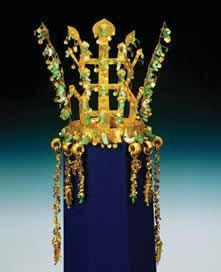
The Lesson: Korean Ingenuity
Grades: Middle and High School
Subjects: Ancient History, World History, Asian Studies and Art History
Time: One or more class periods
Objectives:
The lesson will provide an opportunity for students to complete short research projects to learn about the creativity of the early Koreans and their remarkable accomplishments. Students will work independently or in pairs to determine how one of the following selections reflects Korean ingenuity and understanding of Korean history and culture.
Information for student research and class presentations will be found on the Korean Spirit and Culture Promotion Project (KSCPP) website (http:www.kscpp.net); Fifty Wonders of Korea, Volume 1: Culture and Art; Fifty Wonders of Korea, Volume 2: Science and Technology; and the official internet site for the government of Republic of Korea (http://www.korea.net). KSCPP will mail books free of charge to teachers who request books for classroom use. Information that responds to the following cultural treasures will also be found on Silla Korea and the Silk Road, Golden Age, Golden Threads onThe Korea Society’s website (http://www.koreasociety.org) and numerous helpful websites.
25
1.Golden crown from Hwangnam Tumulus, Gyeongju, 5th century CE, National Museum of Korea. The pure gold crowns of Silla are the foremost example
of the advanced technology and craftsmanship possessed by Silla artisans. The crowns belonged to the royalty and members of the royal family who had a significant role in Silla’s ancient capital city.
2. Bulguksa, near Gyeongju, 8th century CE. The temple isconsidered to be the most magnificent example of Silla architecture and the most renowned Buddhist temple in Korea. It is located in the mountains near Gyeongju, the ancient Sillacapital. The harmonious beauty of the temple reveals the highly developed architectural taste and skills of the ancient Silla people.
3.The Dharani Sutra, near Gyeongju, early 8th century CE,National Museum of Korea. In 1966, the Dharani Sutra was discovered withinthe Shakyamuni Pagoda of Bulguksa Temple near Gyeongju. Since it is believed that the pagoda was completed in 751 CE., the print is therefore at least as old as the shrine in which it was stored. The discovery of the Dharani Sutra caused much controversy among academics, but it is now considered to be the oldest woodblock print in the world.
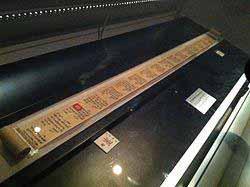

26
4.Main
century CE. Many consider the Sokkurum Grotto to be the finest achievement of the people of Silla. The Sokkurum Grotto embodies ideal harmony of science, art, and religion in a single entity. The Buddha was created with perfect dimensions and the highest artistic skills. It is considered one of the most beautiful Buddhist statues in East Asia.
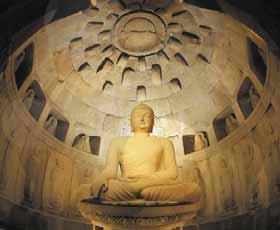
century CE. The bell is the largest bell of its kind in Korea today. The casting techniques of the Silla people who created this enormous and beautiful bell 1,200 years ago are still not fully understood. A bell patterned after the sacred bell of King Seongdeok was presented to the United States in 1976 in recognition of the friendship between South Korea and the United States and is located in San Pedro, California.
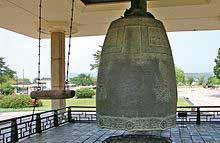 Hall of Sokkuram Grotto, Gyeongju, 8th
Hall of Sokkuram Grotto, Gyeongju, 8th
27
5.Sacred Bell of King Seongdeok, Gyeongju, 8th
6. Gold Earrings, Gyeongju, Metropolitan Museum of Art, New York, early 6th century CE.The gold ornaments found in the Silla royal tombs projected Silla as the “Country of Gold Splendor” as it became known in ancient records. The earrings demonstrate the intricate craftsmanship of Silla artisans in producing jewelry and creating works of art that transcend time.
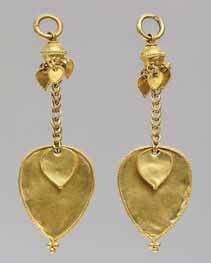
7.Cheomseongdae Observatory, Gyeongju, 7th century CE. The Cheomseongdae Observatory is the world’s oldest existing observatory and reflects the belief that the events in the sky were like a mirror and guide for earthly affairs. It was built on the royal palace grounds during the Silla dynasty and the reign of Queen Seondok. The building reveals the Silla people’s awareness of the science of astronomy.
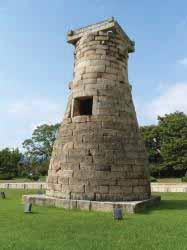
28
8 Sarira Reliquary of the Gamunsa Temple, National Museum of Korea, 7th century CE. This reliquary is unparalleled in beauty and craftsmanship. In Buddhism the sarira are marble-like relics that remain after an enlightened being has been cremated. A sarira reliquary is a work of art that is made to hold those relics. Since sarira are considered sacred, the greatest artistic skill and most advanced techniques were used in its construction. In 2002, researchers tried to replicate the reliquary’s wind chime with modern heating equipment, but could not achieve what 7th century artisans could accomplish.
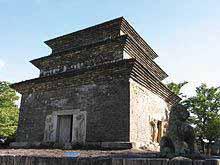
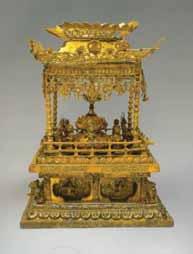
29
9. Pagoda at Bunhwang Temple, Gyeongju, 634 CE. The stone pagoda of the Bunhwang Temple was built during the reign of Queen Seondok and is the only surviving pagoda from the pre-unified Silla period. Originally the pagoda had nine stories, but only three remain.
10.
Gyeongju, 5th-6th century CE. In 1973 when excavations were being conducted, workers found this painting of a beautiful flying white horse about fifteen inches long in an ancient Silla tomb. It is believed that the painting reflects the shamanistic belief that the ruler’s spirit is being carried to heaven on horseback. In ancient Silla the horse’s ashes were placed next to its owner, but fortunately the saddle flap painting survived.
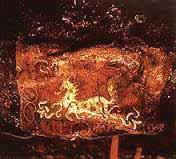
The Korea Society’s e-book, Silla Korea and the Silk Road, Golden Age, Golden Threads, is located on the Korea Society’s website and includes interesting biographies of famous people during the Silla dynasty. Students could perform research on individuals, such as the following:
Queen Seondok, Kim Yusin (Silla’s greatest general), Wonhyo (Silla’s most famous Buddhist monk), and Jang Bogo (successful maritime trader, “Emperor of the Yellow Sea,” and head of Cheonghae Garrison).
A helpful pronunciation guide appears at the end of the book.
Heavenly Horse Painting from Cheonma Tumulus,
30
The purpose of the lesson is to provide an opportunity for students to learn about famous Koreans through readings and/or dramatizations. It is primarily designed to introduce students to famous people who have helped shape Korean history. In the process of studying the four portraits, students will not only learn about influential Koreans, but they will also become familiar with some of the distinctive elements of Korean culture. It is hoped that the lesson will stimulate interest, provoke questions, and encourage further study. The lesson can be implemented in various ways depending on class size, student interest, and available time. It could begin a unit on Korean history and culture or individual portraits could be interspersed chronologically in the study of world history. It would be of great interest to compare the achievements of King Sejong to well- known European monarchs.
: Possibly Upper Elementary, but highly recommended for Secondary
: Asian Studies, Cultural Studies, Ethnic Studies, and World History
: Two Class Periods
1. Develop an appreciation of people who have helped shape the history and culture of Korea
2. Become aware of some of important events in Koreanhistory
3. Examine various leadership styles and determine those the students might want toemulate
4. Provide an opportunity to dramatize history by impersonating important figures
While this lesson is complete in itself, it can be enriched by books on Korea and updatedregularly by checking the Internet for current information.
1. Introduce the lesson and make a brief introductory statement about each of the famous Koreans.
2. Ask students to volunteer in dramatizing one of the portraits. They are encouraged to practice the reading and, if inclined, dress the part. Ideally, there will be dramatizations of all of the characters. If not, ask or assign students to read the individual portraits.
3. Divide the class into groups before the dramatizations/readings begin. Each group is assigned a task. Group #1 reports about what they learned about the times in which the person lived. Group#2 explains what they learned about the culture and the values of the time. Group #3 explains what they learned about leadership and/or the person’s contribution to his/her country.
All students who have completed readings or dramatizations should then be asked to state their conclusions about the varied experiences of the Korean people in the different periods they have studied.
Four
31
QUEEN SONDOK
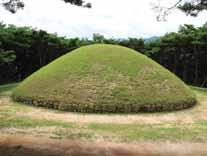
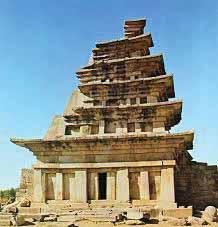
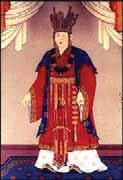

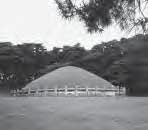
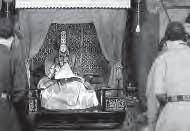
Portrait #1
32
(Reigned 632–47 c.e.)
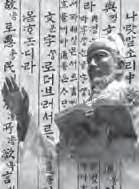
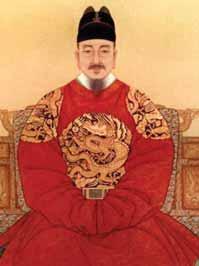
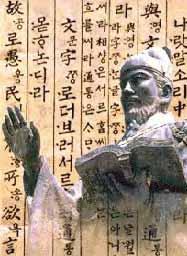
(1397–1450) 33
Portrait #2 KING SEJONG
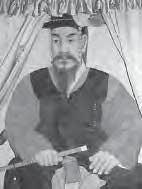
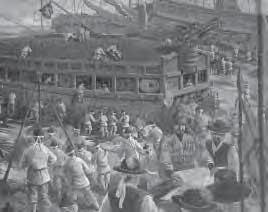
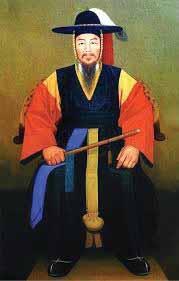
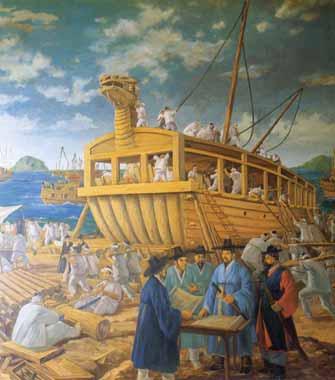
#3 ADMIRAL
SUN-SHIN (1545–98) 43 34
Portrait
YI

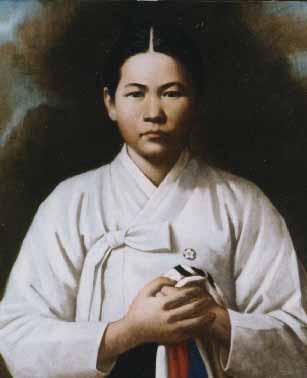

YU KWAN-SUN
35
Portrait #4
(1904–20)
Eckert, Carter J., Ki-baik Lee, Young Ick Lew, Michael Robinson, and Edward W. Wagner. Korea Old and New: A History.Seoul: Ilchokak Publishers, 1990.
Kim, Yung-Chung. Women of Korea: A History from Ancient Times to 1945. Seoul: Ewha Women’s University Press, 1976.
Korea Foundation. Korean Cultural Heritage, Vol. 4. Seoul: Samsung Moonhwa Printing Co.,1997.
Korean Overseas Information Service. A Handbook of Korea. Seoul: Samhwa Printing Co., 1993. Lee, Peter H. Sourcebook of Korean Civilization, Vol. 1 and 2. New York: Columbia University Press, 1996.
Nahm, Andrew C. A Panorama of 5,000 Years: Korean History. Seoul: Hollym Corporation, 1987.
Saccone, Richard. Koreans to Remember: Fifty Famous People Who Helped Shape Korea
Seoul: Hollym Corporation, 1993.
Anearlier version of this article was developed asa lesson plan for the Korea Society. We would like to thank the Korea Society for assistance in the development of this manuscript.
taught AP U.S. History and Asian Studies at Westridge School, Pasadena, California. In 2000, she received the Korea Society’s Fellowship in Korean Studies tostudy and travel in Korea. Her lesson is a result of this fellowship.
36
RESOURCES ESSAYS
Values Lesson Plan
How Currency Reveals Cultural Values
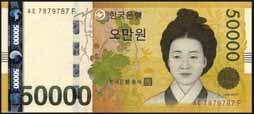 By Mary Connor
By Mary Connor
Shin Saimdang (Shin- Sa-im-dang), 1504–1551: 50,000 won
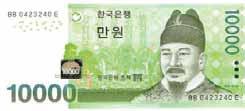
King Sejong is the most well-known and celebrated ruler in Korean history. Even though he lived more than 500 years ago, the Korean people continue to honor him for his relentless efforts to improve the lives of the common people. He governed with compassion and wisdom and led Korea into a golden age of cultural and scientific progress.

In his youth, Sejong became known as “the reading prince” and began his lifelong quest to learn everything he could about the world around him. At the age of twenty-two, he became king and established the foundation of a royal household that would last into the early twentieth century. He believed that good government was based on selecting and training intelligent men to administer the various branches of government. He selected twenty of his most able scholars and allowed them to essentially devote all of their time to advanced learning. He also sought out talent in the countryside by establishing a system to select the most qualified people to serve in government positions, according to their abilities. To protect his homeland from invaders, he selected technicians to develop improved forms of cannon and artillery.
One of King Sejong’s main goals, and the one for which he is most famous, was to make his people more educated by making it easier for them to learn to read. At this time, Koreans used the Chinese system, which involved the memorization of thousands of characters that were complicated and difficult to learn. Literacy was also restricted to the ruling class. Wanting the best for all of the people, the king came up with the revolutionary idea of inventing a new writing system that would be easily learned by the common people. By 1433, he and his scholarly officials had created the hangul alphabet, a phonetic writing system that greatly increased the ability of the common people to become educated. In addition, he directed scholars to write books to improve farming techniques and increase production. Under his direction, a medical dictionary and an eighty-fivevolume encyclopedia were completed, which included medical treatments, acupuncture, and herbal prescriptions to treat nearly 1,000 diseases. King Sejong also promoted art, music, astronomy, science, and improved printing techniques; and he is credited with inventing the rain gauge.
Shin Saimdang is considered the most respected and memorialized woman in Korean history. She is regarded as the ideal mother, exemplary wife, and dutiful daughter; and she is known for her artistic talents in calligraphy, embroidery, painting, and poetry. Shin Saimdang was also a scholar well-versed in the Confucian classics and other great works of the literary tradition. She was also praised as the mother of Yulgok, one of Korea’s most famous philosophers. Considering the firmly held belief of female inferiority and oppressive customs to which women were subjected during the Chŏson dynasty, Saimdang must have been a woman of great inner strength and determination.
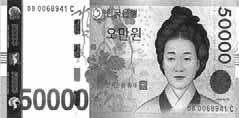
Shin Saimdang came from an aristocratic background. Her parents believed that their five daughters should be educated at an early age. It is believed that she started painting at the age of five. When she was as young as six, she surprised her parents by creating a nearly perfect replica of a landscape by a renowned landscape painter. In time, her landscape paintings became her most treasured works.
When she was nineteen, in the same year that she married, her father died. Because she came from a family where there were no sons, she had to balance her responsibilities between her duty to her mother and her own family. In spite of the fact that it was difficult to visit her mother because she did not live nearby, she remained a dutiful daughter and divided her time between visiting her mother and being a devoted mother of seven children.
Because Saimdang appreciated the fine education she received from her parents, she felt it was one of her familial obligations to be productive and utilize her artistic and literary skills. She also believed that she should make sure that her children were well-educated and constructive members of society. Her third son, Yulgok, reportedly mastered the Confucian classics at the age of seven, wrote poetry at the age of eight, and ultimately became one of Korea’s most famous philosophers.
Saimdang’s sense of devotion to her family, along with her artistic achievements, required a great investment of time and energy and may have contributed to her relatively early death at age forty-seven.
King Sejong, 1397–1450: 10,000 won
TEACHING
RESOURCES
Upcoming Issues of EAA FALL 2013 (18:2) Cyber Asia and the New Media WINTER 2013 (18:3) Central Asia and Focus on the ROK’s Economic Rise SPRING 2014 (19:1) Teaching Asia through Field Trips and Experiential Learning 46 37
RESOURCES TEACHING RESOURCES ESSAYS
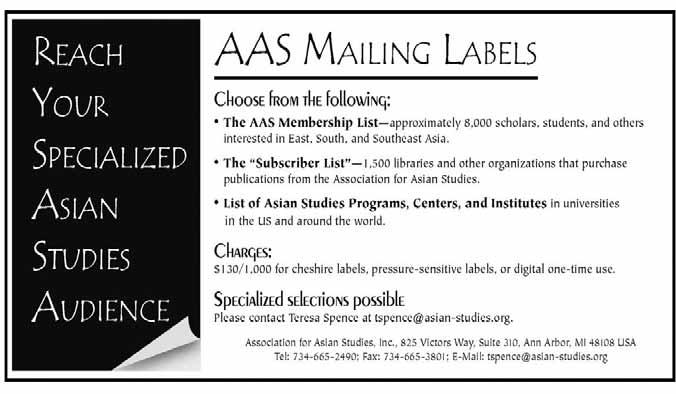 Yi I (Yulgok) 1536-1584: 5,000 won
Yi I (Yulgok) 1536-1584: 5,000 won
Yi I is known for his wisdom and for being one of Korea’s most famous Confucian scholars. Commonly known by his pen name, Yulgok, he was a disciplined and dedicated scholar, statesman, philosopher, and devoted family man.
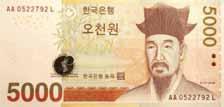
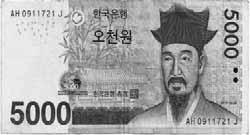
He was fortunate to have been born to an educated family. His father was a scholar and a high government official, and his mother, Shin Saimdang, was highly regarded for her knowledge of the Chinese classics and her talent as an artist and poet. With the good guidance of his mother, Yulgok completed his basic studies of the Confucian classics by the age of seven. He began writing poetry at age eight, and by the early age of thirteen, he passed the literary civil service exam and became acknowledged as a chinsa, a kind of titled scholar. He continued his education by studying Buddhism and Daoism.
After his mother died when he was sixteen, Yulgok went into mourning for three years in the Kumgang Mountains, studying Buddhism. After his retreat, he returned to continue his studies in Confucianism and received top honors in exams, and by the time he was twenty-nine, he passed his last civil service examination and was ready for service in government. He rose in the ranks of governmental service and became one of the central figures in politics by the time he was forty. His work,
Book on the Way to Heaven, was considered a literary masterpiece and revealed his knowledge of history, Confucian philosophy, and Daoism. Another of his famous books was titled A Key to Annihilating Ignorance
Aside from being a philosopher, Yulgok was also a social reformer. He thought it was important to implement Confucian values in government administration. He emphasized learning and self-cultivation as the basis for good government. Although he espoused a society based on the Confucian social order, he appreciated the dignity of every human being, regardless of his or her position in society. He also had great foresight about national security. He feared that the Japanese might invade Korea and proposed a policy to strengthen the army, but it was rejected. His concerns were wellgrounded because, soon after his death at age forty-eight, the Japanese invaded Korea in what is known as the Imjin War (1592–1598). ■
Editor's note: Lesson plan is on the next page
BIBLIOGRAPHY
Connor, Mary. The Koreas: Asia in Focus Santa Barbara, CA: ABC-CLIO, LLC, 2009. Saccone, Richard. Koreans to Remember Elizabeth, NJ: Hollym International Corp., 1993. Editorial Board of the Diamond Sutra Recitation Group. King Sejong the Great: The Everlasting Light Pohang,Korea: Yong Hwa Publications, 2007.
.The Practice of Hongik Ingan: Lives of Queen Seondeok, Shin Saimdang and Yi Yulgok. Seoul, Korea: Jae-woong Kim Publisher, 2011.
MARY CONNOR taught United States History and Asian Studies for thirty-five years. She is the author of Asia in Focus: The Koreas (2009) and the recipient of the Organization of American Historians Tachau Award; the Prime Minister ’ s Award from the Republic of South Korea; and the Daekyo Enopi Award, a newly established, prestigious award available to American educators. She is also Past President and Program Director of the Korea Academy for Educators (2004–2012), a nonprofit organization that informs educators about Korean history and culture and the Korean-American experience.
38
Values Lesson Plan
How Currency Reveals Cultural Values
Grades: 5–12
Subject: Social Studies, Cultural Studies, Math, and Economics
Connor
1. 1 won = _____$7. $1.00 = _______ won
2. 50 won = _____$8. $10.00 = _______ won
3. 100 won = _____$9. $150.60 = _______ won
4. 1,000 won= _____$10. $20,500 = _______ won
5. 10,000 won = _____$
6. 30,000 won = _____$
Part Two
Travel and Shopping in Seoul, South Korea
You are planning a visit to Seoul and want to see as much as possble while you are in the city. Your parents have told you that you need to save money to help pay for the cost of your trip. You decide to go to the Internet to get a sense of how much your trip will cost and what you need to save. At the top of your list of places you want to visit is the Gyeongbokgun Palace. You are informed in your Internet search that a ticket to the palace is 1,000 won. How much is this in US currency?
Objectives
● Examine the currency of South Korea and the United States to determine how the images reflect the cultural values of each nation.
● Learn about currency exchange and calculating the cost of a tour in Seoul.
Procedures
● Provide your students with three images of Korean currency and four images of US currency.
● Briefly discuss George Washington, Abraham Lincoln, Alexander Hamilton, and Andrew Jackson. Why do you think they were chosen to be on United States currency, and what might this show about American cultural values?



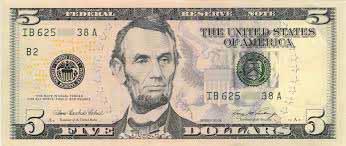
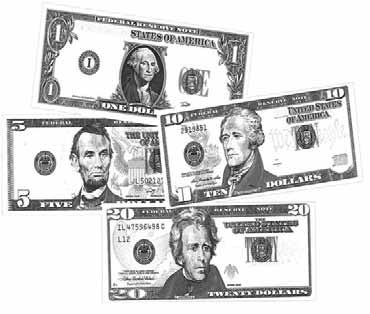
● Read summaries about King Sejong, Shin Saimdang, and Yulgok. Why do you think each of these famous Koreans was selected to appear on the currency, and what might this reveal about cultural values in Korea? What insight do you now have about the values of Korean-American families?
● What do the currencies of Korea and the United States show about cultural differences and similarities between the two cultures?
● Without the use of the Internet or a calculator, complete the Seoul travel worksheet, and convert Korean won to US dollars. When you travel to Seoul, you will be glad you had a lesson on currency exchange.
Part One Currency Values Current Exchange Rates
Research the most current exchange rate between the Korean won and US dollar to calculate how much Korean currency notes and coins are in US dollars and cents. Also, convert US dollars to Korean won (Google “currency exchange”).
● You know you want to shop in Insa-dong, a famous place for tourists to purchase gifts. You want to buy a celadon vase for your grandmother and several gifts for your classmates. You are told that the vase will be about 40,000 won and that gifts for your friends will cost about 20,000 won. What is the total in US dollars?
● You want to learn more about the Korean War and plan to visit the Korean War Museum. The cost is 3,000 won for an adult and 2,000 won for a student. How much will it cost in US dollars for your father, mother, you, and your sister?
● You have heard that a great way to see the beauty of Seoul is to ride the Mount Namsan Cable Car to the Seoul Tower Restaurant. You are told that you can expect to pay about 7,000 won for lunch. How much will this cost you in dollars?
● You want to go to the Hanok Village to learn about life in premodern times and are happy because it is free. You also want to visit the Seoul National Museum and the Folk Art Museum and find that both are also free. You know you will need to take the subway to these places, so you do an Internet search to find out about public transportation in Seoul. You learn that Seoul has a very convenient and fast public transportation system. You discover that for destinations involving ten stops, the cost is 1,000 won. How much is this in US dollars?
● You are checking out the rates of hotels and have heard about the Westin Chosun and the Seoul Shilla hotels. One night at the Westin for two adults is 280,000 won, and the Shilla costs 440,000 won. Convert the price of each in US dollars. You search for a less-expensive hotel for your family and find one with good reviews for 150,500 won. How much will this cost per night in US dollars? ■
48 39
RESOURCES TEACHING RESOURCES ESSAYS
“Korea in Global Perspective : The Mongols and Korea”
From Michael Seth’s A Concise History of Korea : From Antiquity to the Present (2016)
(The complete review can be downloaded on the Association of Asian Studies website)
The following selection from Michael Seth’s A Concise History of Korea offers global perspective on the impact of the Mongol invasions and particularly the Mongols influence on Korea. One of the great merits of Seth’s book is the presentation of each stage of Korean history within a global context; subsequently, readers will have a deeper understanding of social, cultural, and political history not only in East Asia, but also with other parts of the world. The book is a valuable and enlightening resource for educators who teach World History and Asian Studies.
“Korea was greatly impacted by the Mongols in two main ways. First, the Mongol invasions devastated the country. The repeated attacks and especially the scorched-earth tactics they employed that systematically destroyed cities, towns, and temples resulted in a horrendous loss of the country’s cultural heritage. Very little in the way of physical remains survives from preMongol times. In this, Korea shared the fate of many other parts of the world. The Mongol invasion of Iraq in 1258, for example, led to the utter destruction of Baghdad, the greatest city of the Islamic world. The Tigris River, legend has it, turned black from the ink of the many books the Mongols dumped into it as they destroyed the city’s great libraries and numerous booksto res. Even the elaborate irrigation system that made Mesopotamia a highly productive agricultural region was destroyed. As a result, little remains today of Iraq’s legacy as the former center of Islamic civilization. Similar destruction was heaped upon many of the great cities of Kwarezm and other parts of central Asia, and across much of China and Russia. This contrasts with Western Europe and Japan, which were largely spared this devastation.
The other legacy of the Mongols was Korea’s unprecedented integration into the larger Eurasian world. Once the Mongols had created their great steppe-based empire, they set in on the task of extracting revenue from it. This involved promoting trade. Nomadic peoples had always been dependent on trading as well as raiding the settled agricultural societies they bordered. They provided meat, skins, and horses, and they traded plunder for metal goods such as swords, knives, and pots; for grain; and for other items they could not produce themselves. In addition to encouraging trade, the Mongols, with their control over most of the steppe and adjacent lands, were able to ensure safety and stability for long distance merchants and were concerned with maintaining good communications. They also searched for and hired or drafted talent – clerks, administrators, and skilled craftsmen – from the lands they conquered, having them serve in their capital or other administrative centers. As a result, the period from the late thirteenth century,
40
when the Mongols’ conquests were largely completed to the collapse of the Mongol Empire in the mid-fourteenth century was a period of unprecedented cosmopolitanism in much of Eurasia. Some historians call the period the Pax Mongolica. Western Europe, for example, for the first time had direct contact with China.
Korea became a part of this cosmopolitan world. Perhaps as never before in its history, Koreans serving the Mongols in their capital at Beijing or elsewhere came into contact with people from all over Eurasia. This is when gunpowder, cotton, and other imports and innovations entered or were established in the peninsula. And it was during the Mongol period that Koreans began to adopt Neo-Confucianism. For Korea, being more integrated into the cosmopolitan world of the Pax Mongolica resulted in the greater flow of influences from China, while the cultural influences of Central Asia, the Middle East, and other parts of the world were less significant. Thus, as in much of Eurasia, the Mongol period brought about enormous destruction and loss of heritage but also facilitated technological and cultural innovation through greater contact with distant cultures.
The Mongols were part of a long-term historical process in which mobile, horse-riding nomads from the steppe posed a constant threat to their neighbors. Koreans had endured the Murong, the Khitans, the Jurchens, and others. The Koreans themselves were partlyof nomadic origin. The Mongols were the latest and most formidable of the invaders. But they were also among the last. The development of firearms and conquest of the steppe by the Russian and Qing empires in the seventeenth century brought this era of history to an end.
For discussion and/or sharing one’s views by writing responses:
Summarize in one sentence the essence of the impact of the Mongol invasions.
What would be two or three ideas that you believe are important or of interest?
Does this reading cause you to reflect on current developments in the world? If so, explain.
41
ADMIRAL YI SUN-SHIN, THE TURTLE SHIPS, AND MODERN ASIAN HISTORY
By Marc Jason Gilbert
Though little-known in the West, Korean Admiral Yi Sun-Shin (1545–1598) is a major figure in Korean and Japanese history. His technological and strategic innovations sparked a revolution in Asian naval warfare and initiated both the “modern” naval force and style of combat. These innovations helped Korea repel a series of Japanese invasions from 1592 to 1598, paving the way for more than 250 years of Japanese semi-isolation from world affairs. The ultimate adoption of Yi’s ideas by the defeated Japanese led to their triumph in the Russo-Japanese War of 1904–1905, an event that altered the balance of power in Asia and much of subsequent world history.
Like many innovators, Yi Sun-Shin suffered many disappointments due to domestic political intrigues and regional military rivalry. Yet his struggles with factions at the Korean court and difficult relations with Korea’s Chinese allies do more than illuminate contemporary Asian politics. While his prowess as a military reformer and weapons designer has earned him accolades that often border on hagiography, he is also admired for his personal qualities. In the face of one of the bitterest conflicts in human history, Yi Sun-Shin never lost sight of the plight of its victims. Though he bore terrible wounds and calmly faced death with thoughts only for his men and the preservation of his state, his stoicism was not so complete as to protect him from the pain arising from personal disgrace and the loss of close friendships and family. Even Yi Sun-Shin’s success in battle depended as much upon his courage as his brilliance as a strategist. It is thus his humanity, as well as his genius, that is worthy of our attention.
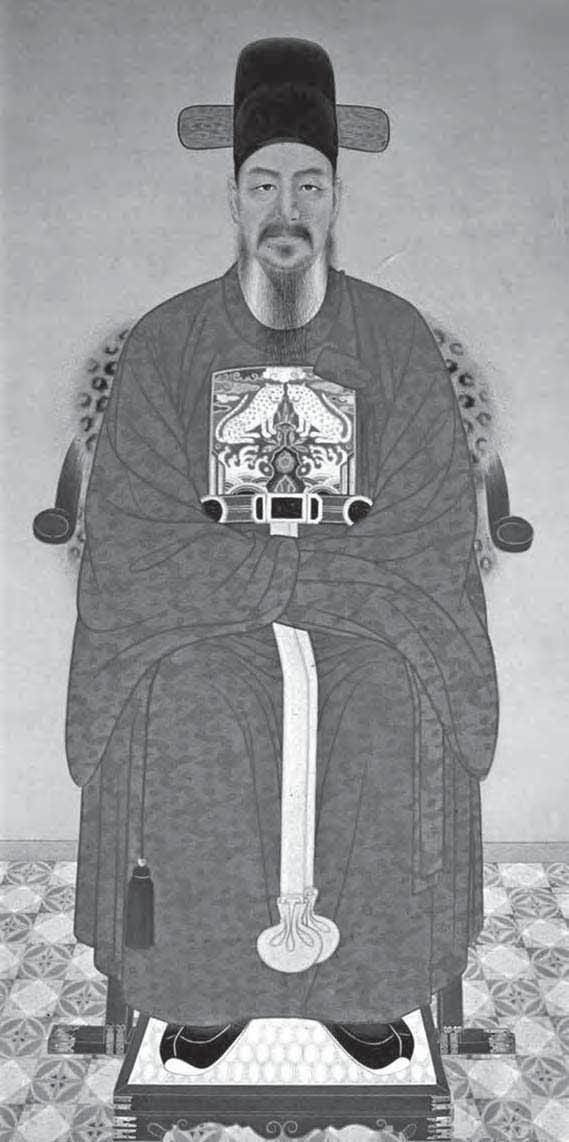
EARLY LIFE OF ADMIRAL YI SUN-SHIN
Lord Admiral (Chungmu-Gong) Yi Sun-Shin was born at Seoul into an aristocratic family on April 28, 1545. He married in 1564 and two years later began the study of traditional Korean military arts: archery, horseback riding, and swordsmanship. This was a somewhat unusual interest for a son of the Korean elite, who at the time shared the Chinese Confucian view of military service as an inferior occupation. Though male Koreans owed the Chos˘on Dynasty (1392–1910) three months of military service every five years until the age of sixty, the well-to-do often contrived “to avoid this obligation, and even to evade military taxes,”1 a fact of life in Korea and elsewhere, before and since.
Yi Sun-Shin and his wife had three sons: Hoe (born 1567), Yo (born 1571), and Myon (born 1577), who played important roles in his professional life. His characteristic drive and stamina were first noted in 1572 when, during his military examinations, he fell from his horse and broke his leg. He is said to have completed the riding exam after rigging a splint out of awillow branch. After passing his examinations, he served in various staff and command positions. The Korean military service made no distinction between branches of service, so it was not remarkable that his first posting was as a naval commander at the southern tip of Korea in 1580. However, two years later he refused to ignore corrupt practices, earning him the enmity of his immediate superiors, who stripped him of his command; then as now, one’s superi-
42
Portrait of Admiral Yi Sun-Shin. Chesungdang (Victory Hall), Hansan Isle. Image source: http://www.koreanhero.net/en/AboutYiSunsin.htm
ors have difficulty enduring criticism when it reflects badly on their own performance.
Yi Sun-Shin accepted an appointment as acting commandant of Konwon fortress on Korea’s troubled northern frontier, where his superiors may have hoped he might meet his end in combat. Shortly after he took charge there, his post was assaulted by Manchurian (Jurchen) forces. During this battle, Yi Sun-Shin lured his opponents into a trap, captured the Jurchen leader, and defeated his forces. However, at the end of that same year, Yi Sun-Shin’s father died and he was obligated to resign his post to fulfill his filial duties as a mourner, which, according to ancient Korean tradition, lasted three years. A year after returning to service in 1586, he again saw action against Manchurian invaders. While leading a counter-attack, he was wounded in the leg by an arrow, which he removed himself without letting anyone else see his injury. He did so out of a concern that the sight of a commander’s wound might demoralize his troops, a principle that he literally took to his grave.
Although Yi Sun-Shin was always careful to attribute his successes to others and share such glory as came his way, his superiors again grew jealous of his achievements and had him arrested. Since Yi Sun-Shin refused to confess to the false charges brought against him even under torture, his accusers had to settle for stripping him of his rank and imprisoning him. In what may have been an act of leniency or even empathy, King S˘onjo (1567–1608) freed him under the condition that he would fight thereafter as a common soldier. When he bore this demotion without complaint, the King again intervened, pardoning him for his “crimes” in 1588.
Yi Sun-Shin eventually returned to his country’s service as astaff officer and then as the King’s personal bodyguard and messenger. Due to the King’s continuing interest in his career, he was twice made a magistrate and re-appointed as a commander on the northern frontier, but such patronage only attracted more enemies, who forced his transfer from one post to another. In 1591, Yi Sun-Shin’s merry-go-round of appointments led to his arrival in the seaport of Yosu as Commander of Cholla Left Naval Station (whereas the British Royal Navy is divided in its command structure into Admirals of the Red, the White,
and the Blue, Korea’s naval forces were divided between commands labeled Left and Right.) In Cholla, Yi Sun-Shin began to address a perennial threat, Japanese piracy, which turned out to be but the prelude to the greatest military challenge yet faced by the Korean armed forces, the Japanese invasion of 1592–1598.
THE JAPANESE CHALLENGE
Though for centuries the Japanese had menaced the Korean coastline,2 by the early modern period relations improved as Japan seemingly had little interest in continental politics. The Japanese state even took a benign view of Korea’s support of the Mongol invasions of their homeland in 1274 and again in 1281, as it recognized that Korea was under Mongol occupation and had little choice in the matter. The failure of these assaults ended the possibility of an Asian pax mongolica However, in the unsettled times that followed, Korea experienced decades of attacks by Japanese pirates in league with Chinese and Korean freebooters (collectively known as Waegu). One such attack in 1371 resulted in the sacking and burning of the Kory˘o kingdom’s capital at Songdo (present day Kaesong), which may have hastened the end of that kingdom in 1392.3 Mindful of the barbarity and destruction long wrought by its sea-borne enemies, the ruler of the succeeding Chos˘on dynasty, King S˘onjo, understood the seriousness of a threatening communication he received in 1592 from Toyotomi Hideyoshi (1536–1598), who had recently achieved domination over virtually all of Japan. As Hideyoshi confided to S˘onjo, that achievement was not enough to quench his self-admitted lust for conquest, which apparently embraced not merely Korea, but “all of Asia.”4 Hideyoshi, who prided himself on his diplomatic skills, informed King S˘onjo that it was his intention to conquer China and he called upon Korea to “help clear my way” and thus “save her own soul.”5
King S˘onjo may have thought Hideyoshi was unbalanced for even thinking of an advance on China. By then, Korea was acting as a vassal of China and S˘onjo would have had little doubt that China would make short work of the Japanese and Korea as well if the later aided in the planned assault. S˘onjo ultimately declined to permit his kingdom to serve as a smooth path of conquest for a state whose bid to become the dominant power in Asia offered Korea little advantage and would expose it to neighboring China’s wrath in the likely event that Japan’s bid failed.
Hideyoshi responded to Korea’s defiance by launching one of the most destructive military assaults Korea has ever experienced, known as the Imjin Wars (1592–1598). The first assault wave of over 24,000 men, carried in over 800 ships, arrived at Pusan in May of 1592. This initial force was commanded by the Christian Lord Konishi Ukinaga and is believed to have been largely composed of Christian troops. These units were later joined by the Buddhist warrior Lord Kato Kiyomasa as the force grew to more than 150,000 men armed with thousands of gunpowder weapons, largely muskets, which the Koreans lacked in great numbers. This enabled the Japanese to reach the Chos˘on capital at Seoul within three weeks, even though they paused along the way to destroy virtually every Buddhist monastery and monument they encountered, which may or may not have been an expression of Lord Konisha Ukinaga’s hostility to a rival faith.6 Their destruction was not limited to buildings or institutions. Eventually, thousands of skilled workers, from printers to glazed pottery (celadon) makers, were taken
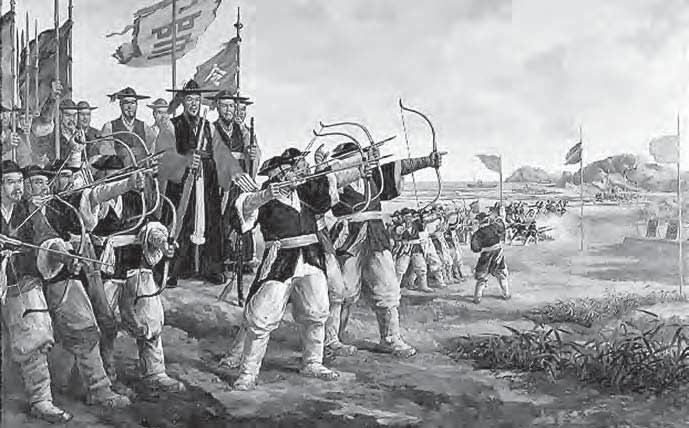
43
Painting of “Yi Sun-Shin at Training Camp” by Jung Chang (1978). Image source: http://www.geocities.com/yi_sun_shin_adm/yisunshinImages.html
to Japan to improve crafts industries there. Due to logistical issues, the Samurai practice (borrowed from the Chinese7) of submitting the heads of their dead foes to claim honors and rewards had to be modified to permit the submission of ears. As a result, Japanese warriors returned to Japan more than 38,000 ears, which eventually were buried at Mimizuka, the “Hill of Ears” in Kyoto.8
Four years of war would leave 90 percent of Koreans homeless, their agriculture ruined and the populace on the brink of starvation. The scholar O Huimun, forced to forage far and wide to stay alive, was one of several Koreans who compiled diaries of those times which evoke horrific images of “roads lined with corpses, desolated farmland, victims of mass rapes, suicides of women seeking to avoid capture, and cannibalism among the desperately hungry population.”9 Even these scenes paled in comparison with those to be seen at the Korean fortress-city of Chinju. Because it had held out against the initial Japanese onslaught, Hideyoshi sought to make an example of it. According to Donald Liu, the fall of the city witnessed the bloodiest and cruelest of the atrocities committed by the Japanese, the memory of which “is scarred deep into the Korean psyche.” He views Chinju as “comparable to that of the Jews of Masada after the fall of Jerusalem to Roman troops, with Korean soldiers fighting to the death and “Korean women flinging themselves from the ramparts, rather than be sexually assaulted by the invaders.”10
YI SUN-SHIN TAKES COMMAND
Yi Sun-Shin was not caught unawares by the Japanese assault. Upon his arrival in southern Korea, he immediately set about improving Korea’s naval preparedness. He had long studied the strengths and weaknesses of both Korean and Japanese naval practices and knew that the Japanese relied on their greatest martial strength—expert samurai swordsmen and bowmen. To maximize this strength, the Japanese had built broad-beamed ships that carried a large number of soldiers. Their strategy was to approach enemy vessels as closely as possible and rake them with arrow fire until the enemy’s decks were clear enough for infantry to sweep aboard. Stiff resistance was met with fire arrows shot by the bowmen firing at close range. More recently, though the Japanese had chosen not to mount more than one cannon to each of their ships, they were filling their vessels with musketeers. The range of Japanese (smooth bore) muskets was no greater than that their bowmen’s arrows, but the bullets fired by muskets may have had greater penetrating power. As for the invasion armada, according to some Japanese sources, the best and largest of their ships, called Atakebune, were ironclad, but were also very slow and thus illsuited to anything more than coastal operations. The majority of Japanese naval vessels were little more than armed transports, whose commanders could draw on little naval tradition due to the Japanese emphasis on land warfare. Japanese naval forces were thus fearsome in size and deadly in close combat, but had weaknesses that could be exploited.
Like the builders of the caravel in Western Europe, the Koreans built ships with “castles” to better protect their crews from attack by arrows and muskets obtained in Asia from Portuguese and Chinese merchants, and also mounted cannon. Fear of Chinese and Japanese territorial ambitions had led the Korean King Taejong (1367–1423) to create a special gunpowder service unit that experimented with shipmounted artillery. However, it was his son, Sejong (1397–1450), who made the development and use of gunpowder weapons a priority.11 Korean records suggest that a cannon-armed ship called a “Turtle
Ship” (Geobukseon or K˘obuks˘on) was under construction as early as 1414, but by the time of Yi Sun-Shin’s appointment, no Korean ship of any type of armament was capable of defeating the Japanese.
Yi Sun-Shin lost no time in urging the local boatyards to rectify this problem. Within months they produced a vessel that provided Yi with the naval technology that helped him to seize control of Korea’s sea approaches and thus cut Japan’s lines of communications and supply. His success in this task was pivotal in thwarting Japanese ambitions and has since become so entwined with Korean national pride that it has led to outlandish claims regarding the magnitude of his achievement. It is often asserted that these Turtle Ships were the world’s first armored battleships or ironclad vessels or even the world’s first submarines.12 They certainly were innovative in design, but, despite Korea’s brilliance in metal-working, it is unlikely that the Turtle Ships carried any true metal armor. Their advantage over the Japanese was their speed and multi-cannon armament: heavy ship armor would have slowed the ships, and, in combination with as many as forty cannon, they mounted and their lack of a keel would have made them so top-heavy as to easily capsize.
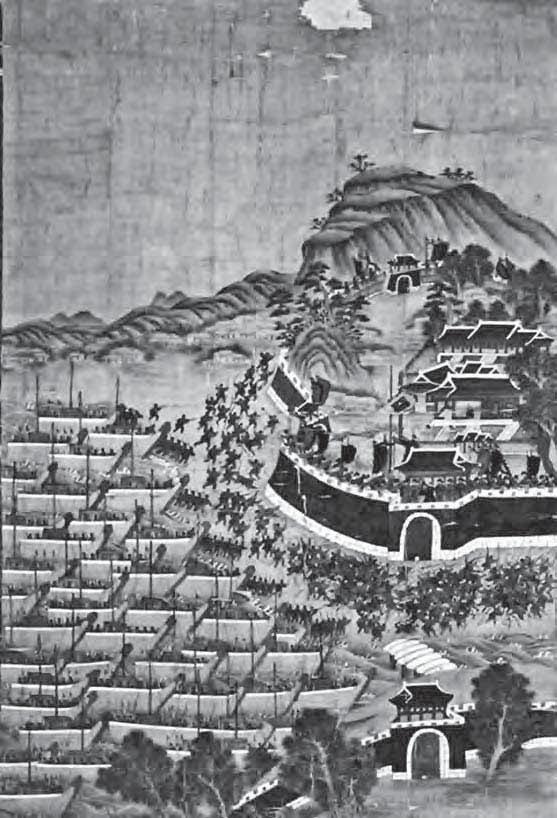
44
Painting that depicts the Japanese landing on Pusan. Chesungdang (Victory Hall), Hansan Isle. Image source: Wikipedia http://en.wikipedia.org/wiki/Image:WakouLandingColor.jpg
Since there were probably not many more than a dozen K˘obuks˘on operational at one time. Horace Underwood, an authority on the Korean marine, suggests that the emphasis placed by Yi Sun-Shin’s admirers on the unique nature of the Turtle Ships’ design fails to recognize that Admiral Yi Sun-Shin’s true “genius” lay not in the Turtle Ship’s design, but in the development of ship-fighting tactics that exploited their strengths: after Yi Sun-Shin was temporarily superseded in command, his successor was ignominiously defeated while deploying the same ships in battle while failing to employ his revolutionary tactics.13
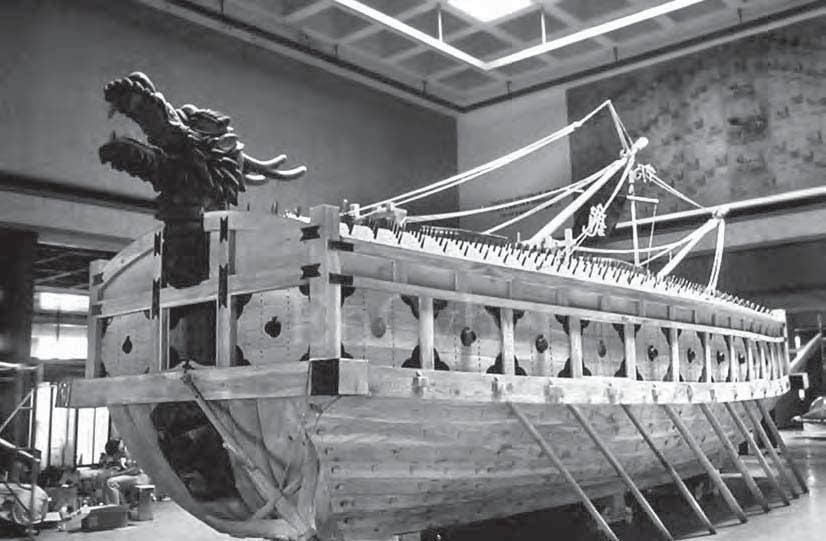
Yi Sun-Shin, developer of the “Turtle Ships,” addressed the fundamental problem posed by the Japanese tactics and weapons: how could Korean ships avoid being shattered by close range bow and musket fire and boarded by the world’s best swordsmen? The answer lay in speed and longer range fire-power. His ships were almost twice as long and half as wide (110 feet by 38)14 as their Japanese counterparts, making them move much faster through the water, while his cannon could outrange Japanese musket balls. He could thus keep Japanese ships at a distance and pound them into pieces, using perhaps as many as forty 36-pound cannons firing through hatches along its side (additional single cannon were mounted in the mouth of the good luck-attracting dragon’s head carved into the prow and beneath the stern transom). In retrospect, Yi Sun-Shin was not alone in producing the first “stand-off” weapon. His English contemporary, Sir Francis Drake (1540–1596), had also abandoned the grapple-board-and have-at-them style of naval fighting that had gone unchanged for perhaps two thousand years and adopted in its stead the form of naval warfare later pursued from Trafalgar through to Jutland, Cape Matapan and Leyte Gulf.
One of Yi Sun-Shin’s talents was that he anticipated that his enemies would ultimately adjust their own war-fighting strategy to meet this new challenge: Japanese ships ultimately came to mount more cannon of their own. However, like Drake, Yi Sun-Shin always remained a step ahead of his foe. His forces were the first to adopt an “in line ahead”
sailing protocol Yi Sun-Shin called “holding onto each other’s tail”15 that enabled each ship to bring its guns to bear upon the same targets as they passed them in turn. He also deployed a tactic called “drawing the fish into the net,” the feigning of retreat in order to draw entire enemy fleets into position to attack. Further, he knew that he could not always dictate the rules of engagement. There would be times when his forces would have to come to close quarters with Japanese ships and face their intense close-in fire and skilled boarding parties. In part to offset this advantage, Yi SunShin apparently invented the “smokescreen,” an on-board smoke generator that produced sulfur and saltpeter fumes which he designed to create “a mist so that the enemy cannot see the ship.”16 He also addressed the problem posed by close-quarters action through the very structure of the Turtle Ships themselves.
Building on evolving Korean practice of cannon use (introduced from China in 1373) and the well-known need for protection for crews, Yi Sun-Shin entirely enclosed his oarsmen and gun crews in ironbound, four-inch thick wood deck planking all-but-impervious to arrows and musket fire. A recent work by self-admitted non-naval architects argues that the exposed upper planks may have been covered by very thin metal sheets, which may have given rise to the idea that the ships were made of metal or armored,17 but even this study confirms that Korean deck wood seems to have been more than adequate to this task and obviated the dangers of added weight. More important, and most likely Yi’s own idea, was that the curved upper-most deck acted as a roof protecting the crew, who were trained to shove spear points through slots in the decking that were concealed by thatch strewn over the deck and the smoke generated by the ship itself. Japanese samurai jumping down onto a Turtle Ship were likely to either be impaled upon the blades concealed in the deck or slide off its rounded upper surface into the sea.18
INTO BATTLE: 1592
Having prepared his new vessels and trained his crews, Yi sun-Shin moved around the peninsula to relieve the devastated fleet of the Korean commander, W˘on Kyun, on the southeast coast of Korea . W˘on Kyun so resented this help that while both were still in the field, he plotted to destroy his rescuer with what Yi later described as “an evil heart full of knavish tricks.”19 W˘on Kyun undermined Yi’s reputation at court. Oblivious to W˘on Kyun’s plot, Yi Sun-Shin focused on the foreign foe and crushed them in a series of naval battles, one so intense that the admiral was wounded, which he concealed from his men. This campaign ended with the triumphant victory at Hansando in 1592, evocatively described by Yi Sun-Shin’s nephew in a readily available account detailing with how Yi drew the Japanese from a shallow narrows suitable for the enemies’ ships “out to the open sea to destroy them in a single blow.” This was accomplished by feigning defeat, after which “Ch’ungmu-kong waved his flag, beat his drum, and
45
Modern Turtle Ship replica at the War Memorial Museum, Seoul, South Korea. Image source:
http://www.koreanhero.net/en/ViewImage.htm?name=Kobukson_2.jpg
shouted the order to attack. In an instant, our warships spread their sails, turned round in a ‘Crane-Wing’ formation and darted forward, pouring down cannon balls and fire arrows on the enemy vessels like hail and thunder. Bursting into flame with blinding smoke, seventythree enemy vessels were soon burning in a red sea of blood. This is called “The Great Victory of Hansando.”20
In strategic terms, Hansando was the equivalent of the naval success of the Greeks against the Persians at Salamis. At Hansando, as at Salamis, the tide of an invasion was stemmed, in this case because it destroyed the invaders’ lines of re-supply that were essential for Japanese operations in both Korea and China. Their forces were being decimated by fierce Korean resistance: over a third of the invasion force died in battle within the first year of the war. Koreans, however, were also suffering. The impact of the war was driven home to Admiral Yi by conditions near his naval station. His response, a formal letter to the central government, lends insight into his human sensibilities, as well as suggesting that his skills extended beyond mere excellence in military leadership. After supplying temporary winter quarters for 200 war refugees, he noted that even though they could return to their native homes when peace is restored, “no one can bear to see them die of starvation in the meantime.” Accordingly, after taking a survey of available land, he found a suitable site and instructed the refugees to settle there “and to commence the spring plowing, which they did with gladness.” He also asked for the Court to issue a decree to facilitate such projects generally.21
THE WAR AT HOME, 1594–1596
His naval victories led to Yi Sun-Shin’s promotion as Supreme Naval Commander, but he had little time to enjoy his new command. After a dutiful visit to his mother (who welcomed him and promptly urged him to return to battle in defense of the Korean people),22 he returned to the war to find King S˘onjo pragmatically negotiating for Chinese support against the Japanese. Yi Sun-Shin knew of the importance of China as an ally,23 but opposed the constraints of Chinese-led peace negotiations, believing the Japanese were not trustworthy in such matters. When told by a Chinese general to withdraw his forces from before a Japanese camp and “return to his home station,” he exploded in anger, saying, “Which home station do you mean? . . . I am a subject of Korea, and for justice’s sake I cannot live with these robbers under the same heaven.”24 He would later recant his obdurate, if patriotic, tone, which may have been shaped by anger fueled by a bout of typhoid fever and the need to confront a devastating outbreak of plague among his naval forces. That tone, however, was dangerous. Yi SunShin was subsequently able to lead his fleet to a major victory against the Japanese at Changmun-p’o in 1594, but this triumph did not prevent Admiral Yi’s rival, W˘on Kyon, from exploiting Yi Sun-Shin’s outspokenness and rallying those like himself who resented Yi’s successes.
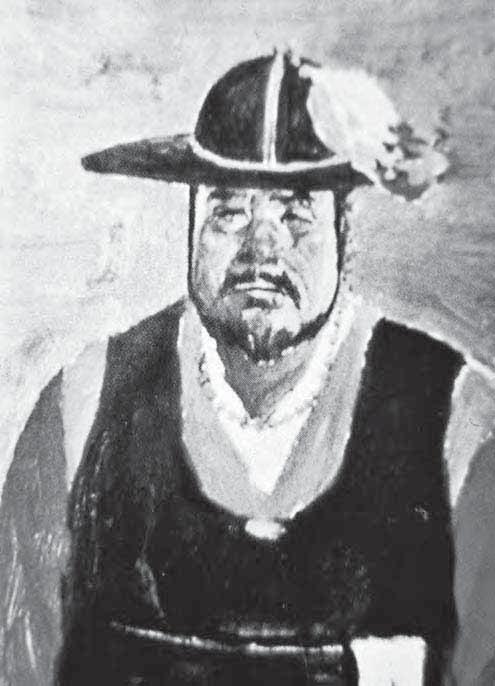
W˘on Kyun helped arrange a test of Yi Sun-Shin’s loyalty that was impossible for him to pass.25 This gambit led to the transfer of the admiral’s authority to W˘on Kyun. It also led to Yi Sun-Shin being dragged off to Seoul in a cage carried by an ox cart, much to the dismay of the public, who lined the route of his journey to protest the humiliation of their hero. After a time, Yi Sun-Shin was released to once again serve as a regular soldier. He again executed these humble duties with great dignity, despite enduring another personal blow: the loss of his mother (his father had died in 1582). However, he was now at the very end of his emotional reserves.
Image source: http://kalaniosullivan.com/OsanAB/OsanSongtanKorHist.html
After his mother’s funeral, Yi began to grieve over his own plight. “O,” he lamented, “What shall I do? Is there anyone else under heaven in such a pitiful plight as myself?—the sooner I die the better.”26 According to his diary, he broke into tears when dismounting from his horse on arrival at a friend’s house. Later he “sat up late at night all alone, as sadness incessantly swept over me.”27 He bent, but he did not break; his will strengthened by his sense of duty and the solace he drew from local officials who everywhere greeted him with hospitality and respect.
RETURN TO BATTLE, 1597–1598
Hideyoshi launched a second invasion of Korea in January 1597, which was comprised of over 140,000 men supported by over 1,000 ships. This force easily crushed W˘on Kyun’s fleet, a defeat made bitter by W˘on Kyun’s attempt to flee the scene of battle, after which he was caught and beheaded. W˘on Kyun’s disgrace enabled the court to rehabilitate Yi Sun-Shin’s reputation and once again asked him to serve as Supreme Naval Commander, though the King was now closely allied with the Chinese and contemplated the abolition of what little remained of Yi Sun-Shin’s former forces of which only twelve vessels and only 120 sailors remained. Yi Sun-Shin, however, prevented this outcome by famously declaring that, “After all, I still have twelve ships! As long as I live, [our] enemies will never look down on us.”28 He used these resources well enough to resume his victorious assaults on the Japanese and helped saved Seoul from a naval attack, though he lost his third son, Myon, in the process.
In late 1598, Yi Sun-Shin’s ships, together with Chinese naval and land units acting in concert with Korean land forces (which now
Portrait of W˘on Kyun (1540–1597), Yi Sun-Shin’s fellow naval commander and ill-fated rival.
46
included guerilla units made up of Buddhist monks), drove the Japanese into a narrow perimeter around the southern port of Pusan, from whence they had no option but a fighting withdrawal by sea.29 To prevent the latter, Yi Sun-Shin set aside his reservations and graciously accepted acting in a combined Korean-Chinese naval force under the Ming Admiral Chen Leng. Chen Leng gave him all the freedom he required and together they ended any Japanese hopes of an honorable retreat. On December, 18, 1598, Yi Sun-Shin destroyed a 500-ship Japanese force covering the evacuation. This defeat virtually ended the seven year long Korean debacle which may have hastened the death of Hideyoshi, “who reportedly died of a broken heart over these losses.”30 Yi Sun-Shin’s nephew recounted that, at the very turn of the tide of this battle, the admiral to the fore urged his men in an assault on a Japanese ship, “a stray bullet from the enemy vessel struck him,” whereupon he called out to his oldest son Hoe, “The battle is at its height; do not announce my death!” With these words, he died.29 Hoe and his cousin Wan then removed Yi Sun-Shin’s body to his cabin and returned to the battle “banging the war drum and waving the battle flags, thus ensuring nobody knew of Yi Sun-Shin’s passing and securing the final victory.”32
ASSESSMENTS OF YI SUN-SHIN’S CAREER AND THE POLITICS OF MEMORY
After his passing, Yi Sun-Shin was given the tile of “Lord of Loyalty and Chivalry” or Chungmu-gong earned not only for his military prowess, but for his adherence to the highest standards of what was then regarded as “the three essentials for the warrior: humility, discernment, and courage.”33 Alan Burrese noted that:
When Admiral Son Ko-i died in 1598, a letter was found among his possessions. It was from Yi Sun-Shin [n], and in it he wrote, “My life is simple, my food is plain, and my quarters are uncluttered. In all things, I have sought clarity. I face the troubles and problems of life and death willingly. Virtue, integrity and courage are my priorities. I can be approached, but never pushed; befriended but never coerced; killed but never shamed.34
A shrine was built by King S˘onjo to honor Yi Sun-Shin in 1606. It was the first of many such shrines and monuments, including one at the Korean Naval Academy and the large and impressive statue in downtown Seoul.33
In time, Yi Sun-Shin’s naval innovations became no more than the subject of honored memory in his homeland. Like their Ming allies, the Chos˘on dynasty became preoccupied with the renewed Manchu aggression of the seventeenth century, and there was little naval development thereafter. Still, by his thwarting of Hideyoshi’s Pan-Asian
ambitions, Yi Sun-Shin had not merely sustained the tradition of Korean independence, but helped set the course of East Asian history for generations. Had Hideyoshi achieved his goal of conquering Korea and the Chinese Ming Empire, the Manchu invasion may have run a different course, and with it, much of world history.
As the impact of his life on Korean history became better understood, Yi Sun-Shin came to be increasingly memorialized until he emerged as a national symbol of honesty and self-sacrifice. Given the court intrigues and mismanagement that characterized Chos˘on politics and the narrow military regimes that dominated Korea as it emerged from Japanese colonial domination after the Second World War, it is little wonder that post-war Korean nationalist politicians sought to promote the image of the morally and ethically impeccable Yi Sun-Shin, the soldier-hero who defeated Japan, as a model for all modern Koreans to emulate.
The judgment of Admiral Yi Sun-Shin’s peers underscores his real (as opposed to represented) achievements. Japanese Admiral Heihachuro T˘og˘o held him in the highest regard. T˘og˘o’s victory of the Russian Baltic Fleet at Tsushima in 1905 changed the course of the histories of Japan, Russia, and Korea. It stimulated the rise of nationalism in many of Europe’s Asian colonies and in many other ways altered the fabric of world history. Yet, according to the Japanese historical journal History Studies (May 2002), the ‘T’ formation Togo used in the Battle of Tsushima was derived from a formation devised by Yi Sun-Shin.36 It is little wonder then, that when asked to measure himself against a similarly influential figure, Lord Nelson of Trafalgar, T˘og˘o remarked “You may wish to compare me with Lord Nelson, but do not compare me with Korea’s Admiral Yi Sun-Shin Sun-Sin . . . he is too remarkable for anyone.” 37
In 1921, British Admiral George Alexander Ballard (1862–1848) directly compared Yi Sun-Shin to Lord Nelson:
It is always difficult for Englishmen to admit that Nelson ever had an equal in his profession, but if any man is entitled to be so regarded, it should be this great naval commander of Asiatic race who never knew defeat . . . and it seems, in truth, no exaggeration to assert that from first to last he never made a mistake, for his work was so complete under each variety of circumstances as to defy criticism . . . His whole career might be summarized by Yi Sun-Shin’s remark that, although he had no lessons from history to serve as a guide, he waged war on the sea as it should be waged if it is to produce definite results, and [he] ended by making thesupreme sacrifice of a defender of his country 38 Yi Sun-Shin would probably respect this soldierly evaluation of his life (and death) as but a series of duties to perform. However, he was more than a soldier, patriot or, for that matter, a naval genius. Through the inevitable exaggerations clouding our perception of those labeled heroes and the shadows thrown by Yi Sun-Shin’s own self-effacement, it is just possible to perceive his role as a good father, a faithful son, a loyal friend, and a humane official. Such a combination of qualities is so rare among world figures that we assume its presence depends upon blemishes concealed by suborned texts or constructed memory. And so it may prove in this case. This short summary of Yi Sun-Shin’s career is not intended to close the book on his life, but merely to suggest that it is one a student of Asia’s place in world history may derive some profit by opening. ■
.
47
.
. by his thwarting of Hideyoshi’s Pan-Asian ambitions, Yi Sun-Shin had not merely sustained the tradition of Korean independence, but helped set the course of East Asian history for generations.
NOTES
1. Cited from Thor May’s review of Yang Sung-jin and Lee Nam-hee, Click into the Hermit Kingdom (Seoul: Dongbang Media Co. Ltd, 2000) review dated January 30, at http://Thormay.net/koreadiary /hermitkingdom.html, referring to pages 141-142 of that work. Click into the Hermit Kingdom was originally a CD-ROM exploration of Chos˘on lore, and its printed version is a major resource for the study of that dynasty.
2. In 1393, The Kings of Silla (668–935 AD), the first dynasty to rule over all of the Korean peninsula, carved out a Buddhist cave grotto at Sokkuram in the hills above their capital, within sight of the Sea of Japan [the Korean “East Sea”]. The grotto provided shelter for one of the world’s finest stone-carved images of the Buddha (built c. 751 AD). As Sokkuram was a royal chapel and the Buddha was graced by a jewel mounted on his forehead that caught the dawning light, it has been argued that Silla’s rulers were so “mindful of Japan and the possibilities of invasion” that Sokkuram had been constructed to serve “as protector of Korea against invasion. From Don Liu, “The Future of Korean-American Community: Challenges and Prospects” at http://www.icasinc.org/2002/2002m/ 2002mdhl.html.
3. See Jon Carter Covell, Korea’s Cultural Roots (Salt Lake City: Moth House, 3rd ed., 1981), 81–91.
4. For the Japanese context of this invasion, see http://www.samuraiarchives.com/hideyoshi.html and an essay by Cesare Polenghi, “The Reasons, the Chronicle and the Consequences of the Japanese Invasion, 1592-1598,” at http://www.samurai-archives.com/hak.html. See also Hitoshi Nakano, “Concerning Toyotomi Hideyoshi’s Signed Letter Dated June 3 rd, 1593,” Interaction and Transformations 1 (2003): 273-289.
5. James Scarth Gale, James Scarth Gale and his History of the Korean People (Seoul: Seoul Computer Press for the Royal Asiatic Society, Korean Branch, 1983), 261.
6. Though Chos˘on was a Confucian state, Buddhist institutions may have nonetheless been seen as rival centers of power.
7. See Karl Friday, Samurai, Warfare and the State in Early Medieval 6. Japan (London: Routledge, 2004): 152–55.
8. For the “Hill of Ears,” see the Web page developed by Kirk L. Phillip for http://www.orientalarchitecture.com/kyoto/mimizukaindex.htm. See also http://www.planetkyoto.com/nils/archives/ 2004_03.html.
9. John Woodford, “Imjin War Diaries are Memorial of Invasions for Koreans,” The University Record (University of Michigan), February 22, 1999, at http://www.umich.edu/~urecord/9899/Feb22_99/ imjin.htm. See also Kichung Kim, “Resistance, Abduction, and Survival: The Documentary Literature of the Imjin War (1592-98),” Korean Culture, 20:3 (Fall 1999): 20-29.
10. Quoted in Dennis P. Halpin, “Human Rights in South Korea: Confucian Humanism versus Western Liberalism,” at http://www.icasinc.org/2002/2002s/2002sdph. html#fn16a.
11. Yang Sung-jin and Lee Nam-hee, Click into the Hermit Kingdom, 71–82.
12. See, for example, “Admiral Yi, Sun-Shin, The Legend of Choong Moo” at http://www.natkd.com/legend.htm.
13. Underwood, Korean Boats and Ships,79–81.
14. Ibid., 74-79.
15. Ibid., 81.
16. Ibid., 77.
17. Shim Sun-ah, “New Book Sparks Controversy Over ‘Turtle Ship,” Yonhap News Service, February 2, 2005, at http://english.yna.co.kr/Engnews/20050202/ 301900000020050202091734E7.html.
18. Underwood, Korean Boats and Ships,77.
19. Sohn Pow Key, ed., trans., Ha Tae-hung, Nanjung Ilji: The War Diary of Admiral Yi Sun-Shinn (Seoul: Yonsei University Press, 1977), 51.
20. From Yi Pun’s Biography of Admiral Yi Sun-sin, reproduced in Lee Chong-young, ed. Imjin Changch’o: Admiral Yi Sun-sin’s Memorials to Court (Seoul: Yonsei University Press, 1981), 215. A view of the bay can be found at http://www.fa25.com/ mytrip/themetrip.php.
21. Yi Sun-sin, “Memorial no. 20: Request for Order to Settle War Refugees on Tolsando Farms,” in Lee Chong-young, ed. Imjin Changch’o: Admiral Yi Sun-sin’s Memorials to Court (Seoul: Yonsei University Press, 1981), 86-87.
22. From Yi Pun’s Biography of Admiral Yi Sun-sin, reproduced in Lee Chong-young, ed., Imjin Changch’o: Admiral Yi Sun-sin’s Memorials to Court (Seoul: Yonsei University Press, 1981), Appendix VI: 219.
23. Ibid., 216.
24. Ibid.
25. Accounts vary, but Yi Sun-Shin was apparently ordered to destroy some Japanese naval units far out at sea under conditions in which he could not but fail. It is sug-
gested by some that there were, in fact, no Japanese naval forces operating in that area. Yi Sun-Shin knew this, but the court was so set against him, there was no way he could decline the mission or otherwise prevent his “failure” to complete this assignment from being interpreted as anything other than as an act of disloyalty. That is, if he failed to engage the non-existent force, it would be perceived that he was a coward or mole who warned the enemy to absent themselves. For this rivalry, see Eric Niderost, Yi Sun Sin and Won Kyun: The Rivalry that Decided the Fate of a Nation, Korean Culture, 22:4 (Winter 2001): 10-19.
26. Sohn Pow Key, ed., The War Diary, 262.
27. Ibid.
28. This is a commonly used paraphrase of a letter to the court in which Yi wrote, “Your humble servant still commands no fewer than twelve ships. If I engage the enemy fleet with resolute effort, even now, as I believe, they can be driven back. The total decommissioning of our navy would not only please the enemy, but would open up for him the sea route along the coast of Chungchong Province, enabling him to sail up the Han River itself, which is my heart’s greatest fear. Even though our navy is small, I promise you that as long as I live, the enemy cannot despise us.” This dramatic rendering can be found at http://www.koreanhero.net/en/TheMajorNavalBattles.htm.
29. The last entries of Yi Sun-Shin’s diary suggest that the Japanese had resorted to peace overtures to cover their withdrawal. See Sohn Pow, War Diary, 342–343.
30. Bruce Cummings, Korea’s Place in the Sun: A Modern History (New York: W.W. Norton & Company, 1997), 77.
31. Cited in a selection from Yi Pun’s multi-volume Biography of Admiral Yi Sun-sin reprinted in Lee, Chong-young, Imjin Changch’o: Admiral Yi Sun-sin’s Memorials to Court, 237.
32. Ibid.
33. Perhaps Yi Sun-Shin’s most enduring personal legacy are the popular quotations derived from his war diary, or Nanjung Ilgi (See Sohn Pow Key, ed. Nanjung Ilji: The War Diary of Admiral Yi Sun-Shinn (Seoul: Yonsei University Press, 1977) that embody the values of a number of Asian traditions from Daoism to S˘on (Jpn., Zen) Buddhism. Admiral Yi Sun-Shin wrote, “A warrior must master three roads, four obligations, five skills, and ten keys to security, along with three essentials, among other principles.” He wrote that “the three roads are knowledge of the world; understanding of things as they are; and wisdom toward humanity . . . the four obligations are to provide national security with minimal cost; to lead others unselfishly; to suffer adversity without fear; to offer solutions without blame . . . the five skills are to be flexible without weakness; to be strong without arrogance; to be kind without vulnerability; to be trusting without naiveté; and to have invincible courage. . . . The ten keys to security are purity of purpose, sound strategy, integrity, clarity, lack of covetousness, lack of addiction, a reserved tongue, assertiveness without aggression, being firm and fair, and patience. . . . The three essentials for the warrior are humility, discernment, and courage.”
34. Remarks by Alan Burrese, originally published in the Korean Daily, March 19, 1997 available at http://members.aol.com/ABurrese/Yi Sun-Shin-Sunshin.html.
35. A shrine was erected at his Hyonchungsa near Yi’s family home close to the port city of Asan. The site includes an exhibition hall that displays a portrait of Admiral Yi a painting describing his life, his War Diary, his long sword, an archery field, and a reconstruction of his private residence. This residence can be virtually visited at http://www.lifeinkorea.com/Travel2/skyongsang/327. Other images and virtual tours of shrines devoted to his memory are readily available on the Web, including http://www.lifeinkorea.com/Travel2/Skyongsang/327, which offers a virtual tour of a turtle ship.
36. See article “Admiral Yi Sun-sin, A Korean Hero,” at http://www.koreanhero.net/en/ TheMajorNavalBattles.htm.
37. See Tae-chun Kim, Yi Sun-sin’s Fame in Japan, Journal of Social Sciences and Humanities, 47 (June 1978): 93–107.
38. George AlexanderBallard, The Influence of the Sea on the Political History of Japan (Westport, Connecticut: Greenwood Press, reprint of 1921 edition,1972), 66–67.
MARC JASON GILBERT (PhD. UCLA) is the holder of the National Endowment for the Humanities Endowed Chair in World History and Humanities at Hawai`i Pacific University. This essay was inspired by study in Korea made possible by the Korea Society of New York, which offers travel, research, and workshop opportunities for educators at all levels of academia. For further information, please contact Yong Jin Choi, Senior Director, Korean Studies, The Korea Society, Eighth Floor, 950 Third Avenue, New York, NY 10022, yongjin.ny@koreasociety.org.
48
Bringing Korea into the Curriculum United
States, World, and European History
By Mary E. Connor
THE RATIONALEFORA DBQ LESSON
Document-Based Essay (DBQ) questions teach students who are enrolled in Advanced Placement classes invaluable thinking and writing skills. Students learn to interpret primary source documents, critically examine different points of view, and deepen their understanding of textbooks and classroom discussions. Students in World, European, and United States History APclasses learn to combine outside information with the primary source material, an important step for writing research papers and college preparation. Traditionally the DBQhas been the preserve of gifted students. It is too valuable an instrument to be thus restricted because it offers opportunities for all students to participate in high-level critical thinking and writing exercises
THE UNITED STATES, WORLD, AND EUROPEAN HISTORY DBQ ESSAY QUESTIONS
All students study late nineteenth and early twentieth century imperialism, but they may only learn about Korea when they examine the United States policy of containment and the Korean War in the eighth and eleventh grades. The following DBQlessons provide additional opportunities to incorporate Korea into the curriculum.
This lesson seeks to illustrate by means of historical documents the rivalry among the world powers and its impact on Asia and the world in the late nineteenth and early twentieth century. The implications of nationalism, industrialism, and imperialism on a small nation such as Korea are clear. Students will comprehend the significance of unequal treaties and spheres of influence, concepts that are seldom understood. They will see the connections between the interests of the United States in the Philippines and the annexation of Korea by Japan. In the process of examining the documents, students will gain perspectives on American, European, Japanese, and Korean points of view. They may grow to understand the complexities of internal politics at a time when a nation is besieged simultaneously by major domestic and foreign challenges
UNITED STATES HISTORY DOCUMENT-BASED ESSAY QUESTION
(Suggested reading time – 15 minutes)
(Suggested writing time – 45 minutes)
Directions: The following question requires you to construct a coherent essay that integrates your interpretation of Documents AM and your knowledge of the period referred to in the question. High scores will be earned only by essays that both cite key pieces of evidence from the documents and draw on outside knowledge of the period (Most of the documents have been edited for the purpose of this exercise).
This question is designed to test your ability to work with and understand historical documents. Write an essay that:
■ Has a relevant thesis supported by evidence from the documents.
■ Uses all of the documents.
■ Analyzes the documents by grouping them in as many appropriate ways as possible. Does not simply summarize the documents individually.
■ Takes into account both the sources of the documents and the authors’ points of view.
Using specific examples from the documents below and your knowledge of United States history between 1865 and 1917, analyze the impact of Western rivalry and Japanese expansion in Korea.
Instructor’s Note: Utilize the Historical Background from the European/World History DBQ. Also use all of the documents in the European/World History DBQexcept for Documents A, I, and K. Substitute the following documents in their place.
Document A
Source:Treaty of Amity and Commerce between the United States of America and Korea (Shufeldt Treaty), May 22, 1882.
Article I. There shall be perpetual peace and friendship between the President of the United States and the King of Chosen and the citizens and subjects of their respective Governments.
Article XIV. The High Contracting Powers hereby agree that, should at any time the King of Chosen grant to any nation, or to the merchants or citizens of any nation, any right, privilege, or favor, connected either with navigation, commerce, political or other intercourse, which is not conferred by this Treaty, such right, privilege, and favor shall freely inure to the benefit of the United States, its public officers, merchants, and citizens.
Document I
Source: Senator Albert J. Beveridge salutes American imperialism, 1900.
God has not been preparing the English-speaking and Teutonic peoples for a thousand years for nothing but vain and idle self-contemplation and admiration. No! He has given us the spirit of progress to overwhelm the forces of reaction throughout the earth. He has marked the American people as his chosen nation to finally lead in the regeneration of the glory, all the happiness possible to man. We are trustees of the world’s progress, guardians of its righteous peace.
Document K
Source: The Portsmouth Treaty (negotiated by President Teddy Roosevelt following the Russo-Japanese War), 1905.
Article 1. The Government of Japan, through the Department of Foreign Affairs at Tokyo, will hereafter have control and direction of the external relations and affairs of Corea, and the diplomatic and consular representatives of Japan will have the charge of the subjects and interests of Corea in foreign countries.
BIBLIOGRAPHY
Beveridge, Albert J. “Albert J. Beveridge Salutes American Imperialism, 1900.” In Dennis Merrill and Thomas G. Paterson, eds. Major Problems in American Foreign Relations, Vol. I. Boston: Houghton Mifflin Co., 2000.
ESSAYS
49
Blacker, Carmen. The Japanese Enlightenment: A Study of the Writings of Fukuzawa Yukichi. Cambridge: The University Press, 1969.
Ch’oe, Mun-hyong. Chegukchuui Sidae Ui Yolgang Kwa Hanguk, Vol. 37 and 65. Seoul: Minumsa Press, 1990.
Documents from Japanese History, “The Treaty of Portsmouth, New Hampshire, September 5, 1905,” http://www.isop.ucla.edu/eas/japan/docs/portsmouth.htm
(cited June 26, 2002).
Drake, Frederick C. The Empire of the Seas: A Biography of Rear Admiral Robert Wilson Shufeldt, USN. Honolulu: University of Hawaii Press, 1984.
Ferry, Jules. “Preface to Tonkin, 1890.” In Brian Tierney and Joan Scott, eds. Western Societies: A Documentary History, Vol. II. New York: McGraw Hill, Inc., 1984.
Lee, Ki-baik. A New History of Korea. Seoul, Ilchokak Publishers, 1984.
Lee, Peter H. ed. Sourcebook of Korean Civilization, Vol. II. New York: Columbia University Press, 1996.
USC-UCLAJoint East Asian Studies Center, “Treaty of Annexation,” http://www.isop.ucla.edu/eas/documents/kore1910.htm (cited June 26, 2002).
EUROPEAN HISTORY AND WORLD HISTORY Document-Based Essay Question
(Suggested writing time – 45 minutes)
Directions: The following question is based on the accompanying Documents A-M.
(Most of the documents have been edited for the purpose of this exercise.)
This question is designed to test your ability to work with and understand historical documents. Write an essay that:
■ Has a relevant thesis supported by evidence from the documents.
■ Uses a majority of the documents.
■ Analyzes the documents by grouping them in as many appropriate ways as possible. Does not simply summarize the documents individually.
■ Takes into account both the sources of the documents and the authors’ points of view.
You may refer to relevant historical information not mentioned in the documents.
Using specific examples from the documents below, analyze the impact of European rivalry and Japanese expansion in Korea.
Historical Background:Africa, South Asia, Southeast Asia, and East Asia faced decisive challenges from Western powers in the nineteenth century. In East Asia, in spite of internal unrest and Western exploitation, China largely held to policies based on tradition and custom. Japan, however, responded to the Western advance by embarking on a policy of reform that rapidly transformed Japan into a modern industrial nation. Known in the West as the “hermit kingdom,” Korea for centuries had rejected nearly all outside contact. Due to cultural and intellectual ties, Korean foreign relations were dominated by its affiliation with China, manifested through an annual tribute to Peking, and limited contact with Japan. Faced by what is now known as gunboat diplomacy, the Korean government in 1876 was forced to sign the Kanghwa Treaty with Japan, Korea’s first unequal treaty with a foreign power.
Document A
Source: Ch’oe Cheu, advocate of political, social, and economic reforms and founder of the Tonghak or Eastern Learning Movement: “On Spreading Virtue,” 1861.
I heard that the Westerners were building their churches and spreading their religion, proclaiming the will of God and not expecting wealth and honor, but conquering the world. I asked myself how could it be and how could such things happen? Our country is full of bad diseases, and the people have no peace. Suffering is the lot of the people. It is said that the West wins and takes whatever it fights for, and there is nothing in which it cannot succeed . . . . How can the plan of protecting the nation and securing peace for the people be made?
Document B
Source: Fairbank, John K., Edwin O. Reischauer, and Albert Craig. East Asia: Tradition and Transformation, Houghton Mifflin Co., Boston, 1989.
Document C
Source: Fukuzawa Yukichi, a Japanese intellectual and admirer of the European Enlightenment, especially its emphasis on reason as an instrument for achieving progress, 1881.
We {in Japan} cannot wait for our neighbour countries to become so civilised that all may combine together to make Asia progress. We must rather break out of formation and behave in the same way as the civilised countries of the West are doing . . . . We would do better to treat China and Korea in the same way as do the western nations.
Document D
Source: Treaty of Seoul with Russia, 1884.
Article I. 1. There shall be perpetual peace and friendship between His Majesty the Emperor of all the Russians and His Majesty the King of Corea [Korea] and their subjects, who shall enjoy full security and protection for their persons and property within the dominion of the other.
Article II. 2. All charges and complaints by the Corean Authorities or by Corean subjects against Russian subjects in Corea shall be heard and decided by the Russian courts and according to the laws of Russia.
Article V. 1. At all the ports and places open to trade, Russian subjects shall enjoy full liberty to trade in all kinds of merchandise. . . . They may freely transact business with Corean or other subjects without any intervention on the part of the Corean Authorities. . . .
Document E
Source: Jules Ferry, former Premier of France, explains his theory of colonialism in the Preface to Tonkin, 1890.
Colonial policy is the child of the industrial revolution. For wealthy countries where capital abounds and accumulates fast, where industry is expanding steadily, where even agriculture must become mechanized in order to survive, exports are essential for public prosperity. The European consumer-goods market is saturated. Colonial policy is an international manifestation of the external laws of competition. Without either compromising the security of the country or sacrificing any of its past traditions
ESSAYS
50
and future aspirations, the Republicans have, in less than ten years, given France four kingdoms in Asia and Africa.
Document F
Source: Treaty of Shimonoseki (ended the Sino [Chinese]-Japanese War), 1895.
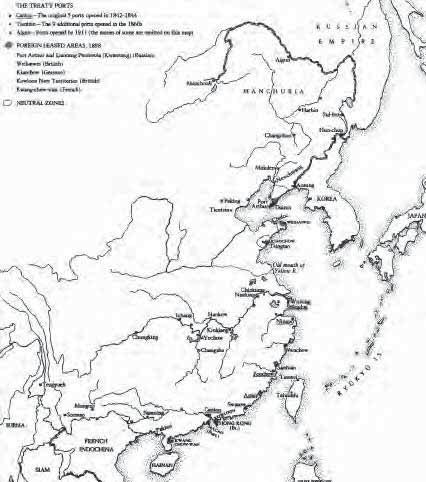
Article I. China recognizes definitely the full and complete independence and autonomy of Corea, and in consequence, the payment of tribute and the performance of ceremonies and formalities by Corea to China in derogation of such independence and autonomy, shall wholly cease for the future.
Article VI. From the date of the exchange of the ratification of this Act until the said Treaty and Convention are brought into actual operation, the Japanese Government; its officials; commerce; navigation; frontier intercourse and trade; industries; ships and subjects, shall, in every respect, be accorded by China most favored nation treatment.
Document G
Source: Korean King Kojong’s Fourteen-Article Oath, in a ceremony held at the royal ancestral shrine, 1895.
All thoughts of dependence on China shall be cut away, and a firm foundation for independence shall be secured. 6. The payment of taxes by the people shall be regulated by law. 8. The expenses of the royal household shall be the first to be reduced, by way of setting an example to the various ministries and local officials. 11. Young men of intelligence shall be sent abroad in order to study foreign science and industries. 14. Men shall be employed without regard to their origin, and in seeking for officials recourse shall be had to capital and country alike in order to widen the avenues for men of ability to find employment.
Document H
Source: Korean Yi Sangjae, diplomat, independence fighter, and
Document B
politician and others: Memorial on National Salvation, 1898.
We, Your Majesty’s humble servants, desire to state that two important factors constitute an independent, and sovereign state: first, it must not lean upon another nation nor tolerate foreign interference in the national administration; second, it must help itself by establishing a wise policy and enforcing justice throughout the realm. Powerful neighbors have been treating us like a nobody, and even Your Majesty’s position has become perilous.
Document I
Source: So Chaep’il, reformer and founder of Korea’s first modern newspaper, TheIndependent, in People Are the Masters, 1898.
ESSAYS
51
ESSAYS
THE SCRAMBLE AMONG THE POWERS FOR CONCESSIONS
YearCountryConcession
1883JapanLaying of Pusan-Nagasaki undersea cable
1885ChinaConstruction of Inch’˘on˘ Uiju telegraph line
JapanConstruction of Pusan-Inch’˘on telegraph line
1886JapanPermission to establish coaling station on Y˘ongdo, off Pusan
1888JapanCoastal fishing rights
1891JapanPermission to establish coaling station on W˘olmi Island, off Inch’˘on Territorial fishing rights off Ky˘ongsang province
1894JapanBuilding of Seoul-Pusan railway line
1895USGold mining rights at Unsan, P’y˘ongan province
1896USBuilding of Seoul-Inch’˘on railway line
RussiaMining rights in Ky˘ongw˘on and Chongs˘ong counties, Hamgy˘ong province
Permission to establish coaling station on W˘olmi Island, off Inch’˘on Timber rights in the Yalu river basin and Ull˘ung Island areas
FranceBuilding of Seoul˘ Uiju railway line
1897GermanyGold mining rights at K˘ums˘ong, Kangw˘on province
1898RussiaPermission to establish coaling station on Y˘ongdo, off Pusan
USLaying of electricity and water mains in Seoul
RussiaAuthorization to establish Russo-Korean Bank
EnglandGold mining rights at ˘ Unsan, P’y˘ongan province
JapanExclusive purchase rights to coal produced at P’y˘ongyang
It is well known, however, that the power of the people, whether in civilized or barbaric nations, is greater than that of the officials. In Korea and China, the people do not understand their status, power, and rights, and therefore remain in slavery. When the people come to realize that they are the masters of the nation, the officials will then change and learn for the first time that the people grant them salaries and honors.
Document J
Source: Taft-Katursa Agreement, a memorandum of a conversation between Count Katsura, Prime Minister of Japan, and William Howard Taft, the personal representative of President Theodore Roosevelt, who later gave full approval of the agreement. 1905.
Secretary Taft observed that Japan’s only interest in the Philippines would be, in his opinion, to have these islands governed by a strong and friendly nation like the United States; Count Katsura confirmed in the strongest terms the correctness of his views on the point and positively stated that Japan does not harbor any aggressive designs whatever on the Philippines. Secretary Taft remarked to the effect that in his personal opinion, the establishment by Japanese troops of a suzerainty over Korea to the extent of requiring that Korea enter into no foreign treaties without the consent of Japan was the local result of the present war and would directly contribute to permanent peace in the East.
Document K
Source: The Protectorate Treaty (followed the Russo-Japanese War), 1905. Article 1. The Government of Japan, through the Department of Foreign Affairs at Tokyo, will hereafter have control and direction of the external relations and affairs of Corea, and the diplomatic and consular representatives of Japan will have the charge of the subjects and interests of Corea in foreign countries.
Document L
Source: Kai-baik Lee, A New History of Korea. Ilchokak Publishers, Seoul, Korea, 1984, 301.
Document M
Source: Treaty of Annexation, Japan’s formal annexation of Korea, 1910. His Majesty the Emperor of Japan and His Majesty the Emperor of Korea, having in view the special and close relations between their respective countries, desiring to promote the common weal of the two nations and to assure the permanent peace in the Far East, and being convinced that these objectives can be best attained by the annexation of Korea to the Empire of Japan, have resolved to conclude a treaty of such annexation. Article 1. His Majesty the Emperor of Korea makes the complete and permanent cession to His Majesty the Emperor of Japan of all rights of sovereignty over the whole of Korea. ■
BIBLIOGRAPHY
Blacker, Carmen. The Japanese Enlightenment: A Study of the Writings of Fukuzawa Yukichi. Cambridge: The University Press, 1969.
Ch’oe, Mun-hyong. Chegukchuui Sidae Ui Yolgang Kwa Hanguk, Vol. 37 and 65. Seoul: Minumsa Press, 1990.
Ferry, Jules. “Preface to Tonkin, 1890.” In Brian Tierney and Joan Scott, eds. Western Societies: A Documentary History, Vol. II. New York: McGraw Hill, Inc., 1984.
Lee, Ki-baik. A New History of Korea. Seoul, Ilchokak Publishers, 1984.
Lee, Peter H. ed. Sourcebook of Korean Civilization, Vol. II. New York: Columbia University Press, 1996.
USC-UCLAJoint East Asian Studies Center, “Treaty of Annexation,” http://www.isop.ucla.edu/eas/documents/kore1910.htm (cited June 26, 2002).
MARY E. CONNOR teaches APUS History and Asian Studies at Westridge School in Pasadena, California. In 2000 she received the Korea Society’s Fellowship in Korean Studies Program to study and travel in Korea. She received the Global Educator Award in 2002. Her book, The Koreas: A Global Studies Handbook for ABC-CLIO, was published in 2002.
Document L 52
Lesson on Japanese Occupation of Korea: 1910-1945
Discuss the locations of the colonial rule of such nations as England, France, Germany, Italy, Japan, Netherlands, Russia, Spain, Portugal, and the United States
Explain imperialism from the perspective of the colonizers and the colonized and the varied immediate and long-term responses by the people under colonial rule.
Discuss the independence struggles of the colonized regions of the world, including the roles of leaders such as Sun Yat-sen in China, and the roles of ideology and religion (Students could study the role of Syngman Rhee and Ahn Changho in the Korean Independence Movement.)
In the late 19th century, the West made forays into East Asia to benefit from new trade. Japan imitated the industry and military of Western powers and was eager to copy their expansionism. In 1876, Japan forced commercial relations on Korea. After acquiring the Philippines in the Spanish American War (1898), the United States was concerned about its ability to protect this newly acquired possession. In the secret Taft-Katsura Agreement (1905), Japan recognized U.S. control over the Philippines and in return the United States approved Japan’s supremacy over Korea.
CCSS.ELA-Literacy.RH.9-10.1 Cite specific textual evidence to support analysis of primary and secondary sources, attending to such features as the date and origin of the information.
CCSS.ELA-Literacy.RH.9-10.5 Analyze how a text uses structure to emphasize key points or advance an explanation or analysis.
CCSS.ELLA-Literacy.RH.9-10.8 Assess the extent to which the reasoning and evidence in a text support the author’s claims.
CCSS.ELA-Literacy.RH.11-12. Cite specific textual evidence to support analysis of primary and secondary sources, connecting insights gained from specific details to an understanding of the text as a whole.
CCSS.ELA-Literacy.RH.11-12.2 Determine the central ideas or information of a primary or secondary source; provide an accurate summary that makes clear the relationships among the key details and ideas.
53
Asia in Focus: The Koreas (ABC-CLIO Publishers 2009) Mary
E. Connor, Editor
What happened between 1910 and 1945 is crucial for understanding the post-WWII attitudes toward the Japanese. The Japanese were convinced that Korea was vital to their strategic and economic well being. Their plan was to destroy the spirit of the people and to make them loyal subjects of the Japanese empire.
Koreans were controlled by a police system that deprived them of basic freedoms. Newspapers were suspended, political parties abolished, and public gatherings disallowed. Authority was invested in the Governor-General who was appointed by the Emperor and controlled the military and civil police forces, made all laws, and had fiscal independence and total control of all appointments. The police wastheruling agency in politics, education, religion, morals, health and public welfare, and tax collection.
The first decade of Japanese administration has been called the dark period because of the extensive repression of political and cultural life. The occupiers created an educational system to train a labor force to serve the homeland’s econom y.Their goal was also to educate the population in Japanese customs, culture and language to the point of creating loyal, useful, and obedient subjects of the emperor. Japanese was spoken and Korean was taught only as a second language.
The colonists consolidated their position in communications, public services, and economic activities throughout the peninsula. Railroads were particularly vital for strategic and economic reasons. Japan was then free to exploit Korea’s gold, silver, iron, tungsten, and coal. A law was passed requiring approval for the formation of public or private corporations. Few Koreans received such approval. Japanese banks dominated the economy, and Korean businessmen had to depend on them for capital.
In this first phase of colonial rule, the oppressive rule forced a growing number of Koreans who expressed opposition to colonial rule to resettle in Manchuria and Russia, Some became contract laborers in Hawaii, others settled in California. After 1914 the major powers were consumed by the World War. Koreans tried to get the attention of other nations without success.
President Woodrow Wilson raised the hopes of colonized peoples around the globe with his commitment to self-determination of peoples. Korean activists planned a nationwide demonstration for independence on March 1, 1919. It was to be a non-violent expression of their desire to be free and independent from Japan. Rumors that the Japanese were involved in the death of the former Korean emperor led to widespread demonstrations throughout the country. The Japanese were caught by surprise and the police responded with thousands of arrests, beatings, and the destruction of homes,
54
churches, and even entire villages.
Many nationalists were forced to flee their homeland and join compatriots in Shanghai and elsewhere. In 1919, nationalists in Shanghai established the Provisional Government of the Republic of Korea in exile and elected Dr. Syngman Rhee its first president. Other nationalists were attracted to communism because of the Russian Revolution and the emergence of a Soviet Union as the champion of oppressed peoples everywhere. Ultimately, the differing ideologies seriously divided the movement, and no group was able to gather mass national support. In the twenty-first century both North and South Korea continue to be influenced significantly by the class and ideological conflicts that developed during and after the period of colonial rule.
As a result of the worldwide depression, Japan realized that its new industrial economy was overextended beyond what the small empire could support. Japan seized Manchuria in 1931, made it a puppet state, utilized its rich natural resources, and developed its industry. Korea was now to serve as the base for Japan’s Asian plan. Newly instituted policies emphasized rural self-sufficiency and increased industrial production. As industry expanded, thousands of peasants took factory jobs. Some resistance to the Japanese continued. Korean communists in the north organized underground peasant brigades that attacked their landlords and the police. One was led by Kim Il-Sung.
By 1934 the Japanese began to be bolder, forcing the Koreans into the cultural and political life the empire with the objective of eliminating all differences between them. Educational policies included a new curriculum that emphasized Japanese language instruction, ethics, and history. Although Japanese and Korean children originally attended separate schools, all now attended school together. These new policies also included a pledge to the emperor, forced attendance at Shinto ceremonies, and the elimination of the study and use of the Korean language altogether.
In 1939, the Japanese struck at the most cherished source of family identity by forcing Koreans to adopt Japanese names. In a nation where reverence for ancestors and family lineage had been a way of life for thousands of years, this policy could only create a deep and lasting resentment on the part of the people. The Japanese believed that their survival depended on their subjects acting and thinking as they did.
After the United States entered the war in the Pacific, there were even greater hardships. Koreans now had to work in mines and factories in Manchuria and Japan, guard prison camps, build military facilities, and serve the troops in various capacities. The Japanese organized the entire colony into groups that were responsible for providing labor and security, while rationing their own goods.
People were forced to donate gold and silver jewelry, brass and other metals to the war effort. School hours were reduced so children could work as factory laborers or in the fields. One of the most shameful developments was the so-called Comfort Corps, made up of between 100,000 and 200,000 young Korean women who were forced to serve the sexual needs of Japanese troops. Thousands of Korean men served in the military, and approximately 16 percent of the population, lived outside the country or worked in factories and mines in Manchuria, northern Korea, and Japan (including Hiroshima).
When the Emperor of Japan surrendered unofficially on August 15, 1945, it was a
55
day of jubilation for Koreans. It seemed that now for the first time since early in the 20th century they could shape their own destiny; however, the countr ywas soon to be divided after being unified for nearly 1,300 years.
Despite the harshness of colonial educational policy, there were some positive outcomes in the long run. Public education was established regardless of social status and gender, and educational facilities were constructed. Administratively, it was a uniform system of mass education to bring everyone up to a certain level. However, at the end of occupation, less than five percent of the adult population had more than an elementary school education. There was only one university, and most of the students were Japanese. The colonizers did contribute to the beginnings of economic development, but they were the primary beneficiaries. By 1936, more than half of all farm output was shipped to Japan. Three family-owned conglomerates (Samsung, Lucky, and Hyundai) did begin during occupation.
(1) Koreans still maintain that Japan has not repented.(2) Japanese politicians continue to visit a controversial WWII memorial, (3) Information about occupation/WWII is omitted in Japanese textbooks. (4) Memories of Japanese brutality linger. (5) Comfort women have come forward to reveal their horrifying past. (6) Japanese continue to discriminate against Koreans. (7) Korea considers Dokdo Island as legitimate Korean territory and a few Koreans actually reside on the small island. A Japanese teacher manual states that Dokdo Island belongs to Japan. Koreans consider Japanese claims to be absurd. (8) In 2014 Japan considered reexamining historical evidence that was used in its 1993 apology to wartime sex slaves.
Eckert, Carter J. Korea Old and New (the standard text for Korean Studies classes)
Kang, Hildi. Under the Black Umbrella (trustworthy collection of oral histories of the colonial period)
Kim, Richard. Lost Names: Scenes from a Korean Boyhood (grades 8-12) Historical fiction, well-written, accurate, and very memorable, Park, Linda Sue. When My Name was Keoko (grades 6-8) Historical fiction. Engaging and accurate.
56
Bringing Korea into the Curriculum:
The Japanese Occupation of Korea and Its Legacy
In the late 19th and early 20th century, foreign powers began to take increased interest in the Korean peninsula. During this period, lacking the capital and modern technology,Korea continued to grant many concessions to foreign powers in developing its modern industries, including mining, forestry, fisheries and railroad construction. Among these powers, Russia and Japan were the most aggressive in expanding their interests in Korea.
Following the lead of Western powers, Japan began using military force to gain territory and foreign markets. After defeating China in the Sino-Japanese War (1894-1895) and Russia in the Russo-Japanese War (1904-1905), Japan moved quickly to take over Korea. Beginning with establishing it as a protectorate in 1905, followed by annexation in 1910, the Japanese ultimately controlled virtually every aspect of Korean life until defeated in 1945.
Inspired by President Woodrow Wilson’s Fourteen Points Declaration together with intense animosity against occupation, Koreans attempted to challenge the oppressive rule of the Japanese; however, issues related to occupation live on to the present day.
Assess the validity of the above statement by incorporating information about the Japanese occupation of Korea from available sources (student textbook, article providing background information on Japanese Occupation and a PowerPoint lecture on the National Korean Studies website).
“We hereby declare that Korea is an independent state and that Koreans are a self-governing people. Weproclaim it to the nations of the world in affirmation of the principle of the quality of all nations, and we proclaim it to our posterity, preserving in perpetuity the right of national survival. We make this declaration on the strength of five thousand years of history as an expression of the devotion and loyalty of twenty million people. We claim independence in the interest of eternal and free development of our people and in accordance with the great movement for world reform based upon the awakening conscience of mankind….”
A Brief History of Japanese Civilization.
“Korea, by contrast [to Taiwan], boasted a culture older than that of Japan and a tradition of fierce independence. It also contained an old hereditary elite resentful of Japanese intrusion, and after 1895, a small but dedicated group of nationalists….Beginning March 1 of that year [1919], there were massive nationalist demonstrations appealing, as did those in Beijing [Peking] on
57
May 4, to the Wilson doctrine of national self-determination. The protests spread throughout Korea and before it was over some two million people participated. The Japanese repression was ferocious.”
Handbook of Korea. JungMoonSa Printing. Seoul, Korea, 2003.
“Expansion of Japanese colonial capital during the 1920s resulted in increased poverty and depression for Koreans, and it caused the strengthening of the resistance struggle….The exiled Provisional Government of Korea made efforts to appear before the great powers at the League of Nations Conference in Geneva in 1932, but leading countries with colonies of their own refused to discuss the Korean problem.”
Korea through the Ages, Volume II.
Yu Gwansun (1904-1920) staged demonstrations in Seoul on March 1, 1919 and organized follow-up movements. She was arrested by the Japanese police during a demonstration. Yu faced her trial in a dignified way after being brutally tortured. Even when she was imprisoned, she shouted the slogan of the movement, “Long live an independent Korea” to encourage her fellow compatriots. She later died in prison at age sixteen.
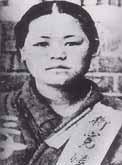
When MyName was Keoko.
“All our lessons were in Japanese. We studied Japanese language, culture and history. Schools were not allowed to teach Korean history or language. Hardly an y books or newspapers were published in Korean. People weren’teven supposed to tell old Korean folktales….We still spoke Korean athome, but onthe streets we always had tospeak Japanese. You never knew who might be listening, and the military guards could punish anyone they heard speaking Korean.”
Lost Names: Scenes from a Korean Boyhood. University of California Press, Berkeley, 1988.
58
“Then, we moved on along the line of people standing in the snow. Some shake hands with my father; most of them merely bow, without words. We are outside the gate. There, too, a long line has formed and is still forming, all the way down the hill, past the gray stucco Methodist church, and I am thinking…We lost our names; I lost my name; and these people are all going to lose their names too, when they walk into the police station….” When MyName was Keoko.
“That was what Tomo had been talking about. He’d been warning me that our metal things were about to be taken away. Maybe he thought that if we knew in advance, we could hide some things before it happened. But telling me straight out would have made him a traitor to the Japanese, his own people. He’d been telling me the only way he could – and I hadn’t understood.”
Korea’s Place in the Sun: A Modern History.
Among Koreans today, North and South, the mere mention of the idea that Japan somehow “modernized‟ Korea calls forth indignant denials, raw emotions, and the sense of mayhem having just been, or about to be committed….Koreans have always thought that the benefits of this growth went entirely to Japan and that Korea would have developed rapidly without Japanese help anyway.”
“Under the political protection of Japanese imperialism, Japanese capital investment in a wide range of industries in Korea was growing apace. War related industry in particular was established in Korea by the great zaibatsu of Mitsui, Mitsubishi and Noguchi, hand in hand with Japan’s war ministry.” 2,526(2004)
59
Insight into Dokdo: Historical, Political and Legal Perspectives on Korea’s Sovereignty.
“In February 1904 when the Russo-Japanese War started, Japan planned to construct a watchtower on Dokdo to keep an eye on the movement of the Russian Vladivostok fleet that began toharass Japanese transports. It was in February 1905 that Japan attempted to seize Dokdo clandestinely, keeping it from the knowledge of the Korean government and people. Japan simply ignored the fact that Dokdo had been an inherent part of Korean territory ever since 512 A.D., claiming it as a terra nullius, and annexed the island into its territory of Shimane Prefecture. In August 1945 when Korea was freed from Japanese occupation, the Supreme allied Powers GHQ issued SCAPIN No. 677 for Governmental and Administrative Separation of Certain Outlying Areas from Japan and restored Dokdo to Korea on January 29, 1946.”
“South Korea was the first country to send a rescue team to the disaster area. The Korean Red Cross had raised $40 million, one of the largest non-governmental contributions to Japan after the earthquake….Then camea pair of thunderbolts out of Tokyo: On April 1, the Ministry of Foreign Affairs related itsDiplomatic Bluebook 2011 detailing developments in Japan’s foreign relations
a release that came just two days after the central government approved new school textbook content. Both reiterated Japan‟s claims to the disputed Dokdo/Takeshima islands.”
A new controversial statue brought friction over World War II comfort women to Glendale, California. A statue of one of the Korean “comfort women” who were forced into sexual slavery by Japan during World War II sits in front of a library in Glendale, California.
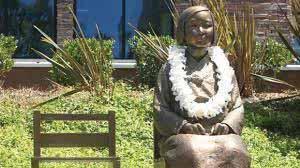
–
60
“Japan will re-examine a landmark apology it made two decades ago towomen forced towork in Japanese wartime military brothels, a government spokesman said on Friday, in a move that could further outrage South Korea many of the women came from.”
“As the issues mount, the United States, which has labored to remain an impartial friend to both nations, has found itself in the middle of a fight between itstwo mainAsian alliesat a time when it wants their cooperation to face resurgent China and a nuclear-armed North Korea….Experts say that this internationalization of what had been bilateral disputes reflects the shifting balance of power in a region where a wealthier South Korea is challenging Japan’s century-long dominance. At the same time, Japan is showing more willingness to push back under the leadership of [Prime Minister] Abe who has argued in the past that Japan‟s wartime history has been depicted too negatively.”
61
10.9 (3) Understand the importance of the Truman Doctrine and the Marshall Plan, which established the pattern for America’s postwar policy of supplying economic and military aid to prevent the spread of Communism and the resulting economic and political competition in arenas such as Southeast Asia (i.e., the Korean War, Vietnam War, Cuba, and Africa).
11.9 (3) Trace the origins and geopolitical consequences (foreign and domestic) of the Cold War and containment policy, including the Korean War.
The following question requires you to construct a coherent essay that integrates your interpretation of Documents A-Kand your knowledge of the period referred to in the question. High scores will be earned only by essays that both cite key pieces of evidence from the documents and draw on outside knowledge.
Until the mid-1960s, most Americans interpreted the United States entry in the Korean War as a war to stop communist aggression. After the war in Vietnam, many historians have argued that the conflict was basically a civil war. Using the documents and your knowledge of the period 1945-1975, assess whether the Korean War was primarily a conflict between the major powers or a civil war between the Korean people themselves.
Memoirs by Harry S. Truman: Years of Trial and Hope (1956), Communism was acting in Korea just as Hitler, Mussolini, and the Japanese had acted ten, fifteen, and twenty years earlier. I felt certain that if South Korea was allowed to fall, Communist leaders would be emboldened to override nations closer to our own shores. If the Communists were permitted to force their way into the Republic of Korea without opposition from the free world, no small nation would have the courage to resist threats and aggression by stronger Communist neighbors. If this was allowed to go unchallenged, it would mean a third world war, just as similar incidents had brought on the second world war. It was also clear to me that the foundations and the principles of the United Nations were at stake unless this unprovoked attack on Korea could be stopped.
James
US military occupation of southern Korea began on September 8, 1945 with very little preparation. Washington redeployed the XXIV Corps under the command of Lieutenant General John R. Hodge from Okinawa to Korea. US occupation officials, ignorant of Korea’s history and
I. Matray, “The Korean War 101: Causes, Course, and Conclusion of the Conflict, Education About Asia, Winter 2012.
62
culture, quickly had trouble maintaining order because almost all Koreans wanted immediate independence. It did not help that they followed the Japanese model in establishing an authoritarian US military government. Also, American occupation officials relied on wealthy landlords and businessmen who could speak English for advice. Many of these citizens were former Japanese collaborators and had very little interest in ordinary Koreans’ reform demands.
Don Oberdorfer, The Two Koreans: A Contemporary History, 1997.
Documents from the Soviet archives recently made available to historians show clearly that in March, August, and September 1949 and January 1950, Kim implored Stalin and his diplomats repeatedly to authorize an invasion of the South….On at least two occasions in 1949, Stalin turned down Kim’s requests, but the documents establish that in early 1950 he approved the war plan due to the “changed international situation.” At this writing, scholars are still unsure what led to Stalin’s reversal. Was it the victory of Mao’s Communist Party in China, the development of the Soviet Union’s atomic bomb, the withdrawal of U.S. forces from south Korea, or Secretary of State Dean Acheson’s famous statement excluding South Korea from the U.S. defense perimeter
all of which took place in 1949 or early 1950 – or a combination of these and other causes? We still do not know.
Republican Senator Robert A. Taft, Speech to the 81st Congress, Congressional Record, June 28, 1950.
If we are going to defend Korea, it seems to me that we should have retained our armed forces there and should have given, a year ago, the notice which the President has given today. With such a policy, there never would have been such an attack by the North Koreans. In short, this entirely unfortunate crisis has been produced, first, by the outrageous aggressive attitude of Soviet Russia, and second, by the bungling and inconsistent foreign policy of the administration.
Even then, it was evident that this far more than “a police action,” as President Truman was to euphemistically characterize it, far more than any localized clean-up of border-raiding North Koreans. In Korea, Communism had hurled its first challenge to war against the free world. Now was the time for decision. Now it was as clear as it would ever be that this was a battle against imperialistic Communism. Now it was the time to recognize what the history of the world has taught from the beginning of time that timidity breeds conflict, and courage often prevents it.
–
General of the Army, Douglas MacArthur, Reminiscences, 1964.
63
Carter J. Eckert et al, Korea Old and New: A History, 1990.
It is impossible to comprehend the events and significance of the period of liberation without reference to the previous four decades of Japanese rule. Colonial policies had shattered the foundations of a remarkably stable nineteenth-century bureaucratic agrarian society and unleased, new forces in conflict with the old and with each other. Korean society in 1945 was a maelstrom of old and new classes, political groups, and ideologies….Communism in Korea had also developed as a radical response to colonialism, and like other nationalist groups, the Korean communists were also divided by their experience and goals.
T. R. Fehrenbach, This Kind of War: A Study in Unpreparedness.
Equally important, Red China was ready and spoiling for war. The Chinese Communists, newly come to power, were driven by that dynamic puritanism that accompanies all great revolutions. Like the French in 1793, they not only desired conflict with the “evil” surrounding them; they needed it….there was both a sullen sense of grievance against the West and a passionate national pride in China’s millions….The West has dismissed the painful humiliations repeatedly visited upon the ancient Sinic culture in the past hundred years.
Dae-sook Suh, Kim Il Sung: The North Korean Leader, 1998.
Kim Il Sung wanted to reunify his country, if and when the international political situation surrounding the Korean peninsula was suitable for such an undertaking. Kim considered military reunification to be the most efficient solution and he was not alone in this line of thinking. Many Korean revolutionaries who returned from abroad thought that Korea should be reunified, and Syngman Rhee in the South made his intention, “to march North,” known to the people of Korea….From the time he was installed as head of the provisional People’s Committee on February 8, 1946, to the outbreak of war in June 1950, Kim never advocated peaceful reunification of Korea. He thought that the only way to achieve national reunification was by force of arms.
John Mack Faragher, Mari Jo Buhle, Daniel Czitrom and Susan H. Armitage, Out of Many: A History of the American People, 1997.
Some experienced diplomats, such as George Kennan regarded the conflict between the two Koreas as a civil war. Truman, however, treated the invasion as a major Soviet test of the U.S. policy of containment, and act of aggression that had to be met with force….The Soviets, on the
64
other hand, regarded the invasion as the consequence of former anti-Japanese military leader Kim Il Sung’s plan to overthrow a government of past collaborators with the Japanese and unite the two Koreas. Having recently been accused of “selling out” eastern Europe and ”losing” China, Truman felt compelled to act.
Carter J. Eckert at al., Korea Old and New: A History, 1990.
While there is little room for doubt that the north actually launched the attack across the 38th parallel on June 25, 1950, it is also important to place that attack in the context of the increasingly violent political polarization of the peninsula in the previous five years, especially in the two years following the establishment of separate Korean regimes in 1948. Between the end of 1948 and June 1950 South Korea, Korea was the scene of a bloody and ultimately unsuccessful, indigenous leftist guerilla war that erupted on Cheju Island…and spread throughout much of the country. During the same period military conflicts along the 38th parallel between northern and southern forces, many of which appear to have been initiated by the south, became increasingly frequent and intense and continued right into the spring of 1950.
Bruce Cumings, Korea’s Place in the Sun: A Modern History, 1997.
Whatever happened on or before June 25, it was immediately clear that this war was a matter of “Koreans invading Korea”; it was not aggression across generally accepted international lines. Nor was this the point at which the civil conflict began….Someday Koreans in North and South will reconcile as Americans eventually did, with the wisdom that civil wars have no single authors. It took Americans about a century to do so; it is therefore not surprising that Korean reconciliation is still pending after fifty years.
A. Truman, Harry, Memoirs by Harry S. Truman: Years of Trial and Hope (1956), in Thomas A. Bailey, ed., The American Spirit, Vol. II (Lexington, MA: D.C. Heath and Co., 1978), 887.
B. Matray, James I, “The Korean War 101: Causes, Course, and Conclusion of the Conflict. Education About Asia, Winter 2012, 23-24.
C. Oberdorfer, Don. The Two Koreas: A Contemporary History (Reading, MA: AddisonWesley, 1997), 9.
D. Truman, Harry, Memoirs by Harry S. Truman: Years of Trial and Hope (1956), in Thomas A. Bailey, ed., The American Spirit, Vol. II (Lexington, MA: D.C. Heath and Co, 1978),888.
65
E. MacArthur, Douglas, Reminiscences (New York: Fawcett World Library), 375
F. Eckert, Carter J., Ki-baik Lee, Young Ick Lew, Michael Robinson and Edward W. Wagner., Korea Old and New: A History (Seoul: Ilchokak Publishers, 1990), 127-128.
G. Fehrenbach, T.R., This Kind of War: A Study of Unpreparedness (New York: Giant Cardinal Edition, 1964), 294.
H. Suh, Dae-Sook, Kim Il Sung: The North Korean Leader (New York: Columbia University Press, 1988), 9.
I. Faragher, John Mack et al., Out of Many; A History of the Korean People, (Upper Saddle River, NJ: Prentice Hall.
J. 1997), 809.Eckert, Carter J., Ki-baik Lee, Young Ick Lew, Michael Robinson and Edward W. WagnerKorea Old and New: A History (Seoul: Ilchokak Publishers, 1990), 344.
K. Cumings, Bruce, Korea’s Place in the Sun: A Modern History (New York: W.W. Norton and Co., 1997, 263-4.
66
A State of Mind
A State of Mind: The 2004 documentary dramatically conveys how an authoritarian regime has shaped the minds of its people. Viewers will see images of Pyongyang and the way of life of its residents. At the time of the filming, North Koreans were frightened by the U.S. war in Iraq and convinced that our nation was an imperialist threat and our economic sanctions the source of their hardships. The film focuses on two delightful teenage girls who are selected to train for the Mass Games and whose lives revolve around a daily routine to prepare for the Games in hopes that the Dear Leader will be there to see them perform and know that they are good communists. The shots of the Mass Games show 100,000 people participating in an elaborately choreographed exhibition of dazzling colorful and perfectly synchronized routines. It is difficult to forget these images.
A State of Mind is available on Amazon Prime. There are at least five varied short videos on You Tube (Google search: A State of Mind (North Korea) A good introductory link for viewing is https://www.youtube.com/watch?v=K7bncT_f-4E
You will find a movie review of A State of Mind on page 92.
Questions for discussion:
In what ways are the two girls very different from typical American children their own age? In what ways are they similar?
What do you learn about life in Pyongyang, the capital of North Korea?
Compare the representation of North Korea in the US media versus what you see in the documentary.
Based on what you saw in the video would you consider North Korea more or less of a threat than what you thought prior to watching it?
Explain how the Mass Games inculcate in each performer the ethos of the group over the individual for the collective good.
Describe the beauty as well as the disturbing elements of the Mass Games.
What understanding do you have of communism, juche, and totalitarian rule as a result of watching this film?
What elements of Confucianism exist in North Korea?
What might be the benefits to a society of emphasizing the group over the individual? What are the benefits of emphasizing the individual over the group?
What will you remember from watching and discussing this documentary?
A perfect companion to this video is The Son, by North Korean writer, Kim Pukhyang in Modern Korean Fiction: An Anthology (edited by Bruce Fulton)
67
Tears of Blood: A Korean POW’s Fight for Freedom, Family, and Justice
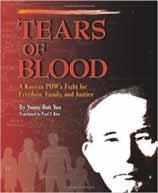 By Young-Bok Yoo and Translated by Paul T. Kim Grades 8 and beyond
By Young-Bok Yoo and Translated by Paul T. Kim Grades 8 and beyond
Publisher: Korean War POW Affairs – USA, 2012 (Available Amazon.com for $12, 167 pages
Tears of Blood: A Korean POW’s Fight for Freedom, Family, and Justice by Young-Bok Yoo is a riveting, highly readable and concise account of a survivor of the Korean War, who suffered harsh imprisonment, and forty-seven years of extreme hardship in North Korea until he escaped to freedom in South Korea at age seventy. Young-Bok Yoo’s narrative brings to life not only the chaos and suffering experienced by Koreans during the Korean War, but also informs the reader about an aspect of the war that is virtually unknown outside of Korea - 60,000 prisoners of the war were held captive against their will by the North Korean government and were never repatriated. His autobiography also vividly describes the difficulties of life in North Korea and includes key historical developments over a period of fifty years along with useful explanatory notes.
When North Korean forces invaded the south in 1950, Young-Bok Yoo was forced to join the North Korean army. After the U.N. forces landed in Incheon, he was captured by the South Korean army and imprisoned for two years with 170,000 other soldiers at Koje Island on the southern coast. Upon release, he was conscripted into the South Korean army and sent to the front lines. Yoo managed to survive, but just before the armistice he was captured by the Chinese communists and sent to a prisoner of war camp outside of Pyongyang.
In addition to providing an account of his imprisonment and other difficulties during the war, Yoo presents a vivid account of the intolerable conditions he and others experienced in North Korea. From the time he was twenty-three years old until he was seventy, he wrote that his “entire life revolved around hunger and oppression. I was always put down and never able to speak my mindfreely.” He was, as were other South Korean prisoners, exploited as a laborer in the mines, subjected to harsh conditions, weakened by tuberculosis and famine, and nearly broken by the suffering of members of his family.
68
Yoo’s account also provides a window into the tragedy of separated families during and after the war. When the Korean War broke out, Yoo’s mother took four younger siblings north of Seoul to escape the fighting while his father stayed in Seoul. His mother expected to be able to come home after the war, but with the division of the peninsula Yoo’s parents were never able to see each other again. After being separated from his father for almost half a century, Yoo was finally reunited with his ninety year old father who had lived for nearly fifty years believing his son was dead. Sadly, his father was not able tocomprehend that Young-Bok Yoo was his long lost son. While the book portrays a tragic story, it is nevertheless an inspiring one because Yoo never gave up hope for a better life for himself and his loved ones. Tears of Blood is particularly valuable not only because it portrays the impact of war on a nation and its people, but also provides the reader with a realization that the issues of Korean War have not been resolved and that the pain of the war persists in the minds and hearts of Korean families both on the Korean peninsula and throughout the world.
Yoo’s moving account is beautifully translated by Paul Kim, a young Korean American whose grandmother insisted that he grow up fluent in the Korean language. Inspired by Yoo’s story, Kim subsequently translated the book when he was only a junior in high school. Tears of Blood isparticularly recommended for high school and undergraduate students.
69
This review by Mary Connor was originally published in the Fall 2013 issue of Education About Asia
Bringing Korea into the Curriculum
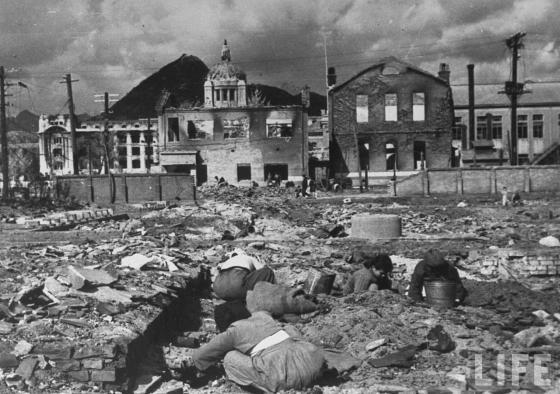
Economic Development and Democratization of South Korea

70
71
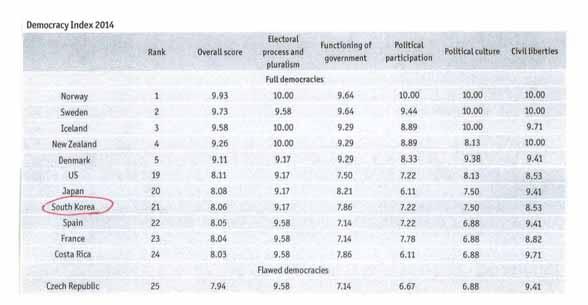
72
73
74

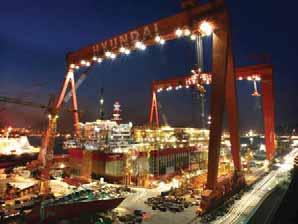


75
76
77
A Document-Based Question
Korea’s Economic Development
Despite early economic struggles and the devastation wrought by the Korean War, South Korea has achieved an incredible record of growth and integration into the world economy since the early 1960s. In 1961, monetary value of all goods and services produced in the country, or the gross national domestic product (GDP),was at the level of many poor developing countries. By 2004, South Korea had joined the wealthiest of the world’s economies. The GDP per capita adjusted by Purchasing Power Parity (PPP) was recorded at 34,386 US dollars in 2015, higher than the average European Union countries.
Grades: 10 and 12
Subjects: World History and Economics
Time: One or more class periods
Objectives:
1. Demonstrate to students the importance of finding the most reliable sources of information.
2. Convey how South Korea was able to achieve rapid economic development and technological advancement after the devastating Korean War.
3. Provide awareness of the importance of education not only for the individual, but the value of recognizing that when a nation’s citizens are well-educated and highly motivated the quality oflife for virtually everyone can improve.
4. Build upon one’s knowledge of history and economics.
5. Support a key theme of the Advanced Placement World history exam: “Creation, Expansion, and Interaction of Economic Systems.” (Note the following quotation)
“The twentieth and twenty-first centuries have witnessed experiments with many forms of economic organization, as well as a steady march toward the near-complete globalization of economic affairs, a development that has presented both costs and benefits….Immense wealth has been created in the aggregate during this era – more than the world has ever seen before –but it remains very unevenly distributed, both within societies and between them.” (AP World History, Barron’s, 2016)
78
Note: The documents on the following pages were selected for the following reasons:
1) to understand South Korea’s impressive economic and technological development;
2) recognize the importance of accessing knowledge from reputable sources (the documents were written by some of the most highly regarded scholars of Korean Studies in the United States);
3)provide students with accessible, accurate, and interesting information appropriate for high school students of World History and Economics.
Korean Economic Development
Carter J. Eckert, et al. Korea Old and New: A History.1990.397-398, 407-8.
“While the credit and responsibility for South Korean development ultimately rests with the Koreans themselves, the influence of foreign powers in shaping the country’s economy has been extraordinary….It was the Japanese colonialism [1910-1945] that ultimately laid the foundation for a modern transformation of the economy. To be sure, colonial development was geared to Japanese, rather than Korean, goals and needs. But the changes effected were nevertheless historic. The first and most important point…is that the United States since 1945 has been the decisive factor in the creation and maintenance of a political environment on the Korean peninsula in which South Korea’s particular capitalist development has taken place….In addition to insuring a political environment conducive to capitalist development, the U.S. has directly or indirectly sought to foster economic growth in South Korea….American policy makers have also tended to see the development of a strong capitalist in Korea (and elsewhere) as an integral part of their anticommunist strategy and have consequently provided South Korea with large amounts of the two things they needed the most: capital and technology. Between 1946 and 1976 the U.S. supplied a total of $12.6 billion in economic and military assistance to South Korea –more dollars per capita of aid than to any other foreign country except South Vietnam and Israel….The influx of American capital into South Korea has been accompanied by a corresponding flow of American technology and technical expertise.
[Korea’s] essential homogeneity and historically based sense of cultural attainment helped pave the way for modern Korean nationalism, which gradually developed in reaction to foreign imperialism and occupation in the late nineteenth and twentieth centuries. Colonialism, in particular, intensified nascent nationalist feeling by providing a clear external enemy and by leaving many Koreans with a passionate post-colonial resolve to match or outdo the economic achievements of their former colonial overlords….the continued strong sense of national unity and destiny and the catalytic bitterness and anger (hanin Korean) of the colonial experience –have been consciously and effectively harnessed in the service of economic growth by South Korea’s developmental state.”
79
in World History, Donald Clark, 2012. 48-50.
“The leader of the May 16, 1961, military coup in South Korea, General Park Chung-hee, vowed to lead his country out of poverty and suffering that had plagued its people since the Korean War. He cracked down on corruption and exhorted his people to work hard and save for the future. He created a central Economic Planning Board (EPB) and used his power to open doors to foreign money, borrowing capital and negotiating for aid from the United States and Japan. Beginning with this, the EPB mapped out a series of five-year plans that set ambitious targets for production. Using the slogan “Production, Exports, Construction!” the government made the Korean economy produce goods that could be sold abroad, earning foreign exchange that could be used to buy imported raw materials, machines, and advanced equipment for further production. The park government also sent Korean workers to Europe and the Middle East to earn money in places where labor was scarce. In the 1960s Korean troops fought in Vietnam, their expenses paid by the United States. These multiple sources of revenue from outside Korea “primed the pump” of the Korean economy and made it possible to exceed the five-year plan targets time after time.
The government also stressed rural development through a program called the New Community Movement. Aimed at increasing agricultural productivity and raising the standard of living in the countryside, the New Community Movement made credit available to farmers; supplied them with seeds, fertilizers, and pesticides; installed electricity and safe water; promoted public health; paved roads; built schools; and improved transportation and communications. These improvements together with the trend toward urbanization dramatically increased per capita production in the provinces and narrowed the gap in living standards between Koreans who lived in the cities and rural villages.
The enormous sacrifices required to accomplish these things were not evenly distributed despite the government’s best efforts. Many Koreans suffered under brutal working conditions. The rate of injuries and accidents among those who did “3-D” kinds of work (difficult, dirty, and dangerous), workers such as miners and those who worked in urban sweatshops, was very high…
On the other hand, the Park government tried to engineer the success of Korea’s biggest companies by having government-controlled banks make them government-guaranteed loans. These companies quickly became conglomerates, called chaebŏl, which were comprised of families of companies. The Hyundai chaebŏl, for example, includes automobiles, construction, shipping, and retailing components. Samsung, which started out with textiles, developed an electronics manufacturing specialty that became known around the world, first for televisions and microwave ovens and then for semiconductors and other high-tech computer components. Demand for Korean products overseas helped free Korea from foreign aid and then enriched the chaebŏl, enabling them to buy up smaller companies and grow big enough to control a significant part of the national economy.
80
When workers saw the wealth that was accumulating in the chaebŏl, they demanded higher wages. The Park government, however, resisted any loosening of control over the workforce. It argued that worker unrest was a threat to national security that would destabilize the country and invite intervention by Communist North Korea. Park used the national security argument to make himself a virtual dictator by 1974, ruling by decree and outlawing all criticism of himself or his style.”
Place in the Sun; A Modern History, Bruce Cumings, 1997. 335-336.
“The Korean model of development had its heyday during Park’s years from 1961 to 1979, and as they ended the economy briefly ran into a period of crisis. The economy lost 6 percent of the GNP in 1980, and exports did not really rebound until 1983. [With the support of Japan’s government and Export-Import Bank loans] combined with American support helped South Korea escape its economic crisis.
The big push, which had contributed to the last 1970s economic difficulties became a great boon to the Korean economy in the mid-1980s as Korean exports of heavy industrial goods took off and the economy grew by more than 12 percent a year from 1985 through 1988….Korea’s unionization rate has remained low by international standards; about 12 percent in 1985, it was up to 18 percent by 1990 – about the American rate of unionism, but much lower than European rates…. The total value of the stock market increased 28-fold in the period 1980-1989. In the early 1990s Korea was the ninth largest market in the world, and expected to be the fourth largest by the year 2000. Meanwhile, the chaebŏl, tired of generals coming in and seizing their property or telling them what industries to invest in, clearly moved in the same direction as the middle class, toward democratic elections and the rule of law.”
Korea: Division, Reunification, and U.S. Foreign Policy, Martin Hart-Landsberg, 1998. 181-182.
“It is noteworthy that although Park’s state-centered economic approach directly contradicted past U.S. recommendations… the U.S. government did not actively object. Apparently, the United States was willing to accept whatever was necessary to ensure the victory of ‘free” South Korea over “red” North Korea. Thus, as long as the Cold War contest remained in doubt, and as long as South Korean growth was sustained, the United States was prepared to grant Park a degree of freedom to set policy that it granted few other leaders.
Park received money from the United States by agreeing to send South Korean troops to fight in Vietnam. Some 300,000went, and according to the terms of a secret arrangement, the U.S. government paid a bonus in dollars for each of them. The United States also agreed to purchase war supplies in South Korea, allow South Korean firms to act to purchase war supplies in South Korea, allow South Korean firms to act as subcontractors for construction and service work in Vietnam, and modernize the South Korean military.”
81
The Two Koreas: A Contemporary History, Don Oberdorfer, 1997. 33-35.
“Today, however, Park is remembered less for his conflicts with Washington and successive waves of political repression than as the father of his country’s remarkable economic progress. More than two-thirds of South Koreans polled by a Seoul daily in March 1995 said Park was the country’s greatest president, more than five times the number that gave that honor to any other chief executive. The overwhelming reasons cited were the economic progress and development under his regime, and its relative stability.
Park refused to be guided by economists when he was determined to move ahead with one of his visionary projects. When American and World Bank economists said that South Korea could not successfully build, operate, or support an integrated steel mill and refused to approve financing, Park remained determined to build it. Declaring that ‘steel is national power,’ he obtained Japanese loans and personally pushed through construction of a massive mill at Pohang, on the southeast coast, which became the world’s largest steel-production site and the foundation of Korea’s heavy industry.”
Ethnic Nationalism in Korea: Genealogy, Politics, and Legacy, Gi-Wook Shin, 2006. 103.
“Park Chung-Hee took power through a coup in May 1961 and established the draconian yusin system in 1972. He was no doubt an autocratic leader, ruling the country with an iron fist. At the same time, Park, like Rhee and like Kim in the North, was a politician who recognized the power of nationalism in governing a country. Throughout his tenure as president, Park relied heavily on nationalist rhetoric to justify his illegal power taking and extralegal exercise of authority. His coup was portrayed as an effort to achieve ‘modernization of the fatherland,’ and his 1972 yusin reform was depicted as a ‘save-the-nation movement” necessitated by changing domestic and international conditions. From the time he seized power, he identified national ‘security’ and ‘development’ as the main tasks faced by the nation and justified his action as a patriotic mission. Park skillfully fused nationalism into anti-Communism and developmentalism in legitimizing his authoritarian politics.”
A Concise History of Korea: From Antiquity to the Present, Michael Seth, 2016. 421, 424, 426, 428.
“South Koreans often attribute their nation’s economic growth to traditional values loosely associated with Confucianism. By this they mean hard work, discipline, respect for learning, frugality, and the importance of family.
South Korea’s economic transformation was also made possible by the social transformation that was occurring in the country. Old social classes and social barriers were breaking down; the society was opening up to talent, becoming both highly competitive and more literate. The upheavals that resulted from the colonial period, the Second World War, the partition, and the
82
Korean War had created a more fluid society….millions of people had been exposed to a world beyond the village and were restless and open to new opportunities. There was also a sense of optimism a belief in the possibility of a better life, noted by foreign observers and often regarded by them as unrealistic.
The transformation of South Korea into a highly literate, well-schooled nation was a key component of the economic and social development. Educational development did not just keep pace with economic development, it preceded and outpaced it. While it is difficult to establish a direct correlation between education and economic development, South Korea in the 1960s, 1970s, and 1980s was able to offer a labor force that was literate, numerate, and used to learning while still low wage….By the 1990s newspaper readership was among the highest in the world. South Korea’s educational transformation by providing a well-educated citizenry not only contributed to its economic growth but also probably facilitated the transition to democracy.”
South Korea’s economic takeoff was one of the most dramatic in modern history. Foreigner after 1945 pointed to the country’s lack of resources and its dense population as great obstacles. But history has shown that there is little correlation between natural resources anddevelopment. In fact, reliance on commodities such as mineral and agricultural products has often proved to be an ineffective path to development, since commodity prices are subject to sharp swings, resulting in a boom-bust cycle, and they do not necessarily lead to the development of important technical skills. The path to development that the ROK followed – export-led growth focusing on manufacturing – has been the most successful in achieving long-term sustained economic growth. Japan’s growth rates before World War I and after the Korean War were also impressive….Taiwan and Singapore grew at comparable rates. None of these societies, however, was as poverty-stricken or had such dismal prospects as did the ROK in 1960. China might be more comparable, but is growth, due to its vast size, has been more regional, with large segments of the country and its people left behind.”
What are the main reasons for South Korea’s successful economic and technological development?
What are policies that underdeveloped countries might adopt from the Korean example revealed in the documents?
Economies the world over remain vulnerable to business cycles of periodic boom and bust, and the more integrated they become, the more vulnerability they share. From what you have studied from history and economics, what economic system seems to be the best for the greatest quality of life for most of the people? Support your statement.
83
History Today Talk Shows
East Asia Today
The History Today News Shows were created by Peter Paccone, teacher of United States History and World History, San Marino High School, San Marino, California
Students of World History and United States History cancreate their own talk shows and becomemore informed about major issues throughout the world. Their project will involve working in groups, extensive research from reliable sources, and presenting a History Today Talk Show for approximately 15-20 minutes during class. This project will be a long-term endeavor and presentations will be spread out over the course of the school year. Before the students can present their History Today Show, they must submit a proposal to demonstrate that they will fulfill the necessary requirements.
For example, four students represent the following countries: China, Japan, South Korea, and the United States. Each student will act as either the leader of China, Japan, South Korea or the U.S. Secretary of State and will be prepared to discuss concerns from the perspective of his/her country. A fifth person will act as the moderator/host. The suggested format of a proposal is as follows:
Topic: East Asia Today: China, Japan, South Korea, and the United States
To: Director and Executive Producer of East Asia Today
From: The Creative Team (students list their names)
Possible topics that students might select for the show are listed below. The students will discuss the most important concern or concerns of the country they represent. Possible issues:
1) conflicts over islands in East Asia, 2) China’s military activities in South China Sea, 3) North Korea’s nuclear program, 4) free trade, 5) cyber security, 6) U.S. Terminal High Altitude Area Defense System (THAAD), 7) human rights issues in China and North Korea,
8) North Korean defectors in South Korea, 9) China and Russia’s strong ties with North Korea, (10) China’s takeover of Hong Kong, and 10) illegal fishing.
The Guest List: Leaders of China, Japan, South Korea, and the U.S. Secretary ofState
Leaders will briefly introduce themselves and express their point of view on issues that are currently the most important to their country. As students prepare for their news show, they should have some agreement on the main issues that they discuss; however, each leader might have a particular issue that they wish to also mention.
Students are required to present a bibliography before the News Today project can be approved.
84
China Today: The Hong Kong Student Protest
England Today: Brexit
France Today: The Burkini Ban/ The Hijab Ban
Germany Today: The Syrian Refugee Crisis
Israel Today: The Two State Solution
Japan Today: The Fukushima Daiichi Nuclear Reactor Disaster
North Korea Today: North Korea’s WMDThreat
South Korea Today: South Korea’s History Textbook Controversy
Title of Show
To: Director and Executive Producer (Include title of show)
From: The Creative Team (Include first and last names of students working on this project)
Re: Suggestions for the future show (15-20 minutes maximum)
Date: Month, day, year)
THE TOPIC: Name the topic(s) that will be discussed in the show
THE GUEST LIST: We suggest the following four guests to appear on the show:
1) ? 2) ? 3) ? 4) ? 85
BIOGRAPHICAL DESCRIPTIONS:
Include biographical descriptions in no more than 100 words for eachof the four guests that will appear in the show.
THE HOST’S OPENING STATEMENTS:
Hello everyone and welcome back to yet another segment of (insert title of show). My name is (insert title), and for the next 15-20 minutes we are going to take a close look at (insert talk show topic).
In this regard, we are going to bring before you four very special guests – all with something worthwhile to say as it relates to the topic.
Our first guest is(insert first and last name of guest #1…but before actually going over to ask (insert first and last name of guest #1) some questions, I want to take a few seconds to give you a little background on this very special guest.
(Include first and last name of guest #1) and briefly describe this guest. Repeat this before each of the other three guests). Keep to no more than 100 words.
They canonly have four guests, but itispossible to include a video of a "fifth guest." Think of it like a remote guest.
After each guest has spoken, students may ask questions of the individual guests. Ideally, there should be some concluding remarks on the part of the host and the guests.
Students have done some very creative and engaging approaches by including a fifth guest. It is also possible to increase the size of some groups to five or six individuals. For some students working ina larger group is more effective.
86
A page from Mary Connor’s Asian Studies Class Scrapbook
Chinese New Year, February, 1999, Westridge School. Mary Connor (center, right) with Asian Culture Club Members and Lion Dancers
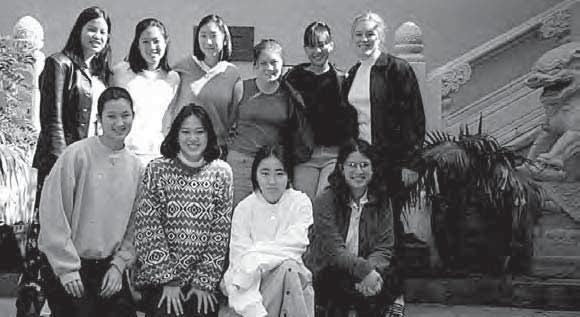
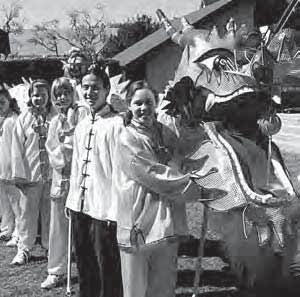
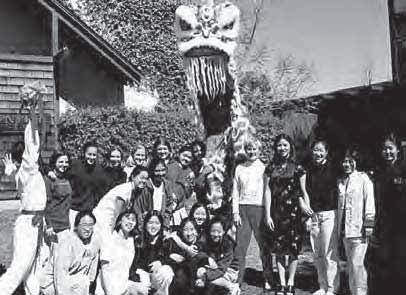
Chinese New Year Celebration. Sisters playing the Butterfly Harp and Zither
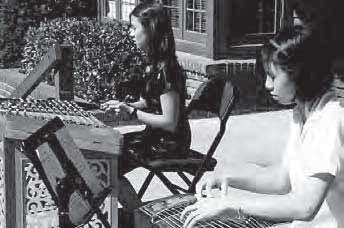
Students participating in Japanese tea ceremony.
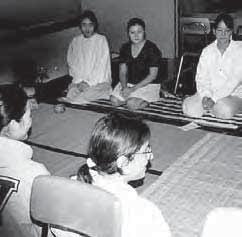
Asian Studies Class at the Japanese Gardens, Huntington Library and Gardens, San Marino, California
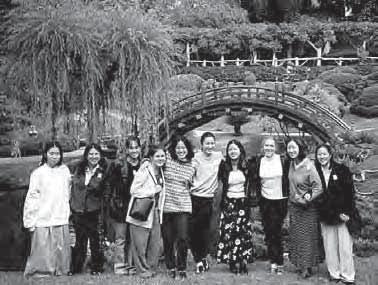 Chinese New Year Celebration with Dragon dancers and Tai chi Instructor
Chinese New Year Celebration with Dragon dancers and Tai chi Instructor
87
Asian Studies Class field trip to the Pacific Asia Museum, Pasadena, California
88
APPENDIX I SUGGESTIONSFOR CLASS ACTIVITIES
1. Write responses to the following films: To Live, Shall We Dance and Sop’yonje.
2. Participate in a field trip to the Pacific Asia Museum in Pasadena. A docent tour introduces you to the Chinese, Japanese, and Korean art collections, Chinese architecture and a Chinese garden.
3. Tour a traditional Japanese house, Zen Buddhist garden and an extensive Bonsai collection at the Huntington Library and Gardens in San Marino, California.
4. Read a booklet from the Korean Heritage Series. Individuals will share information in brief presentations to the class. This assignment is an excellent introduction to the study of Korea.
5. Participate in an exercise on the 1994 nuclear crisis in Korea. Prior to studying this event most young people think that the issues between North and South Korea were resolved at the end of the Korean War. They discover how Jimmy Carter reached an interim agreement with Kim Il Sung, but they also learn that many issues remain unresolved and the Korean situation remains precarious.
APPENDIX II
SUGGESTIONSFORTHE APPLICATIONOF HOWARD GARDNER’S MULTIPLE INTELLIGENCES THEORY
Verbal/Linguistic
INDIVIDUAL PROJECT:
Complete research on a famous individual from China, Japan, or Korea (suggestions: Mao Zedong, Deng Xiaoping, Jiang Zemin, a samurai warrior, Sen no Riky†, Hokusai, Hiroshige, Kim Il Sung, or Kim Dae Jung). Present report in the first person.
INDIVIDUALOR GROUP PROJECT:
Watch the following films about China: Farewell My Concubine, Raise the Red Lantern, and The Story of Qiu Ju. Write a report evaluating all three films. You could do a Siskel/Ebert style review for the class.
Logical/Math
INDIVIDUAL PROJECT:
Research the abacus and learn how to use it. This will be followed by a class demonstration.
Musical
INDIVIDUAL PROJECTS:
■ Do research on a musical instrument of China, Japan or Korea. Give a demonstration of the musical instrument or provide a tape appropriate to the project.
■ Take lessons on the Japanese Taiko drums at a community center.
■ Demonstrate karaoke.
■ Research Chinese opera. Provide music with the presentation.
Visual/Spatial
INDIVIDUAL PROJECTS:
■ Research Chinese landscape paintings. Complete a painting according to the principles employed by traditional artists.
■ Study Chinese porcelain. If you are taking a class in ceramics, develop a project that demonstrates knowledge of this art.
■ Create a three-dimensional map of China, Japan, or Korea.
Bodily/Kinesthetic
INDIVIDUAL PROJECTS:
Study Bonsai. View the Bonsai plants at the Huntington Gardens and consult an expert. Purchase a Bonsai and care for it from September until December. Bring the Bonsai to class and share knowledge.
■ Participate in Ikebana lessons at a local community center.
■ Take two or more lessons in Tae Kwon Do.
■ Take lessons in traditional Chinese or Korean dance. Give a demonstration to the class.
■ Practice hangul. Be able to write some key words and phrases.
■ Research the Kabuki theater. Present a scene from a Kabuki drama.
Interpersonal
INDIVIDUALOR GROUP PROJECT:
Simulate a news broadcast such as the Jim Lehrer News Hour. The news should relate to China, Japan, and/or Korea. Or include actual interviews from a news program and make your own commentary.
Intrapersonal/Introspective INDIVIDUAL PROJECT:
Take two or more lessons in Tai Chi at a community center.
BIBLIOGRAPHY
Choi, Sook Nyul. Year of Impossible Goodbyes. Boston: Houghton Mifflin Co., 1991.
Collins, Terah Kathryn. The Western Guide to Feng Shui: CreatingBalance, Harmony, and Prosperity in Your Environment. Carlsbad, Calif.: Hay House Publishers, 1996.
Covell, Jon. Korean Impact on Japanese Culture: Japan’s HiddenHistory Elizabeth, N.J.: Hollym International Corp., 1984.
Cumings, Bruce. Korea’s Place in the Sun: A Modern History. New York: W. W. Norton and Co., 1997.
Discovering the Art of Korea. Princeton: Films for the Humanities, 1993. (1-800-326-1367).
Feng Shui: The Chinese Art of Design and Placement (A Guide to Health, Wealth, and Happiness). A Mirror Images Production in Association with Feng Shui Designs, Inc., 1995, P.O. Box 399, Nevada City, CA 95959. $28.13 (includes tax and shipping).
Korean Heritage Series. Korean Overseas Information Service, Republic of Korea, 1995.
Lagatree, Kirsten M. Feng Shui: Arranging Your Home to Change Your Life. New York: Villard Books, 1996.
ESSAYS
❖
89
Mishima, Yukio. The Sound of Waves. New York: Putnam, 1956. (Students enjoy this love story about two young adults who live in a 1950s fishing village. The novel illustrates aspects of Japanese society and culture that have endured over time.)
Morton, W. Scott. China: Its History and Culture. New York: McGraw-Hill, Inc., 1995.
Morton, W. Scott. Japan: Its History and Culture. New York: McGraw-Hill, Inc., 1994. (This text is a helpful resource.)
Nahm, Andrew C. A Panorama of 5000 Years: Korean History. Elizabeth, N.J.: Hollym International Corp., 1987.
Oberdorfer, Don. The Two Koreas: A Contemporary History. Reading, Mass.: Addison-Wesley, 1997.
Okakura, Kakuz¬. The Book of Tea. New York: Kodansha International,1989.
Reischauer, Edwin O. The Japanese Today: Change and Continuity. Cambridge: Harvard University Press, 1995. (This is a particularly effective text; it combines essential historical background together with an understanding of Japanese society, government, business, and Japan’s position in the world today. This text, together with selections from Tora no Maki I, II, and III, makes our study of Japan very up-to-date.
Tai Chi Chuan for Life: The First Video Course on the Sun Style. Los Angeles: Walking Mountain Productions (phone: 310-478-0018).
The Way of T’ai Chi Ch’uan: Gentle Exercise for Health and Inner Peace with Lana Spraker. Los Angeles: T’ai Productions (phone: 310-479-3646).
Tora no Maki I (1996), Tora no Maki II (1997), and Tora no Maki III (1998) are published by the National Council for the Social Studies and ERIC Clearinghouse for Social Studies/Social Science Education, Washington, D.C. and Bloomington, Indiana, 1997. (These booklets are recently published lesson plans designed by teachers who are recipients of Keizai Koho Center Fellowships. Complete lesson plans are available within each Tora no Maki on Japanese society, culture, government, business, and technology. The most recent edition includes lessons on technology, consumerism, and an interesting comparison between department stores in the United States and Japan.)
Wardell, Steven. Rising Sons and Daughters: Life Among Japan’sNew Young. Cambridge: Plympton Press International, 1995. (Students enjoy this entertaining and informative account of a high school student’s experience in the Youth for Understanding Program.)
WEBSITES
FENG SHUI
http://www.168fengshui.com/Articles/whatis.htm
KARAOKE
http://www.arts.unimelb.edu.an/fcf/ucr/student/1996/c.yu/kara_his.htm
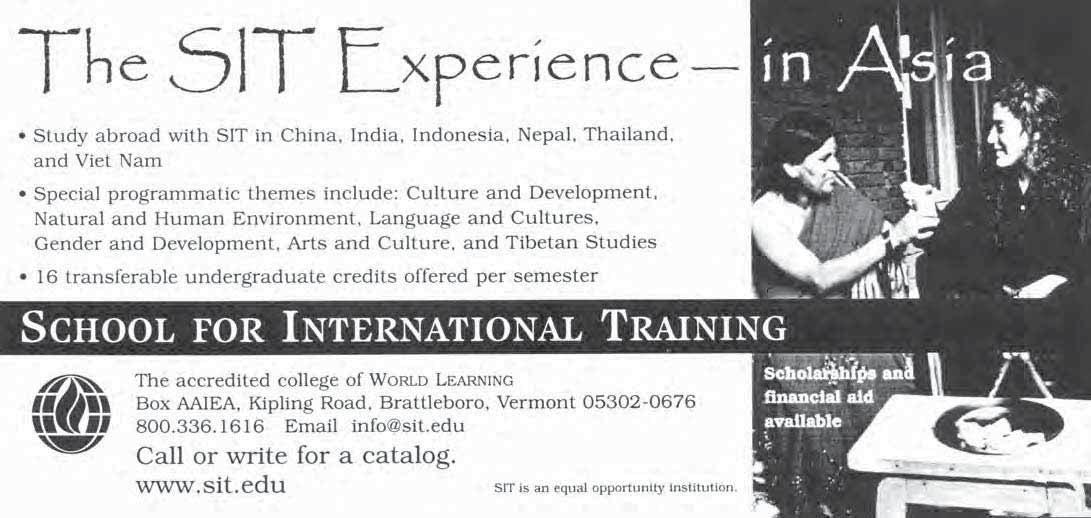
MOON FESTIVAL
http://www.insidechina.com/china/culture/festival/moonfest.htm
P’ANSORI
http://www.korea.insights.co.kr/music
TAE KWON DO http://www.pro-tkd.com/taekwon.htm
TAI CHI
http://www.wccusd.k12.ca.us/portola/china/tc.htm
Editor’s note:
Ms. Conner reports that most video stores have the films she recommends, especially in states with a high Asian population. She rented all but Sop’yonje at Blockbuster. Both To Live and Shall We Dance? are available from Facets Video (1-800-3316197). If you want to use Sop’yonje in your classroom, she suggests that you send a blank tape requesting the film with English subtitles to the Korean Cultural Service, The Embassy of the Republic of Korea, 2370 Massachusetts Avenue, Northwest, Washington, DC 20008. The Korean Cultural Service will mail the tape to you. Also, the Asia Educational Media Service offers information about where to find audio-visual media resources for teaching and learning about Asia. Contact Rebecca Payne at 217-265-0642 or e-mail: rpayne@uiuc.edu.
ESSAYS
90
KOREANFILMANDPOPULARCULTURE

BringingKoreanFilmsintotheClassroom
ByMary E. Connor
TeachersexposedtoKoreanhistoryandcultureoftenwanttolearn more.MostteachersareamazedthatKoreansnotonlyinvented metalmovabletypebeforeGutenberg,butalsotheworld’sfirst iron-cladship,knownasa“TurtleShip.”Thebeautyofancientpalaces, thespiritualityofBuddhistsculpture,andthetechnicalachievementsof Koryŏceladonpottersinspireeducatorstolearnmoresotheywillbe betterabletoteachaboutAsia.TheywilldiscoverthattheSilkRoaddid notendinChina,butextendedintoKoreaandJapanandthatearlyKoreanshadanenormousinfluenceonJapaneseculture.Studentsareled tomakecomparisons howwasitpossibleforKoreatohaveatradition ofpeace,stability,andlong,stabledynastieswhenChinahadmorethan tendynastiesduringapproximatelythesameperiod?
SouthKorea’sachievementsduringthepastsixtyyearsareextraordinary.Forexample,in1945,itwasestimatedthatonlyoneoutof everythreeKoreanswasliterate.NowKoreansareoneofthemostliterateandbest-educatedpeopleintheworld.Eveninimpoverished NorthKorea,theliteracyrateisninety-ninepercent.InSouthKorea, eightypercentofKoreansgraduatefromhighschoolandgoontoter-
Chunhyang
DIRECTOR,IM KWON-TAEK
DVD,120 MINUTES,2000,ENGLISH SUBTITLES
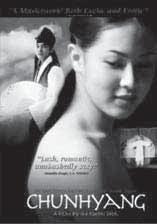
Chunhyang isbasedonKorea’smostfamousand best-lovedfolktale,andthefilmcapturesthevery essenceofChosŏnKorea(1392–1910).Createdby oneofKorea’smajordirectors,thefilmcaptivates viewers,especiallytheyoung.Itisapassionatelove story,oftencomparedto RomeoandJuliet,witha narrativeoftruelove,long-sufferingvirtue,andtriumphoverevil.
Asidefrombeinganappealinglovestory,audienceswillenjoythe beautifulKoreanlandscapes,magnificentarchitecture,extravagantsets, anddistinctiveandcolorfulKoreannativedress.Thefilmtakesplace duringtheChosŏndynasty,revealingConfucianvalues,arigidclasssystem,restrictionsonwomen,theimportanceofscholarship,goodgovernance,andtherichnessofKorea’smusicaltraditions.Structuredasastory withinaconcertperformance,a p’ansori singernarratesthestory.One graduallybecomesfamiliarwiththedistinctiverhythmsandvocalrange ofthisancientoperaticform.In Chunhyang thep’ansori(agenreofKoreantraditionalmusicthatisusuallyperformedbytwopeople oneplays thedrumwhiletheotherchantsasonginafolkstyle)ismovingaswefollowthecourting,separation,andtortureoftheheroine.
WhenMong-nyong,thearistocraticsonoftheprovincialgovernor, isonanoutinginthecountryside,heseesthebeautifulsixteen-yearold Chunhyang(springfragrance),anditisloveatfirstsight.Helearnsthat sheisthedaughterofa kisaeng (acourtesan),andtreatsChunhyangasa servant.Aftersherejectshisadvances,Mong-nyonglearnsthatherfather wasanaristocratandthatshewasbroughtupasalady.Thisfact,combinedwithChunhyang’sbeauty,arouseshispassion.Theyfalldeeplyin love,abandonthestricturesofclass,andsecretlymarry.Beforelong, Mong-nyonglearnsthathisfatherhasbeenappointedtotheking’s
tiaryeducation.Studentswilltakenoteoftheimportanceofaneducatedworkforceinachievingrapideconomicgrowth.Americanstudentsmightbeinterestedtolearnhowstudentactivistsadvanced democracyinSouthKorea.
OnepowerfulwaytoengagestudentsinKoreanhistoryandculture istointroducethemtoSouthKoreanfilms.Theamazingsuccessofthe Koreanfilmindustryhasbeenthedrivingforcebehindthe KoreanWave,aphenomenonofcontemporaryKoreanculturethathas beenwidelypopularthroughoutEastAsia,SoutheastAsia,inIndia,and particularlyamongAsianAmericanyouthintheUnitedStates. Chunhyang,TaeGukGi:The BrotherhoodofWar,J.S.A. (JointSecurity Area), and The WayHome arepartoftheKoreanWave (Hallyu),atermcoined inthelate1990sforthesuddenpopularityofKoreanfilms,televisiondramas,popmusic,moviestars,anime,andcomics.Socialstudiesteachers whoincorporatecontemporaryKoreanfilmsintotheirclassroomwill provokeinterestinKoreanhistoryandfosterappreciationforitsculture. Thisessayincludesshortreviewsoftheabovetitles,aswellasareviewof StateOf Mind,athought-provokingdocumentaryonNorthKorea.
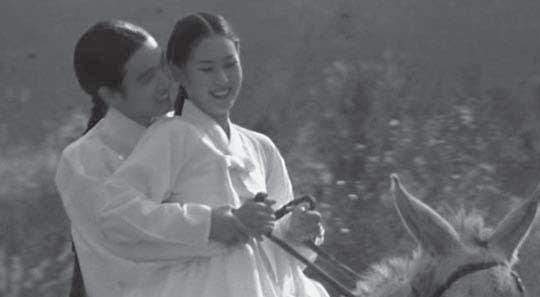
The filmtakes place duringthe Chosŏn dynasty, revealingConfucian values, a rigidclasssystem, restrictionson women,the importanceof scholarship,goodgovernance, andthe richness ofKorea’s musical traditions.

©2000 CJEntertainment
Mong-nyong and Chunhyang as husband and wife Screencapture from the film.©2000 CJEntertainment
91
Thecorrupt governor deliversa harsh sentence Screencapture from the film.©2000 CJEntertainment
KOREANFILMANDPOPULARCULTURE
cabinet,andthathemustmovetoSeoulwithhisfamily.HecannotrevealhismarriageuntilhepassestherigorousConfucianexamstogain apositioningovernmentasahigh-rankingofficial.
Theunhappyloversvowtoremainloyaltoeachotheruntilhecan return.Theirseparationlaststhreeyears.WhenMyon-nyongdoesreturn,helearnsthatthenewgovernorisacrueltyrantwhobrutalizeshis subjects,especiallyChunhyang.Sherefusestoacceptherlegalpositionas oneofhiscourtesansbydeclaringloyaltytoherhusband.Sheisbrutally
The BrotherhoodofWar (TaeGuk Gi)
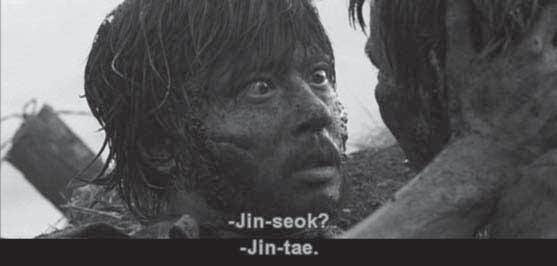
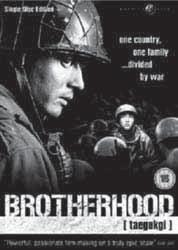 DIRECTEDBY KANG JE-GYU DVD,140 MINUTES,2004,ENGLISH SUBTITLES
DIRECTEDBY KANG JE-GYU DVD,140 MINUTES,2004,ENGLISH SUBTITLES
Thiswarfilmbrokeallattendancerecords whenitwasreleasedin2004,anditbecame Korea’shighest-grossingfilmtothatdate.Itwas selectedbestfilmandbestdirectoratthe2005 AsianPacificFilmFestival.DisturbedthatmostKoreanfilmstreatthe KoreanWarasaninevitableandimpersonalclashbetweenconflicting ColdWarideologies,DirectorKangJe-gyusetouttocreateablockbusterfilmwithaperspectivethatconveystheemotional,psychological,andphysicalimpactofwaronindividuals.Althoughthefilm portraysanimositybetweenthecommunistNorthandanti-communistSouth,itfocusesonthecloserelationshipbetweentwobrothers, Jin-TaeandJin-Seok.Thewarshatterstheirbondandcomestorepresentallthefamiliestornapartbywar.
Jin-Taeistheolderbrotherwhoearnsmoneyasashoeshineboyto helpsupporthisfamily,especiallyhisbrightandsicklybrotherwhohas dreamsofattendingcollege.Withthesuddenoutbreakofwar,thetwo areforcedintomilitaryserviceagainsttheirwill.Asisthecaseofmost SouthKoreansoldiers,theyhavenomilitarytrainingorequipment,but theyaredeterminedtosurvive.Jin-Taedecideshemustearnamedalof honorsothathisbrothercanbesenthome.AsJin-Taestrugglestosave hisbelovedbrother,hebecomesacrazedandmercilesskiller.Whenhe learnsthathisfiancéeisfalselyaccusedofbeingacommunistandis murdered,hedefectsandbecomesasoldierintheNorthKoreanarmy.
Jin-Seokgrowstohatethecrueltyofwarandevenhisbrotherbecause hebelievesthatJin-Tae’smotivesarebasedsolelyonhisobsessionwith becomingawarhero.DirectorKangJe-gyuanswerscriticismofexcessiveviolenceandthedemeaningportrayalofNorthKoreansoldiersby defendinghisthemeoftheextremepersonaldevastationofwar.Healso challengesthechargesofhistoricalinaccuraciesbyreportingthatbefore makingthefilmheobtainedextensivehistoricalinformationfromthe military,foreignsources,andfamiliesaffectedbythewar.
Mystudentsweredeeplymovedby TaeGukGi andshowedmore interestintheKoreanWarthanhadanypreviousclass.Itwasnolonger materialforatest.Theywerecaughtupinthedramaandtheplightof twoyoungbrothers.Becausethefilmisviolentandlong(148minutes), Ichosetoshowonlyafewsegments.Oneselectionestablishestheclosenessofthetwobrothers,closefamilyties,andthesuddenshockofhearingoftheoutbreakofwar.Immediatelythebrothersareforcedtoboard atrainandgoofftofightthecommunists.Aboutonequarterofmy
beatenandsentencedtodie.HeractionsconveytheConfuciantenetthat awoman’sgreatestvirtueisloyaltytoherhusband.Myon-nyongvowsrevengeandChunhyangbecomesaheroine,admiredforherbeauty,her loyaltytoherhusband,andherresistancetocorruptauthority.
Someviewersmaystrugglewiththesoundsofp’ansori,butthe hypnotizingrhythmsofthismusicalformcanbefascinating.Secondaryteachersshouldpreviewthefilmandfast-forwardoneoftheparticularlypassionatesexscenes. ■


My students were deeplymovedby TaeGukGi and showedmore interestin the Korean Warthan had anyprevious class.Itwasnolongermaterial for a test.Theywere caught upin the drama andthe plight oftwo youngbrothers.
studentselectedtowritereviewsofthefilm,rateditasexcellent,and mostsaid, I didnotknowwarwassoterrible.Anexcellentcompanion toselectionsfromthe TaeGukGi isHwangSunwon’s Cranes (1953),a touchingshortstoryaboutchildhoodfriendsandtheirbriefencounter withoneanotherwhenonoppositesidesofthewar.
Untilthe1990s,strictanti-communismwasanabsoluteprinciple ofcensorship.WiththeendofauthoritarianruleandKimDaeJung’sintroductionoftheSunshinePolicy,thehostileNorth-Southrelationship wasreexamined.Thisfilmwasa“reunificationmovie,onethatacknowledgedtherealityofdivisionandthehumansufferingitcaused, butcriticizedtheideologicalconvictionunderlyingthedivision,and exploredthepossiblereconciliationbetweenNorthandSouth.”1 ■
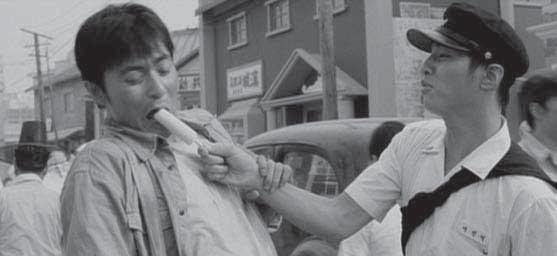
©2004KangJeGyu Films
Jin-Tae (left), andJin-Seok,beforetheoutbreak of the War Screencapture from the film.©2004KangJeGyu Films
92
Inthe heatofbattle,Jin-Tae finallyrecognizes his brother Screencapture from the film.©2004KangJeGyu Films
KOREANFILMANDPOPULARCULTURE
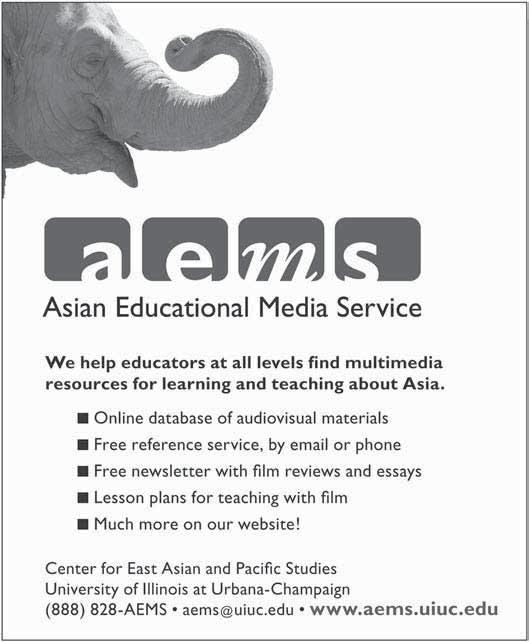

J.S.A. (JointSecurityArea)
DIRECTEDBY CHAN-WOOK PARK
DVD,110 MINUTES,2000,ENGLISH SUBTITLES
J S A (JointSecurity Area)isa“reunification” filmthatexploresthepossibilityofbecominga brothertoone’senemy.Thefilmbecamethe highestgrossingmovieinKoreanhistorywhen itwasreleasedin2000.Themovietakesplacein theDMZ (demilitarizedzone),anareaconsideredthemostheavilymilitarizedareaintheworld.Throughachance encounter,twoguardsfromopposingcampsbecomefriendsuntilthey arecaughtbyaNorthKoreanofficer.
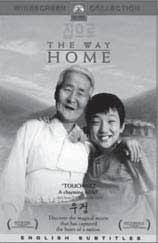
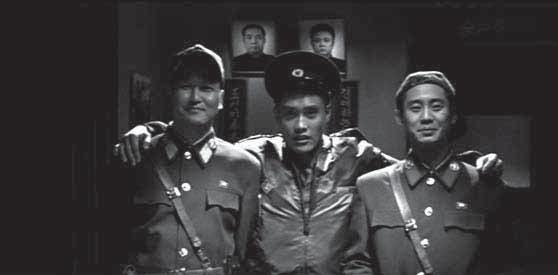
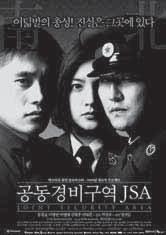
Thefilmisaboutdiscoveringone’sidentityasabrother abrother toone’senemy.Eachhadbeenindoctrinatedtohateandkilltheother, buttheirfriendshipformswiththediscoveryofwhatcanhappenwhen enemiesmeetandhaveachancetotalkandgettoknowoneanother. Althoughtheendingistragic,itremindsushowdifficultitistoovercomethepoliticsofdivisionanddistrustthataccumulateovertime.
J S A makesthecasethatColdWaridentitiescouldbeovercomeifKoreansonbothsidesoftheDMZ haveopportunitiestoopenlymeetand havegenuineconversationswithoneanother. ■
TheWay Home(Jibeuro)
WRITTENAND DIRECTEDBY LEE JEONG-HYANG
DVD,90 MINUTES,2002,ENGLISH SUBTITLES
Otherrecentfilmsreflectnostalgiaforsimpler timesandConfucianvaluesofhonor,family,and respect,whichseemtobedisappearinginasocietyundergoingradicalchange. The WayHome, releasedbyKorea’smostcommerciallysuccessful femaledirector,LeeJeong-hyang,highlightsaspectsofrurallifethathavebeenlostinthecourseofrapideconomic growth.Thefilmcapturesthedifferencesbetweenruralandurban Koreabyshowingtherelationshipbetweenaveryspoiledseven-yearoldcityboyandhisseventy-sevenyearoldgrandmother,whohasspent herentirelifeinaremotemountainvillage.Italsoconveysthegapbetweentheoldergenerationwhoexperiencedwar,poverty,andauthoritariangovernment,andtheyoungwhoaregrowingupinademocracy withmaterialcomfortsthatincludecellphones,Internetaccess,and musicvideos.Mostimportantly,thefilmisabouttheunconditional lovethatgrowsbetweenayoungboyandhisgrandmother.
Theopeningsceneof The WayHome introducesSangWoo,who istravelingfromSeoulwithhissinglemother,whohasfallenonhard timesandneedstoleaveherchildwithherelderlymotherinamountainousregionofSouthKoreawhileshefindsajob.Thegrandmother ishunchbacked,mute,andilliterate,butworkstirelesslywithoutcomplainingtocareforhergrandson.Herhomehasnoelectricity,noindoorplumbing,andnoaccesstofast-foodrestaurants.SangWoo immediatelydislikestheplace,spendsmostofhistimeplayinghis GameBoy,andtreatshisgrandmotherwithdisrespect.Herefusesto eatanythingexceptthefoodanddrinkhismotherhasleftforhim.
Thefilmisdeliberatelyslow-pacedtoimitatelifeinthecountryside. The WayHome isasimpleandverytouchingdramaaboutthe
healingpoweroflove.SangWoodesperatelymisseseverythingabout whathetookforgrantedinSeoul,butintime,theunconditionallove ofhisgrandmothertouchestheboy’sheart.Thefilmwillleadtointerestingclassroomsdiscussionsaboutfamilylife,towhicheverystudent canrelate. ■
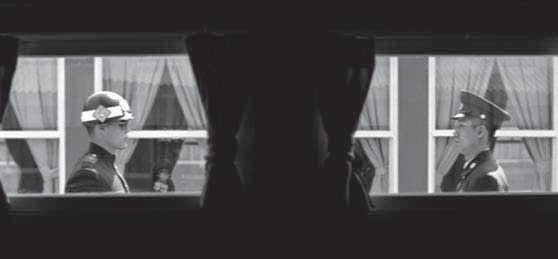
©2004Showbox. ©2000 CJE
inment
93
nterta
Guarddutyontheline Screencapture from the film.©2000
C
JEntertainment A brothertoone’senemy Screencapture from the film.©2000 CJEntertainment
KOREANFILMANDPOPULARCULTURE
AStateofMind


WRITTENAND DIRECTEDBY DANIEL GORDON VERY MUCH SO PRODUCTIONS
DVD,93 MINUTES,2003
TheBritishdocumentary AStateof Mind introducesustothedailylivesofHyonSunandSong Yun,twodelightfulNorthKoreanschoolgirls (agesthirteenandeleven)whohavebeenselected totrainfortheMassGames,aCommunistspectacleofextravagantproportionsinvolvingover100,000performers.Thefocalpointofthedocumentaryistheirmonthsofrigorousdailytrainingthatreveal determination,discipline,gymnasticskills,anddevotiontotheState. Theirgreatestwishisfortheir“DearLeader,”KimJongIl,toseethem perform,sohewillknowtheyaregoodcommunists.
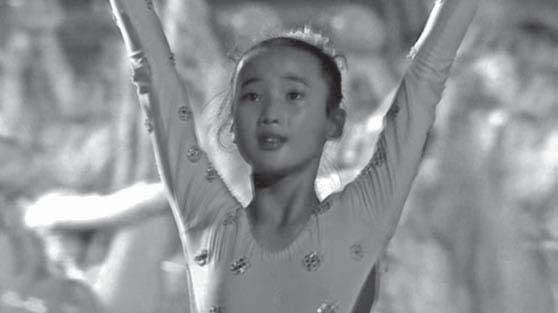
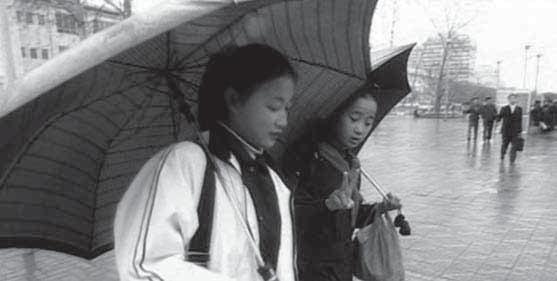
Thefilmdramaticallyconveyshowatotalitarianregimehas shapedthemindsofthepeopleandcoercedindividualstosubordinate theirownneedstothoseofsociety.ItprovidesimagesofPyongyang andthewayoflifeofthepeoplewhoresidethere.Althoughthereare nosignsofprosperity,lifeinthecapitalcityofPyongyangmayinitially seemquitereasonablegivenmostmediacoverageofNorthKorea. Mostpeopleappearhealthyandcheerful.Interviewsrevealthatthey areinterestedinUSinvolvementinIraqandareconvincedthatthe UnitedStatesisathreattotheirwayoflife.LovefortheirDearLeader
The filmdramaticallyconveys how a totalitarian regime hasshapedthe minds ofpeopleandhowindividualssubordinate their ownneeds to thoseof society asa whole.
ismatchedonlybytheiranimositytowardAmericans.Agrandfather ofoneofthegirlsrecountsthebrutalityoftheUnitedStatesduringthe KoreanWar.OthersblamethewickednessofAmericanimperialists fortheircurrenthardships,suchasfoodshortagesandnightlypower blackouts.
Onthebigday,HyonSunandSongYunperformintheMass Gamesalongwith100,000otherNorthKoreans.Themassivefloorshowdisplayscolumnsofdancersandsingers,gymnastsandacrobats, soldiers,andschoolchildren,alldressedinbrightcolors.Theamazing syncopationofsuchnumbersisawonderofchoreography.Another stunningpartoftheperformanceisthebackdropprovidedbybetween 15,000to20,000schoolchildrenpositionedinthegrandstand,facing theaudience.Theyallholdlargebookletsofcoloredcardsthatthey fliptodifferentpagesoncuetocreatedifferentscenes,suchasbeautifulmountainouslandscapes,ragingbattlefields,andimagesofKimIl SungandKimJongIl.Viewersofthedocumentarywillfindtheperformancetobehauntinglybeautiful,frightening,andtheveryembodimentofaperfecttotalitarianstate.
Gordon’sdocumentaryprovidesanexceptionalopportunitytoengagestudents.Foragenerationthatdoesnoteasilyunderstandcommunism,thisfilmprovidesanopportunitytograsptheideology,its implications,anditsholdonthepeopleofNorthKorea.Inorderto allowsufficienttimefordiscussionofthefilm,showingthefirstten minutesofthedocumentaryandthelastchapterisrecommended.To supplementthestudyofNorthKoreaonemightassign“TheSon,”a
NorthKoreanpropagandapiecethatmaybefoundin ModernKorean Fiction:AnAnthology,editedbyBruceFultonandYoungminKwon. Allofthefilmsmentionedinthisessayareavailabletopurchase fromAmazon.comortorentfromNetflixorlocalvideostores. ■
NOTES
1.Bo-MyungSeo,“ReflectionsinAmericanCinema” KoreanandKoreanAmerican Studies Bulletin (EastRockInstitute)15(2005):54.
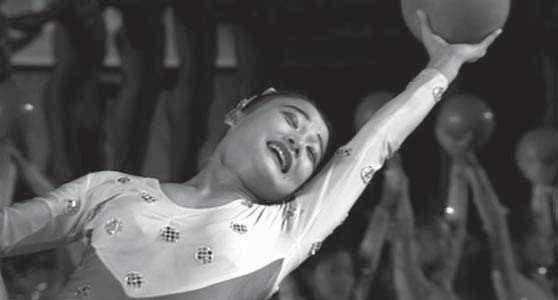
MARYCONNOR taughtUnitedStatesHistoryandAsianStudies forthirty-fiveyearsand nowservesasPresidentandProgram Directorof theKoreaAcademy for Educators,a non-profitorganizationthatinformseducatorsaboutKoreanhistoryandcultureandthe Korean-Americanexperience.Sheistheauthorof AsiainFocus:TheKoreas (2009)andthe recipientof thePeaceCorpsAssociation’sGlobal EducatorAwardandthe Organization of AmericanHistoriansTachauAward.Sherecentlyacceptedaninvitationtojointhe EAA editorialboard.
 Hyon Sun (left) andSong Yunontheirwaytoschool Screencapture from the film.©2005Kino International
Hyon Sun duringherMass Games per formance Screencapture from the film.©2005Kino International
Song Yun duringherMass Games per formance Screencapture from the film.©2005Kino International
Hyon Sun (left) andSong Yunontheirwaytoschool Screencapture from the film.©2005Kino International
Hyon Sun duringherMass Games per formance Screencapture from the film.©2005Kino International
Song Yun duringherMass Games per formance Screencapture from the film.©2005Kino International
94
©2005Keno International
Korea
in World History: Key Issues in Asian Studies ($11.59)
(By Donald N. Clark, Co-chair, Asian Studies, Trinity University, San Antonio, Texas)
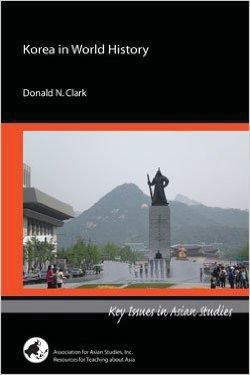
Korea in World History introduces the Korean people and the circumstances that have shaped their nation. The Republic of Korea (South Korea) is a world economic power. The Democratic People’s Republic of Korea (North Korea) is widely regarded as a failed socialist state and a threat to its neighbors. Koreans overseas constitute significant émigré communities that contribute to their new homelands, including the United States. The world needs to know Korea better, and this brief book makes it accessible to general readers.
One circumstance of Korea’s story is its location surrounded by stronger neighbors. The survival of Korean culture – language, customs, folkways, and social norms – is itself a remarkable story. In terms of East Asian history, it represents the survival of the local “small tradition” alongside the Chinese style “great tradition,” which is also an important part of Korean life. The coexistence of these two traditions in one culture is one important feature of Korea’s position in world history. This is a main theme of the historical chapters that covers the emergence of Korea’s ancient kingdoms and the development of a dynastic pattern through the end of the nineteenth century. Chapters on modern Korea present the two ordeals that the country underwent in the twentieth century: Japanese colonial rule between 1910 and 1945, and the division of Korea into north and south following World War II.
Korea in World History argues that much of the conflict between the communist north and the democratic capitalist south is rooted in the legacy of Japanese colonial rule. Though most Koreans wanted to oust the Japanese, they did not agree on the post-independence vision for their country. Some wanted the arrangements for wealth and power within Korea to remain privately owned. Others wanted to see a social and economic revolution that would redistribute wealth and power. The Cold War fostered the two regimes that represented these opposing points of view, and the tragedy of Korea is the inability of these two visions to reconcile.
95
For three years during the Korean War (1950-1953), the United Nations opposed by communist forces, tried to settle the conflict between the Korean north and south to no avail. The country remained divided and devastated after the 1953 armistice. In the last part of the book, I discuss how the two sides fared under their separate regimes. After years of dictatorship, the south emerged as a viable democracy and an economic success, due mainly to the labors and sacrifices of two generations of Koreans striving to make a better life for their children.The north, though initially more successful, eventually fell victim to poor planning and maladministration. By the 1990s, after the fall of communism in Europe, North Korea was suffering chronic failures in agriculture and industrial production. The regime’s response was to gather its remaining resources and to spur its people to greater sacrifices and efforts to support the system while viewing outsiders with fear and suspicion, resorting to nuclear threats to preserve its system.The book ends with the question of how long the elite ruling class of North Korea can maintain its people in this state of isolation and anxiety, postponing inevitable change.
This review was written by Eric Cunningham and published in Education About Asia in Volume 16.3(Winter 2011) This review can be downloaded from the Education About Asia website. The Association for Asian Studies and Education About Asia have given permission to include this article in Teaching East Asia: Korea.
96
Korean society is heavily influenced by Confucian beliefs which place great importance on respect for superiors and parents, duty to family, loyalty to friends, humility, sincerity and courtesy. Korean etiquette is strongly influenced by Confucian tradition which values above all hierarchy and respect for one’s elders.
1. Names are very personal. Westerners like to address another person by his or her first name regardless of age. For Koreans addressing someone directl y by the first name is disrespectful unless they are very close friends. For example, you should refer to an individual as Mr. Kim or Miss Park. Students who have recently arrived from Korea may call their teacher, “Teacher.” They do not mean to be disrespectful.
2. Married women in Korea keep their family name even after they get married, but many immigrant women will follow the American tradition and take their husband’s last name. In order to be safe, don’t call Mr. Kim’s wife Mrs. Kim, but refer to her as “John’s mother.” Koreans will also refer to a married woman as “the wife of Mr. Kim.”
3. Another option is to use titles when addressing someone such as President Kim, Director Lee or Reverend Park. In the Korean language there are no terms like sir or madam so titles are used.
4. When introduced, Koreans bow, exchange business cards, and shake hands using both hands respectfully. The importance of business cards is to note the person’s name and position. Knowing a person’s status is critical, since the proper language level to be used depends on the position of each person.
5. Koreans believe that direct eye contact during conversation shows boldness, and out of politeness they concentrate on the conversation, usually avoiding eye-to-eye contact. Students who have recently arrived from Korea will avoid eye-to-eye contact.
6. Koreans always use the right hand when giving an object to a person of higher status. To show the most respect, both hands hold the object as it is given or received. Use both hands when presenting business cards and ensure that the writing on the card is facing the recipient. Cards should be received with both hands and placed on the table in front of you. To immediately put the card in your pocket or bag is considered rude. You should look at the card occasionally throughout the meeting. Don’t write comments on the other person’s business card in their presence.
97
7. Koreans often smile to show embarrassment or when they feel sorry.
8. Don’t brag about your accomplishments. Be humble.
9. Koreans may have a good grasp of written English but often lack conversational skills. Therefore, speak slowly and clearly and repeat any points that you want to emphasize. It may be worthwhile to exchange notes after the meeting to further ensuring that everything had been understood.
Hello
Anyong hasimnika
How are you? Anyong haseyo?
Good morning. Anyong! (also means nice to meet you.)
Thank you Kamsa hamnida.
10. Gift giving is an important dimension of the Korean culture. Koreans love to give gifts and give gifts with regularity. When someone visits someone’s home they will take a gift (usually a box of fruit). If they do not bring a gift, it is considered impolite. The gift should be simple and personal. It should not be extravagant or the receiver will feel a sense of obligation.
11. It is not uncommon for Korean parents to give '”gifts” to teachers in hopes that you will give their children better grades. It is not a bribe, but a custom.
12. When gift-giving becomes a problem, some schools adopt new policies for parents. These schools suggest that parents may donate money to the school in their names or to give gifts to the teacher’s favorite charities.
13. In Korea, it is not really the education itself that is important, but rather, it is a diploma from the right university that counts. Korean high school students will sacrifice their childhood studying for the all-important university entrance exam which takes place in November every year. Most go to special hagwons (private institutes) to do crashcourse studying.
14. Once someone gets into one of these elite schools, their careers are set; it is a Korean's ticket into society and the job market. Students who do not make it into these schools may also go to study abroad. It is considered more prestigious than going to some third rate university in Korea. The National Korean Studies website includes an informative PowerPoint lecture on Education in Korea (Past and Present).
98
15. In Korea one should not write any living person’s name in red ink. If you do, it means they are dead. Also, you should not wrap a gift in red paper.
16. When visiting a Korean home or Buddhist temple, always remove you shoes. Bare feet can be offensive, so it is best to wear socks or stockings. Some homes will offer slippers.
17. Always let your host select where you are to sit. The seat of honor is the seat looking at the front door.
18. It is considered polite to wait for the eldest person at the table to begin eating before everyone else starts. Likewise, one does not leave the table before the eldest person finishes.
19. When eating, there are certain table manners. When drinking, offer to pour for the others at the table, starting with the eldest member of the party. To show respect, both hands should be used when pouring and when accepting. Koreans do not self-serve.
20. Never blow your nose at the table, only in the bathroom. If your nose is running from eating spicy kimchi, simply wipe your nose with tissue.
21. When sitting on the floor, keep your legs bent, not stretched towards adults.
22. It is the custom of the hostess to encourage guests to eat more. Usually since there is too much food, no one expects the guests to eat it all. If you decline a couple of times the hostess will not ask you again.
23. When done eating, leaving chopsticks and spoon on the table not in the bowl.
24. Paying: The rule is simple. The person who suggests going out pays. It is impolite to go Dutch treat; however, it is polite customary for people to argue over who pays.
25. If you make a mistake, Koreans are very forgiving. They are always very pleased when you show interest in their culture.
Connor, Mary E. The Koreas: Asia in Focus. Santa Barbara: CA. ABC-CLIO, 2009. Hur, Sonja Vegdahl and Ben Seunghwa Hur. Culture Shock! Korea: A Guide to Customs and Etiquette. Portland, OR. Graphic Arts Center Publishing Co., 1997.
Korean Americans maintain many of the customs and traditional values; however, it varies by generation. I believe that most Korean Americans continue to stress the importance of education, respect for teachers and elders, courtesy, duty to family, and loyalty to friends. Many want their children to learn the Korean language and sustain the custom of taking their shoes off before entering their homes. They are pleased when you know something about Korean history and culture and express enthusiasm for Korean food and Korean Pop music.
99
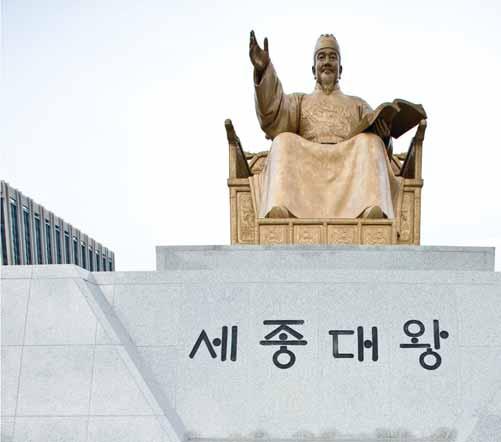

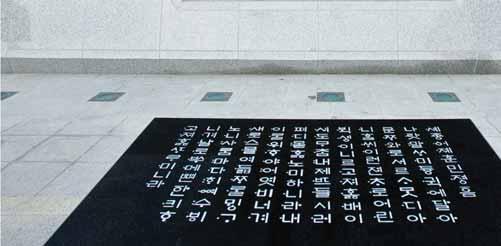

111 115 115
Korean Language
Asia in Focus: The Koreas (Editor, Mary E.Connor)
ABC-CLIO Publishers, 2009
Koreans are very proud of their language, especially their writing system known as Hangeul. They are even eager to teach others how easy it is to learn Korean. If learners do mispronounce a word, most Koreans will politely correct them. They feel this way for good reason. Hangeul is considered one of the most well-designed and easy to learn alphabets in the world. In fact, the alphabet can usually be memorized in an hour or two by most people. Hangeul’s logical design is a testament to its creator, King Sejong the Great, who promoted widespread literacy by making the alphabet easy to learn.
King Sejong (1397–1450), one of the greatest kings in Korean history, is famous for his commitment to improving the quality of life for his people. In 1446, he perfected the phonetic writing system that was easier to learn than the complicated Chinese writing system. King Sejong was a scholar and considered the creation of Hangeul his greatest accomplishment. Koreans today consider the Hangeul alphabet, “the proudest cultural achievement of the Korean people.”
Korean has been classified as part of the Altaic language famil y group related to Mongolian, Japanese, and Turkish. Despite widespread belief, Korean is not related to Chinese, but has generously borrowed much of the vocabulary and initially all of its written characters from the Chinese. Korean stands out among other languages for its rather original and scientific design.
When not tending to the official duties of the state, King Sejong lived the life of a NeoConfucian scholar, spending time reading and studying. Because of his intense interest in education, he established the Jade Hall of Scholars. In this academic research institute, scholars from every academic field came together to exchange ideas, conduct scientific research, and published their results.
The king realized that the common citizens did not have the ability to read or write the intricate Chinese characters (hanja) used by the members of the noble class. This skill required many years of discipline to perfect. Also, because hanja is of foreign origin, people could not use it to fully express the meaning of spoken words.
Hunmin Chongum
What King Sejong envisioned for his citizens was a set of letters that was uniquely Korean and easy to learn for common use among his subjects. The Korean script, which is now called Hangeul, was originally called Hunmin Chongum, or “proper sounds to instruct the people.” A manual was published under the same name in 1446 to explain the script. In the preface of that guide, King Sejong made this statement:
103
"Being of foreign origin, Chinese characters are incapable of capturing uniquely Korean meanings. Therefore, many common people have no way to express their thoughts and feelings. Out of my sympathy for their difficulties, I have created a set of twenty-eight letters. The letters are very easy to learn, and it is my fervent hope that they improve the quality of life of all people.”
This statement captures the spirit of King Sejong's purpose, devotion to cultural independence, and dedication to the benefit of the Korean people. When first announced by King Sejong, the Hunmin Chongum originally had twenty-eight letters. However in modern Korean, only twenty-four letters are used. The term Hangeul (Korean writing) came into use only during the twentieth century.
The original Hunmin Chongum was thirty-three pages long. In the first four pages was the introduction written by King Sejong. The rest of the twenty-nine pages of commentary was written by the scholars of the Jade Hall. For 500 years, the original version of the Hunmin Chongum was thought to have been lost; however it was rediscovered in 1940.
Hangeul
There are approximately six thousand languages in existence today. Only about a hundred of them have their own alphabet made by an individual for which the theory and motives behind their creation are well documented For example, the Roman characters that we use today originated with Egyptian hieroglyphics and the syllabic Phoenician alphabet. They have undergone a long process of gradual evolution. Similarly, the Chinese characters began as inscriptions on bones and tortoise shells, and they also took thousands of years to reach their current form. King Sejong systematically analyzed the basic units of spoken Korean and alphabetized them.
A major innovation for the Korean alphabet was to symbolically represent the sounds based on the shape of the mouth when making certain sounds. Jared Diamond expressed in Writing Right that King Sejong’s letters have been described as “the world’s best alphabet” and “the most scientific system of writing.” He was particularly impressed with the unique features of the Hangeul alphabet, such as the fact that “Hangeul vowels can be distinguished at a glance from Hangeul consonants.” Diamond felt that it was even more remarkable that “the shape of each consonant depicts the position in which the lips, mouth, or tongue is held to pronounce that letter.”
According to the Hunmin Chongum, the basic consonant symbols were drawn from the shape of the mouth and position of the tongue and lips as the sounds were articulated. The other consonants were formed by adding strokes to these five basic shapes.
Asia in Focus: The Koreas.
104
Characteristics of the Korean Language (Hangeul)
Tai Im, Korean Language Teacher, GahrHigh School, ABC UnifiedSchool District
Sung Kim, President,National Korean Studies and Teacher of the Korean Language
Hangeul has been at the root of the Korean culture and has contributed significantly to the preservation of its national identity and independence. Since Hangeul is considered to be easy to learn, Korea has one of the highest literacy rates in the world. Linguists and scholars throughout the world have become fascinated by the Korean language. Koreans have good reasons for being proud of their language and they wish to share it with the world.
One of the characteristics of the Korean language is that it is an honorific language. This means that you use different forms when you speak to people. For example, when you meeta stranger or anyone older than you are, you should say, “ ?” If you are speaking to your friend or anyone younger than you are, you should say “ ?” Another example is when you want to say, “come to my home.” If you speak to someone older than you, youneed to say “ .” When you talk to a friend, you will say “ .” This may sound complicated, but it is not. You will learn that most of the time, the only difference isthat you simply drop “ ” at the conclusion of what you are saying to your friend or someone younger than you. These are examples of how Korean is an honorific language.
Another characteristic of the Korean language is that the verb always comes last. This feature combined with the fact that the word order in front of the verb in a sentence really does not matter and makes the Korean language much easier to learn. For example, when you want to say “My father is buying a new car tomorrow/”, you can say ” or “ ” or “ .” Youmust remember to have the verb “ ” at the end of the sentence, but you can arrange the other words any way youwant.
Koreans take great pride in the fact that the Korean writing system is the only writing system in the world to have historical records that prove who created the written language and how. It was the great King Sejong who created this writing system nearly six hundred years ago. During his reign, he bemoaned the fact that the common people did not have the ability to read or write the complex Chinese characters that were used by the nobility. In order to improve the lives of the common people, the king decided to create a writing system that would be easy to learn. After years of research and study, King Sejong and his scholars produced an innovative writing system known as Hangeul.
In the beginning, the writing system was named Hunmin Jungeum ( ) meaning the correct sound to teach the people. King Sejong adopted the concepts of the ying and yang philosophy that dominated Korean thought during the Joseon dynasty. Certain elements were used to make vowels: a long vertical line ‘l’, a long horizontal line ‘ ’, and a small line ‘‘ representing the human, the earth, and the heaven respectively. It expresses the belief that harmony and balance are important to maintain the universe. Yin represents female, passive, dark, dry, and cold. Yang represents masculine, active, bright, wet, and hot. Corresponding to the principle of yin and yang and the belief that yin and yang created the five elements(wood, fire, earth, metal and water), each vowel and consonant in Hangeul has properties of either yin oryang.
105
In the beginning, Hunmin Jungeum had twenty-eight letters in all of which only twenty-four are in use today. A Korean syllable is divided into three parts: Chosong (initial consonant), Jungsong (peak vowel), and Jongsong (final consonant). This is the basic framework that King Sejong and his scholars adhered to when creating the letters; however, Jongsong was not separately created and wasa repetition of the Chosong. Therefore, Hangeul has just consonants and vowels. The consonants and the vowels are clearly different from one another. One of the most amazing characteristic of Hangeul is that the consonant symbols depict the position in which the lips, mouth, or tongue is held to pronounce that letter. Because of its simplicity and the small number of letters, people of all ages can find that Hangeul can be easy to learn. It is common for foreigners to gain a working knowledge of Hangeul after one or two hours of intensive study; however, it can be difficult for Westerners because of the difference from the Roman-based writing system. Writing Korean syllables does resemble writing Chinese characters. Because of its scientific design, Hangeul fortunately lends itself to mechanization. In this age of computers, people can now incorporate computers into their lives easily thanks to multiple programs written in Hangeul.
106
How to write Korean pronunciation in English - Romanization of Korean
In principle, the method of writing Hangeul in English is the Romanization of the Korean language announced by the Ministry of Culture, Sports, and Tourism.
Romanization of Korean can be written in several ways due to differences in pronunciation when converting Korean pronunciation to English.
Although it is not compulsory to write according to the romanization system of the Korean language for actual use, it is recommended to use the romanization system of the Korean language as much as possible for addresses and names used in official documents such as passports.
Source: https://rroott.tistory.com/96 [rroott]
National Institute of the Korean Language;
http://kornorms.korean.go.kr/regltn/regltnView.do?regltn_code=0004#a
Useful Videos to Study Basic Korean www.ikeneducate.org/kecos/
Korean Characteristics and Simple Expression:
https://www.youtube.com/watch?
v=uXNW1K8hBdU
Korean Vowels:
https://www.youtube.com/watch?v=ZlaUEC84gy8
Korean Compound Vowels:
https://www.youtube.com/watch?v=OhELgCqCWYU
Korean Consonants:
https://www.youtube.com/watch?v=P50yUCNHkGc
How to make Korean Letters:
https://www.youtube.com/watch?v=BMNruFPlBk0
Korean Verbs:
https://www.youtube.com/watch?v=DQGIB0Ge_9Q
Korean Verb Conjugation:
https://www.youtube.com/watch?
v=3kdwbgh1MMc
Korean Sentences and Nouns:
https://www.youtube.com/watch?v=COAgw-_8Cw0
More Korean Verbs
https://www.youtube.com/watch?v=qFHP8ReXuqg
Korean Particles:
https://www.youtube.com/watch?v=6i0hMC2P-dI
107
108
109
110
111
112
Making Korean letters using Consonants and Vowels
1. consonant + vowel
When a vertical vowel ( , , , , or ) is used: A consonant should be placed to the left of the vertical vowel.
Ex) + = + =
When a horizontal vowel ( , , , , or ) is used: A consonant should be placed to the top of the horizontal vowel.
Ex) + = + =
**An will be placed in front or top of the vowel when the sound of vowel itself is used.
Ex) + = + =
2. consonant + vowel + consonant: The fnal consonant should be placed underneath the Korean letter.
Ex) + + = + + =
3. consonant + vowel + consonant + consonant: Certain letters requires two fnal consonant and the two consonants should be placed underneath the Korean letter. In most cases, when the letter is read, the second fnal consonant becomes silent.
Ex) + + + = + + + =
113
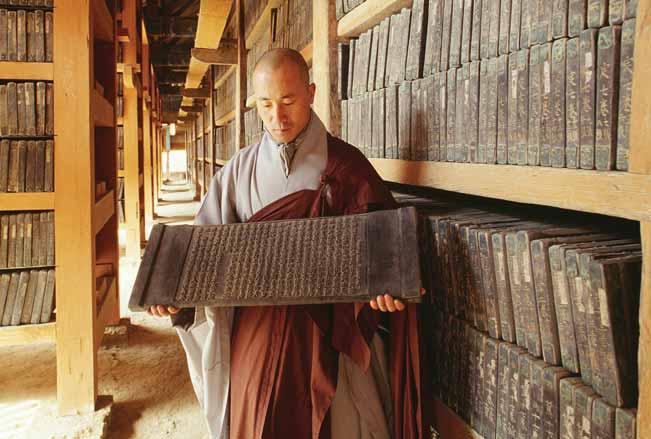
123 127 127
Bee-bim Bop!
By Linda Sue Park ($6.99)
Lesson by Mary Connor, Advisor (National Korean Studies Seminar)
Kindergarten – Grade 3
Bee-bim Bop! iswonderful paperback picture book about the joys of family and food from Newbery Award winning author Linda Sue Park. The book is a celebration of a well-loved Korean cultural dish. is a traditional Korean dish. In a bouncy-rhyming text from a child’s point of view.a hungry child tells of helping her mother make bee-bim bop: shopping, preparing ingredients, setting the table, and sitting down to enjoy a favorite meal. The enthusiasm of the narrator is conveyed in the whimsical illustrations, which bring details from the artist’s childhood in Korea to her depiction of a modern Korean-American family. The book includes Linda Sue’s own bee-bim bop recipe!
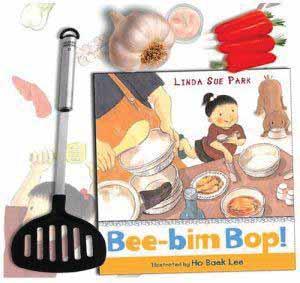
1. Before reading the book, ask the class to tell some of their favorite foods to eat at dinnertime. What are the favorite dishes in the country of origin for the family?
2. After reading the book, ask students to discuss the tone of the story and how a happy tone is created in the story and illustrations.
3. Ask members of the class to find examples of words that rhyme in the story.
4. What are some of the ingredients in bee-bim bop?
Children could explore a favorite dish created in their home and how the dish is distinctly native to their family’s country of origin.
117
(Lesson created by Mary Connor, Advisor, National Korean Studies Seminar with the inclusion of recommendations by Ann Marie Borders, Ann Arbor, Michigan)
“I love this book because it reinforces the idea that children have a right to their given names and that they have a right to expect their teachers and classmates to learn how to pronounce them. I work with many Chinese, Korean and Japanese students and it is common for these kids to feel the obligation to change their name….Accepting your name and teaching people how to pronounce it provides children with empowerment and helps the acculturation process.”
“I bought this book for my elementary classroom and loaned it to a friend and they used it for a high school class! I had a hard time getting it back. It is great, and will be used year after year inmy home and classes.”
“I bought this book to use in a college class I was taking. We had to find a cultural awareness book that would be good for children. This book fit the bill! Itis about a girl who is embarrassed by her name. The kids in her class end up writing names in a "name jar" so she can pick a new name. In the end, she ends up embracing her name. It shows children that it is okay to come from another culture. It's good for students who are coming from another country and feel like they don't "fit in" and feel the need to assimilate….I would recommend for any teacher!”
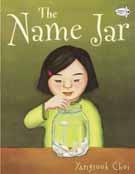
“My students and I did research as to how we got our names and who helped to name us. Kids really enjoyed this activity and this book for a beginning of the year.”
Improve cross-cultural understanding and sensitivity to one’s classmates. Provide ways for new students tofeel welcome into one’s classroom.
Ask students how they got their names and who named them.
The Name Jar
118
If appropriate, ask children where they were born, where their parents were born, and where their grandparents were born.
If suitable for the age group, locate these places on a world map. (This has been done with children as young as first grade. They love it.One school has a world map with dots showing the original homes of our ELL students.
If appropriate or if time permits, ask the children to say hello in their native language.
1. Unhei wants tochange her name at the beginning of The Name Jar. Why?
2. Have you seen examples of students identifying only with American culture? Have you seen examples of students identifying with their own culture? Why do some children want toidentify only with the American culture and not their native culture or parents’ culture? Why not both?
3. How dosome of the students treat Unhei on the bus? How does she feel afterwards? Have youhad a similar experience? What advice would you give Unhei?
4. How do students treat Unhei in her classroom? What advice does Unhei’s mother give her daughter after her first day atschool abouther name and about schoolwork?
5. What iskimchi? Have you eaten it? Have you eaten other Korean foods?
6. What does Unhei’s name mean? Does your name have a special meaning?
7. Explain about the name jar? Is this a good way to choose a name? How would you feel if students gave you new names? Ora new name?
8. What was Unhei’s name stamp?
9. How does Unhei explain to the class why she decided to keep her Korean name?
10. How did Joey show Unhei that he wants to be her friend? How does Joey show respect for Unhei?
1. ere the students involved inthe story?
2. Were students active participants inresponding to the questions?
3. How did students react when children made fun of Unhei’s name onthe bus?
4. How did they react when Unhei decided tokeep her Korean name?
5. Does the class agree with Unhei’s decision to keep her name?
6. Joey showedUnhei that he would be her friend. What can you do to welcome a new student to the classroom?
7. Do you think it is harder for a non-English speaking student to move to a new classroom? Why? What about a bilingual student?
8. Story elements: Who are the main characters in the story? Where does the story take place? What is Unhei’s problem in the story? How does she solve her problem? Who helps her make her decision?
9. Choose twoillustrations inthe booktodescribe some of Unhei’s thoughts and feelings not verbalized in the story.
10. What would you doif you were in Unhei’s position? Would you make the same decision? Is there another way this story could end?
119
Dear Juno
(Lesson by Mary Connor, Advisor to National Korean Studies Seminar)
“Juno’s grandmother writes in Korean and Juno writes in drawings, but that doesn’t mean they can’t exchange letters. From the photo his grandmother sends, Juno can tell that she has a new cat. And from the picture he makes for her – a drawing of himself with a plane in the background –Juno’s grandmother can tell that he wants her to come for a visit. So she sends Juno an extra-special package to let him know she’s on the way. This tender, intergenerational story is a perfect introduction to the concepts of creative communication and far-off lands.”
“In this lovely book, a story about communication across geographic, cultural and generational distances is distilled into a few sparkling pages. The simple, charming language is inviting for children, but it carries the force of poetry, so adults will enjoy it too.”
“I was simply amazed at how this simple little story expressed the complicated nature of intergenerational and cross-cultural relationships in such a heartfelt, effective and deceptively simple way, and that language and age barriers can be overcome with a little creativity My children loved this book and I recommend it to all parents who would like their children to understand, appreciate and thrive within the growing global culture.”
Provide an opportunity for young children to communicate through illustrations and/or the written word with a grandparent or relative by mail.
Offer a child an occasion to communicate with a member of another generation in a location far away from home.
1. With prompting and support, ask and answer questions about key details in text.
2. With prompting and support, describe the relationship between illustrations and the story in which they appear (e.g., what moment in a story an illustration depicts).
3. Retell stories, including key details, and demonstrate understanding of their central message or lesson.
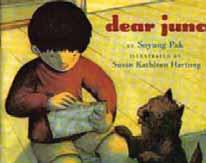
120
4. Describe the overall structure of a story, including describing how the beginning introduces the story and the ending concludes the action.
5. With guidance and support from peers and adults, develop and strengthen writing as needed by planning, revising, and editing.
Ask members of the class to tell you where their grandparents (or possibly other relatives) live (city/state/ country).This will provide an opportunity for some children to view a map or a globe of the world to show where the relatives of classroom members live.
Read the story of Dear Juno to the class and discuss the story utilizing the Standards.
Ask the children to draw a picture that tells about their family and where they live to their relative.If they are able to write, ask them to write something about themselves on a separate piece of paper and to ask the relative to communicate with them by mail.
Instruct the children to properly address an envelope to their relatives and include their return address.
The California History-Social Science Framework includes the following recommendations: “To deepen student understanding and engagement, students can read Dear Juno, a story about a young Korean boy who now lives in the United States and is corresponding with his grandmother in South Korea.”
Quality literature books may be shared to help students acquire deeper insights into life in the past and the cultures from which the families came: the stories, games, and festivals parents or grandparents might have enjoyed as students.
Students may share family photographs, artifacts, and interview their parents and grandparents. They can locate on a map where their ancestors lived, describing when their Korean family came to America, and how and why they left Korea.” (This could be a follow-up activity)
121
“Sang-hee lives in a small, unassuming, and peaceful village in Korea [in the early 19 th century]. One day, his father informs him that their little space is infinitely important (a fact that Sang-hee has a bit of difficulty believing). But his father is absolutely correct. Located beside the sea and just next to the first of a row of mountains, it was understood that in the event of a seaward attack by Korea's enemies, this village is the first line of defense. That is why Sang-hee's father climbs every night to the nearby mountain and lights a fire that can be seen for miles. Then, someone on the next mountain will see the fire and light their own. This continues all the way to the king's palace where, if the king sees the last mountain lit, he will know that all is well. Of course, if the fire is not lit, the king would immediately send his soldiers out to battle with the enemy. Now this system has gone on for generations, but Sang-hee is not content. He would love to see the king's glorious soldiers more than anything else in the world. Then, one night, his father hurts his ankle while climbing up the mountain. Sang-hee is given the task of lighting the fire himself, but as he nears the pile of dried twigs he thinks about how much he would like to see a soldier up close. And the hot coals are slowly burning out...”
“The book weighs an individual's personal wants and fantasies agains t the greater good of the whole and does so beautifully. You completely understand Sang-hee's dilemma. On the one hand, there is the fact that not lighting the fire would be a callous lie. On the other hand, maybe there is a soldier who would be glad for a chance to visit the sea. Park's story is based on factual information, as she mentions in her author's note. However, the system by which bonfires informed the king of potential attacks was in real life far more complex than the one featured here.” As Park herself mentions, "additional fires could be lit to convey further information, so the court would know not only which province was facing danger but they would know more information, such as the size of the enemy forces and how well armed they were." She provides additional resources for further reading.
1. With prompting and support, ask and answer key details in a text.
2. With prompting and support, identify characters, settings, and major events in the story.
3. Retell stories, including key details and demonstrate understanding of their central message or lesson.
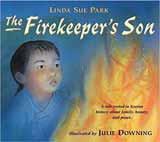
122
4. Use information gained from the illustrations to demonstrate understanding of its characters, setting, or plot.
5. Write narratives to develop real or imagined experiences or events using effective technique, descriptive details, and clear event sequences.
Show a PowerPoint called “Korea” (created by Jo Anne Kumar for elementary students) The PowerPoint is located on our website: www.koreanseminar.org
objectives depending on grade level:
1. Students will write a story summary describing key events and understanding.
2. Students will demonstrate understanding of the story’s message by writing and acting out a short play taken from one section of the book.
3. Students will complete a story map of essential elements character, setting, problem, and solution.
4. Students will describe the artwork used in this book.
1. What do you learn about the geography of Korea from reading the story, viewing the beautiful illustrations and photographs from the Internet?
2. How did Korea protect itself from a possible invasion by enemies?
3. Why was Sang-hee suddenly responsible for protecting the village? Why was his village so important to Korea?
4. Why might Sang-hee wish tosee the king’s soldiers?
5. What were the challenges of lighting the bonfire?
6. The book considers personal wants against the greater good. What does this mean? How does it relate to the story?
7. When did this story take place?
8. How does the artwork create interest in the story?
1. Describe a time when you had to choose between your wants and those of your family or community. How did you feel? What helped you make your decision? What would you advise a friend in the same situation?
2. Retell the story using a different ending. What are the consequences? How might the feelings of the characters change? How does the story end?
3. Choose one illustration in the book. Describe in detail everything you see on the page. Is the information included in the text? How does it enhance or detract from the story. What would you add to the picture or take away?
4. Would this story be the same without illustrations? Would it have the same impact on the reader? What do you think and why?
123
The unit includes thoughtful and engaging questions and activities and a culminating activity that includes kite making and flying kites. The author began her work through an extra-curricular after- school club called Where in the World? Students ingrades 3-5 created projects pertaining tolife in East Asia. They targeted countries of particular interest to sons and daughters of United States Marines. These countries included Korea, Japan, the Philippines, Vietnam, Thailand, and Cambodia. Mary Beth Poole used Korea as an example. This after-school club encouraged parent participation and included a “share fair” at the end of the school year.
Students will learn about Korean culture and history through a fictional story set during the early period of the Joseon dynasty (1392-1910)
They will learn about Confucianism and its impact on society.
They will compare and contrast traditional family relationships with American family relationships.
The students will also learn about the importance and uses of kites in cultural rituals, the settling of disputes and war.

From the reading and kite making, the students will learn about the accuracy and skills required to make a kite that flies well.
CCSS.ELA-Literacy.W.3.2 Write informative/explanatory texts toexamine a topic and convey ideas and information clearly.
CCSS.ELA-Literacy.W.3.2a Introduce a topic and group related information together, include illustrations when useful to aiding comprehension.
TheKite Fighters
124
CCSS.ELA-Literacy.RL.4.3 Describe indepth a character, setting, or event in story or drama, drawing on specific details in the text (e.g., a character’s thoughts, words, or actions).
CCSS.ELA-Literacy.RL.5.3 Compare and contrast two or more characters, settings, or events in a story or drama, drawing on specific details in the text (e.g. how characters interact).
CCSS.ELA-Literacy.RL.5.4 Determine the meaning of words and phrases as they are used in the text, including figurative language such as metaphors and similes.
Kite Fighters
“In a riveting narrative set in fifteenth-century Korea, two brothers discover a shared passion for kites. Kee-sup can craft a kite unequaled in strength and beauty, but his younger brother, Young-sup, can fly a kite asif he controlled the wind itself. Their combined skills attract the notice of Korea's young king, who chooses Young-sup to fly the royal kite in the New Year kite-flying competition-an honor that is also an awesome responsibility. The boys' father insists that the older brother represent the family, but both brothers know that this time the family's honor is best left in Young-sup's hands. This touching and suspenseful story, filled with the authentic detail and flavor of traditional Korean kite fighting, brings a remarkable setting vividly to life.”
“Set in Seoul, Korea, in 1473, Kite Fighters depicts the relationship of two brothers in a tradition-bound family. Lee Young-sup is acutely aware of the difference in his status being a younger brother, but he finds a true talent the first time he flies a kite. First-born son, Kee-sup, is under pressure from his father, a rice merchant, to advance the family honor by becoming a court official; he spends much of his time studying for the position, though it is not his true life goal. Young-sup's growing expertise in flying kites and Kee-sup's craft in making them draw the attention of the boy-king of Korea, modeled after King Songjong, and they become friends with the king outside of the ancient protocol and secretly represent him for the kite-fighting competition during the New Year's festival. It is the tension between traditional duties and individual needs.”
Websites tosupport instruction on The Kite Fighters
Google: (An excellent resource for learning about kites from around the world and how to order kite-making kits). The cost for Korean Fighter Kites is $12.50 for materials for assembling ten kites)
For additional information, do an Internet search on the history of Korean kites.


www.korea.net will provide background on Korea and photographs.

125
Have students complete a Quick Write on their experience flying a kite. It can be a real or imagined experience. Students share experience with two others. The teacher selects at random two Quick Writes to be shared with the class.
http://www.youtube.com/watch?v=bPAj7ft4jU0 A possible overview of the Korean Joseon dynasty history, the period when the Kite Fighters takes place. (The video is from the Korean History Channel)
Briefly discuss Korea in the world today including industry, geography, government and recent history.
Possible use of Power Point lecture (Pre-Modern Korea) provide by the National Korean Studies Seminar. Slides 44-80
Display Korean artifacts and cultural items (can be via digital technology including PowerPoint and YouTube).
Briefly discuss the history of Korea including development during the Joseon dynasty.
Display books and artifacts about Korea including K-POP music.
Yut set p.4; Seoul, p. 4; reel p.6; tak-gabi, p. 8 Note: 1) Yut is a popular traditional Korean game for children. There is a PowerPoint lecture on the game of Yut on the Korean seminar website). Note 2) tak-gabi is an imaginarymonster in Korean folk tales.
1. Contrast the New Year’s Celebration in your family with the celebration described in Chapter 1.
2. How would you answer Young-sup’s question, “If you could draw the wind, what would it look like?
3. Discuss a time when a non-human item spoke to you like the kite spoke to Young-sup. Summer fading, p. 9; askew, p. 9; bamboo sticks, p. 10; Four leg bridle, p. 12; unceremoniously, p.12; misalign.
1. Contrast Young-sup’s and Kee-sup’s way of making a kite. Analyze which style is best? Which style is most like your style?
126
2. Explain what Young-sup meant when he described, “The kite was like a part of him—the part that could fly.”
3. Why did Kee-sup refuse to make a kite for Young-sup? How would you have responded to Young-sup’s request for a kite? Why?
Soothsayer, p. 18; Capping ceremony, p. 18; propitious p.18, scrolls, p. 18; stoic, p. 19.
1. Contrast Young-sup’s and Kee-sup’s relationship with their father. Why were the boys treated so differently? How did the brothers react to this treatment?
2. Describe the purpose of the capping ceremony. What is a comparable ceremony in our culture?
Craftsman, p. 24, won, p. 25; idle boasting, p. 28; Favorite maneuvers, p. 30, dubious, p. 32.
1. What did Young-sup’s mother mean when she said, “Your face i s like a month of rain, my son.What makes the clouds inside your head so dark and heavy?” Why did the author use that language?
2. Evaluate the bargain Young-sup made with the kite seller. Who had the best part of the bargain?
3. Why couldn’t Young-sup ask his mother for the money he needed?
Dowager Queen, p. 34; palanquin, p. 34.
1. Compare the Korean king and the president of the United States.
2. What would you have said to the kingif he wanted tofly your kite?
3. Describe the kite you would make for the king? adamant p. 39; agony of indecision, p.40; symmetrical rhythm, p. 42; artistic scruples, p. 42; stingy, p. 44; entry to the court p. 45; unison, p. 45; essence, p. 47.
1. How do we know the boy’s father and mother were proud that their sons were making a kite for the king?
127
2. Outline the reasons for the changes in the brother’s relationship that were described in this chapter.
Tutor, p. 50; scrolls, p 50; courtiers, p.52; coterie, p. 53; beckoned, p. 59
1. Contrast your school with the school that Young-sup and Kee-sup attended.
2. Explain the line, “It is not so difficult for Young-sup to teach the King about flying. To teach him about speaking was another matter entirely.”
3. What did Young-sup accomplish by pushing the king down?
Gold leaf, p. 60; prevailed, p. 61; gape, p. 62; in favor atthe court; p. 62; antechamber, p. 62; banter, p. 64; kick the shuttlecock, p. 67. (see image of shuttlecock below) The shuttlecock was a popular children’s game)
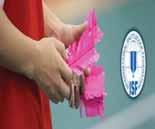
1. Explain the quote, “Who are you calling pig-brain, you cow-dung?” p. 64
2. What would you have advised the king about flying in the New Year’s Kite Festival?
3. Why did Kee-sup mean when he said, “Shuttlecock…a game you play when you have no one to play with.” p. 69.
Instinctively, p. 70; Confucius, p. 71; rage, p. 72, sullen, p. 76; filial duty, p. 79; taboo, p. 80.
128
1. Analyze the conflict between Young-sup and Kee-sup. Compare that conflict with your relationship with another person.
2. What was important about who provided the money for the seventh kite?
3. Which of the Five Virtues of Confucius is most important? Which would be the most difficult to follow? Pages 74-75 (See information on Confucianism in the Religion and Philosophy chapter. Hall of Ancestors, p. 86; bowing ceremony, p. 86; mallet, p. 88; porcelain, p. 89; taut, p. 89; demon, p. 91.
1. How did the small cut on Young-sup’s hand lead to a big discovery?
2. Who would you have asked to find out if there was a rule against making the kite string sharper?
3. Describe what is meant by, “It is you, yourself, and your brother who must decide ifitis honorable?” p. 94
Lacquerware box, p.96; furrowed his brow, p. 97; dignified, p. 98; confrontation, p. 99; solemn, p. 102; knock-out style, p. 104
1. How would you cut a sky blue or invisible line when kit fighting?
2. How would you explain why Young-sup was planning to fly the king’s kite (include at least two reasons)?
3. How did the kite festival participants respond at the sound of the gong? Why?
4. Why were the first kites called “wishingkites”?
5. What strategy would you use to win the kite fighting contest? Alliance, p. 110; gingerly, p. 112; wobbly, p. 113; frayed, p. 114; reassurance, p. 115.
1. Would you have been like the judges and been suspicious of Young-sup’s kite string? What made them suspicious?
2. Explain why the brothers disagreed about replacing part of the kite line.
Tottered, p. 118, pandemonium, p. 122; bewildered, p. 122, jostling, p. 123.
1. Relate how Keep-sup advised his brother on when to change his kite fighting strategy?
2. How did the author communicate the excitement of the last round of kite fighting?
3. Why were the brothers so surprised at their father’s behavior right after the last kite fight?
4. How did Young-sup initially know that he had won?
129
Ravenous, p. 128
1. Analyze why Kim Hee-nam tell the judges that Young-sup had won?
2. List passages from the chapter that show how the relationship between Young-sup and Kee-sup had changed.
3. What did you especially like about the end of this book?
4. Which parts of this book could be true?
5. What do you predict happened to Young-sup and Kee-sup after this book ended? What evidence do you have for your prediction?
6. Compare and contrast the life of two brothers today with the two brothers in Kite Fighters.
130
Good Fortune in a Wrapping Cloth
(Lesson developed by Mary Connor, Advisor National Korean Studies Seminar)
“Ji-su’s mother has been chosen by the king to be a seamstress at the palace and sew bojagi, or wrapping cloths, for the royal household. It is a great honor, but to Ji -su it means saying good-bye to her mother. The only way for them to be reunited, Ji-su realizes, is for her to become a seamstress just as talented as her mother and to be chosen to serve the king. Through the changing seasons, Ji-su sews, learning the craft from her aunt and practicing her stitches tirelessly. One day, she finally has the chance to show her work to the palace Sanguiwon master, who has the power to bring her to her mother or to dash her hopes of being reunited. Is her sewing fine enough for the king?
Joan Schoettler’s warm text brings the landscape and culture ancient Korea and to life. Together with illustrator Jessica Lanan’ s breathtaking depictions of Korea through the seasons, Ji-su s story of longing and determination will capture the hearts of readers of all ages. ”
“Good Fortune in a Wrapping Cloth is a story about historical Korean culture with a timeless storyline and vibrant illustrations that bring the book to life. Readers of all ages will learn about Korean food, dress and arts while learning that with hard work, dedication and will to follow your heart you can achieve your dreams. What really sets the book apart are the beautiful watercolor illustrations. Each painting not only tells the story, but gives rich detail about architecture, dress, ecology, seasons and more. The rich colors and expressive designs pull the reader in to a different culture and time. The skillful painting of light makes you feel as if you are outside on a summer day or in a dark, fire-lit room at night. The illustrations are simply wonderful! This book is appropriate for readers of all ages, but enjoyed most by more mature readers, ages 6+.”
“This is a wonderful story of determination and tradition. The watercolor illustrations help tell a soft story of family. Young readers will learn Korean culture and language through the eyes of a young girl. In the back of the book readers, teachers and homeschoolers will be able to study the glossary of terms and read the Author's Notes about bojagi and the Joseon Dynasty.”
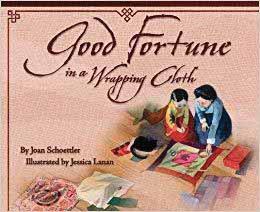
131
Ask and answer questions about key details in a text.
Retell stories, including key details, and demonstrate understanding of their central message or lesson.
Describe how characters in a story respond to major events and challenges.
Use information gained from the illustrations and words in a print or digital text to demonstrate understanding of its characters, setting, or plot.
Provide a concluding statement or section.
Describe in depth a character, setting, or event in a story or drama, drawing on specific details in the text (e.g., a character’s thoughts, words, or actions).
Determine a theme of a story, drama, or poem from details in the text, including how characters in a story or drama respond to challenges or how the speaker in a poem reflects upon a topic; summarize the text.
Students will realize that with hard work and determination one may learn a new a new skill and attain great personal satisfaction.
Students willlearn about Korean history and culture and develop an awareness of an Asian art form. Read Carrie Jeruzal’s lesson, “Using Korean Bojagi in the Classroom,” published in the 2013 Fall Issue of Education About Asia. See Art chapter.
Point to East Asia on a map and show the location of Korea. Go to Korea.net for information and photographs of Korea, especially the section, Culture and the Arts and Housing.
Show the Power Point lecture, Bojagi, The Art of the Korean Wrapping Cloth
Write some of the key words mentioned in the glossary, such as Eomma (mother) on the board.
1. Why would Ji-su’s mother be willing to leave home and leave her daughter without a parent to care for her?
2. Wrapping a package with a bojagi sends what message to the person who receives the gift?
3. What does Ji-su ask her aunt to do?
132
4. Why does Ji-su want to create beautiful bojagi?
5. What seasons are illustrated in the story?
6. What do bats symbolize?
7. Jisu gives up playing with her friends throughout the changing seasons as she is determined to perfect her bojagi skills. When the Sanguiwon master examines her work, what does he say? How does Jisu react to his words? What gives her hope?
8. What really matters to Jisu after the Sanguiwon master leaves her home?
9. What is the Dano festival?
10. When the Sanguiwon master returns at the time of the festival, what does the master say about Jisu’s bojagi What is Ji-su expected to do quickly?
11. What did Ji-su mean at the end of the story when she says, “Good fortune is in the wrapping cloth”?
12. What lesson can be learned from Ji-su’s determination to perfect her bojagi?
13. What do you learn about Korea in terms of architecture, art, dress, geography, government, language, religion, and the children’s game, yut?
1. Design a rubric to assess student understanding of this text.
2. Prepare a simple question and answer sheet from story.
3. List and illustrate definitions mentioned in the glossary including Eomma (mother)
4. List skills needed and learned by Ji-su in the story.
5. What lessons did you learn in the story?
Provide an opportunity for students to create bojagi and learn about the importance of accuracy and skill in creating this art form.
133
A Single Shard
( : Created by Jeff Poland, Campus Middle School, Cherry Creek Schools Greenwood Village, Colorado and updated by Mary Connor, Advisor, National Korean Studies Seminar)
In this Newbery Medal-winning book set in 12th century Korea, Tree-ear, a 13-year-old orphan, lives under a bridge in Ch’ulp’o, a potters’ village famed for delicate celadon ware. He has become fascinated with the potter’s craft; he wants nothing more than to watch master potter Min at work, and he dreams of making a pot of his own someday. When Min takes Tree-ear on as his helper, Tree-ear is elated until he finds obstacles in his path: the backbreaking labor of digging and hauling clay, Min’s irascible temper, and his own ignorance. But Tree-ear is determined to prove himself even if it means taking a long, solitary journey on foot to present Min’s work in the hope of a royal commission.even if it means arriving at the royal court with nothing toshow but a single celadon shard. (Amazon.com)
Buddhism: http://www.koreanbuddhism.net/,http://www.buddhanet.net/ , http://www.buddhanet.net/e-learning/basic-guide.htm
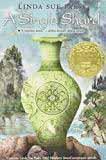
134
Daoism: http://afe.easia.columbia.edu (search: Daoism)
http://daoiststudies.org
Confucianism: See Religion and Philosophy Chapter: Korea and Confucianism
Explain how the following quotations from the novel can be explained in terms of Buddhist, Confucian, or Daoist teachings and ideas.
1. “Why is it that pride and foolishness were so often close companions”? (p. 102)
2. “His pride keeps him from a royal commission.” (p. 89)
Buddhist teachings warn against clinging toworldly concepts or objects asitis the cause of all human suffering. Worldly objects can also prevent one from achieving Nirvana.
3. “Have you hungered well today?” (p.3)
In general, life on earth is suffering.
4. “My friend, the same wind that blows one door shut, often blows another open.” (p. 97)
There are many paths to enlightenment.
5 “But a well kept tradition can be stronger than law.” (p. 97)
Tradition is an important part of Buddhist practice.
6. “One day, one village.” (p. 93)
Crane Man tells Tree Ear to pretend he is only traveling to the next village. This represents the Buddhist idea of taking life one day at a timeand remaining focused on the present.
7. Tree Ear support and honors Ajima and Crane Man as if they are family.
Honoring one’s parents isone of the five key relationships inConfucianism.
8. “But a well kept tradition canbe stronger than law.” (p. 97)
Tradition and returning to the old ways is a very important part of Confucian tradition.
9. “One hill, one valley.” (p. 148)
This reflects on the balance of good and evil. It shows that life is never all goodor evil but a mix, which is symbolized by the Yin and Yang symbol of Daoism.
135
10. The fact that they live in a small village is a Daoist idea since they are closer to nature. Also, the stream represents going with the flow of Daoism.
Identify each of the following asbeing examples ofBuddhism, Daoism, or Confucianism.
11. The idea thatwork gives a person dignity.
12. The monks take care of orphans.
13. The importance ofscholars and learning.
14. Notmaking eye contact.
15. Bowing out of respect for elders.
16. Tree Ear’s frustration that he can’t work onpottery the first day he is at work.
17. Knowing one’s position insociety.
18. Monks donating clothes to the poor.
19. The importance ofpatience and perfection.
20. The importance ofaddressing someone correctly.
21. Living by the stream.
22. Tree Ear saving food for Crane Man.
(Created by Constance Vidor, Director of Library Services, Friends Seminary, New York, New York)
The following is an interactive multimedia online learning module at the Voicethread web site on Linda Sue Park’s award-winning book.
A Single Shard: History, Culture, and Themes of the Book
A Single Shard-http://voicethread.com/share/584594/
Voicethread (www.voicethread.com) is a web application that allows users to upload pictures and record narration. People “reading” the voicethread (listening to the narration and looking at the images) can also post their recorded comments as responses to the narration.
136
The Voicethreads summarizes the story and provides images and explanations for geographical, cultural, and historical elements that are referenced in the book. Image credits are included at the end of each Voicethread so that users can see that there has been an effort toobtainimages that are authentic representations of the ideas discussed in the narration. The Voicethread, when used in conjunction with the book, could serve as anintroduction to Korean history and culture.
My Linda Sue Park Voicethreads are open for use by anyone in the world with Internet access and have the potential to reach thousands of teachers and students.
137
Lesson
“Impatient with the constraints put on her as an aristocratic girl living in 17th-century Korea, 12-yearold Jade Blossom determines to see beyond her small world. Jade Blossom can never go beyond her family’s inner court. All girls from good Korean families must learn to sew, do laundry, and work in the kitchen. This prepares them for their future lives in their husbands' inner court. Jade has other interests. She longs to take trips to the mountains and the marketplace. If only she could read and paint, but these are things only boys can do. Jade won’t stop thinking about the world beyond the high walls that surround her home.”
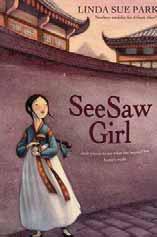
1.”This is a great book on many different levels. It conveys a clear sense of life in 17th century Korea without reading like a history textbook. Young children can easily follow it. The characters speak clear language and are placed in simple situations that show the social dilemmas and contradictions Korean women have faced over time. The book is bittersweet because you are left with the impression that while the main character's abilities and awareness were growing, her possibilities in life would be limited. She was truly maturing in the sense that she was aware of how small her universe had to be.” (Some additional comments: The reader will to learn about many aspects of life in traditional Korea, such as the influence of Confucianism on education, families, and gender roles. Readers may also become more sensitized to the ongoing limitations imposed on women in many varying cultures throughout the world.)
2.”Jade Blossom lives in a family compound in seventeenth century Korea. Her father isan adviser to the king. Jade and her cousin, Willow, live in the female section of the compound, separately from the men and boys, but the girls take every opportunity to play tricks on Jade's brother. She and Willow are like sisters, and then Willow is married and moves to her own compound, where Jade will probably not be able to see her again.”
“Jade's brother helps her to obtain paper and charcoal to try her hand at drawing. She longs to see the outside world, but the walls are too high to see over, and she is not allowed to roam outside the area. She really wants to see the mountains, so that she can draw them. One day, she hides in an empty outgoing market basket, and hops out in the marketplace, undetected. She sees many things, including girls her own age, and begins to realize that not everyone lives in a secluded compound…”
Seesaw Girl
developed by Mary Connor (Advisor, National Korean Studies Seminar)
138
1. Describe in depth a character, setting, or event in a story or drama, drawing on specific details in the text (e.g., a character’s thoughts, words, or actions).
2. Determine a theme of a story, drama, or poem from details in the text, including how characters in a story or drama respond to challenges or how the speaker in a poem reflects upon a topic; summarize the text.
3. Produce clear and coherent writing in which the development organization, and style are appropriate to task, purpose, and audience.
Describe how a source presents information. For example, how does the author include historical information within a short story or novel? Be able to provide several examples.
The teacher should read the author’s notes on pages 88-89 to the class. Show the location of Korea on the map and its close proximity to China and Japan. The teacher should mention that the book is fictional, but that it is historically accurate as to the way of life for the Korean people during the Joseon dynasty. It is also correct in reference to the Dutch sailors who were the first Europeans to come to Korea. One of the Dutchmen was Hendrik Hamel who later wrote a book about Korea and subsequently introduced Korea to the world.
If a student is reading the book independently of the class, she should read the author’s notes before reading the book.
Access www.korea.net and click on About Korea, especially Culture and the Arts for images of Korea. Korea Life will provide images of traditional Korean homes.
Background on Confucianism is essential for understanding the story. Read the lesson on Confucianism in the chapter on Religion and Philosophy.
Nothing has shaped Korean society as much as Confucianism. This philosophy was accepted so completely in Korea that it became the most Confucian of all nations in Asia. Confucius believed that education was essential to produce good leaders and to create a harmonious society. He also believed that social harmony is established when people play their social roles properly. People’s roles in society were codified in five great relationships that are explained below.
Introducing the five Confucian relationships will help students to understand Korean cultural values and the interaction of family members in Seesaw Girl. It will also help students to not only understand Korean students, but also many students with an Asian heritage. In Confucianism, human beings are not individuals but members of a group; however, all relationships are not equal. The level of a relationship may be determined by personal factors, such as age or status. Confucianism recognizes this inequality and actually lists relationships according to a hierarchy, beginning with the most important.
One: Ruler-subject. Above all, a ruler must act like a father, assuming responsibility and care for the subjects who are like his children. Thus, the father-son relationship is primary in that it is the model for most other relationships. Confucianism holds that order in society and harmonious relations begins within the family and then extends outward to town, the province and then to the country.
Two: Father-son. Family is the foundation of society with the relationship between father and son at its
139
core. The father must be responsible for the education and moral formation of the son and the son must be respectful and obedient and must care for the father in his old age.
Three: Elder brother-younger brother.An elder brother must assume responsibility for raising the younger siblings, and the youngest siblings must obey. The older brother has a unique and important status in the family.
Four: Husband-wife. Each person in this relationship is responsible for the other’s care. In Confucian thought, the relationship is hierarchical. The husband is an authoritative protector, and the wife is a protected homemaker and mother. The mother is responsible for the success of her children in school.
Five: Friend to Friend. In Confucian culture, a friendship involves serious obligations, and a friendship made in youth is expected to last a lifetime. In friendship there is often a certain hierarchy: the friends may differ in age or rank or health or wealth or knowledge. The mentor relationship – which implies a differencein age between the two is common inConfucian cultures. This type of relationship might be, for example, between a teacher and a student, which in Confucian cultures entails serious mutual responsibilities.
1. What is the prank that Jade and Graceful Willow play on the boys? What happens when the boys try to write poetry?
2. How old is Jade? How old is Willow?
3. Who is Tiger Heart?
4. This chapter mentions various sections of the house and a garden. Google: traditional Korean houses to get a sense of the Han house, the home of Jade and her family.
5. The chapter also mentions that the boys were to write poetry for the schoolmaster. What do the girls and women do?
1. What do you learn about the class structure during the Joseon dynasty, the time that Jade and her family lived in Seoul?
2. What does the reading tell you about the expectation for girls?
3. Was Jade’s mother understanding of Jade’s mischievous behavior?
4. If girls laughed, what was considered the polite thing to do?
5. What was Jade’s new idea for a prank?
6. Who lived in Jade’s home in Seoul?
7. Why was her father so respected?
8. What were the rules for upper class girls as they grew up?
9. What was Jade’s favorite possession? Who gave itto her?
1. Who arranged for Willow’s marriage? How old was she when she married?
2. What characters did Jade put on her gift to Willow? Why?
3. Briefly describe the ceremony.
4. What is said about geese (wedding ducks) and what they symbolized?
5. Why was Willow forbidden to eat or drink the day of the wedding?
6. Why did Jade want to cry?
(You can find a folk art image of Korean wedding ducks by accessing Google images of Korean wedding ducks. There is information in the Art chapter – The Lotus, Ducks and Fish that explains the symbolism in Korean folk art.
140
1. How did Jade’s life change after Willow’s marriage?
2. What did Jade mean when she thought that “the thread seemed to have no end”?
3. Jade’s role is clearly defined and limited. What is her brother able todo that she cannot do?
4. What is said about paying respects to one’s ancestors? This custom relates to the beliefs of Confucius.
1. Explain briefly how Jade is able to escape from her home and its surrounding walls?
1. What are jiggebs? p. 34
2. What is the reaction of the people in the market place to Jade? Why were they so curious about her?
1. What does Chang tell Jade about the prisoners (see pages 88-89 in the author’s notes)?
1. Why was Jade unsuccessful in seeing Willow as revealed in this chapter?
1. What do you learn about the role of the father and the role of the mother in Korean society?
2. What do you learn about why Willow refused to see Jade?
3. Jade and her mother have a chance to communicate about the role of women. How does Jade’s mother feel about her role as wife and mother? Do you think her mother felt fulfilled about her role in life?
1. What was the custom related to conversation at meals?
2. Jade learns that the prisoners might be killed, but what were the reasons that they were not killed?
3. What does Jade learn from her brother about the life of most people in Korea?
4. What happens to the servant who took Jade tomarket and why?
1. What was revealed about a child’s relationship to one’s father and mother?
2. The Five Virtues of Confucius are mentioned on page 61. What are these virtues?
3. What does Jade ask her father to do in terms of servant Cho? Does her father agree not to punish the servant?
1. Why did Jade’s father defend the prisoners when most wanted them to be executed?
2. The prisoners had spoken about ten laws from a written book that they carried with them. What was the book and what were the laws? p. 65
141
1. Why Jade was suddenly allowed to start her first panel? What would the panel be used for in the future?
2. Why does Jade want to create a panel with images of mountains when her mother advises her otherwise?
1. How does Tiger Heart spend his time and why? p. 72. Do you get a sense that it was important forboys to study hard and excel in their school work?
2. How were homes heated? An ondol in Korean traditional architecture in an underground heating system.
3. Who was Tangun?
4. Tiger helps Jade develop a new skill. Explain.
1. Were women allowed to paint?
2. What do you learn about the celebration of the New Year?
3. What game is mentioned?
1. How does Jade find a way to see outside the walls?
2. What does the following mean and how does it relate to what Jade’s mother had told her about finding satisfaction as a woman in traditional Korean society? “It’s not enough, she thought. But I will learn to make it enough.” p. 87
Discuss the Five Great Relationships and provide examples for each of the relationships by discussing some of the characters and events in the Seesaw Girl.
Students will have an understanding of traditional Korean culture and Confucianism. They will have a better understanding of students of Asian heritage, such as the importance of studying hard and being successful in school. They will have given thought to what roles fathers and mothers should have in raising children.
142
A Bully in the Classroom?
Teaching Our Twisted Hero: A Modern Korean Classic
Our Twisted Hero by Yi Munyol
HYPRION, 2001
ENGLISHTRANSLATIONBY KEVIN O’ROURKE
128 PAGES, ISBN: 978-0786866700, HARDBACK
By Constance Vidor with Michelle Schullo, Richard Sandler, and Sarah Campbell
Our Twisted Hero is a novel as dichotomous and complex as Korea itself. It is a classic political allegory, a snapshot of a particular time and place, and a portrait of the human condition. The narrator, Han Pyongt’ae, a twelve-year-old boy whose family has been transferred from Seoul to a rural town, expects to be welcomed as being more sophisticated because of his schooling in the capital. On the contrary, he encounters a harrowing year of elementary school when his spirit is crushed by the class bully, Om Sokdae.Pyongt’aerecalls how the teacher’s connivance, the other students’ conformist support for Sokdae, and Pyongt’ae’s parents’ indifference inexorably force Pyongt’ae to submit to Sokdae’s domination. Sokdae uses force and charm to manipulate his victims in his role as class monitor.Pyongt’ae’s initial resistance gives way after he is singled out for punishments and socially ostracized for months on end.The school year concludes with the students cheating to enable Sokdae to claim top academic honors.
Han Pyongt’ae is appalled at the others’ unwillingness to depose the bully, and tries to take it upon himself to rectify the situation. His attempts to inform on Sokdae only make Pyongt’ae even more ostracized by his schoolmates. Desperate for inclusion, the would-be reformer becomes the corrupt monitor’s right hand man.
When a new teacher takes over the class in the following school year, he becomes suspicious of the conformist, passive mood of the class. He begins to see the corruption crippling the class and forces Sokdae and the other students to confess to the cheating and bullying by beating them.He tries to impress on them that admitting the truth of their oppression is the only way to resist acquiescing to injustice in their later lives.
Pyongt’ae’s initial relief at the possibility of freedom from Sokdae’s domination changes to repugnance and disillusion as he witnesses Sokdae’s humiliation and the other students’ sudden abandonment of their hero.“They seemed to me no more than traitors who had waited for Sokdae to fall before jumping on him and walking all over him.”
The bully’s downfall is neither simple nor complete. The students struggle with creating a more democratic system in their classroom, and Sokdae exacts revenge by savagely attacking his former classmates on their way home from school.Violence is again shown as the effective solution as the teacher encourages and even manipulates some students into ganging up and beating Sokdae.Pyongt’ae contrasts the chaotic nature of democratic systems with the “convenience and efficiency” of Sokdae’s rule.
Sokdae casts a long shadow over Pyongt’ae’s life, as reflections on his former tormentor and his own complicity in Sokdae’s rule haunt his thoughts into adulthood. Pyongt’ae imagines Sokdae has gone on to a life of power and privilege, an image that is shattered when he sees the former bully being arrested and dragged through the streets in chains.
Pyongt’ae’s reaction encapsulates the novel’s tone of compassionate irony:“he had none of the tragic beauty of a fallen hero nor anything else special about him; he was just one among the poor ineffectual lot of us.”
As political allegory, Our Twisted Hero outlines the dynamics of fear and control that are familiar throughout history. Set in Korea during the 1960s, the book specifically references the April 19 Student Revolution of 1960, during which police killed 142 students who were protesting the fraudulent presidential election of Syngman Rhee. Rhee, himself a kind of “twisted hero,”achieved early fame as a great patriot for Korea’s independence, butevolved quickly into a dictator who used torture and murder to stifle opposition.
Our Twisted Hero is a story that begins with good versus evil and progresses into increasingly morally ambiguous territory.What degree of responsibility do the students have who supported Sokdae? When even Pyongt’ae eventually submits, isn’t it clear that resistance is useless?What are we to think of the author’s presentation of violence as the only effective solution to tyranny?Has the class merely exchanged one bully for a somewhat more enlightened bully in the form of the teacher?Is this a novel of hopelessness?Or is this
Traditi onal and Cont empor ary Kore an Popular Cultur e
143
For all its significant political overtones, Our Twisted Hero is the personal story of an individual child struggling with the all-too-common dynamics of bullying and conformism that will immediately engage high school and college readers.
Traditional and Cont empor ar y Korean Popular Cul ture
actually a novel that expresses hope by its demand for readers to boldly examine the intricacies of moral responsibility, the implications of personal decisions, and the dynamics of how societies rule themselves?
For all its significant political overtones, Our Twisted Hero is the personal story of an individual child struggling with the all-toocommon dynamics of bullying and conformism that will immediately engage high school and college readers.The literature of bullying is vast, and the problem of school bullying has become a topic of national concern, with books, consultants, and programs on anti-bullying appearing prominently on the landscape of education in the United States. (On January 23, 2010, a Google search for “anti-bullying in education” turned up 1,780,000 hits.) Many readers will also see thematic relationships with books such as Robert Cormier’s The Chocolate War (1974) and William Golding’s Lord of the Flies (1954). The Chocolate War pits the defiant protagonist against the sadistic bully in a Catholic boy’s boarding school, combining issues of class, sexuality, and specific Christian imagery in an exploration of bullying with a pessimistic conclusion. The Lord of the Flies places a group of British school boys on a remote tropical island where they descend into savagery.Each of these books evokes its own nexus of cultural and historical resonance, and each evokes different subsidiary themes and images to complicate the examination of power, injustice, and conformity.
It is striking that of these three most eminent books that portray children enacting the social drama of tyranny and injustice, only Our Twisted Hero concludes with a degree of optimism.Democracy succeeds the tyrannical reign of Sokdae, with the class holding elections, discussing their issues, and grappling with all the push-and-pull of equitable decision-making. It is a problematic type of democracy, having been achieved through violence and humiliation, and with the aid of a superior intervening force; but it is a scenario in which there is at least the possibility of openly querying this fault line and its implications.A further element of optimism in the conclusion is that Sokdae’s former victim grows up, finds a profession, has a family, and although disillusioned, retains his ability to be compassionate, and to query the assumptions of his social peers.
The spare writing of Our Twisted Hero concentrates the story within dialogue and action.A few telling metaphors and references to Korean culture will speak more eloquently to American readers with some context provided.For example, the father’s lack of support for his son suggests an abandonment of Confucian family values, as does the first teacher’s craven acquiescence to Sokdae’s exploitation of his classmates.Further, the immediate withdrawal of loyalty from Sokdae after he is beaten and humiliated by the new teacher assumes additional significance when seen in the context of the supreme value placed on loyalty in Korean society.
This short, powerful novella will provoke lively discussion, argument, and reflection on literary, political, personal, and universal issues in courses on world literature, Asian literature, or Asian studies.
The teachers who contributed to this article offer the following ideas for guiding discussion and reflection.
M I CH ELLE S CH ULLO teachesEnglish at Newbury High School in Newbury, Ohio. She sees the novel’s multiple levels as having special utility in inclusion classrooms. Regardless of reading level, students easily recognize the characters: the bully,the unsympathetic parents,the indifferent teacher,the boy who tries standing up to the bully,the teacher who means well but nevertheless must coerce students into doing the right thing. An important goal in her teaching is to provide differentiated instruction in order to help slower readers keep up with the class and to encourage faster readers to conduct extension research into the novel as an allegory. All students closely examine character and deal with moral ambiguity.
Michelle Schullo’s complete unit on Our Twisted Hero is available at Teaching East Asian Literature in the High School at the Indiana University East Asian Studies Center, http://www.iu.edu/~easc/outreach/educators/literature/workshops/index.shtml.
Anticipation Guide: Our Twisted Hero by Yi Munyol
INSTRUCTIONS
1. Before viewing and reading the novel, place a check mark in the space to the left of each of the statements with which you agree. Students should be able to assign a value to one position and support the position with evidence from the text.
2. Then, during or after the reading, cross through those you wish to change, and check any new ones you find to be true.
3. Include evidence from the text that promotes your position. Include page numbers!
Answers and textual support will vary student to student, promoting discussion.
____1. Teachers and adults are here to help you. (Students should be able to evaluate the roles the teachers and parents play in the novel.)
____2. Power corrupts. (Students should be able to analyze the effect power has on Om Sokdae and his inner circle.)
____3. Sometimes personal freedoms need to be sacrificed in order to maintain control of the larger group. (Students should be able to assign a value to one position and support the position with evidence from the text.)
____4. Ultimately, justice will triumph over injustice.(Students should be able to evaluate whether Om Sokdae’s downfall, as a child and as an adult, is justice. Some students will consider the unevenly meted justice delivered by their sixth grade teacher and by life.)
____5. Students should always report violations like cheating or stealing to the school administration. (Students should be able to compare and contrast the methods and relative effectiveness of each teacher.)
RICHARD SANDLER is an English Teacher at John Burroughs School in St. Louis, Missouri.His major goals in teaching the novel are to convey to the students the universal nature of how one learns to cope
144
This short, powerful novella will provoke lively discussion, argument, and reflection on literary, political, personal, and universal issues . . .
with challenges at a very early age, and how challenges can shape one’s perspective as an adult. He asks students to examine how culture guides one’s expectations and reactions, and how a very carefully crafted piece of writing can use a personal experience as a means to reveal an insightful perspective on significant political and historical experiences.
DISCUSSION QUESTIONS
PAGES 90 TO THE END
1. Did your reaction to the severity of the beating surprise you? Did you feel he deserved it?
2. Explain the teacher’s line “You weren’t even angry. You bent to unjust power and weren’t even ashamed.” (page 95) Discuss personal experiences or historical events that fit this experience.
PAGES 1–29
1. What does the first paragraph do to set up the tone and voice in the piece? The time frame suggests that the event which occurred in childhood is essential to Pyongt’ae’s adult life. How does his tone and voice influence your reaction to his focus?
2. How does Pyongt’ae set up the contrast between urban and rural values? Can you see any modern American parallels?
3. What does the first scene with Sokdae tell us about Pyongt’ae’s expectations and fears in a new school? Does it ring true to your experiences with a social order?
4. Describe the teacher’s acceptance of the pecking order. What does it suggest about the link between children and adults and power?
5. Explain Pyongt’ae’s father’s reaction to Sokdae. Do you see a link between the teacher and Pyongt’ae’s father?
6. Explain how Pyongt’ae looks to academics as a way to gain some recognition. How to does it reinforce Korean values?
PAGES30–61
1. How does Yun Pyongjo’s dilemma display Sokdae’s ability to “work” the situation? Does it ring true to your experiences as a kid with a bully?
2. Contrast Yun Pyongjo’s father’s job/role with Pyongt’ae’s father. What do they share and how are they different? Whose plight would you prefer?
3. Explain the public performance of the teacher. Does it suggest he wants the opposite effect and is looking to reassure Sodae’s power?
4. How does Pyongt’ae misgauge the anonymous writing exercise? What does it suggest about Sokdae’s power?
5. What does the physical fighting order suggest about the nature of male social order?
6.How does the shunning finally bring about “the break” and Pyongt’ae’ssubmission?
PAGES62–90
1. Does the image of the window cleaning serve as any sort of significant metaphor?
2. Explain the line, “And now that Sokadae was certain I had submitted to his rule, his favors fell like a waterfall.” (page70)
3. How does Pyongt’ae ‘s contribution of art to Sokdae’s portfolio of work serve as a metaphor?
4. What can one read into all the students giving up their point as part of a rough social contract?
5. How does the invitation to visit the factory destroyed by the Japanese air raid foreshadow Sokdae’s fate?
6. How does Sokdae’s “First in School” title seem more important than getting caught?
3. Explain the line “A butcher they say, can become a buddha if he lays down his knife.” (page 100) Why does Pyongt’ae grow suspicious of the speed/degree of change?
4. What does the difficulty of the class election suggest?
5. How does the April 19 Revolution serve as a perfect metaphor for the classroom dilemma?
6. Explain the reemergence of Sokdae and his new role.
C
ULMINATING WRITING ASSIGNMENT
Select one character and write two dramatic monologues revealing the conscience of that person.
FIRST MONOLOGUE: Writing in first person, justify all your character’s actions, thoughts, inactions, and feelings. It is essential thatyou employ specific lines or dialogue and actions from the text. For example, “When I said, ‘Will it take a beating to get you totalk? little did I think. . .” (page 93).
SECOND MONOLOGUE: Writing in the voice of the same character, create a statement that expresses the doubts, regrets,and afterthoughtsabout the issues discussed in the first monologue.
Character choices:
Han Pyongt’ae
Om Sokdae
The first teacher
Han Pyongt’ae’s father
Han Pyongt’ae’s mother
Yun Pyongjo
The second teacher
SARAH CAMPBELL is an English teacher at Ketchikan High School in Ketchikan, Alaska. She teaches Our Twisted Hero in her Asian Literature class. Her primary objective is for students to make connections between the historical record and Yi Munyol’s response to it in his political allegory Examining the novella in terms of historical events gives this dramatic time a personality, and students can better relate to the Korean experience as a result.A junior in Ms. Campbell’s class reported that after reading Our Twisted Hero with the historical events in mind, he was able to “see what the students were doing, understand what they were thinking and feeling,” and went on to add that he had “never been able to do that with a piece of American literature.”Analyzing Our Twisted Hero with historical texts is a relevant and powerful way to teach Korean history.
Ms. Campbell shares excerpts of historical documents with her students that flesh out the impact of Syngman Rhee’s dictatorship. She guides her students to make connections between the historical record and Yi Munyol’s response to it in Our Twisted Hero
Traditi onal and Cont empor ary Kore an Popular Cultur e
145
Traditional and Cont empor ar y Korean Popular Cul ture
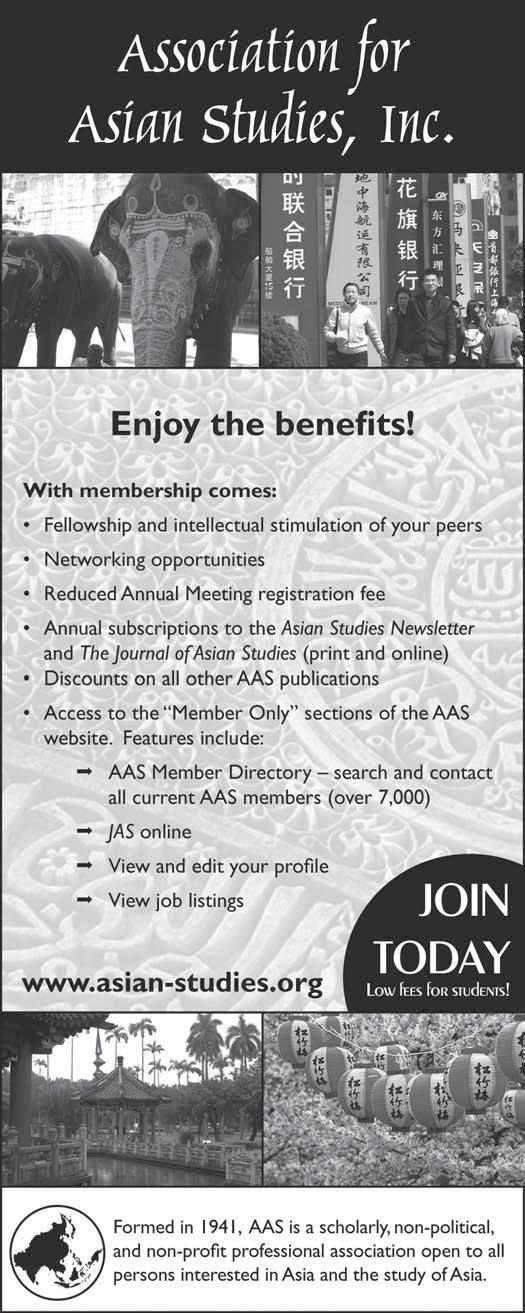
Gregg Brazinsky, Nation Building in South Korea: Koreans, Americans, and the Making of a Democracy (University of North Carolina Press, 2007). Brazinksy examines America’s role in rebuilding South Korea after the Korean War.Chapter Five focuses on Rhee’s development of an autocratic regime and suggests how Americans supported the emergence of a developmental autocracy because it was economically viable to do so.
Many students believe Om Sokdae represents Syngman Rhee, and the fifthgrade teacher in Our Twisted Hero symbolizes the United States.A textual rendering of this section allows students to draw parallels and better understand America’s decision to look the other way by allowing Rhee to ruthlessly govern for over a decade.
Lee Gil-sang, ed., Korea Through the Ages(Vol 2 Modern) (The Academy of Korea Studies, 2005). Chapter Seventeen discusses Korean life under the autocracy of the Rhee administration and details the April 19 Democratic Revolution that resulted in Rhee’s resignation.This text uses easy-to-understand language and presents facts, pictures, maps, and primary sources for readers unfamiliar with Korean history.
The first section of Chapter Seventeen begins with the primary account: “I can’t live like this; let’s change the president! Oh forget it, what’s the use?”Students relate the sense of hopelessness in this passage to Pyongt’ae’s submission to Sokdae. Through additional textual rendering, students find parallels between Rhee and Sokdae’s nefarious methods of rule and dramatic decline.
Mary E. Connor, ed., Asia in Focus: The Koreas (California: ABC-CLIO, 2009). This is a comprehensive historical and contemporary text. Connor includes several detailed sections on Syngman Rhee. These sections can easily be juxtaposed with Yi Munyol’s novella, giving students the opportunity to decipher meaning from the political allegory.
Andrea Matles Savada and William Shaw, eds., South Korea: A Country Study (Washington: Library of Congress, 1990, 2009), http://memory.loc.gov/frd/cs/krtoc.html. This Web site contains online versions of books published by the Library of Congress.Savada and Shaw’s text is especially helpful, as it highlights the historical setting as well as the social, economic, and political aspects of South Korea. “The Syngman Rhee Era, 1946–1960” section examines society and the economy under Rhee.Students will learn of the methods Rhee used to gain and maintain power. ■
CONSTANCE VIDOR is Director of Library Services at Friends Seminary, an independent K-12 school in New York City. She also teaches courses in children’s and young adult literature in the Youth, Literature, and Technology graduate program at Rutgers University.Her online publications relating to Korean children’s literature include the Voicethread on Linda Sue Park’s A Single Shard, http://voicethread.com/share/584594/, the Voicethread on Linda Sue Park’s The Kite Fighters, http://voicethread.com/ share/584594/, and “The Fascinating World of Linda Sue Park,” International Journal of Multicultural Education (December, 2009), http://ijme-journal.org/index.php/ijme.
146
“In this classic tale, Richard Kim paints seven vivid scenes from a boyhood and early adolescence in Korea at the height of the Japanese occupation, 1932 to 1945. Taking its title from the grim fact that the occupiers forced the Koreans to renounce their own names and adopt Japanese names instead, the book follows one Korean family through the Japanese occupation to the surrender of the Japanese empire. Lost Names isat once aloving memory of family and a vivid portrayal of life in a time of anguish.” (Amazon.com)
“Lost Names isauseful, rare and wonderful book for several reasons. The book’s title reflects the Japanese Pacific Warpolicy of forcing Koreans to replace their own names with Japanese ones. Lost Names is the story, as recounted by ayoung boy, of one Korean family’s experience during the war years. Although Lost Names is technically anovel, according to author Richard Kim, ‘…all the characters and events described in the book are real, but everything else is fiction.’ Never in my time in Asian Studies has one work been so applicable to such awide range of students asis the case with Lost Names.” Lucien
Ellington, Editor of Education About Asia
When Richard Kim was asked how he would teach Lost Names, he said that “I would stress that they shouldn’t read the book as issue oriented, as anti-Japanese or anti-colonial. I would ask that they (teachers and students) observe and understand how afamily, both in private and in times of war, copes with war and one another.” (Education About Asia, Fall issue, 1999)
(e) Investigate, interpret, and analyze multiple historical and contemporary viewpoints within and across cultures related to important events, recurring dilemmas, and persistent issues, while employing empathy, skepticism, and critical judgment.
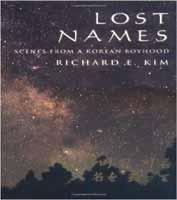
147
Lost Names
“It is February, the gloomiest and the cruelest time of the interminable winter in our northern region. The sun seldom ventures out in the dark heaven, as if it, too, finds repugnant the dreary sky…And it snows and snows and snows – not the silvery, glittering, fluffy flakes that descend from a clear sky….but the wet, heavy, dull things that pelt down from asoiled sky….
Most of myclassmates don’t ever have white rice in their lunch boxes and some of them always want to taste itand ifI don’t let them they make fun of me, like saying just because I am a rich boy and so on, and I’ve hadmy lunch box stolen, I mean someone ate my lunch while I was out of the room, and that happened three, four times already…
Our rice farmers are forced by law to sell their rice to the government at a cut-rate price; rice is then shipped to Japan (which the Japanese want us to call the “mainland”), leaving very little rice in Korea.
Wearing gloves is forbidden at the school; keeping our hands in ourpants pockets is forbidden, too; wehave the pants pockets and jacket pockets all sewn up – the school regulation – keeping yourhands in pockets harms yourposture and weakens your constitution, resulting in your becoming weak men, unfit to serve the Imperial Cause…
Weare required to bring two logs or asack of pine cones for the stove in our classroom. Inthe fall and before the snow starts, weoften, instead of doing schoolwork, are sent up to the hills and mountains to collect pine cones, which are then stored in our classroom for the long winter. Coal is scarce…
“Today,” he says without looking atus, holding up the piece of paper in front of him, “I must have your new names. I have the new names ofmost ofyou in this class, but the principal tells methat some ofyou have not yet registered your names.”….My name is called.
My father takes out apiece of paper from his vest pocket. He hands itto the Inspector. “Iassume,” he says, “this is what you want, Inspector. I hope you will be pleased.” The inspector looks at the paper. “Yes, yes, he says. “Iwamoto….Ah– itisavery fine name, sir…” We (my father and I)then step into the cold. The snow is turning into a blizzard…. Afraid, bewildered, and cold, I look up at his face and see tears in his eyes….”What does our new name mean, sir?” I askmy father when weare down the hill and on the main street. “Foundation of Rock,” he says, shielding my face from the bitter-cold snow with his hand.”…on this rock I will build my church….” I do not understand him. “It is from the Bible,” he says.
As soon as each class submits tothe principal acomplete list of all the new names, the class is sent out of the school togo to the Japanese shrine to pay its respects tothe gods of the Empire and make its report to the Emperor – to announce that we now have Japanese names.
Then, the teacher gestures abruptly, asif to touch my face. “I am sorry,” he says. My father gives him aslight bow of his head. “Even the British wouldn’t have thought ofdoing this sort of primitive thing in India,” says the Japanese (teacher) …inflicting on you this humiliation…” he is saying.
“…unthinkable for one Asian people to another Asian people, especially weAsians who should have a
148
greater respect for our ancestors..."”
He (my father) gives meahug. “I am ashamed to look in your eyes,” he says – another one of those mysterious things he likes tosay. “Someday, yourgeneration will have to forgive us.” Idon’t know what heis talking about, butthe scene and the atmosphere of the moment, in the roaring wind and with the snow gone berserk, make me feel dramatic. “We will forgive you, Father,” say I, magnanimously.
About four miles out of town, between our house and the orchard, the cemetery lies at the foot ofa hill that gradually rises up to become acraggy, rock-strewn, barren mountain….Twenty or thirty people are moving about the burying ground….All are shrouded with white snow; now, some are kneeling before graves; some, brushing the snow of gravestones; some, wandering about like lost souls….When we are in front of the graves of our ancestors, my father wipes the snow off the gravestone…. The three of usare on our knees, and, after a long moment of silence, my grandfather, his voice weak and choking with asob, says, “We are a disgrace to our family. We bring disgrace and humiliation to yourname. How can you forgive us?” He and my father bow, lowering their faces, their tears flowing now unchecked, their foreheads and snow-covered hair touching the snow, and I shiver for a moment with the needling iciness of the snow on my forehead. And I,too, am weeping….”
How long – for how many generations – are yougoing to say to each other, “I amashamed to look in your eyes”? Isthat going to be the only legacywecan hand down to the next generation and the next and the next?
Itis dark…the snow is falling straight and calmly. The blurry figures of the people move about the burying ground like ghosts haunting the graves in the snow. At the bottom of the hill, my father asks, “Would you like me to carry you on my back?” I nod unabashedly and climb onto his back, nuzzling my frozen face against him, clinging to his broad shoulders. And so, in such a way then, the three of us, the three generations ofmy family, bid farewell to our ancestors in their graves, which we can no longer see in the heavy snow, and join the others from the town to find our way back to our home. Today, I lost my name. Today, weall lost our names. February 11, 1940.
149
EAA Interview with Richard Kim
History As Literature, Literature As History
Lost Names: Scenes From a Korean Boyhood
By Richard E. Kim (Berkeley, California: University of California Press, 1998).
196 pages Lost Names is a useful, rare, and wonderful book for several reasons. The book’s title reflects the Japanese Pacific War policy of forcing Koreans to replace their own names with Japanese ones. Lost Names is the story, as recounted by a young boy, of one Korean family’s experience during the war years. Although Lost Names is technically a novel, according to author Richard Kim, “ . . . all the characters and events described in the book are real, but everything else is fiction.” Never in my time in Asian Studies has one work been so applicable to such a wide range of students as is the case with Lost Names.
In the pages that follow, we feature an interview by EAA editorial board member Kathy Masalski with Richard E. Kim and essays by a junior high, senior high school, and university instructor on how they have used Lost Names as a highly effective teaching tool. We sincerely hope this special feature encourages teachers at all levels to read Lost Names and consider using it with students.
 Lucien Ellington
Lucien Ellington
Kathleen Woods Masalski — I first met Richard Kim in 1994 when I asked him to speak at a National Endowment for the Humanities summer institute on the War in the Pacific. The audience responded so well that I invited him to speak at several other summer institutes sponsored by the Five College Center for East Asian Studies. After reading Peter Wright’s, Susan Mastro’s, and Dick Minear’s essays about their teaching of Lost Names, I asked Lucien if he would be interested in an interview with Kim. Lucien had read the book and read the essays (Kim did not ask to see them before publication), and urged me to proceed. Kim agreed to get together with me on May 18 in Amherst, Massachusetts.
I presented him with a list of questions that I had prepared. The interview lasted three hours; I took copious notes and wrote them up immediately afterward. Although I suggested that he edit the final interview, Kim declined. What follows are selected passages from our discussion that afternoon.
I should note that I approach Lost Names as history, and my questions reflect my background as a history teacher. An English teacher would have asked different questions. Lost Names is first and foremost creative writing. Social studies teachers may well wish to introduce the book to their colleagues in the English or Language Arts departments.
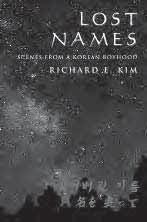
MASALSKI: One question the audience always has about Lost Names is whether it is fiction or nonfiction. Do you really intend to tell readers that nothing in Lost Names is “factual” or “historical”? How much of what is in it actually happened? How much actually happened to you?
KIM: Everything in the book actually happened. It happened to me. So why am I always insisting it’s not autobiographical? I think because of the way I used the things that actually hap-
pened. You have to arrange them, mix them up. Above all, it’s interpretation of facts, of actual events—some thirty or forty years later. For example, when “the boy” gets beaten, what went through his mind? We don’t know. . . . even I don’t know. I like to separate the actual events from the emotional, the psychological. One shouldn’t confuse the actual events with the inner events. That’s where a lot of beginning writers make a big
mistake. A lot think everything is exactly as it happened; but we put our own interpretation on events. I didn’t invent any actual events. . . . but everything else is fiction. That is very important to me.
MASALSKI: When you wrote the book in 1970, how did you go about gathering evidence? Or didn’t you?
KIM: I didn’t have to gather much. I made a chronology of actual political events and a chronology of events in
150
EAA Interview with Richard Kim — Continued
my life. Then I rearranged . . . I had to rearrange the events in my life. I think that the private events happened at the time [I described them] . . . but maybe not. The big world events happened . . . [the question was] how to bring them together . . . .
The original plan for this book was different from what it turned out to be. Praeger planned a series of books on different countries, Japan, China, India, Korea, etc. to introduce these countries to American children. I decided to introduce Korea through family life. As soon as I started writing, the book took on a different life. I called my editor and said, “I can’t do it the way it was planned.” She said, “What is your idea for the book?” and I said I didn’t know. She said, “Let it loose, let it go.” I had already listed many details, for example, what we typically ate for breakfast, because I was using that information to introduce what Koreans eat. When I finished writing (it took me only three months), we took a look at the manuscript. It was not what the editors had in mind, but they liked it. They took the work out of the country series and decided to publish it separately. But, they wondered, how should they treat it? They sent the manuscript to Pearl Buck, and she praised it as a novel. But Praeger didn’t want a novel. So they convinced her to call it something else. [She called it “the best piece of creative writing I have read about Korea.”] So Praeger decided to just get it out . . . to let others decide. And the reviews were good. [Edward] Seidensticker reviewed it for the New York Times and Praeger breathed a sigh of relief.
MASALSKI: You were a boy of thirteen or fourteen when the book—and the war— ended. What do you remember of your feelings then? Now, fifty-plus years later, how have your feelings changed?
KIM : I don’t feel differently about things today. I feel the same as when they happened. My father was in a detention camp, so I didn’t jump up and down for joy. Rather, I felt that
finally it’s happened. Something that should have happened happened.
I didn’t have feelings of hatred for the Japanese. My feelings were more of contempt. I despised, had contempt for [them]. . . . In a perverse sort of way, I had a feeling of superiority. It was a defense mechanism to think, “Forgive them, Lord, for they know not what they do.” This may be a cultural, a class thing. I felt the Japanese were not to be trusted or respected. It might have been different in Seoul, but not in my small town. The Japanese we dealt with were not very good. After all, who would go to a dinky town, a dinky province, if they had a choice?
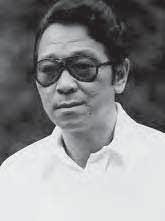
I [didn’t] think of the Korean characters as saintly, but as ordinary. In those days there was no room for cynicism. Everything seemed clear cut. We knew where we were and where we stood. Today is different; I don’t know where I stand. I don’t know what to think. . . . in those days I knew. Them and us. Cynicism comes from selfdoubt. There was no room for that sort of thing.
When the Japanese priest and his wife [who lived nearby] came [when the end of the war was announced] and begged that we protect them, my grandfather didn’t know what to do. . . . I didn’t know what to do. . . . We went
back to the source of authority. . . . do what your father would have done. The tenant farmer, too, kept telling me that my father would have protected them. . . .
Actually, my father was a saint. I wrote an inscription on his gravestone, “He was a good man and just.” He was like that—truly. I never heard him say anything bad about anyone. I never saw him enraged. I’m not like him. . . . He had a great capacity for suppressing his feelings; he was patient.
If I had been exposed to constant hatred at home, maybe I would have felt differently about Japan and the Japanese. But I wasn’t. Grandfather never said much. And I never heard my father say nasty things verbally. We thought, they’re bad ones. . . . so why should we waste our time talking about them. . . .
MASALSKI: What difference to Lost Names does it make that you and your family were well-to-do and Christian?
KIM:This is a very important question. We were upper-middle class, the town’s elite. The Japanese who were there were not. We saw them as men who couldn’t get jobs in Tokyo. “Why are they here?” we asked ourselves. As colonizers, they were supposed to be better than the colonized, but a lot of Japanese were simply not that great. It’s a cultural, a class thing. I didn’t hate them. They were like dangerous dogs to be avoided.
Although we were not that wealthy, we were reasonably well-to-do. In those days we were made to look upper class because we went to college. The Christian thing is tricky. I’ve been thinking about it. Some really well-todo Koreans, especially in the South— even among my generation—sometimes the Japanese treated them like upper class, with kid gloves. Made them feel better, like the aristocracy, the ruling class, the landlord class. Made them feel as if they were treated with respect. To this day I know people with backgrounds like this who are without anti-Japanese feelings.
The lower classes—what did they
151
Richard Kim
care if they were governed by the Japanese or a Korean dynasty? They were treated the same. My grandfather told me that one time, when he witnessed royalty passing by, he saw someone miserably beaten because he didn’t bow low enough. And he (my grandfather) felt that when the dynasty perished, well, it served the royalty right.
I don’t know how much of a sense of nationalism existed at the time of Japanese annexation. As long as the upper classes kept their money and status, and as long as the Japanese left them alone, what difference did it make? And what difference did it make to the peasants—both Korean royalty and the Japanese took eighty percent of their crops, regardless. If the Japanese had been victorious, if the war had lasted another four or five years, maybe most Koreans would have become “Japanized.”
I think it was the middle class, the upper-middle class who were affected most by the war. That group produced more educated people, those with expanded consciousness.
To the Japanese, the Christians were the ones with the most connections with the West—simply because they were Christians. They were therefore characterized as outsiders, as dangerous. They were an important minority because they were uppermiddle class. They sent their sons to schools and colleges. So as a group they were more conscious of national identity. I don’t think the upper or lower classes thought about nationalism or independence, but I really don’t know. The early uprisings were not organized by the upper classes. In those days [during the war], memories were fresh. Twenty–thirty years later, I don’t know. . . .
Belonging to that class and being Christian made all the difference. We were more aware of where we belonged. I grew up thinking we were a little different. Lost Names would be a different book if it were written by someone else at the same time but in a
different class and in a different place. The book is not representative of “the Korean experience.” I was a marked boy. Somehow the village had voted me most likely to succeed, because I was my father’s son. My grandfather, the minister, was one of the best-known leaders of the Christian community. Most Christians knew my grandfather’s name. The first day back in a Korean school, things were very tense for me. My parents wondered, how would he (I) be received—both by the Japanese and the town’s kids. I always had to be conscious of what I was. The key was “do not disgrace the family.”
MASALSKI: In your opinion, has the Japanese government apologized to the Korean people for its treatment of them during the occupation period?
KIM: I’m not so sure they’ve apologized. Regret, maybe. But that’s beside the point. I don’t really care if any government apologizes. It’s probably a political thing, anyway. It seems to me that Asians are less capable than Europeans of accepting collective responsibility for their actions. Maybe the Judeo-Christian culture has more possibilities for atonement and redemption. Not so true for Asians. Why is it so difficult for Asians or Koreans to say we are all guilty? We tend to say, “I didn’t do it.”
MASALSKI: The title of the book is problematic—in all three languages. Why did you choose it? What was your intent?
KIM : I loved the word “lost” and all the things that it conjures up, especially in English. Paradise Lost Lost is almost damned. . . . almost sinful. Lost Souls (which was at one point my working title). I like “lost” because it has a lot to do with my sense of my generation. Kind of like I am now. I don’t belong. Born in Korea. Moved to Manchuria. Back to the north [Korea]. Then to South Korea. Didn’t belong either place. Then to the military, where I didn’t belong. To here. For awhile I thought about it, then I gave up thinking about it, for it’s not important. Especially my generation of Koreans happened to be between periods. . . . Japanese occupation . . . a little of that . . . then the country was divided. . . . then exodus . . . lost again. Led a refugee’s life . . . lost again . . . then ended up here in god-forsaken Shutesbury with a name like Richard. . . .
My college dean in this country thought that other students would have difficulty pronouncing my Korean name, so we looked at names in a telephone book. I chose Richard because I knew of Richard the Lion-Hearted. I finally had it legalized. I like to think it fits with my character . . . it’s how I think of myself. I’m lost, lost between two cultures, two worlds, neither North or South Korea, not Korean or American. I felt that way always, even as a little kid. I couldn’t even sing Korean songs. . . .
This has been one of my missions in life, to teach Koreans to accept responsibility for their lives, to stop blaming others, the Japanese, the Chinese. We lost it. . . . but many Koreans would like to think someone grabbed it. . . . thinking this justifies hatred. I’ve often said that Koreans need a national psychotherapy session, a large couch. Why are we as we are, why is self-examination such a rare commodity in Korean life?
152
If the Japanese had been victorious, if the war had lasted another four or five years, maybe most Koreans would have become “Japanized.”
EAA Interview with Richard Kim — Continued
Koreans are so good about blaming others . . . they know so little about what they have done. They lack a collective sense of guilt or action.
Koreans can’t say we were careless, we dropped our names, and someone else picked them up and took them away. What the Japanese did was terrible—perhaps more stupid than terrible. How can such smart people do such dumb things? Didn’t they see that what they did would cause more resentment?
MASALSKI: One of the most important scenes in the book takes place in a graveyard, where all your known ancestors are buried. You, your grandfather, and your father visit that burial ground after the Japanese have given you new names, Japanese names. Your grandfather says, “ We are a disgrace to our family. We bring disgrace and humiliation to your name. How can you forgive us? ” He and your father bow, their tears flowing (p. 111). . . . Will you explain that scene?
KIM: My father felt that his generation had failed. (Maybe that’s why there isn’t naked hatred of the Japanese.) The kind of man he was resulted in his asking, “What have we done? How could we have allowed this to happen?” I don’t think he blamed grandfather’s generation. My father had a perfect right to fly into a rage, but there was none of that. “The important thing,” my father said, “is now how can we deal with this? Someday your generation will forgive us.” Why otherwise would he have taken me to the graveyard where he and my grandfather asked their ancestors to forgive them? He was almost telling me that one day we would have to forgive his generation.
MASALSKI: Were you surprised by the book’s reception? By the way readers (then and now) interpret it? Is there a difference?
KIM: It has been a surprise. It’s especially a great honor to find it’s read in so many schools. I really feel good about that. I have no way of influencing how readers take it, however. One exception I take is to anyone who says
it’s anti-Japanese. It’s not; there are some bad Japanese characters in the book, but it is not anti-Japanese. I wrote it quickly—between books. I had some legal problems with my second book and decided to do something with the Praeger series. It started out as one thing and ended up another. So I was very surprised.
MASALSKI: When they finish reading Lost Names , how do you want readers to feel toward the characters and the countries represented?
KIM: When I wrote the book, I didn’t feel that I wanted the reader to feel this way or that. I really didn’t think about writing for a foreign audience. I never thought about any audience, in fact.
MASALSKI: What led to the rebirth of Lost Names ? How much did the 50th anniversary of World War II have to do with it?
KIM: I was willing to let it go, but the time came when Asian studies programs here and there realized that there’s not enough material around. The talk was taken up on the Internet, and there you are. I don’t think it had anything to do with the anniversary of the war.
MASALSKI: What do you think the book has become?
KIM: I don’t know. A textbook. I’ll tell you . . . when The Martyred came out, the New York Times reviewer said it
would last. . . . When I finished Lost Names, I didn’t think it was in the same class as The Martyred, but I said to my wife, Penny, this is an exquisite piece, a small jewel. Because that was how I felt. It was hard to find fault with the book. The technique, the language: granted that the author was biased, prejudiced . . . I felt it was nice, not grand, not big (The Martyred was), but nice. I felt good, really good about it.
I don’t know. . . . maybe it [the book] will last. If it does, it’s only because people will look at it [in a larger context?] . . . if it were only a picture of a family. . . . I don’t know, maybe there’s something more to it than a family and a family’s survival.
MASALSKI: If you were teaching in a college, high school, or junior high/middle school classroom today, how would you “teach” the book?
KIM : I would stress that they shouldn’t read this book as issueoriented, as anti-Japanese or anticolonial. I would ask that they [teachers and students] observe and understand how a family, both in private and in times of war, copes with war and with one another. I know you think the characters are almost too good to be true, but we really were good. We never fought. My parents never exchanged harsh words.
My grandparents were patient souls. It may have to do with the culture thing. . . . They had humble beginnings. . . . didn’t have the “more sinned against than sinning” attitude . . . they didn’t feel wronged; they were always grateful for what they had. I think I have that. I’m so grateful every time I go into a grocery store that I am able to pick from the shelves that which I want. . . .
My grandmother was tough. . . . grandfather was saintly. They didn’t talk that much. I’m different. I’m told that on the second day of Kindergarten I didn’t like school so I stopped going. I left the house every morning and hid. No one knew until the school came looking. I never went back. . . . I’m different. . . .
153
One exception I take is to anyone who says it’s (Lost Names) anti-Japanese. It’s not; there are some bad Japanese characters in the book, but it is not anti-Japanese.
MASALSKI: At every one of our summer institutes, teachers have brought up the incident in Lost Names that involves rubber balls. The chapter, “An Empire for Rubber Balls,” presents such an engaging, dramatic scene. When the Japanese Empire was at its height, the Japanese distributed rubber balls to all children. But after the tide turned for Japan, they wanted them back. As class leader, the boy was responsible for collecting the balls. He pricked them in order to fit them into a container, and the teacher beat him severely. What is the message here, the lesson?
KIM: The Japanese really wanted the balls back. And here is the irony of the situation. My grandmother, in her peasant wisdom, came up with the idea of pricking holes in them. I think the Japanese assumed that the boy’s father had influenced him. It was not so . . . the incident happened. . . . I was beaten pretty badly. . . . I don’t remember all the details . . . for example, there was a Korean policeman, but I don’t think he intervened. . . . this is where the fiction comes in. . . . I brought him into the story.
That’s the fun part of a book like this. . . . taking fact and fiction and mixing them together. I don’t know what my mother said in certain situations, but I’d make what she said sound good in certain situations. The momentum creates the situation. . . . dialogue comes out . . . you can’t plan every dialogue. I would call my mother up (when I was writing the book) and say guess what you said today, and she would ask, “did I really say that?”
“There is no nobility in pain; there is only degradation” (p. 134). This was an unusual thing for me to say. It’s not Christian, but . . . the truth is, for most people a beating is a beating. I remember my father was held upside down from the ceiling, not by the Japanese, but by a Korean who was working for American intelligence. (This took place in South Korea after the family moved from the north to the south.) He was picked up in 1946,
‘47, ‘48. . . . a Korean detective working for the Americans brought him in, saying he was a communist spy sent by the north Koreans. They held him upside down and pulled all his hair out. (In the Japanese prison earlier, the Japanese shaved his head every day. . . . he said that was so painful. . . .) The Americans held him until something happened that proved he was not a spy. When I arrived in the south, I found him and spoke with a Korean American in intelligence. When my father was released, I shouted, “Someday I’ll kill all you Americans.” This was so difficult for me. . . . the Americans had come as our liberators. . . .
MASALSKI: Which incident/passage in the book lends itself to teaching, or presents an “ideal” teaching situation?
KIM: I don’t know about teaching it, but my favorite scene in the book is in “Once upon a Time, on a Sunday.” . . . They come home, finally, and the boy is outside the cottage with paper screen (sh¬ji) for windows; the light inside glows, and the boy is looking up. . . . and this is fact and fiction . . . being so afraid of the dark, but suddenly with a sense of the insignificance of things . . . of his minute existence . . . and yet we were killing each other. . . . the sudden ludicrousness of being in a vast universe. That day we had studied with the map in the classroom. . . . and the day ended with the entire universe in the dark. . . . I felt some kind of fear, a primordial fear drove me into the cottage. Mom, Dad, and light were there in the face of this primordial fear of the vast unknown. And what was there to protect me was the family.
I like that one-page scene because it suggests the possibility for the mind and the view of this boy. . . . the scene is so commonplace, the beautiful stars, a conventional thing . . . why be terrified of that when everyone else sees something beautiful, awesome. . . . What is there to terrify him . . . something scary out there? Something terrifying out there—all this is
going on out there—war, nationalism, colonialism—it’s all so insignificant.
Maybe in a sense that’s what I think today, having gone through colonial life, war which consumed my youthful existence . . . and defined everything for me . . . now is so insignificant . . . in the twilight of my life. Really, what we think is so earthshaking turns out in the end to be so insignificant. . . . ■
RICHARD E. KIM was born in Korea and has lived in the U.S. much of his adult life. He was educated at Middlebury College, Johns Hopkins University, the State University of Iowa, and Harvard. Richard Kim has taught at several universities in the U.S. and, as a Fulbright Scholar, at Seoul National University in Korea. In addition to Lost Names , he is the author of several books including The Innocent (Boston: Houghton Mifflin, 1968) and The Martyred (New York: George Brassiller, 1964). He has also scripted and narrated several documentaries for KBS-TV in Seoul.
KATHLEEN WOODS MASALSKI is Program Coordinator for the Five College Center for East Asian Studies located at Smith College in Massachusetts. She directs projects on China, Japan, and Korea that serve New England teachers. She serves as chair of the AAS Committee on Teaching About Asia (CTA) and is a member of the editorial board of EAA
154
Asia’s Environments: National, Regional, and Global Perspectives
BOOK REVIEW ESSAYS
Brother’s Keeper
By Julie Lee
New York: Holiday House, 2020
320 Pages, ISBN: 978-0823444946, Hardcover
Reviewed by Mary Connor
Prior to reading Julie Lee’s Brother’s Keeper, I had read many of the most respected accounts of the Korean War. However, the author of Brother’s Keeper is a gifted new writer. Inspired by her mother’s wartime recollections of the war, the author focuses on one family, but the reader also becomes aware of the overall civilian experience in wartime and the particular plight of refugees. The author informs her readers about essential information preceding the war and basic facts during the war, and as she tells the story of the family, we experience it. This recently published book will ultimately be recognized as one of the best books for middle and high school students on the Korean War, and a captivating and inspiring read for people of all ages.
Brother’s Keeper is notable for its historical accuracy, dramatic storytelling, and the beauty of the author’s writing. The author is meticulous in her effort to be accurate and provides essential background about Japanese occupation, the division of Korea, and the harshness of life in Communist North Korea. The reader learns that during occupation (1910–1945) Japan banned their language, treated Koreans as an inferior race, confiscated almost everyone’s land, and ordered all Koreans to take Japanese names. Many girls were kidnapped and families mourned, but some Japanese who knew these girls mourned too. With the defeat of Japan in 1945, Korea was finally liberated, but not for long. Suddenly, Korea was divided after being unified for nearly 1,300 years. Koreans in the North would now suffer under Communism.
The author introduces readers to the Pak family and vividly describes their home, the countryside, and the difficulties of life in Communist North Korea. The father (Abahji) and mother (Omahni) live with their children Sora (twelve) and Youngsoo (eight) in a small village fifty miles north of Pyongyang. When another child (Jisoo) is born, Sora must give up school to care for her brothers and help with household tasks. Since her parents are farmers, they need her assistance. Sora’s mother is a constant critic, claiming that her daughter cannot cook, hates housework, and will never find a husband. Sora happens to be very bright and hopes to attend a university; however, it seems unlikely that this would ever be an option. She resents the fact that she can no longer attend school, but her brother can. Since Youngsoo has the privilege of being the eldest son, he will be the one to receive a university education.
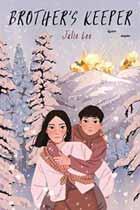
Sora is well aware of the impact of Communism on her family and neighbors. She knows that teachers must tell students to believe that North Korea is a socialist paradise. Parents know if they complain about the government, their children might report them, as they have been given incentives to do so. Attendance is required at Communist Party meetings, but church attendance is forbidden. They know that the police can break into
their homes at any time. The police came to their home and took a relative. No one ever saw him again.
On June 25, 1950, North Korean troops open fire and launch a wellplanned attack against South Korea. Equipped with Soviet tanks and fighter planes, North Koreans capture Seoul and overrun most of the Korean peninsula in three days, except for Busan, located on the lower tip of the Korean peninsula. Since the majority of Koreans in the North are Christians, they believe that the war might provide an opportunity to escape Communism and to practice their faith without being persecuted.
Abahji wants his family to escape, but Omahni believes that there is no point to risking their lives when the Communists have taken over most of the peninsula. They hear that all able-bodied men are being drafted in the army. To protect Abahji, they dig a hole where he will hide. When there is a knock on their door, it is a man from the People’s Army coming for Abahji, but Omahni happens to be away from home with Youngsoo. Sora is alone caring for Jisoo. Since most of the family does not appear to be home, they leave without Abahji.
In September 1950, the Paks learn that an American general named MacArthur launched a surprise attack on Incheon, defeated the North Korean army, and recaptured Seoul. In October, they hear that the Americans with the support of United Nations troops may have captured Pyongyang; however, in November, Chinese units join the North Korean army and drive the United States and UN forces back again. Abahji decides that they must leave that very night as the American troops are leaving and says, “Once they are gone, we will be trapped forever.” Omahni disagrees and fears that they could freeze to death or be shot by soldiers on the border. Sora supports her father, so it is two against one. They quickly pack, taking only the most essential items for their journey through war zones for nearly 300 miles. Sora says that “Omahni would be giving me the evil eye for the rest of my life.”
As they travel south with other refugees, the group becomes a target of a bomb. Sora and Youngsoo become separated from their parents. She cannot find them and has no idea if they are still alive. Without any supplies, she must find her way walking through battlefields in the deadly cold of winter. She only has a world map and an address of relatives in Busan. She loves her brother and knows that it is her duty to protect him, but her affection for Youngsoo is mixed with resentment at his revered status as a son. The children cross icy rivers and find food whenever they can. Sora says, “All I cared about in those days was food and shelter—no better than an animal, no better than a wolf.” Youngsoo becomes sick with a bad cough, and now Sora must carry him on her back.
In spite of being told by kind travelers that they would have to cross more rivers, bridges were destroyed, and North Korean soldiers were coming fast, Sora notices that “the sky dimmed perfectly, turning deep orange and pink, more beautiful than I would’ve thought possible during war. Sometimes, we were granted these small gifts, perhaps as reminders that the sun would still rise and set on this world—even if it had gone crazy.”
Sora represents the many thousands of Korean War refugees who strove with courage and hope for freedom and a better future. In these challenging times, twelve-year-old Sora could be an inspiration for secondary students that they can survive their challenges too. Brother’s Keeper is definitely an empowering story for middle school girls.
Reading Brother’s Keeper will not take much time. The book is 314 pages in length, and chapters are short. A map and a glossary of Korean words are provided. The author includes family photographs that will remind us that this story really happened and a timeline with historical information.1 In the final section, Julie Lee provides information about her extensive research.
RESOURCES 68 Education About ASIA Volume 26, Number 1 Spring 2021
155
BOOK REVIEW ESSAYS
Every page of Brother’s Keeper is carefully crafted. I could visualize virtually every part of the story and even found myself dreaming about it. I became totally absorbed in their harrowing journey. I felt the cold, their hunger, fear, and sadness. I visualized Korean mountains and valleys in black and white. I became a witness to death and the tragedy of war.
Brother’s Keeper is described as a middle school book, but it is definitely a suitable and valuable book for both middle and high school students. As someone who taught on the secondary level for a period of forty years, I envision many opportunities for both middle and high school educators to teach Brother’s Keeper collaboratively or independently in English and history classes.
I retired from classroom teaching fifteen years ago; however, for the first time, I regretted that I was no longer a classroom teacher. I would love to teach Brother’s Keeper, as it has so much potential for meaningful classroom discussions and writing experiences.
We would examine Julie Lee’s ability to get the reader emotionally involved in the story. Students would study the beauty of the author’s writing by examining passages that describe the family’s home, the landscape as they travel south, the dangers they experience, their grief and moments of joy. Everyone would be required to reread the first and last chapter to study how effective beginnings and endings can add to the sheer power and meaning of a story.
We would explore Sora’s difficult relationship with her mother. What were the cultural and generational reasons for their difficulties? Since secondary students have studied Confucianism, they could become engaged in a lesson where they would explore their own “home culture.” If they adopted Confucian principles in their everyday language, family dynamics, and activities in their home, what might family life be like? This lesson was enlightening for my students. It would also deepen their understanding of their reading and their contemporaries who are Asian.2 Some students will express interest in discussing issues that they are experiencing with family members.
After completing our study of Brother’s Keeper, I would provide students with a copy of the Bill of Rights. I would ask two questions: Do North Koreans have any of these rights? Why are they still living under authoritarian rule? The discussion should lead to a deeper understanding of the words on the Korean War Memorial in Washington, DC (“freedom is never free”).
In terms of writing assignments, I believe there are many options that will be interesting to middle and high school students. They could use Julie Lee’s narrative model to write a creative story that includes factual information. Since students will be studying history, they will have an opportunity to build on what they have studied or are currently studying in their classes. Teachers will need to provide suggestions on topics students might explore and how to locate accurate historical information that will enhance their stories. To encourage intergenerational communication, ask the students if they have access to grandparents or others of that generation. If so, generate together interview questions they might ask of these people, and share highlights and surprises during class in what was learned. Sijo, a Korean poetic form, could be introduced and used as a medium for students to express their personal ways of relating to Sora’s story and possibly to something in their own lives.3
The author writes that “there is a great need to share the stories of refugee survivors as they have been largely untold.” Right now, there are more refugees in the world than at any time since World War II. Some students may wish to interview refugees and tell their stories. Others may wish to research refugees from different parts of the world. They should find out what drove them into becoming refugees, what their situations
are now, and what organizations and governments are doing to help them or hurt them.4 This effort could lead to an article in the school newspaper and ideally become the basis for a school service project.
NOTES
1. PowerPoint lectures (“Japanese Occupation,” “The Korean War,” and “Inside North Korea”) are available to download on the National Korean Studies seminar website at www.koreanseminar.org. Photographs of the Korean War can be found on the following websites: from The New York Times at https://tinyurl.com/aw5tdd8m and via a Google search at https://tinyurl.com/y85s47ae.
2. A lesson about Confucianism may be found on pages 222–226 in the Teaching East Asia: Korea e-book located on the National Korean Studies seminar website.
3. Information about teaching sijo is located on the Sejong Cultural Society website: www.sejongculturalsociety.org (see resources, which include excellent videos that explain sijo and how to teach this poetic form). The website also provides information about an annual sijo poetry competition that includes generous awards for both teachers and students.
4. Information is available on numerous sites, such as the United Nations Refugee Agency.
MARY CONNOR taught United States history and Asian studies for thirty-five years. She is the Author of The Koreas (Asia in Focus) (2009) and the recipient of the Organization of American Historians Tachau Award, the Prime Minister’s Award from the Republic of Korea, and the Daekyo Enopi Award. She is the Cofounder of the Korea Academy for Educators and the National Korean Studies Seminar. Both organizations are dedicated to informing educators about Korean history and culture.
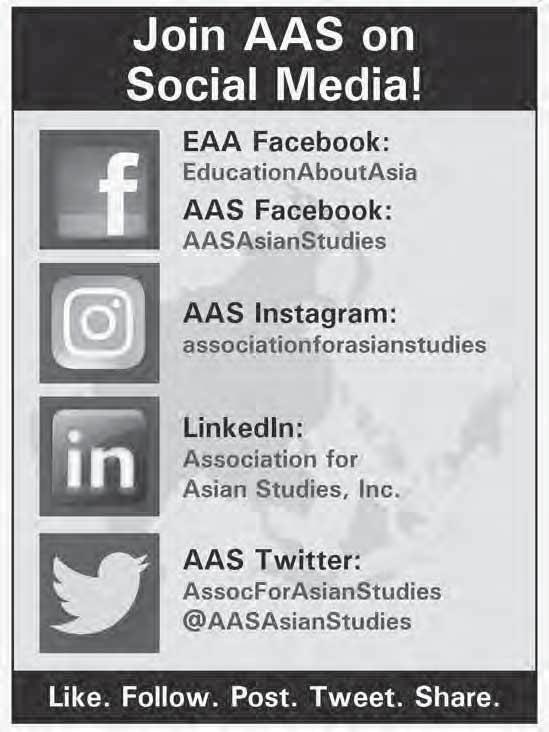
RESOURCES 69
RESOURCE S
Asia’s Environments: National, Regional, and Global Perspectives
156
US, Asia, and the World: 1914–2012
RESOURCES BOOK REVIEW ESSAYS

Waxen Wings
The Acta Koreana Anthology of Short Fiction from Korea
BRUCE FULTON, EDITOR
ST. PAUL, MINNESOTA, KORYO PRESS, 2011
250 PAGES, ISBN: 978-1597432030, PAPERBACK
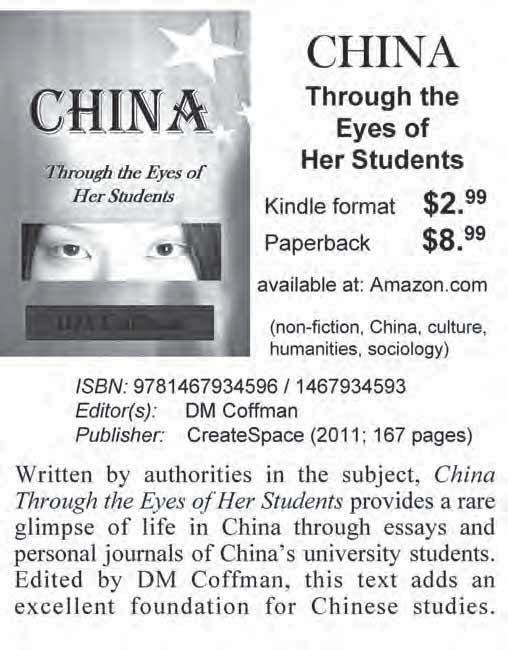 Reviewed by Tracy Kaminer
Reviewed by Tracy Kaminer
s a teacher of world literature to high school seniors, I have experimented with many works in translation, attempting to introduce unfamiliar cultures through story. When the references are too vague or the background too intimidating, students close the book before they give the literature (and sometimes the culture) a chance. That is why Waxen Wings is a welcome work. While Korean readers or scholars who are steeped in tradition and literary arts can appreciate the stories on a deeper level, the novice can find works that are different enough to be interesting but universal enough to be accessible and appealing. Some of the stories are based on folktales and myth, while others have such diverse themes as politics, fantasy and imagination, nature, Western popular culture, and the macabre. The first of the nine stories in the collection was published in 1936 and the last in 2006.
Yi Hyosŏk (1907–1942), who, Fulton tells us, escaped to the countryside when Japanese occupiers clamped down on hiswriting, starts the collection with his less controversial “In the Mountains.” The brief story is a poetic yearning for communion with nature from a character who has been unfairly accused by his village employer of consorting with the employer’s concubine. He runs away to cleanse himself of the filth in the village by sleeping in the leaves, eating what the earth provides, and becoming like a tree himself. The landscape does not let him down, and the only price is loneliness. He has less-than-honorable thoughts about how to deal with that loneliness, for example, by kidnapping a girl from the village, but at the end, as he slept, he “felt himself turning into a star.”
“Constable Maeng” by Ch’ae Manshik, born in 1902, exposes the falsehoods we all tell ourselves. The story may need some introduction to understand that liberation from Japanese occupation took a heavy toll on those who collaborated during that time. Constable Maeng is one such character. Although he considers himself an “upright” man, we learn that he can lie to himself because he was not as successful as others in extorting big bribes from other Koreans and enriching himself during the occupation. Now he has little except for a shrew of a young wife, whom he finds “amusing,” and his own fear about working as a constable again after learning that others like him had been beaten to death by those who were angry about being mistreated under the old rule. The translation by Joel Stevenson is lively and playful, such as in this dialogue when the young wife is complaining that her husband has never given her a silk dress: “You are
such a jerk. If you had a mouth as big as a wicker basket there’s nothing you could say for yourself.” Here is a man who is slow to recognize that society has changed, and he is on the wrong side of history. With alternating humor and gravity, the story engages us in a reflection on the ways in which we make excuses for the wrongs we have committed when we choose to expect very little of ourselves.
A“Weaver Woman” by O Chŏnghŭi and “We Teach Shame” by Pak Wansŏ, both written in the 1970s, follow. These two women are responsible for much of the success of Korean women writers today, says Fulton in his introduction. While the first story recalls the folktale of a herder boy and weaver girl, the second is a story that readers can relate to on many levels—from the widening wealth gap brought to the forefront by both the Occupy and the Tea Party movements in the US right now—to questions we hold in our hearts about our lives’ purposes and directions. The sensitive narrator reflects on her three sham marriages, her evacuation from Seoul in 1951, and life in a camp town with American soldiers. How, then, can people chase wealth all around her, be content to use and discard each other, and disparage their own countrymen? What happened to the “inexpressible harmony” of black tiles and white snow of the South Gate, which remained as she fled Seoul into unspeakable misfortune?
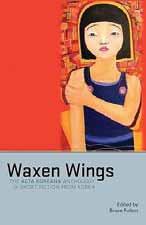
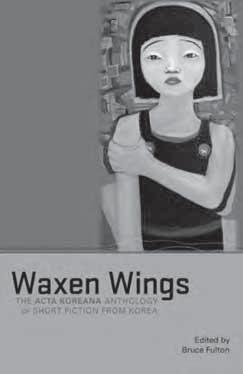
61
157
When the references are too vague or the background too intimidating, students close the book before they give the literature (and sometimes the culture) a chance.
RESOURCES
BOOK REVIEW ESSAYS
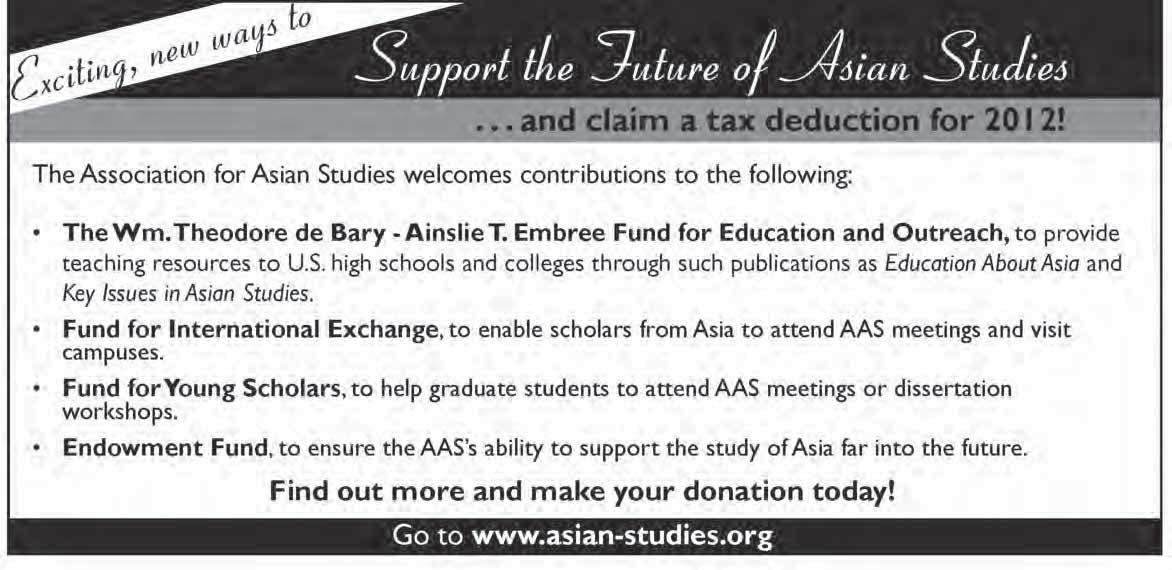
“Waxen Wings” by Ha Sŏngnan, published in 1999, is full of Western references, from the Icarus myth to movies starring Humphrey Bogart and Audrey Hepburn. It is dreamlike, told in second person. Although the story is about a young girl who wants to defy gravity and fly, the reader connects with the loneliness of the person who wants to break free from strict surroundings, the schoolchildren who castigate anyone not like themselves, and the punishing manner of the gymnastics teacher who cuts the narrator loose when she has served her purpose. It makes one wonder: What is going too far in challenging the norm? What is the price one has to pay?
“Prison of the Heart” by Kim Wŏnil, who was born in 1942, is the most directly political story in the collection. He is strongly identified with the division theme in contemporary literature. The narrator, who has just come back from visiting the Soviet Union, finds his brother, a political activist for the poor, dying in the hospital. The brother has spent much of his adult life in jail. A surprising element of the story is the religious dimension. The activism is born of Christian liberation theology, and the world of the shantytowns we glimpse in the story contrasts well with the narrator’s discomfort with the superficiality in “We Teach Shame.” “Prison of the Heart” is the longest story in the book. While it feels didactic at times, the story gains its power when the disenfranchised people enter the story toward the end to carry the brother “home” to the shantytown. The shantytown is located at the top of a steep hill, prompting the mother to comment, “The poorest people on this earth are those living closest to heaven.”
“The Pager” by Kim Yŏngha, first published in 1996, concerns a writer who chooses fantasy over reality and tests the power of his imagination. It is an entertaining tale about a young man whose girlfriend leaves him for another man and then moves to the US to further her studies. When she tells him of her decision, all the bumbling boyfriend can think to say is, “Good luck in your studies.” The rest of the story is the “what if” of the young man’s imagination.
Fulton includes the gritty “Corpses,” written by P’yŏn Hyeyŏng in 2004, as an example of the expanding diversity of women writers’ voices. The disturbing, violent story is followed by “The Glass Shield” by Kim Chunghyŏk, published in 2006. It is another story about isolation, even though it features a pair of friends. We meet two unemployed friends in their twenties on a subway as they painstakingly unravel a ball of yarn. Readers who have experienced the recent economic downturn will relate to this story. The two men go for interview after interview. They try to take a creative approach to their interviews to make the experience meaningful for themselves. They go nowhere until they are photographed on a subway unraveling yarn, and the photos go viral. Suddenly, they are celebrities. The story is contemporary in theme, funny at times, and ultimately about the loneliness of one who sees differently.
What does the collection teach us about Korea? That Koreans are not so different from us, whoever we are. ■
TRACY KAMINER teaches World Literature at Marist School in Atlanta, Georgia. She has been a presenter on Korean poetry and short stories at the Korea Academy for Educators in Los Angeles and at regional workshops sponsored by KAFE and the Sejong Cultural Center. She received a Teaching Excellence Award and a China Teacher Leadership Award, funding travel to Asia, and she has mentored Chinese teachers and served as a consultant for the American Councils for International Education.
62 EDUCATION ABOUT ASIA Volume 17, Number 3Winter 2012
“Waxen Wings” by Ha Sŏngnan, published in 1999, is full of Western references, from the Icarus myth to movies starring Humphrey Bogart and Audrey Hepburn. It is dreamlike, told in second person.
158
BOOK REVIEW ESSAYS
Pachinko
By Min Jin Lee New York: Grand Central Publishing, 2017
512 pages, ISBN: 978-1455563920,
Reviewed by Charles Newell
Paperback
Pachinko, a game of chance not skill, is a rather curious Japanese amusement. It can best be described as a combination of pinball and a slot machine. Players purchase small silver balls that they drop or launch into the vertical pachinko machine. The balls bounce off pins and bumpers, and players hope the balls land in cups or slots that will win them prizes or money. However, the game usually ends with the balls dropping out the bottom of the machine, lost to the player forever.
The game is tilted toward the house. Most players lose, but they keep playing thinking they will be the one to strike it rich. This form of gambling has been popular in Japan for almost 100 years. But oddly enough, the majority of pachinko parlors are run by ethnic Koreans. The Japanese refer to them as zainichi, literally meaning “foreign visitors staying in Japan.” These oppressed minority members, the subject of Lee’s novel, are the descendants of people who came to Japan during the colonial period.
These Japanese–Koreans have a long and complicated history with their former colonial overlords. And in many ways, the game of pachinko is an accurate metaphor for their experience. Like the pachinko balls themselves, the many generations of the Korean family in the novel bounce off the pins and bumpers of life, without much say in the direction of their lives. Forces like colonization, World War II, wealthy gangsters, and a prejudiced Japanese society exert control over the characters’ fates. They are all left to circumstances beyond their control as they try to scratch out an existence in a country that sees Koreans as dirty criminals not worthy of any status in society. Even when some later generations of the family become wealthy and successful, they are never truly part of Japanese society. By the end of the novel, it becomes apparent why the pachinko business is run by Koreans. The Japanese themselves see it as a shadowy enterprise often linked to yakuza (gangsters). Thus, it is often the only place outsiders can find a toehold to earn a livelihood.
This novel covers some familiar territory for those who have read about and studied the Korean peninsula. Lee shows the scope of twentieth-century Korean history: the colonization by Japan, World War II, the Korean War, and the current partition of the two Koreas. However, Lee’s novel brings a unique perspective because, for the majority of the novel, her Korean characters are living in Japan. Their lives are certainly affected by these global events, but the historical context remains on the periphery. The real driving force of the plot is a family’s will to survive in a country often hostile to their very existence. The opening chapters begin in 1910 in a small fishing village in the south of Korea, and the book ends in Tokyo in 1989. Like many novels dealing with the modern world, the reader can see a great change in the culture and the behavior of the characters in a relatively short timespan. Thus, a major theme in the novel is how these characters from a traditional culture deal with the demands of the
modern world that reject tradition for immediacy. Should tradition and family values be ignored for survival and success? This question runs as an undercurrent throughout the novel. This burden/question falls most heavily on the women in the family, who are the keepers and sustainers of family life and culture.
Despite its focus on modern themes, such as the destruction of traditional values, this novel is written in a very conventional and linear narrative style. Each chapter of the novel is a sort of vignette of a character’s life at a moment in time. To cover a seventy-nine-year time period, Lee often skips years ahead from one chapter to the next, focusing on the next major conflict in a character’s path. And though later in the novel Lee often jumps from one character to another in successive chapters, the forward-moving chronology is never broken.
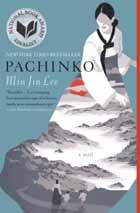
This traditional concept of the novel is reflected in Noa, one of the main Korean characters. He rises above his humble origins and attends a top Japanese university in Tokyo. There, he studies English literature and reads the great Victorian novels of the previous century. He devours the novels of Charles Dickens, William Makepeace Thackery, Jane Austen, etc. Lee’s novel, in many ways, is a reflection of these sprawling nineteenth-century novels that deal with family drama, romance, and a quest for a proper place in society. And like many of those Victorian heroes and heroines, tragedies befall many of the characters as they try to reach beyond what society will allow them. While Dickens seems to be Noa’s favorite author, the downfall of many of the book’s characters reminds one of the bleak novels of Thomas Hardy. The characters in this novel are neither Japanese nor Korean. They are not accepted in their current country and would be rejected or looked down upon if they tried to return to the homeland of their ancestors. There is no place for these zainichi. Their downfall is certain and inevitable.
Despite its very Korean subject matter based on broad historical events, don’t expect to use this novel as a launching point to discuss the two Koreas and how the peninsula came to be divided. It would not be a good text to broach the subject of reunification or denuclearization, even though those are the first things that come to mind when Korea is mentioned today. And even though North Korea is mentioned, this book also does not address the human rights tragedy that continues in that country to this day. This book is about a forgotten group of people in a foreign land. This is a human drama more than a political one. Like the Victorian novels mentioned earlier, this is a great work to use for character analysis. Why does Sunja (perhaps the novel’s main character) make the choices that she does? She could have become the mistress of a wealthy gangster but chooses to be the wife of a sickly, poor Christian minister. Her two sons, Noa and Mozasu, so different yet so similar, take diverging paths in life. Why? How do the restrictions placed on the Koreans by Japanese society affect their actions and choices? There are many possibilities in an upper-level English classroom for this novel. Because of its critical acclaim and multicultural subject matter, this book is certainly a candidate to be included on an AP Literature reading list. This would be a perfect novel to draw from to write the theme analysis essay that is always the last question on an AP exam. The novel includes endless themes and complex characters to draw from.
68 Education About ASIA Volume 23, Number 2 Fall 2018
RESOURCES
159
Like the pachinko balls themselves, the many generations of the Korean family in the novel bounce off the pins and bumpers of life, without much say in the direction of their lives.
A unique feature of this book that could be used in a classroom is the author’s use of Korean and Japanese words and phrases. There are over 100 italicized words and phrases that Lee chooses not to translate for the reader. Having students define unfamiliar words from their context is always a worthwhile exercise. However, many of the untranslated Korean words deal with names for family relations. Students could analyze these words and how they are used to express Korean family structure. This could also lead to a deeper discussion of the influence of Confucianism on Korean culture, even when they are living in a foreign land. Many of the Japanese words in the novel tend to deal with unique places or aspects of Japanese life. Interesting research projects could be done on both groups of words to help students learn more about a foreign culture.
This book begins with the memorable phrase “History has failed us, but no matter.” This is true. The zainichi living in Japan are a forgotten people. Lee shines a light on the struggles of a group of people that most of the world did not realize existed. However, this novel, like any great work of literature, goes beyond that narrow focus. The characters’ searches for love, success, and a sense of home and belonging are universal themes that transcend time and place. No one wants to be the pachinko ball that drops out of the bottom of the machine to be lost and forgotten by the rest of the world.
CHARLES NEWELL is an English Teacher at Notre Dame High School in Chattanooga, Tennessee, and has published articles and curriculum materials on Korea. He has recently become fascinated with Korean sijo poetry. He has videos on how to teach sijo in a high school classroom published on the Sejong Cultural Society website.
A Brief History of Indonesia: Sultans, Spices, and Tsunamis
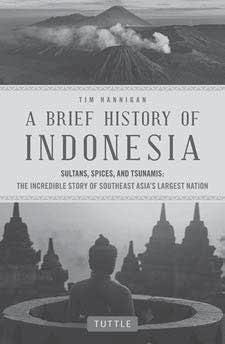
The Incredible Story of Southeast Asia’s Largest Nation
By Tim Hannigan
Tokyo: Tuttle Publishing, 2015
288 pages, ISBN: 978-0804844765, Paperback
Reviewed by Paul A. Rodell
When planning my fall 2017 Modern Southeast Asia course, an introductory survey intended for undergraduates with no prior background, I decided to explore new textbook options. On a whim, I looked through Tim Hannigan’s A Brief History of Indonesia and was immediately taken with this highly accessible volume with its decent font size for easy reading and even a centerpiece of colorful plates of historical significance. While there are more detailed and academically sophisticated books out there, I was struck by the author’s engaging writing style and his ability to explain
complex issues clearly with engaging “hooks,” such as the life of a minor historical actor whose personal story links otherwise-disparate events. I was also impressed that the author could tell Indonesia’s complex story in under 300 pages.
Part of Hannigan’s not-so-secret “secret” is that he is an award-winning novelist and writer of articles for newspapers and magazines, many on travel. It is his job to communicate with large audiences who have a wide range of knowledge and interests rather than writing for academe. This means that his book should be useful to educators and students at the university and high school levels as a resource on Indonesia in global survey courses such as world history or human geography. Another part of his success comes from the heart. Hannigan first came to Indonesia as a young backpacker, landing in Bali after having spent a year in India. His youthful experiences and love for both countries have continued, and he lived in Indonesia for almost twenty years. This close association with the country and its people infuses his writing with cultural sensitivity and affection.
For students whose grade depends in part on their textbook reading, this task is made easier by the volume’s organization into ten brief chapters of roughly equal length that are further divided by lines separating subsections that seem to drift effortlessly from one topic to the next. In addition to the book’s organization, the author also has a wonderful sense of humor. One example is the chapter title “Spice Invaders” to describe the arrival of Europeans desperate for the pungent products that would make them rich back home, while “Rust en Orde” is the title for the chapter detailing the creation of the Dutch East Indies. “Saints and Winners” serves as the title for the arrival of Islam into the archipelago. This chapter places strong emphasis on preexisting folk beliefs that combined with Islam to smooth the world religion’s emergence in the region. The role of early indigenous belief systems is continued in the fifth chapter, which discusses the Dutch entry into the archipelago and is supplemented by an intriguing discussion of how the Dutch used the Enlightenment as a justification for their colonial expansion.
I mentioned the author’s use of hooks in his writing style; usually, the hook is a representative character of an era and at least one of the chapter’s interpretative themes. One example is found in the book’s prehistory opening chapter “From Hobbits to Hinduism.” Here, readers join some early Melanesians who stop at a cave for the night and one of their group has a chance encounter with a now-extinct “hobbit,” the early half-human, half-animalistic creature Homo floresiensis. This sudden chance encounter sends each humanoid screaming into the night, and the reader is hooked into a discussion of early man in the islands. Hannigan frequently repeats this writing strategy, sometimes with odd characters such as the American Frank Carpenter, an early twentieth-century writer of travel literature, who starts chapter 7, which details the rise of Indonesian nationalism.
What is so striking about Carpenter is how seemingly oblivious he was to the changes in Indonesian society happening all around him—“tectonic rumblings,” Hannigan calls them (163). In fact, these rumblings are the real story. In the early twentieth century, the major Islamic organizations, the Muhammadiyah and the Nahdlatul Ulama, are founded; the secular
69
RESOURCES
BOOK REVIEW ESSAYS
160
I was struck by the author’s engaging writing style and his ability to explain complex issues clearly with engaging “hooks,” such as the life of a minor historical actor whose personal story links otherwise-disparate events.
Extensive information (a Power Point lecture, videos, teacher guides, famous examples of sijo over time and examples of student work) on sijo and short stories is available on the Sejong Cultural Society’s website www.sejongculturalsociety.org The website also includes information on an outstanding annual essay and poetry contest.
: What follows is a suggested guideline for teaching sijo in a language arts classroom. The approach is created for students in grades 9-12 but can be modified for 7th and 8th grade students as well. The material is intended to provide three days of teaching about sijo in a 55-minute class. The background material can be a day in itself if you take the time to discuss the Korean Wave and spend more time on the Korean history timeline. Day 2 could be the introduction to sijo itself concluding with the 10-minute sijo. Day 3 could be the sharing of the sijo created for homework. The teaching objectives are to introduce Korean culture through a form of poetry particular to Korea, to read and understand some important sijo in their cultural context, and to understand and practice writing the sijo. Materials used for this lesson plan come Early Korean Literature by David McCann, Columbia UP, 2000; The Bamboo Grove: An introduction to Sijo by Richard Rutt (U of Michigan P, 1998) and “The Sijo, a Re-Versible Door into Korean Culture,” from Education About Asia (Spring 2010) published by the Association for Asian Studies.
: Before introducing students to a 15th century form of poetry written in Korea, introduce them to an aspect of Korean popular culture. If you have the means to do it, show them the “Super Girl” music video by Korean boy band Super Junior M or “I Want You Back” by the girl band Secret or “GangnamStyle” by Psy. You can find the videos on youtube.com. Why is this relevant? Students may be interested in knowing about the Korean Wave, which refers to the successful exporting of Korean culture since the 1990s. The impact of Korean culture, particularly in Asia, stems in part from the exporting of Korean soap operas and films. See the following articles for more information: http://www.asiamedia.ucla.edu/article.asp?parentid=86640 and http://en.wikipedia.org/wiki/Korean_wave
: Hand out a chronology of Korean history. It is important for students to recognize Korea’s deep history. While students may be familiar with a few of the dates in modern history, such as those pertaining to the Korean War or Japanese occupation, they may know nothing about the famous Silla Dynasty, known for artistic and cultural development, or the Joseon Dynasty under King Sejong. Point out that King Sejong was known as an inventor and among his achievements was the creation of the Korean alphabet, called Hangeul. For more information on King Sejong, see the following article: http://www.asiasociety.org/countries-history/traditions/king-sejong-great . The development of the Korean alphabet and language were important for Koreans whose formal communication and written history had been conducted in Chinese. According to David McCann, even though Chinese continued to be the dominant form of written communication in Korea until the 19th century, “an opposing Korean
Kaminer 1
161
character and spirit kept trying to assert itself,” because of the development of Hangeul. Important to the development of poetry in Korea was the state examination system. As in China, all educated men were trained in literature and composition as they prepared for the examinations that could qualify them for public service positions. From the 15th century on, the poems written by the scholars were either kasa, poems composed of an indefinite number of verses, or sijo. See the following for more information: http://www.stockton.edu/~gilmorew/consorti/1deasia.htm
A sijo is a three line poem particular to Korea, developed in the 15th century. The poem introduces a theme in the first line, develops it in the second, has a twist or counter-theme at the beginning of the third line and concludes with a return to the original theme. The form of the poem relies on set phrasing and syllable count, which will be explained later. Sijo were originally composed to be sung to a fixed melody. Now they are literary works instead of musical ones.
A shadow strikes the water below; a monk passes by onthe bridge,
“Stay awhile, reverend sir, Let me ask you where you go.”
He just points his staff at the white clouds and keeps onhis way without turning.
Chong Chol (1536-1593)
1. What is happening in the poem? (Literally, a monk is walking on a bridge, casting a shadow in the water. A person asks him where he is going. Hepoints to the clouds and walks ahead.)
2. Which words feel particularly important in the poem? (Some students may answer shadow; bridge; stay; go; points; clouds; keeps. Ask them what feels important about those words. Ask them to notice words that balance each other)
3. What do you think the theme of the poem is? (Some may talk about life as a journey; the difference between earth shadow --and the Heavens white cloud; the commitment of the monk and his focus on his goal)
4. What is the importance of the phrase that starts the third line, “Hejust points”? (Despite a speaker’s attempt to get him to stay, the monk is focused on his journey; he doesn’t even take the time to speak he just points; his answer causes us to examine the difference in earth and sky, in the now and the hereafter.)
5. Try to explain the poem in terms of theme, counter-theme, and a return to the theme, the pattern of a sijo. (On a monk’s life journey, he is asked to pause, to turn away fro m his goals; he points ahead, never turning away from his life’s journey)
Kaminer 2
162
Jade Green Stream, don’t boast soproud ofyour easy passing through these blue hills.
Once you have reached the broad sea,to return again will be hard.
While the Bright Moon fills these empty hills, why not pause? Then goon,ifyou will.
Hwang Chin-i (16th century)
1. Ask the same five questions. Students may respond that the theme is a kind of “seize the day” one about enjoying the moment. They may see it as a poem about nature and the inevitable flow of time.
2. Ask the students: imagine that one character’s name is Jade Green Stream and one character’s name is Bright Moon. How would they then explain the story of the poem?
3. Explain that this poem in the original language is divided into Chinese and Korean halves. The Chinese half of each line includes the words “Jade Green Stream in the blue hills; arriving at the broad sea; the Bright Moon filling the empty hills.” The Korean second half of the poem includes the words “Don’t boast; it is hard to return; pause and go.” What do you notice about what the Korean language includes as opposed to what the Chinese language includes? What do you think is the point that the author is making? (According to David McCann, the Chinese half names and situates elements of the natural world; the Korean half un-names and dis-locates.)
4. Share the story of the poem: Hwang Chin-i, the assumed author of the poem, was a kisaeng, a female entertainer, rather like a geisha in Japan. It was said that no man could resist her. She went by the name Bright Moon. A Confucian scholar-official, whose title was a homophone for Jade Green Stream, bragged that he could resist her and could pass through her region without stopping. She made up the song and when he heard it, he supposedly fell off his mule. According to David McCann, “The story frame makes the natural scenery a pun for the two humans, the man and woman, the official and the kisaeng, the two opposite poles of traditional Korean society. As happens over and over again in Korean folk literature, the cleverness of the vernacular makes the official, stuffy male seem a fool and topples him from his lofty yet precarious perch.”
5. On the sijopoetry.com website, you can listen to David McCann discuss this poem and perform part of itin Korean.
6. Challenge: write a bilingual three line poem. Write half of each line in English and half in a second language you know. Or write half of the line in standard English and half in another English dialect. Try to create a push and pull or tension in the use of the two languages. Share your experiments.
Sijo poems are based on phrases of a certain number of syllables. David McCann explains that the lines of a sijo should feel as if they are unfolding, phrase by phrase. The first two lines are often similar or even identical in their phrasing and syllable counts. The third line has the all- important twist, which is always at the beginning of the third line and is always three syllables.
Kaminer 3
163
Basic Standard Syllable Count:
Firstline:phraseone phrase two phrasethree phrasefour (3) (4) (4or 3) (4)
Secondline:same same same same
Thirdline:phrase one phrasetwo phrasethree phrasefour (3) (5) (4) (3)
Variants:
First line: 2-5; 3-6; 2-5; 4-6
Secondline: 1-5; 3-6; 2-5; 4-6
Thirdline: 3; 5-9; 4-5; 3-4
Important note on last line: in many classic sijo, the first three syllables are often an exclamation or a word of strong emotional value. The phrase following that three syllable twist is normally the longest in the poem and gives a sense that the poem is about to conclude. By the end of the third line, the poem has come to an unsurprising ending. In sung sijo, the last phrase is often omitted altogether.
: Read the following Sejong Cultural Society contest winners’ poems. Identify the qualities of a sijo that make eachpoem a winner. Stress theme, counter theme, and return to theme.
A single sole was lost today, deep in the river Yalu,
Thrashing, twisting, torn to shreds with color quickly fading.
Onthe bridge a small boy laughs, holding out his empty shoe.
Creasy Clauser (12th grade, Crawfordsville, IN)
You ask me what I’m humming; I tell you I’m humming about nothing. This isuntrue because I’m humming about you, all day long.
Who am I totell you you’re“nothing” when you are my song?
Taylor Edward (10th grade, Euless, TX)
Kaminer 4
:
164
I look through the window of the Korean barbeque place.
Ducks, chickens, creatures, big and small, hang from the gallows of the cook.
Step inside and join the culture, leave your wishes at the door.
Jacob Diamond (11th grade, Weston, FL)
With the syllable and phrasing chart handy, write a quick sijo. It can be about anything for instance, something that happened that day at school or at home. Work for the unfolding quality phrase upon phrase with a three syllable twist in line three. The twist can be an exclamation or a question.
Create a student generated list on the board of topics that you would not expect to be ones associated with sijo. They may include subjects such as neckties, pollen, bran muffins, and freezers. The list is intended to get them away from only focusing on broad topics such as summer and graduation.
Ask students to write three sijo for homework. They should be proofed, edited, and typed. In class, they should choose one of the three to read to the class.
Ask students to trade sijo, concentrating on the ones read in class.
1. Students should mark the phrases and count the syllables in each phrase in each other’s sijo. They should then discuss their findings with the writer. They should discuss whether the poem follows the sijo pattern. If there are variations from the pattern, the writer should explain why. The student should also discuss which phrases in the poem seem particularly effective and why They should also mention any difficulties in understanding they have and any suggestions for improvement.
Students should revise their sijo for homework and turn them in edited and typed for a grade.
Have the students teach sijo writing to someone else a family member, a friend, a faculty member, or someone in the community. Ask the students to write a 1-2 page process essay in which they discuss the steps they took to teach the sijo, making mention of the difficulties and successes they had along the way. They should write about what they learned in the process. They should then include a sijo from their “student.”
Kaminer 5
165
Student Sijo (Tracy Kaminer, Marist School, Atlanta, GA)
Untitled (Honorable Mention, Sejong Cultural Society Contest)
I move from Africa to Asia to the North Pole, For the only requirement to travel is desire
And a flick; spinning the globe, dropping my finger aimlessly.
Ray Smets
Untitled
Beautiful black hair, blue eyes, she lies next to me staring.
Is it real? Her perfection? I do hope this lasts forever.
She is gone. I wake to no one, deceived, hurt, and alone.
SeanManzelli
Txt Me
“LOL, smiley face, I wud luv 2 go w/u.”
“RU picking me up? Im so xcited.” “CU @ 8?”
“WTH, y R U not txting me bak?!” Did I say too much?
Maddie Scott
Homework
Thoughts racing through my mind, I’m scared to ask; will she say no?
I need help. I don’t get it. I find math embarrassing.
“Can you help?” It is quiet again. Back to my desk, struggling.
Lauren Smith
Kaminer 6
166
Misunderstood
There he is. I briefly catch his eye from across the room. He smiles and waves, so I do the same. A near stranger, how kind!
I look back to see his girlfriend return his eager wave.
Reidy Dukes
Dreaming
What a wonder, what a mystery. I jump the tracks, land on the beach, Swim in the sea, end up in Paris. “Hello!” a distant voice says.
Where am I? What happened to Paris? Six forty five? Take me back . . .
Meggi Lienhard
Kaminer 7
167
Chapter 4
Korean
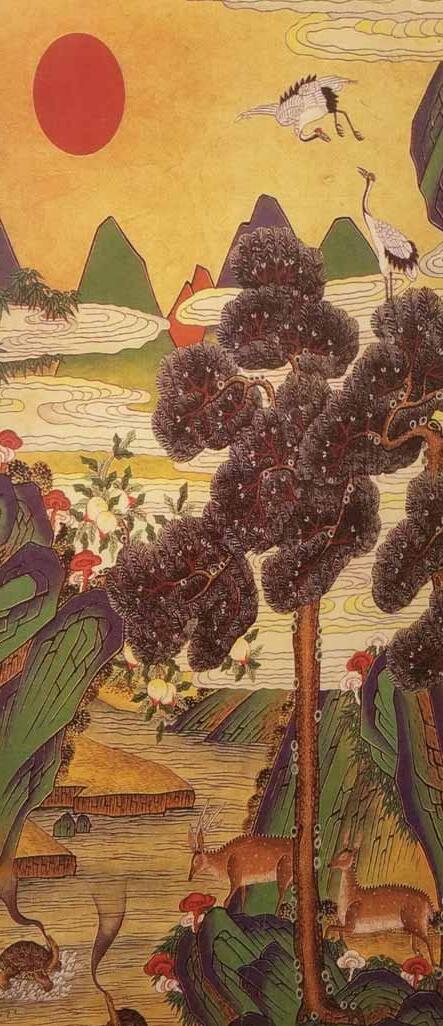
Art for All Grades 169
A Study of Korean Art and Architecture: Opportunities for Research
Background Information for the Study of Korean Art and Architecture
The Internet provides information on all of the art and architecture selections listed for the lesson.
The Korean Spirt and Culture Promotion Project (http://www.kscpp.net) has videos and books that can be downloaded. Information on the following selections is available on the website video titled FiftyWonders of Korea Section: The Sacred Bell of King Songdok: Sokkuram Grotto, Golden Crown of Silla, Pensive Bodhisattva, Celadon, and Changdok Palace.
Educators may also order copies of FiftyWonders of Korea: Volume I. Culture and Art. This paperback book will provide information on all of the art and architecture selections mentioned in the lesson except for the genre paintings of Kim Hong-do and Bulguksa. The painting, Fifteen Thousand Buddhas, is listed in the chapter, “Koryo Buddhist Paintings.” Fifty Wonders of Korea and all of the KSCPP books listed on the website are available for educators free of charge. To order books, send your request to info@kscpp.net.
The Asian Art Museum of San Francisco (www.asianart.org), Metropolitan Museum of Art New York (www.metmuseum.org) and the National Museum of Korea (http://www.museum.go.kr) provide images and text information.
Varied Approaches to the Lesson
Students enrolled in Art, Advanced Placement Art History or World History can try a variety of approaches to this lesson. Some suggestions are as follows:
Students taking an art class might complete their research and then submit a written report, a Power Point presentation, or complete an art project related to their topic, such as replicating a genre painting of Kim Hong-do or a landscape painting of the Joseon dynasty.
Advanced Placement Art History students could make comparisons between Korean and Chinese architecture or Korean and Japanese architecture after researching Bulguksa or Changdok Palace or compare genre paintings of Kim Hong-do with a famous Western genre painter, such as Bruegel.
Students of World History could make comparisons between Korean art or architecture and Western art or architecture.
Time involved: One day to a week or more.
171
Silla Gold Crown
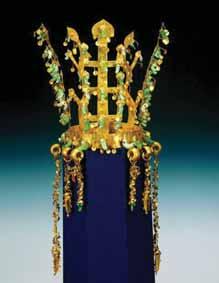
The Silla Kingdom (57 BCE – 935 CE) was rich in gold, and by far the most spectacular objects found in Silla tombs are the royal crowns that were constructed from pure gold. As a result of the stability of the government, the people of Silla were able to develop a refined culture, as evidenced by skillfully crafted artifacts that have been excavated from ancient tombs around the ancient capital, Gyeongju. The exquisite crowns reflect Daoist respect for nature and shamanistic beliefs.
Bulguksa is the most magnificent example of Silla architecture and the most renowned Buddhist temple in Korea. It is located in the mountains near Gyeongju, the ancient Korean capital. It was originally built in 528 CE. The harmonious beauty of the temple reveals the highly developed architectural taste and skills of the ancient Silla people. In 1966, a Buddhist text inside one of the pagodas was discovered and is regarded as the oldest Buddhist text printed with wooden blocks in the world.
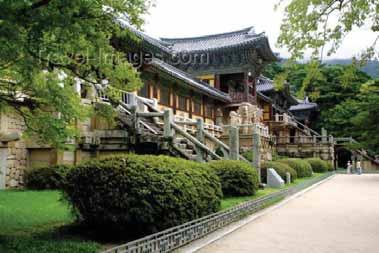
172
Pensive Bodhisattva
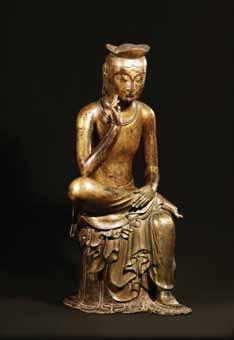
Reminiscent of The Thinker by the 19thcentury French sculptor August Rodin, Pensive Bodhisattva was created during the Three Kingdoms period in the 7th century. It is considered to be one of the finest examples of ancient Korean art. Approximately 70 statues of pensive bodhisattvas exist all over the world; this statue is considered to be the most famous.The statue expresses the spirit of the Bodhisattva who is meditating on the suffering of human beings and how to ease their suffering.
is unparalleled in beauty and craftsmanship. In Buddhism the sarira are marble-like relics that remain after an enlightened being was cremated. A sarira reliquary is a work of art that is made to hold those relics. Since sarira are considered sacred, the greatest artistic skill and most
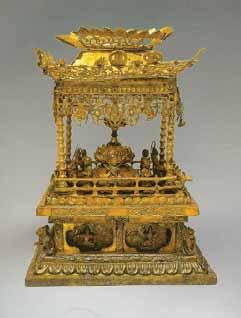
173
advanced techniques of the day were used in its construction. In 2002, researchers tried to replicate the reliquary’s wind chime with modern heating equipment, but could not achieve what 7th century artisans could accomplish.
may be considered Korea’s most beautiful, spiritual, and extraordinary work of art. It embodies “the perfect and ideal harmony of science, art and religion in a single entity.” The grotto is the most elaborate manmade grotto in the world and was constructed in the 8th century with an extraordinary level of geometrical accuracy.The most memorable feature of the Sokkurum Grotto is the Buddha statue that represents the moment when Shakyamuni attains Buddhahood. One does not have to be Buddhist to recognize the spirituality of the Buddha statue.
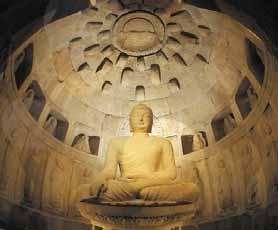
Goryeoceladon is one of the most renowned Korean art innovations and particularly famous for its elegant bluish-green glaze and inlay technique.Celadon craftsmanship reached its zenith in the 12th and 13th century. Even with significant advances in technology since the time of the Goryeo dynasty, potters have been unable to create the same level of beauty as Goryeo potters were able to achieve. Celadon had many different uses, such as tea cups, wine bottles, flower vases, and vessels for Buddhist rituals.
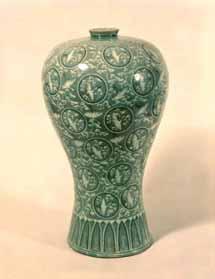
174
Fifteen Thousand Buddhas During the Goryeo dynasty the greatest achievements in painting were Buddhist.Thesepaintings are high standard works of art, richly detailed and meticulously painted, revealing the gracefulness characteristic of Koryo art. The artist’s objectives were to glorify the compassion and virtue of the Buddha and to help people understand the Buddhist scriptures by illustrating them visually. Fifteen Thousand Buddhas appears initially to be one Buddha, but upon examination one sees thousands of Buddhas painted in gold with faces about 0.2 inches in size.
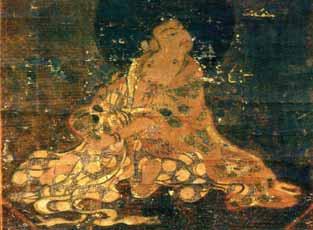
The Changdok Palace retains the grandeur and dimensions of a representative Joseon period royal palace. The palace was built in 1405 as a royal villa by King Taejong, the third ruler of the Joseon dynasty. The palace is set within a large park in Seoul and is one of five grand palaces built by the kings of the Joseon dynasty. The palace grounds consist of a public palace area, a royal family residence building, and a beautiful secret garden. Known as a place of rest for the kings, the garden contains a small pond, a pavilion, and a tree that is over 300 years old.
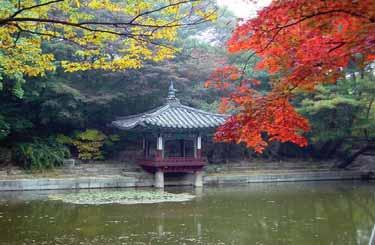
175
Joseon Porcelain
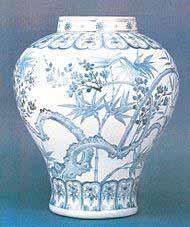
Fine porcelains were created throughout the Joseon period, both for the upper classes and for ancestral altars. Since this period was greatly influenced by Neo-Confucian beliefs in simplicity and austerity, porcelain ritual vessels tended to be all white with no decoration. However, some wine and food vessels were decorated with designs inspired by nature, such as the jar with plum andbamboo images. By the 18th century these vessels were considered to be the finest porcelains of the Joseon dynasty.
Village School
Korean genre paintings (illustrations of everyday life of the people) of the Joseon dynasty in the eighteenth century are famous for their candid, realistic representations of Joseon society and are considered by many as the most “Korean” of Korean art. Kim Hong-do was a leading genre painter and landscape artist of the time and a favorite of the king. His delightful and engaging paintings reveal his sense of humor and accurate depictions of the life of the people that invite the viewer to take a closer look, such as the painting of a village classroom scene. The children seem to be teasing the child who is sitting in front of the teacher. (Many images of Kim Hongdo’s paintings are available on the Internet)
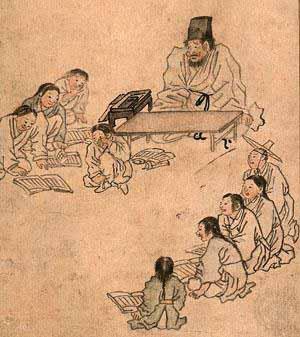
176
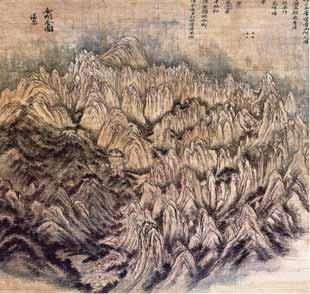
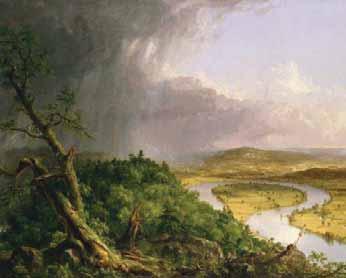
177
Mt. Geumgang, The Oxbow
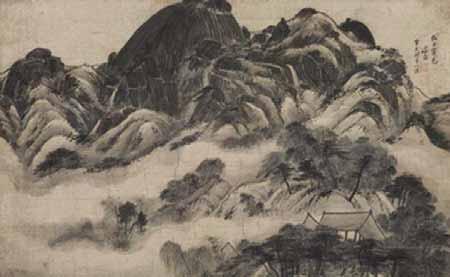
178
Clearing after Rain on Mt. Inwang.
179
Suggestions for the Lesson on Korean and American Landscape Painting
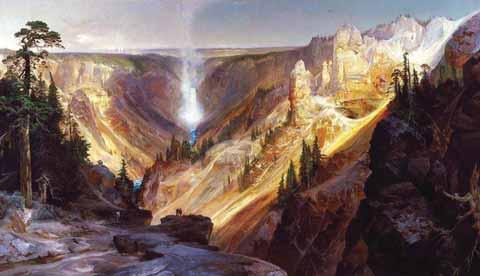
Mt.Geumgang The Oxbow
For class discussion and possible writing assignments:
The Oxbow(Fig.2)
The Grand Canyon of the Yellowstone
The Grand Canyon of the Yellowstone
180
Bibliography (Korean Landscape Painting)
Masterpieces of Korean Art Special Lecture on Korean Paintings.
Art Forms.
Masterpieces of the Ho-Am Museum
Bibliography (American Landscape Painting)
The Story of American Painting
Arts and Ideas
Readers Companion to American
181
Folk paintings are an invaluable part of Korea’s cultural heritage and convey mythology, religion, and views of the Korean people. They are artistic expressions of individuals who drew paintings to decorate homes and to celebrate joyful family occasions, such as weddings and sixtieth birthdays. It has been said that the tradition of folk painting endured for so long because they “touched the soul of the Korean people.”
One is easily charmed by Korean folk art. The unknown artisans who created folk paintings had an optimistic outlook on life. In their agrarian society “they perceived a miraculous order of the universe that they attempted to express.” They used symbolism to convey their feelings of happiness, anger, love and delight in everyday life. Humor and satire are important elements of the paintings.
In Korea, folk art has traditionally been viewed as a secondary art form despite its rich tradition and widespread popularity. Due to this misperception, minhwa (“folk painting”) has been devalued or misunderstood and compared unfavorably with the tradition of the aristocratic class known as muninhwa (“scholarly painting”). Recently, minhwa has begun to attract serious scholarly attention and is beginning to enjoy long overdue recognition as an important genre with its own distinctive aesthetic qualities and historical significance.
Folk paintings are grouped into two major categories of folk belief: wishing for good luck and repelling evil spirits. Every folk painting contains people’s wish for happiness. Folk paintings have two underlying themes: longevity and blessings for all people. Wishing for longevity, artists displayed paintings of the sun, clouds, pine trees, bamboo, cranes, deer, turtles, water and rocks. The peach and the pomegranate meant plentiful offspring, long life and bountiful happiness.
Koreans believed in the yin and yang and that people’s life included both good and evil. They also believed that folk paintings possessed shamanistic powers to protect them from war, disease and famine. Paintings of animals could drive away evil spirits. The animals most frequently depicted were the tiger, dragon, the unicorn and the turtle. The tiger was the most popular motif in this category. Tigers were believed to prevent natural disasters such as fires, floods and wind and even their skin, bones, claws and whiskers could exercise mystic powers. The dragon would also protect people from evil forces together with symbolizing the king and royal authority.
Some additional symbols: fire (benevolence), grain (life), mountain (dignity), magpie (a harbinger of good news), pheasant (fidelity), bamboo and the pine tree (longevity),
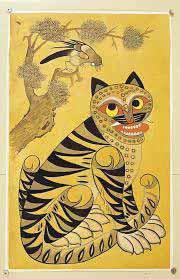
Korean Folk Art
182
chestnut (filial piety), peony (wealth), turtle (endurance), unicorn (mercy), lion (power), duck (fidelity) and deer (honor and success through scholastic endeavor).
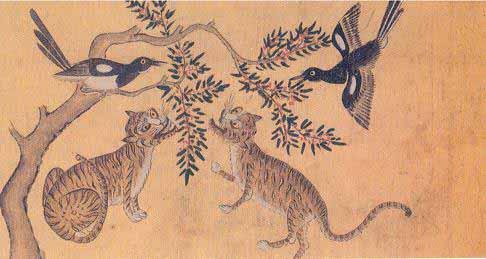
From: Handbook of Korea Art: Folk Painting, Yeolsu Yoon (Yekyong Publishing, Seoul) For more Korean folk art images, Google “Korean Folk Art”
Interpreting Korean Folk Art
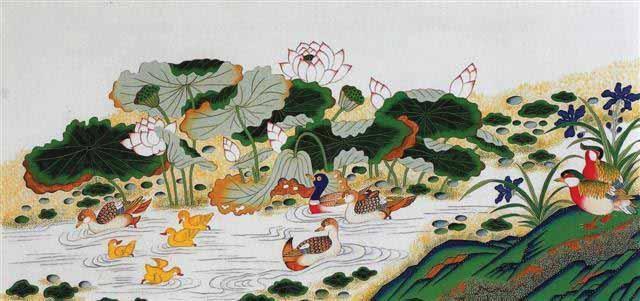
What symbols do you see in this folk painting? What did the artist wish to convey?
What symbols are used in this painting? What did the artist wish to express to the viewer?
183
What does the tiger symbolize?
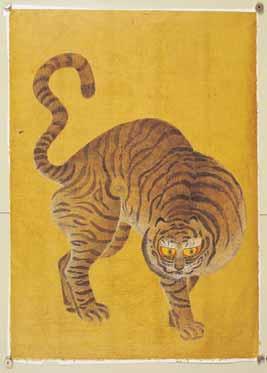
What are the various symbols in this painting? What did the artist wish to express?
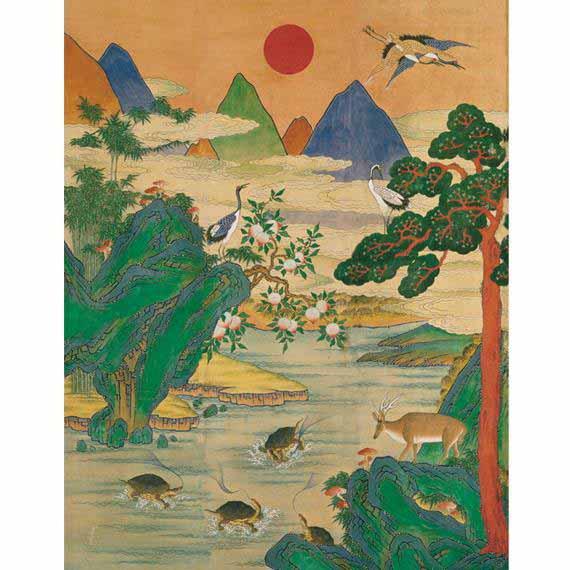
184
182 187 185
183 188 186
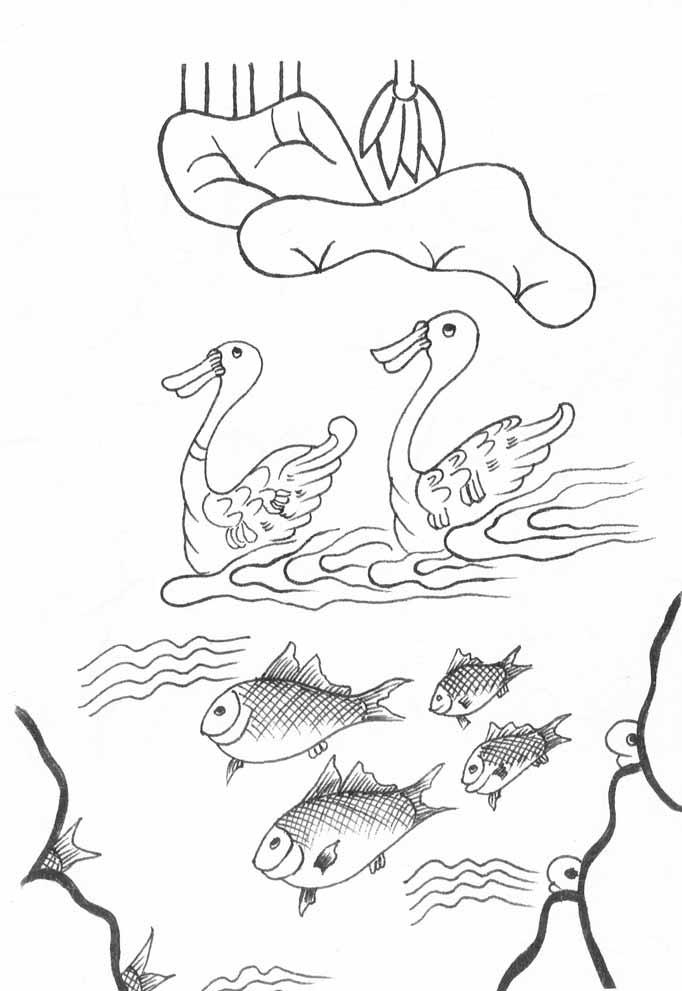

187

190 188
Art and Technology
During the last 50 years, many artists have addressed the relationship between technology and how people experience the world. According to Korean artist Nam June Paik, “Our life is half natural and half technological.” Paik has also commented, “Skin has become inadequate in interfacing with reality. Technology has become the body’s new membrane of existence.”
Nam June Paik, TV-Buddha, 1974, Virginia Museum of Fine Arts, Richmond, Virginia
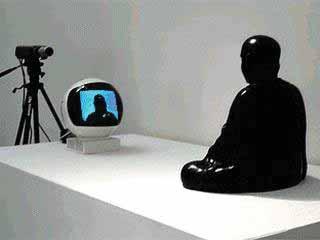
Nam June Paik, Electronic Superhighway, 1995, Smithsonian American Art Museum, Washington D.C.
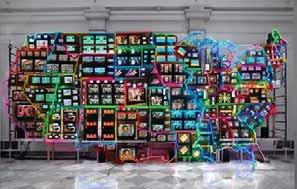
Nam June Paik (1932-2006), recognized internationally as the “Father of Video Art,” created a large body of work including video sculptures, installations, performances, videotapes, and television productions. He had a global presence and influence, and his creative art and visionary ideas continue to inspire a new generation of artists.
Identify one work of art created after 1960 that addresses the relationship between technology and how people experience the world. Your selection could be a work in video, photograph, or installation, as well as a work in any other medium. Making specific reference to both Paik’s words and your selected work, analyze how your example addresses the relationship between technology and how people experience the world. You might select Nam June Paik as your choice for research or another highly recognized artist, such as Bill Viola, a video artist. A very different approach would be to compare/contrast Nam June Paik with another Korean artist, Song Su-Nam, who took his art in the opposite direction by abstracting tree forms in the traditional Korean style to extend its literati (scholar-artist) tradition.
189
Installation Art and Choi Jeong Hwa
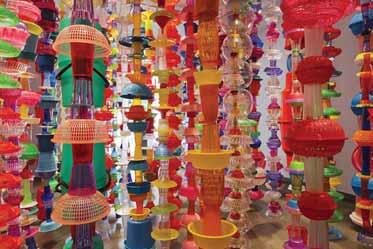
Installation art is a relatively new art form that involves the configuration or “installation’ of objects in space, such as a room, warehouse or building. The arrangement of material and the occupation of a certain space form the work of art. Installation art is usually temporary and relocated to another place.
Choi Jeong Hwa (b. 1961) is one of the most famous contemporary artists in South Korea. He works with visual arts as both an artist and a designer. Choi finds inspiration in the dynamism and beauty of the city and its people and wants to bring something new and collectively shareable into the public space.
”Happy Happy invites the viewer into a colorful plastic jungle. When looking closely, one sees a dazzling display of familiar domestic appliances stretching from the ceiling to the floor. Choi builds his large installations by combining new and old, unique and mass-produced elements, blending Korean pictorial tradition with global consumer culture. From ordinary consumer goods, such as colorful plastic vessels and cheap toys, Choi builds experiential and immersive spaces. At the same time, his creations call our attention to the materialism in which we live and the overabundance of goods and the ubiquity of plastic.” All of the information is from the following website: http://www.e-flux.com/announcements/10980/choi-jeong-hwahappyhappytogether/
Happy Happy by Choi Jeong-Hwa, 2009, Kiasma Museum of Contemporary Art, Helsinki, Finland
190
Doors, Choi Jeong-Hwa, 2009, Seoul, South Korea
Doors was a huge ten-story installation created from 1,000 reused doors. Choi has said that he became an installation artist because he could not draw or paint, but enjoyed walking around the city looking for interesting trash, discarded items, and photographing what he saw.
A possible class or school project would be to create an installation art form for one’s school. A teacher from Appleton, Wisconsin with the assistance of her students created a Happy Happy installation in the front hall of her school. The teacher was inspired by the 2009 exhibit of Happy Happy at the Los Angeles County Art Museum.

191
Using Korean Bojagi in the Classroom
By Carrie Jeruzal
Rationale: Studying the cultural importance and meaning behind a utilitarian piece of Korean folk art deepens students’ understanding and appreciation of Korean people and broadens personal creativity through the medium of fiber art.
Key Concepts about the Enduring Idea
· Bojagi were/are practical, beautiful, and meaningful objects.
· Bojagi were traditionally made by “unnamed,” isolated Korean women and girls.
· Bojagi wrap gifts, food, tables, and other objects.
· Bojagi are self-expressed individual designs and often become family heirlooms.
· Bojagi are comprised of reusable, reversible patchwork squares and rectangles stitched from fabric, similar to mini-quilts.
· The way a bojagi is wrapped around an object can be an art in and of itself.
· Colors, stitches, patterns, and embroidery can be symbolic.
· Bojagi can be compared and contrasted with American crazy quilts, contemporary story quilt installations, and the work of painters Piet Mondrian and Paul Klee.
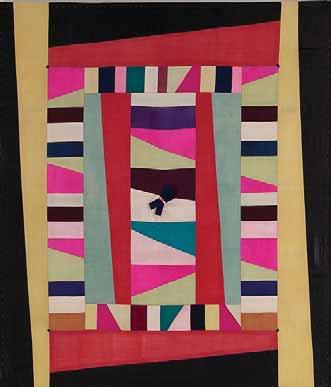
Essential Questions
Bojagi: An Introduction
Bojagi (sometime written pojagi) is a traditional Korean folk art consisting of patchwork cloths made from scrap fabrics such as cotton, silk, ramie, and hemp. These practical cloths of varying sizes were present in Korea as early as the fourteenth century and were used to cover and contain items such as gifts, beds, tables, and foods. The art has historically been passed down through generations of unnamed female artists and were used by Korean people from all classes, commoners and royalty alike. Traditionally, girls learned needlework at a young age, and bojagi became a rare outlet for creative expression.
The handmade textile covers embodied personal sentiments “stitched” into each design. The artist carefully selected colors, patterns, and even stylized embroidered imagery from nature, such as peonies and bats, to become symbols and metaphors for good fortune, longevity, happiness, and more. Commonly, bojagi is made from a minimalist design of squares and rectangles recalling images similar to modern-era European paintings by the likes of Paul Klee and Piet Mondrian. Bojagi were triple-stitched with raised seams, allowing their images to be reversible, durable, and reusable. The textiles could be wrapped over objects into a number of similar forms, much like those of origami.
Historically, bojagi were not only decorative but were also used in religious and symbolic ways. Often, bojagi became family heirlooms. Today, contemporary bojagi fiber artists such as Chungie Lee have reinvented the medium not only as a means of honoring the history of Korean women, but as a relevant, versatile art that is often intertwined with fashion and photography.
Classroom Applications
Enduring Idea: Bojagi are significant Korean historical and contemporary works of art, both from visual and cultural perspectives.
· What are bojagi?
· What are some of the Korean cultural meanings and traditions surrounding the art form?
· How can fabric be used in self-expression?
· How can art serve others?
Unit Objectives
· Students will have a better understanding of Korean art and culture and therefore a broader worldview.
· Students will learn how to create a mini self-portrait in a style of their choosing using a mirror or a photo reference.
· Older students will learn how to appropriately select fabrics, hand stitch, and use a sewing machine.
· Students will honor/love their parent/guardian and the community in the Confucian tradition.
Assessment
· Students will critique traditional, contemporary, and personal works of fiber art.
· Students will share statements to explain their works to teachers, parents, and press.
· Students will exhibit their work at school, in the local newspaper, and at home.
· Students will ask and answer deep questions relating to cultural significance and personal intention.
Formative assessment will be done through verbal questioning, observing, monitoring progress, and stitching/sketchbook checks. Summative assessment will be done in the form of a final presentation, digital photo record, and display, where points will be earned when specific criteria are met.
RESOURCES TEACHING
RESOURCES ESSAYS
189 192
Patchwork wrapping cloth (Jogakbo). Source: The Metropolitan Museum of Art at http://tiny.cc/ow0e1w.
RESOURCES TEACHING RESOURCES ESSAYS
Unit Plan Resources
Materials PurchasedMaterials Already Available
Materials/Labor Donated
A hardware store cut the wooden inch tiles (one or two needed per student) Acrylic painttiles and a custodian drilled holes
Wooden masonite board cut into four-by-six-Crayola fabric markers
Fat quarters of cotton fabric in a variety of Twine, yarnat the top of the boards so each colors and patternsGesso primercould be hung
Rotary cutting mat and rotary fabric cutterScissors
Thread, needles, straight pinsOil pastelsAdditional fabric
Seven bottles of strong fabric glueMirrorsTwo irons and an ironing board
Giant Ziplock storage bagsBrushesSewing materials (thread, bias tape, Good Fortune in a Wrapping Cloth Paint palettesribbons, buttons, etc.) by Joan SchoettlerWater, water cups, aprons
Bojagi and Beyond by Chunghie LeeFabricTwo used sewing machines
Wrapagami: The Art of Fabric Gift Fabric scissors(labor for repair of one machine)
Wraps by Jennifer PlayfordMetal T-square and rulers
Two hundred digital prints of students’ work Digital cameraLocal artist Eliza Fernand’s for displayPlastic bags for covering tablescontemporary story quilt



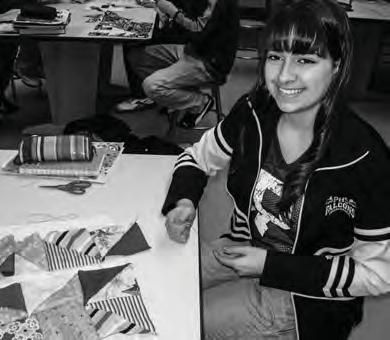
Newspapers for covering tablespresentation and community
Two large plastic bins for storage“white quilt” stitching instruction
Computer with Skype download
Computer-mounted camera withTwenty-minute Skype interview microphonewith author Joan Schoettler
SMART board, projector, speakers, and one iron
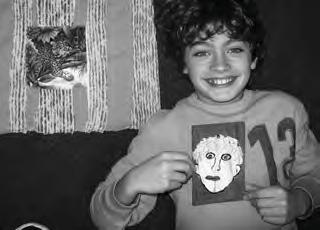 Lexi, twelfth grade. Image courtesy of author.
Nicholas, sixth grade. Image courtesy of author.
Students working on sewing bojagi. Images courtesy of author. Valory, eleventh grade. Image courtesy of author.
Lexi, twelfth grade. Image courtesy of author.
Nicholas, sixth grade. Image courtesy of author.
Students working on sewing bojagi. Images courtesy of author. Valory, eleventh grade. Image courtesy of author.
190 193
RESOURCES TEACHING RESOURCES ESSAYS
Overview of Lesson
Junior High (Sixth to Eighth Grade)
Week One: (Five, forty-eight-minute class periods):I gavestudents in-depth instructions for drawing the proportions of the human face and direct observation self-portrait drawing from a mirror. Students practiced on paper and then transferred or redrew their portrait onto a wooden masonite tile. Students painted the self-portrait using acrylic paint, gathering inspiration from a variety of painting styles found on Google images for “famous self-portraits.” They then recorded their names on the back of the masonite using a permanent marker and secured a loop of twine or yarn at the top.
Week Two: I invited guest fiber artist Eliza Fernand to give a class presentation about her contemporary story quilt installations. She taught students how to hand stitch on a community round “white quilt” project (see link under “Websites”). I then introduced traditional and contemporary Korean wrapping cloths and the work of artist Chunghie Lee. Students then worked with a handout on the major ideas of bojagi. Students began creating their own sixteen-by-eighteen-inch patchwork bojagi by selecting and cutting shapes from a variety of fabrics and notions. Classes can be given the option to stitch together one rectangle of muslin and one rectangle of designed patchwork pillowcase-style or to stitch a patchwork design directly onto the backside of the muslin. Traditionally, bojagi are reversible and triple-stitched with raised seams. I gave my students the option of whipstitching by hand, using the sewing machine, or using a combination. Students took turns learning how to use the sewing machines.
Week Three: Students completed stitching their bojagi and read the story Good Fortune in a Wrapping Cloth by Joan Schoettler. I had students prepare questions and then Skyped the author, who gave a presentation about her book and her writing process. Students were then able to interview her. Students compared and contrasted the work of Chunghie Lee, Eliza Fernand and classic American crazy quilts. On the last day of the unit, class members wrote in their bojagi wishes/intentions for their parents on a provided handout (love, luck, good fortune, happiness, health, joy, etc.). After the handout was personalized, I showed my class how to wrap their selfportrait tile in the handout and then in the wrapping cloth. Since names are on the inside, I also put a small removable sticker/tape label with their initials on the outside. Students took them home and gave their bojagiwrapped self-portraits to their parents/guardians.
Lesson Extension
High School Students (Ninth to Twelfth Grade)
If time allows, instead of one bojagi, challenge older students to complete two. The second bojagi and painted wooden tiles can be made as a community service art. They can be given away to educate, honor, and cheer the elderly residents in a local nursing home.
Unit Plan Resources (See prior page)
Accommodations
The gift can really be anything meaningful to your students and relatable to your unit of study. Instead of miniself-portraits, you may choose to make books of sijo poetry, chopsticks, a ceramic tea bowl, or a Korean food item. Whatever you choose, test the dimensions of your wrapping cloth before you begin and decide upon the final dimensions. If the dimensions are right, the cloth should be able to be wrapped and tied a number of different ways. Wrapping cloths that are cut too short can be secured with pins, ribbons, or yarn.
Extensions
Make a big wrapping cloth for use in the classroom. Use it to wrap gifts for the students that can correspond to different events throughout the year (big bag of candy, set of pencils, free homework passes, etc.). The classroom bojagi can become a symbol of good fortune within to celebrate success and create learning excitement.
Sell student-made bojagi for a class fundraiser.
Final Suggestions
YouTube videos can be found to give wrapping instructions. I also recommend the book Wrapagami. If you have time, seal the mini self-portraits with an acrylic clear coat, lacquer, or varnish.
Additional Korean folk tales and stories can be found in other books, as well as downloaded in podcasts (see resources below).
Recommended Readings
BOOKS
Connor, Mary E. The Koreas (Asia in Focus). Santa Barbara: ABC-CLIO, 2009. Lee, Chunghie. Bojagi & Beyond. Providence: Beyond & Above, 2010. Playford, Jennifer. Wrapagami: The Art of Fabric Gift Wraps. New York: St. Martin’s Griffin, 2009.
Schoettler, Joan, and Jessica Lanan. Good Fortune in a Wrapping Cloth.
Walnut Creek: Shen’s Books, 2011.
WEBSITES
Asian Art: http://www.asianart.org
Asian Art—Korea Galley Guide: http://tiny.cc/vh3zyw
Bojagi artist,Youngmin Lee: www.youngminlee.com/bojagi
Bojagi artist, Chunghie Lee: http://www.chunghielee.com/chunghie_lee.htm
Quilt artist, Eliza Fernand: http://elizafernand.com/home.html ■
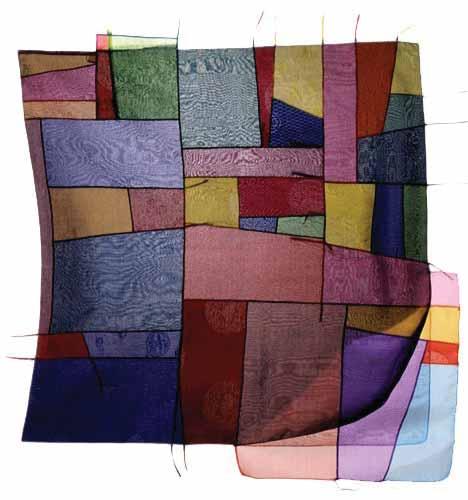
CARRIE JERUZAL is a K-12 Visual Arts Educator at Pentwater Public School in the rural shoreline village of Pentwater, Michigan. She was a past participant in the National Consortium for Teaching About Asia seminar program through Michigan State University and a 2011 fellowship grant recipient in the Korea Academy for Educators. She holds a BA from Hope College and an MEd from Western Michigan University and has participated in study tours of both Japan and China.
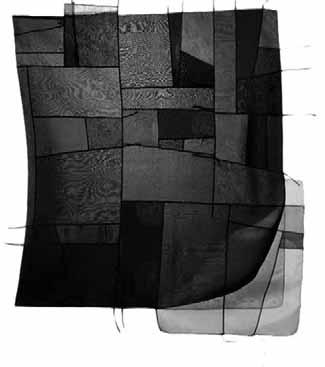
191 194
Contemporary antique Jogakbo (Patchwork). Silk Bojagi example from Bojagi and Beyond by Chunghie Lee on the Surface Design Association blog at http://tiny.cc/fo0e1w.
Chapter 5
Music and the Korean Wave

Korean Traditional Music
Toknow and understand a culture’s music can often be a shortcut tounderstanding the people of that culture. Asian culture is rich in musical traditions, yet the people of Korea have fostered an exceptional interest and passion for music and dance. In fact, the traditions of Korean music have often served as a spiritual and socio-political release for the people throughout its history. Although it is impossible to fully understand the entire scope of Korean music in a short article, a better understanding of Korean culture can be attained by even a brief inspection of its musical arts.And as we strive toward a more global understanding of people, especially in our multicultural United States, an examination of the music of Korea will provide the reader with an understanding of the people and their culture.
Traditional Korean music today is diverse and lively. Compared to many countries who lament the loss of interest in their traditional music, Korean traditional music performers are heard everywhere. The traditional performer’s lifestyle is now more valued, and the variety of musical activities in South Korea is a fascinating subject. In the late-nineteenth century Western music was introduced into Korea, and it became solidly ingrained in the society. Many Koreans aspired tobe Western professional musicians, and music from the West became more respectable than the traditional music of Korea.
This began to change in the mid-1970s, and appreciation for the traditional Korean arts returned. Students began to learn the traditional mask dance (talchum) and farmers’ music (nongak) and became aware that learning traditional music and dance was not a difficult task after all. In 1978, a musician named Kim Duk-soo started a percussion troupe, Samulnori, which revived and internationalized the farmers’ bands of the past and contributed to the world’s appreciation of Korean musical traditions. The revival of traditional music and dance became popular with the younger generation, and its growing popularity opened the door for students to explore more sophisticated traditional music. It is now common to hear the rhythms of gongs and drums of traditional folk music enriching the atmosphere of college campuses throughout Korea and elsewhere.
Prior to the 1990s, pansori music had become no longer popular because of its strenuous vocal projection and extremely raspy timbre, together with its past association with the low social status of the musicians. In 1993, the movie, Sopyonje, directed by Im Kwon-taek, was a huge box office hit in South Korea and became its first internationally recognized film. As a result the general public suddenly became interested in pansori. The enthusiasm for this traditional music form spread widely to young and old, professionals to amateurs, and even to Western classical music devotees.
These developments were also influenced by the emergence of nationalism and the general search for the cultural roots of Korea. The Ministry of Culture and Information and the Korean Culture and Arts Foundation actively supported research, preservation, documentation, and performances of traditional Korean music. The social status of musicians improved along with their financial security. This development isquite rare compared to many other countries in the world (Dongsuk Kim, Asia in Focus: The Koreas, ABC-CLIO, 2009).
197
Leisurely tempo is one of the general characteristics of Korean music. A beat can last as long as three seconds. The slow tempo imparts a distinctly calm, meditative character. The leisurely pace isrelated to an emphasis on breathing: the tempo is set to a cycle of inhaling and exhaling. Western music follows the heartbeat and tends tobe active and progressive. Korean music (especially in jeongak) tends to be sedate and contemplative like a long breath.
Jeongak (court music): intellectual, solemn, calm, dignified, and contemplative.
Ceremonial music (yeollye ak), ancestral shrine music (jongmyo jerye ak), Confucian shrine music (munmyo jerye ak), and vocal music (gagok, gasa, sijo), orchestral music, military music, dance music
Minsok ak (folk music): emotional, unrestrained, direct, and exuberant
Vocal music: minyo, pansori
Instrumental music: sanjo, sinawi
Shaman music: samulnori, pungmul
Buddhist music (bumpae) – Buddhist chant
Korean music conveys a gentle, warm timber. It issogentle that even the collision of tones and melodies results in harmony. The subtle tone color can be attributed to the fact that Korean instruments are made of natural materials, such as wood, bamboo, and silk.
Korean music normally begins with a slow tempo that gradually accelerates as the piece progresses. This pattern reflects the emotional, non-rational character of the Korean people. The gradually increasing tempo leads to self-absorption.
Yoseong – sustained tone and end of the tone it vibrates either one or two notes higher or one or twonotes lower
Tendency to pulling down or pulling up of main tone
Breaking tone
Half note highto lower the same note (A or E)
In sanjo or pansori music, the main tone has strong vibrato and second (4th up) has novibrato and third (5th) starts half a note higher
It imitates expressions of human feelings (crying, sadness, etc.)
Korean music scale is mainly pentatonic scale (D, E, G, A, B)
Basic rhythm tends to be triple rhythm compared to neighboring China and Japan that mainly have double rhythm.
198
Jangdan (beat)patterns: gutgeori 12/8; semachi 9/8 and jajeun mori fast 12/8
There are eight types of materials that are used for Korean instruments: metal, stone, silk, bamboo, gourd, clay, leather, and wood.
Pansori
A musical form of Korea’s past that has experienced a great revival is the dramatic song called pansori. Originating in the folk traditions of the Joseon dynasty, pansori was an epic performed by a single singer accompanied by a percussionist keeping rhythm on a drum and punctuating the singer’s notes with contrapuntal sounds that interact with the emotionality of the vocalist. With seemingly no time constraints, the vocalist engages audiences for hours with a vocal range virtually unsurpassed in the music of any other culture. Pansori is now known internationally as a result of two highly recognized films by the leading filmmaker, Im KwonTaek. The 1993 film, Sopyonje, was the first internationally recognized Korean film and incorporated the hauntingly beautiful sounds of pansori singing. Another example of the pansori genre is the story of a young woman named Chunhyang, one of the most beloved Korean folktales and an ideally suited story for pansori. It is a story of true love, long-suffering virtue, and triumph over evil. In recent times, there have been several opera and film versions, the most recent directed by Im Kwon-Taek and released in the United States in 2000. By far the form of classical music with the broadest appeal in Korea is the opera. In spite of the hardships caused by the Asian economic crisis, operas such as Madame Butterfly reaped a large profit with all performances sold out.
Without question the most famous folk song is Arirang, a lyric sung by a young woman whose lover is about to leave her to cross over the mountains through the Arirang pass. The melody has touched the hearts of many generations of Koreans and continues to strike a chord with those that are still discovering the many textures and dimensions of the Korean culture. Another popular art form from the folk tradition, and one that can be traced back as far as the Silla kingdom, may be found in the mask drama dance which was revived in the late twentieth century. The dramas, which were long, earthy, and satirical, were a way for the rural people to have some fun after long hours of labor in the fields. Visiting the mask drama at the Hahoe Village near Andong in southeastern Korea is highly recommended for all visitors.
Samulnori
For thousands of years Koreans have had to learn ways to live in harmony with nature. They were aware that their hard work in raising crops could only be rewarded with the help of nature and that a man only prospers when living in harmony with heaven and earth. Ancient Chinese sources referred tothe Koreans as “the people who loved singing and dancing.” Singing, playing musical instruments, and dancing were featured not only during communal work for the Korean people, but also were present at New Year’s blessings, the celebration of the completing of planting in springtime, and for the harvest. Even in battles or funerals, music instruments were used.
For centuries children grew up hearing the rhythmic sounds of percussion, a major element in folk music and anintegral part of nongak, or (farmers’ music), a form of rural entertainment
199
performed by touring bands of musicians. Although the traditional music of the aristocratic class (court music) may still be well received, it is the music of the commoner that has experience a revival and international recognition. In 1978, a musician named Kim Duk-soo started a percussion troupe, Samulnori that revived and internationalized the farmers’ bands of the past andhas contributed to the world’s appreciation of Korean musical traditions.
The samulnori form incorporates four percussion instruments: a small gong (kkwaenggwari), a large gong (jing), a barrel drum (buk), and an hourglass-shaped drum (janggu). Koreans feel that the jing and the kkwaenggwari are the sound from heaven and the janggu and buk are the sound from the earth. One might say that when these instruments are played, humans are truly in harmony with nature.


Kkwaenggwari
The loudest Korean percussion instruments, the kkwaenggwari isa disc-like gong made of brass that is 20 centimeters in diameter. These types of instruments are called sogeum when used in royal ceremonial rituals, but similarly-shaped instruments featured in farmers’ or folk music are known as kkwaenggwari. The kkwaenggwari is held with one hand and struck with a wooden mallet and can be played using a variety of grips and techniques. For example, musicians can control the length of each sound by placing their fingers on the gong at varying intervals to cut off the gong’s sound.
Jing
The jing is a large gong that is widely used in farmer, shaman, Buddhist, and military music. It is made using high-quality brass. The jing used in farmers’ music is, on average, 37 centimeters to 38 centimeters in diameter; the one used in court music is slightly larger, while shamans use slightly smaller ones. It is struck with a padded stick for a softer tone. In samulnori, the jing serves to keep the beat. Depending on how hard it is struck, it either gives a gentle, lingering sound or a big, magnificent sound with lots of reverberation.
200
Janggu
The janggu is an hourglass-shaped drum that is widely used in accompaniment with other instruments to produce a strong rhythm section. Its body is made of wood, and the drumheads are made of animal skin. The bukpyeon drumhead on the left side is played with the palm. It is covered with a thicker hide, producing a low tone. The chaepyeon on the right, which is played with a bamboo stick, has a thinner skin for a higher tone. The chaepyeon can be struck in the center of the drumhead or struck close to the rim to create a different sound. The pungmul janggu isa featured instrument in samulnori andisplayed using gunggulchae, a stick with a round end. Buk
Inthe past, a buk was made out of one single piece of wood, but now its body ismade out of two pieces. The skins of this double-headed drum are made of cowhide. There are 20 or so types of buk in Korea, 10 of which are rarel y used. The skins of the drums used in farmers’ band music are attached to each other by lacing leather strings across the body of the drum. Wooden pieces wedged between the body and the strings further tighten the skin, producing varied pitches. The skins of the buk used in pansori however, are nailed down around the body of the drum, making itimpossible to adjust the pitch.
Bibliography: Information on samulnori percussion instruments and images – www.korea.net
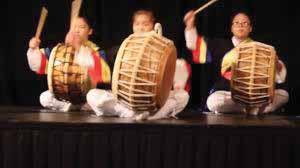

201
Arirang: Korea’s Most Famous Folk Song
Arirang is known throughout the world as the quintessential Korean folk song. Its exemplary status originates from its apparent role in strengthening Korean determination to resist Japanese oppression during colonial occupation (1905-1945). Arirang’s theme of loss resonated with Koreans asa result of their nation’s loss of sovereignty and Japan’s ultimate domination over all aspects of their lives. Arirang’s theme of loss also resonated with the Japanese people. While modernization created more overall wealth for Japan, economic hardship and inequality increased for the lower levels of their society. Modernization also had a ravaging impact on the traditional way of life.
Most scholars believe that the roots of Arirang may be found in folk ballads and work songs dating from the mid-to late Joseon period (1392-1910) or even long before from the Unified Sillaperiod (668-935). Some scholars believe that it is a modern song in response to the significant challenges that Koreans faced over the past two centuries.
While Koreans used the Arirang to defy the rigid and extensive controls of the Japanese government, the song captured the imagination of some of Japan’s most famous composers and popsingers who were impressed with the unforgettable beauty of Korean folk melodies. Recordings, broadcasts, and live performances in both Japanese and Korean dominated the stages and airwaves of both countries throughout the 1930s. Arirang became the most wellknown song in both Korea and Japan.
Japan carefully scrutinized the content of recordings and performances, eventually prohibiting the use of Korean in song and on stage, screen, and the airwaves. Concerned about Korean resistance that arose on phonograph records, Japan required all manufactures and importers to obtain approval for all sound recordings before they went to market along with a system of fines punishing companies, performers, and their families for not observing the law. After 1943, if Korean folk songs were permitted at all, they were to be sung in the “national language,” in other words, in Japanese.
Because of the ties to Korean resistance, Arirang has become truly significant in both Koreas and throughout the Korean diaspora. The song has become one of the most famous and powerful folk songs of courageous defiance considered to be particularly Korean. Ethnic Koreans living abroad assert their identity as Koreans by using the word Arirang in their memoirs and to christen their organizations, events, businesses, and television networks.
In February, 2008, the New York Philharmonic performed a concert in Pyongyang at the invitation of the North Koreans who opened the door tothe largest delegation of Americans to visit the country since the Korean War ended. When the orchestra played the opening notes of the Arirang,tears began forming in the eyes of the somber audience. The North Koreans
202
suddenly stood up, applauded, and waved enthusiastically at the musicians. The exquisitely beautiful sounds of the Arirang touched the hearts of the North Koreans and the enthusiastic response of the audience also deeply moved members of the Philharmonic orchestra.
More than seventy years have passed since liberation, but the Arirang transcends the ideologicaland physical division of the Koreas and the prevalent belief that Koreans constitute a homogeneous race of people who will inevitably be reunited.
(It ishighly recommended that individuals view the New York Philharmonic’s memorable performance in Pyongyang in 2008 on You Tube)
Itisalso recommended that you access BTS’s beautiful version of Arirang on the following link: https://www.youtube.com/watch?v=vwc5zTayVJw
Atkins, Taylor. 2007.“The Dual Career of “Arirang”: The Korean Resistance Anthem that Became a Japanese Pop Hit,” The Journal of Korean Studies, Vol. 66, no. 3 (August): 645-687. Association of Asian Studies Inc.
Connor, Mary. ed. 2009. Asia in Focus: The Koreas. Santa Barbara. ABC-CLIO, LLC.
Demick, Barbara. 2008. “Mutual Standing Ovation inNorth Korea.” Los Angeles Times, February 27.
Ellington, Lucien. 2009. Asia in Focus: Japan. SantaBarbara. ABC-CLIO,LLC.
Waken, Daniel. J. The New York Times. “Welcome Symphonic Diplomacy,” The New York Times,February 27,2008. http:www.nytimes.com/2008/02/27/world/asia/27symphony.htm.
203
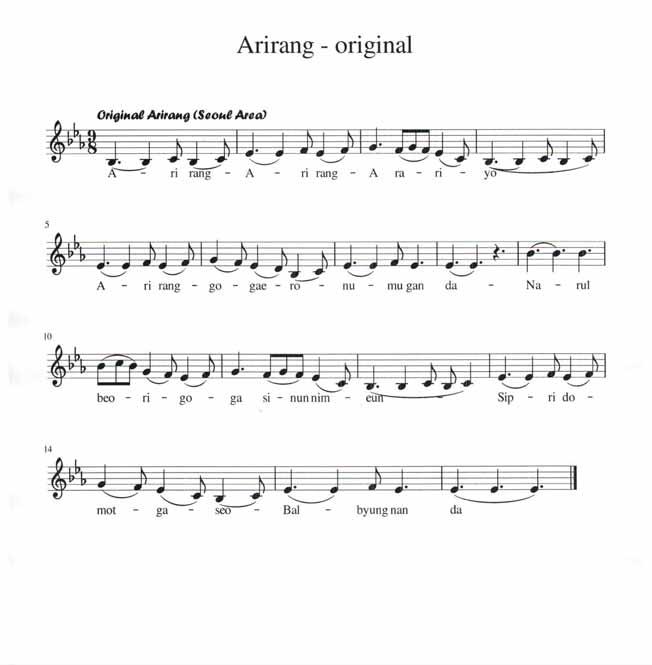
204
Arirang – English Translations
Arirang expresses the strong national sentiment of the Korean people. With a plaintive melody this beautiful song expresses sorrow over loss and the will to endure in spite of every hardship.
English translations vary.
Version One:
Refrain: Arirang Arirang, Arariyo
Arirang Pass is the long road you go
If you leave and forsake me, my own,
Ere three miles you go, lame you’ll have grown.
Wondrous time, happy time let us delay
Till night is over, go not away
Arirang Mount if my Tear-Falling Hill,
So seeking my love, I cannot stay still.
Version Two:
Refrain: Arirang, arirang, arariyo.
Arirang, crossing over the hill,
My dear who has abandoned and left me
Has not even traveled ten miles before having feet pains.
205
Korean Wave: Korean Pop Culture Phenomenon
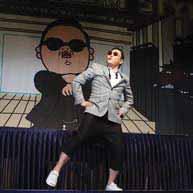
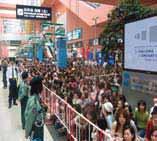
What is the Korean Wave? Why is the Korean pop culture getting very popular not only within Asia, but also in America and Europe? Let’s find out!
The term “Korean Wave” (Hallyu in Korean) was coined by the Chinese press a little more than a decade ago to refer to the popularity of Korean pop culture in China. You may have heard Psy’s Gangnam Style. Because of Gangnam Style, some Dutch people became interested in Korean pop music in 2012. In this chapter, we will examine how the Korean Wave has moved from the edges of global pop culture to the center stage.
4.1 Birth
In July 1997, CCTV, the Chinese public TV, aired the Korean drama, What is Love, throughout the nation, making it the first Korean drama aired in China. What is Love is a family drama about two families – one liberal and one conservative – and their conflicts and solutions. The Chinese audience fell in love with this drama because it reflected a family-oriented way of thinking and featured the modernized life of Koreans, which differed greatly from the Communist lifestyle. As such, What is Love rated second highest among foreign dramas in China. K-Wave bridged the gap of distrust and ignorance that had existed between Korea and China since the Korean War in the 1950’s.
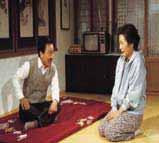
In 2003, the Japanese TV network, NHK, introduced Winter Sonata, a drama about being destined to be with your first love. When the show’s star, Yongjoon Bae, arrived at the Tokyo airport in 2004, more than 5,000 female fans welcomed him. Winter Sonata stirred up feelings of nostalgia and passion among middle-aged female viewers, whose feeling were typically restrained due to Japanese social norms and etiquette.
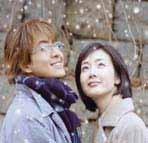 What is LoveWinter SonataSome 5,000 Japanese fans filled an airport to welcome Mr. Bae in 2004
What is LoveWinter SonataSome 5,000 Japanese fans filled an airport to welcome Mr. Bae in 2004
Lesson 4 Psy 206
of K-wave: K-dramas
Another big hit drama, Daejanggeum, aired in July 2003. Based on a true story in the 16th century, this drama told the story of an orphan girl named Janggeum, who overcame her low social class to eventually become the king’s chief physician. In addition to its fascinating plot, Daejanggeum featured beautiful Hanbok (traditional Korean dress), Hanok(house) and the strong Korean belief that foods are medicine. Daejanggeum became very popular all over Asia, including China and Japan, shortly after its release; outside of Asia, its title was Jewel in the Palace It has been aired in over 60 countries all over the world including USA, Australia, India, Israel, Jordan, Peru, Colombia and Kenya.
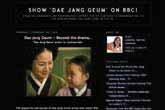
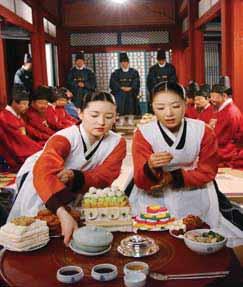

4.2 Leap-off of K-Wave: K-movies and Novels
Korean movie’s domestic market share is more than 50%, much higher than in other countries. Two major currents prevail in mainstream Korean cinema today: the Korean-style blockbuster and the so-called “well-made” film. The first big blockbuster, Shiri (1999), about the unlikely love between two spies from South and North Korea, was so popular that it was followed by a sequel in 2000 called Joint Security Area (2000).
Talented directors and good plotlines have helped well-made Korean films achieve global recognition. One example is Old Boy, which was seen by more than 3 million people in Korea. Chan-wook Park, the director, received grand prix honors at the 57th Cannes Film Festival. Additionally, many foreign companies are re-making Korean movies because of their wellstructured plotlines.
Kyung-sook Shin’s novel Please Look After Mom, which sold over one million copies in Korea, has been published in 22 countries. The book, called A Raw Tribute to the Mysteries of
In the Japanese magazine Daejanggeum
207
In the popular Britisch Blog
Motherhood by the New York Times, received positive reviews from American critics and readers alike. Online booksellers have rated the book highly, commenting that the “stunning, deeply moving story of a family’s search for their mother - told through the piercing voices and urgent perspectives of a daughter, son, husband and mother - is at once an authentic picture of contemporary life in Korea and a universal story of family love.” Because of Kyung-sook Shin, many other Korean writers are hoping to follow her footsteps and reach readers across the globe.
JSA (Joint Security Area)Old Boy
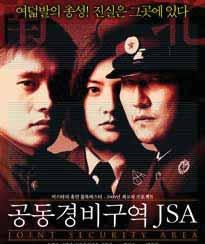
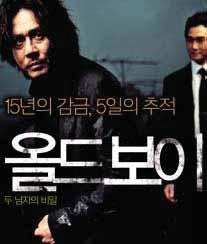
4.3 To the Center of Global Pops: K-pops
Since 2010, K-Wave has expanded beyond Asia through a new communication channel. Using the internet to increase K-Wave’s exposure, especially YouTube, Twitter and Facebook, has allowed for inexpensive and expedited expansion. For example, Big Bang, a Korean boy band, released the song Tonight in Feb. 2011 in Korea, and it ranked No 7 on Billboard Heatseekers and No 3 on the World Album chart only a month after its release.
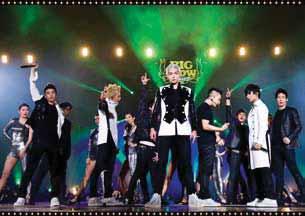 Big Bang
Big Bang
208
Obviously, the world is experiencing a big change in global pop culture, particularly in music. People used to listen to or watch pop songs and dances, but now they got actively involved in their favorite artists’ dances and routines. In addition, it is common for pop fans to have a cyber fan club and share information and news about the artist. When SM TOWN had its first European concert in Paris and 7,000 tickets sold out in 15 minutes, a flash mob with over 300 fans took place in front of the Louvre museum, asking to add one more concert. These fans who came from all over the Europe, including Germany, Italy and England, sang and danced to Korean pop music.
This flash mob caught people’s immediate attention through YouTube, and SM Management, one of the top 3 entertainment companies in Korea, decided to add one more concert. As you can imagine, tickets for the second concert sold out quickly too. This example confirms that K-pop is appealing to people all over the world. You can visit Allkpop.com and Soompi.com for K-pop.
Girls’ GenerationFlash Mob at Louvre Museum for asking for one more date of concert
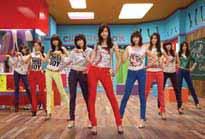
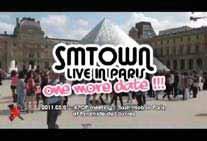
(https://www.youtube.com/watch?v=Y1PyjYNelL)
4.4 What is the future of K-wave?
In Psy’s Gangnam style video, he makes viewers laugh by singing at a public sauna, the Han River, and a subway, all set to an addictive electronic rhythm. Just like Psy, Korean pop created its own culture from the best of western music. Furthermore, the re-created product is communicated with the world through a variety of online media. Now, Korea is moving forward into a new era. It has truly moved from the margins to the center of the global culture. Korea is now a nation known just as much for its culture as it is for its economic growth and full democracy.
It is interesting to note that the simple enjoyment of dramas, pop music and film has been transformed into a strong preference for other Korean products like electronics, mobile phones, cars, fashion, cosmetics and food, not to mention Korean lifestyles. This growing interest in Korean culture has further triggered a drastic increase in foreign tourists visiting the country. More and more people across the globe are learning the Korean language, leading many universities to open Korean language courses to help people better enjoy the Korean culture. For example, several universities in The Netherlands offers courses for Korean language and studies.
209
Review Lesson 4
Which country’s media first came up with the term “K-Wave”?
Japan
China
Thailand
What Korean drama was the first to be aired in China?
Daejanggeum
What is Love
Shiri
Which of the following statements is false, regarding the reasons of the popularity of Korean soap dramas?
Big production cost and there were many spectacular scenes Family-oriented warm hearted topics General topics like love
Which of the following statements is false, regarding why K-pop became so popular?
Promotion through internet Plot focused on traditional Korean values Cover dance
What is Korean movie’s market share in Korea?
More than 50% About 40%
About 30%
Which of the followings is not a Korean-style blockbuster movie?
Old boy
Shiri
Joint Security Area
1.
2.
3.
4.
5.
6.
210
A story about Korea: Psy’s Gangnam Style
What is the Gangnam in Psy’s Gangnam Style? It is the name of an area in Seoul. Gangnam literally means ‘south of river”. In the past, royal families and Yangban, the upper class people lived north of the Han river, while most farmers lived in the southern part of the river in Seoul. In the beginning of Korea’s industrialization in the 1970’s, many people migrated to Seoul for their jobs, but they didn’t have enough space to live in. Thus, Gangnam was designated as a new development area. Now, it is the most active economic district in Korea, with many high rise commercial buildings, hotels, department stores and even an amusement park. It is also called “Beverly Hills in Korea”, and it represents the most affluent society of South Korea.
Do you want to learn how to dance Gangnam Style? (http://visual.ly/gangnam-style-5-basic-steps )
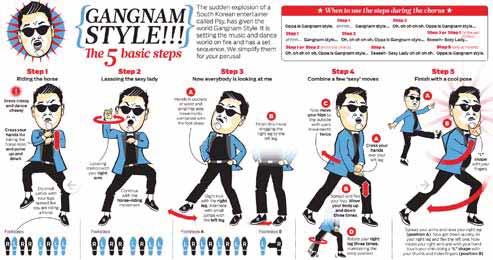
211
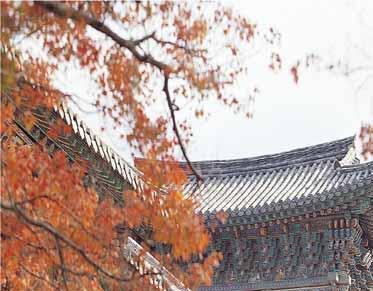
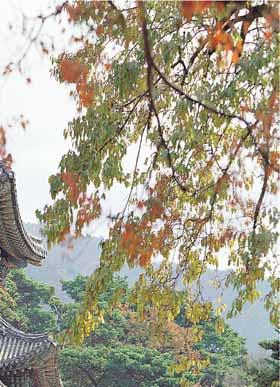
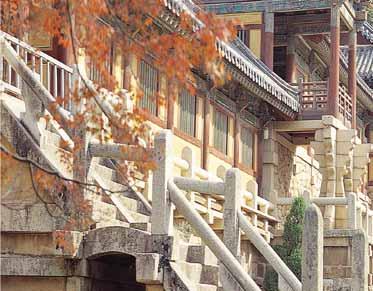
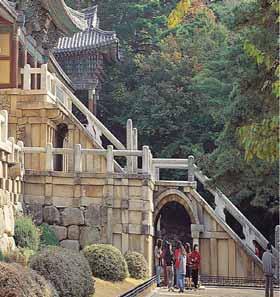
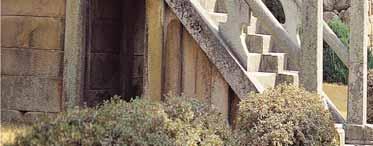


6 215 219 219
RESOURCES BOOK REVIEWS
Korean Spirituality
BY DON BAKER
UNIVERSITYOF HAWAI ` I PRESS, 2008
151 PAGES
ISBN: 978-0-8248-3257-5, PAPERBACK
Reviewed
by Mary
E. Connor
Korean Spirituality by Don Baker, a professor at the University of British Columbia, is an accessible and engaging guidebook to the distinctive religious and philosophical belief systems on the Korean peninsula. Its value is manifold. Because Korea has one of the most vibrant and diverse religious cultures of any nation in the world, lucid exposure to its beliefs and practices provides a model of how adherents of diverse faiths can get along harmoniously. An examination of Korean spirituality illustrates how differing religions can inspire and even modify one another when there is tolerance among the faithful. Korean Spirituality also helps us deepen our understanding not only of the Koreas, but also of the Koreans who live in the United States.
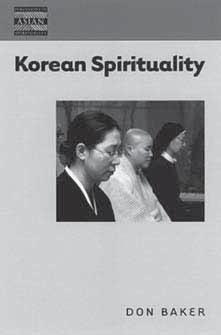
Don Baker defines spirituality as “attitudes and actions grounded in the belief that there are invisible forces more powerful than we are, and that through interaction with those forces we can better ourselves or make our lives more pleasant or meaningful” (5). He assert s that South Korea provides a foundation for studying modern spirituality because of the number and variety of religious and spiritual or philosophical beliefs that the people draw on to address the challenges of life. The many buildings for religious rituals, which have increased 500 percent since 1960, offer architectural evidence that the people of South Korea are highly religious. Yet even with thi s growing religious fervor, only slightly more than half of the population professes a specific religious
orientation (3). South Korea could be the only country with an ethnically homogeneous population in which the Buddhists and Christians are close to being equal in number. South Korea may also be the only industrialized nation where folk religion continues to exist and remains independent of any institutional control. Even those who considered themselves good Christians are still influenced by a folk tradition that is deeply embedded in the culture. In spite of differing beliefs and religious practices, these Koreans assume that they have to align themselves with some power greater than their own in order to overcome the limitations that they face as individual human beings. This assumpt ion unites their approach to spirituality.
This book surveys folk religion and animism, Confucianism, Buddhism, Daoism, Christianity, and what he calls the new religions, such as Wŏn Buddhism Baker analyzes the roles that religions have played in the past, identifies their commonalties, and explains how traditional Korean spirituality was primarily based on ritual and concerned with ethics. What p eople did was more important than what they believed, and their rituals emphasized the group, such as the family or the village. He notes that with Christianity, doctrine is emphasized and that the people enter “a personal relationship with that God above the individual’s relationship with his or her family, neighbors, or government” (62). In the final section of Korean Spirituality,the author examines spirituality in North Korea and how it is grounded in the political ideology of juche the only form of spirituality available to the overwhelming majority of North Koreans.
MARY E. CONNOR taught United States History and Asian Studies for thirty-five years and now serves as President and Program Director of the Korea Academy for Educators, a nonprofit organization that informs educators about Korean history and culture and the Korean-American experience. She is the author of Asia in Focus: The Koreas (2009) and the recipient of the Peace Corps Association’s Global Educator Award and the Organization of American Historians Tachau Award.
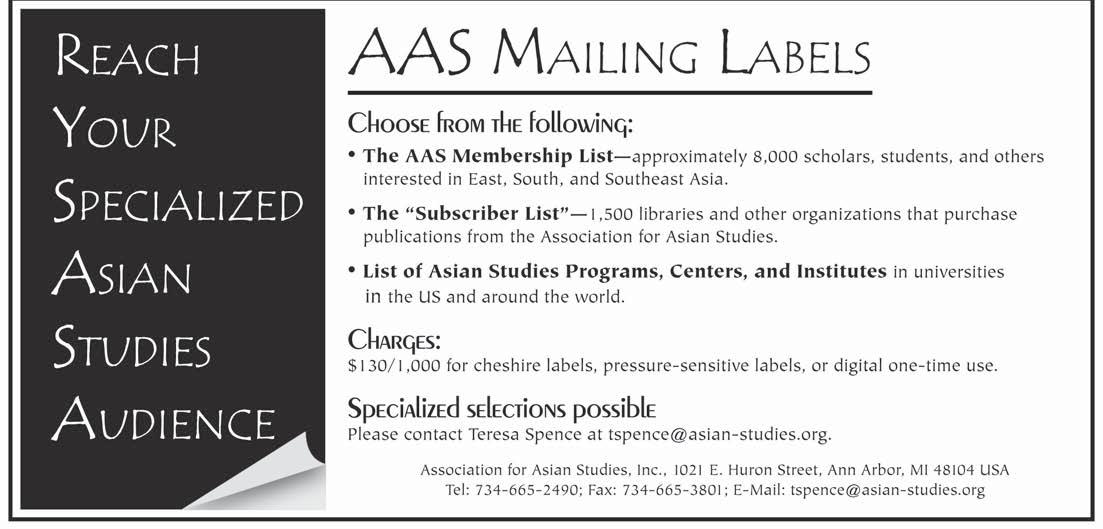
70 EDUCATION ABOUT ASIA Volume 16, Number 1Spring 2011
215
Four main religious and philosophical influences have shaped Korean culture. Shamanism influenced the spiritual life of the early Korean people. Confucianism came from China during the Three Kingdoms period (57 B.C.E. - 668 C.E.). Buddhism arrived on the Korean peninsula during the fourth century C.E. and Christianity first entered Korea from China in the eighteenth century.
Until the end of World War II in 1945 there was little difference between religious beliefs and practices on the Korean peninsula. As a result of the division of the Korean peninsula after the war, more is known about religion and thought in South Korea. Less is known about North Korea as it is one of the most isolated countries in the world.
In many countries modernization has lessened formal religious affiliation; however in South Korean this is not the case. Despite rapid change and modernization, religion has become one of the most significant developments in recent history. Since 1945, there has been sustained and rapid growth of Buddhist and Christian communities along with the continued influence of shamanism, Daoism and Confucian beliefs.
In North Korea the situation is very different. With the division of the peninsula and the creation of the Communist People’s Democratic Republic of Korea (DPRK), the Communist government created an ideology of juche (“self reliance”), Marxism, and Neo-Confucianism that suppressed nearly all religious activity. The belief in the infallibility and goodness of Kim Il Sung is everywhere: city streets, monumental buildings, statues, walls of public building, billboards, and badges that are a required component of everyone’s clothing.
The contrasting belief systems of North and South Korean make the peninsula one of the most interesting and contrasting places in the world in terms of religion, thought, and the quality of life. While the Korean people have hoped for reunification, the differing believes between the Koreas make reunification virtually impossible.
Aside from the very evident contrasts of thought, South Korea itself is one of the most religiously diverse countries in the world. Daoism, Shamanism, Buddhism, and Confucianism coexist with one another. Christians are somewhat of an exception. It is easy for foreigners to witness this religious diversity by simply walking the streets of Korea’s cities and towns. They will see Confucian shrines, Buddhist temples, and Christian churches side by side. Signs of shamanism also exist everywhere: homes, offices, apartment buildings, and store fronts that make known that a fortune-teller or shaman is inside. In America religious diversity reflects ethnic diversity, but religious pluralism in South Korea exists in a country that has been one of the most ethnically homogeneous place on earth. Unlike in the United States, where “In God We Trust” is on the currency,South Korea has no civic religion.
Many Koreans became Christians during Japanese occupation (1910 -1945) as Christianity gave them hope. Before the Korean War (1950-1953), two thirds of the country’s Christians lived in the North, but most fled to the South as they could not practice their faith. Since the end of the Korean War, the number of Christians increased significantly. From 1964 to
216
1994, the religious population jumped six fold, while the total population expanded about one and one half times. Some of the reasons for this rapid growth are attributed to the painful legacy of Japanese colonial rule, the Korean War, and the sense of isolation arising from rapid industrialization and urbanization. Churches became a haven for refugees from the North and new urban dwellers who sought community and comfort. Churches in the United States do the same, providing a sense of community and refuge for the Korean immigrant.
According to the 2015 national census, 56.1 percent of the South Korean population has no religious association. Of those associated with a religion, 15.5 percent are Buddhist, 19.7 percent are Protestant, and 7.9 percent are Catholic.
Many of those who are unaffiliated with a religion have probabl y consulted shamans, visited a Buddhist temple, a Christian church or Confucian shrine. Religious pluralism may also be seen in practices relating to the life cycle: there are shamanist and Buddhist practices connected to pregnancy and childbirth, Confucian and Christian rituals in weddings, and Buddhist practices during funerals and ancestor memorial services.
The three major religious organizations (Protestant, Catholic, and Buddhist) support nationally broadcast cable television and radio networks. The Buddhist television network was the first of its kind in the world. Religious organizations publish more than 200 magazines and periodicals, and operate daily newspapers of their own. In addition to managing numerous primary and secondary schools, more than one out of every five colleges and universities in Korea has a religious affiliation. These groups also own land, hospitals, publishing houses, and prayer and rehabilitation centers.
Shamanism is considered to be Korea’s oldest religion. It encompasses a variety of beliefs and practices that have been influenced by Buddhism and Daoism, and may include prayer, worship, and rituals that are considered signs of religious faith. Many of the gods who appear in shaman rituals are borrowed from Buddhism. Shamanist rock formations signifying wishes for good health and prosperity may regularly be seen adjacent to Buddhist temple structures.
Although shamanism never developed a theological system, it never showed any hostility towards foreign religions that came to the peninsula; it mingled freely with them. For centuries the shamans were considered at the top of the social structure. Koreans have worshipped many gods, such as the village god, the house master god, the fire god, the house site god, and the god of wealth. In the past, shamanistic rites included agricultural rites, such as prayers for an abundant harvest. With a shift away from agriculture, this has been largely lost. Since Koreans have moved from small rural villages to modern cities, most have left their household gods and rituals behind.
Although the overwhelming majority of South Koreans who profess a religion consider themselves either Buddhists or Christians, many still turn to the old folk traditions of shamanism. In fact, shamanism is thriving in Korea today. There are approximately 300,000 shamans, or one for every 160 South Koreans. When the Internet boom hit South Korea, shamans were among the first to set up their own websites and offered online fortune-telling. Seeing a psychologist may be considered a sign of serious mental weakness in South Korea, but it is perfectly acceptable to visit a fortune-teller.
Through the shaman’s intercession, Koreans are able to appeal to spirits in the hopes they will solve their problems or bring good luck. Shamanistic rituals are also regularly employed for
217
starting a new business or dedicating a new building. Shamans can also use fortune-telling by reading the words of the spirits by throwing coins or grains of rice. In the past, Shamans practiced elaborate rituals, but they now sit in offices and offer advice to their customers based on their interpretation of signs from the spirit world. It is possible for a shaman to make a good living.
Another ancient religion, Daoism has influenced Korean thought for centuries. Daoism provides a way to live one’s life. One is to live in harmony with the Dao, the guiding force of reality. The Dao gave birth to the universe and all things in it. Important principles are inaction, simplicity in living, and being in harmony with nature. The basic principles of Daoism rest in the belief in the law of unity of two opposite forces, the yin and yang. Followers of Daoism practice meditation, ritual, martial arts, life nourishment through proper diet, qigong (integrating posture with breathing techniques), and living in harmony with the seasons.
Daoism was imported from China and by the late fourth century and was influential from the fourth century until the Joseon dynasty (1392- 1910) when Neo-Confucianism scholars attempted to eradicate Daoism. They failed in their efforts as the beliefs associated with Daoism were so pervasive in religion, popular beliefs, art, politics, and folklore that even the scholars continued to be influenced by Daoism without realizing it.
Daoism continues to influence the Korean people, such as their love for nature. It is also apparent in their search for blessings and longevity. Everyday articles are decorated with symbols of prosperity and long life. The names of many mountains and valleys throughout the country indicate a strong influence of this religion. The influence of Daoism is most visible on the national flag with its yin/yang blue and red symbol representing the dualism of the universe.
Buddhism, arrived on the peninsula in the fourth century, flourished throughout the Three Kingdoms period (57 B.C.E.–668 C.E.), became the state religion during the Goryeo dynasty (918–1392), but was repressed during the Joseon dynasty (1392–1910). Its spectacular revival is a major development in modern Korean history. Approximately eleven million South Koreans are Buddhists.
When Buddhism entered during the Three Kingdoms period, it was introduced to the ruling class by monks from China and India who thought that Buddhism had a greater capacity to heal diseases than the gods of folk religion. They also believed that their kingdom would be protected if they practiced Buddhism. Within a few centuries Buddhism became the dominant religion of the people. Over time elements of Buddhism blended together with Daoism, Confucianism, and shamanism.
Korean Buddhism, like that of China and Japan, is mainly of the Mahayana (Great Vehicle) school, emphasizing the attainment of eternity through faith. The idea of the Great Vehicle suggests a large ferryboat in which all types of people can be carried across a river to achieve enlightenment. Mahayana emphasizes that nirvana is not only attainable by monks but is also
218
possible for everyone. Mahayana also stresses that enlightenment is a call to compassion. In order to be saved, one must save others.
The historical Buddha Sakyamuni taught that all living beings will suffer throughout their lives. The attainment of nirvana, or deliverance from life’s suffering, may be found by rejecting earthly desires, through many reincarnations, followed by enlightenment. The three main foundations of the Buddhist faith are the Buddha himself, his teaching, and the community of monks whose conduct is guided by an Eightfold Path – a daily guide for righteous living and right thinking. Ordinary people are expected to be considerate and selfless toward others and to improve themselves according to the standards of righteous life, but cannot expect to attain nirvana within their lifetime. Salvation is an individual matter, and the emphasis is on withdrawal more than on social action. This does not mean that Buddhism has no social conscience; love and charity toward all living things is a dominant part of the belief system.
Mahayana Buddhism derives from the same East Asian tradition out of which Japanese Zen was born. In Korea, this belief is called Son. One first studies the sutras and commentaries to comprehend the doctrine. Once this is accomplished, the Son Buddhist will seek to go beyond intellectual understanding through meditation. The goal is the abandonment of human attachments and the concentration of one’s mind and thought in order to experience the Buddhanature that is inherent in all things. In addition to the importance of understanding doctrine and practicing meditation, Mahayana Buddhism focuses on compassion. There are a large number of Buddhas and bodhisattvas (“enlightenment being”) who, out of compassion, offer help to those who are suffering.
Some of the most well known Buddhas in Korea are the Sakyamuni (the historical Buddha Gautama), Amitabha (the Buddha who helps the believer to be reborn in Western Paradise and achieve enlightenment), Maitreya (the Buddha of the future who helps believers to achieve health, wealth and longevity for themselves and their family and who promises that a Buddhist paradise will ultimately be established on earth), and Kwanum (the goddess of compassion who is available to help solve problems anyone might face).
In Mahayana, wisdom remains an important objective, but the combination of wisdom and compassion is central to its teaching. The term for compassion is karuna, which may also be translated as “empathy,” or “sympathy.” For the Mahayana Buddhist karuna implies that we are all part of an ever-changing universe. Individuals are all the same. To be kind to others is actually being kind to oneself. All living beings, including animals, are interrelated and one must be kind towards all living things. The bodhisattva, the enlightened one, will not enter nirvana in order to remain on earth to help others until all are enlightened.
Until very recently the majority of Koreans were Buddhist. Because of the continuous influence of the West combined with the fact that the presidents of South Korea were Christian led to a temporary decline in the followers of Buddhism. Also, young people and those who wanted to be more modern were inclined to join Christian churches. During the 1960s and 1970s the South Korean government supported the reconstruction of historic sites including many Buddhist temples. Many people began to reclaim the faith as something to honor and revere as opposed to something that was old fashioned. As a result, membership in Buddhist congregations grew and is just about equal to that of Christian churches. Mountain monasteries still flourish today and are frequently visited by pilgrims and tourists in search of a traditional Buddhist experience. Urban temples offer Sunday morning services in addition to traditional rituals. Monks in some sects are permitted to marry. Buddha’s birthday is a national holiday that includes parades, the lighting of lanterns, ritual, and festivities.
219
Buddhists recently became more involved in politics and society. After the tragedy in Kwangju, an incident in which government troops killed hundreds of pro-democracy demonstrators in 1980, Buddhists adopted an activist role and were known to be vocal about issues of poverty and justice. For the first time in modern history Buddhist monks could be seen demonstrating in the streets for democratic reforms. Buddhists have also opened meditation halls in condominium complexes and office buildings to provide a place for urban followers to meet, meditate, and discuss Buddhist teachings.
Urban lay Buddhists have also modernized their music. They sing the words of their traditional rituals to well-known Christian hymns. In 1972 a Buddhist Bible was published. This Bible incorporates the most important and popular sections of the immense canon in a book of a few hundred pages. Buddhists may be seen reading their Bible on subways and buses as Christians do.
There are approximately 39 Buddhist orders. Congregations are involved in charitable activities, education, and missionary work. There are more than 11,000 temples, over 26,000 monks, and Buddhist-run media outlets, including television programs, radio networks, and newspapers. The most famous Buddhist temples – such as Bulguksa and Haeinsa – are beautifully maintained and tourists flock to these sites. It is common to see jolly young monks, with closely-shaven heads and garbed in gray robes, laughing and enjoying the companionship of their associates in the streets and restaurants of Seoul.
In spite of the fact that Korea is a country steeped in ancient beliefs, Christianity has become the dominant religion. In 1900, only 1%of the population in Korea was Christian, but through missionary and church efforts, Christianity has grown rapidly. In 2014, Pew Research reported that more South Koreans are now Christian (29 %) than Buddhist (23 %). Approximately 12 million are Protestant (primarily Presbyterian, Methodist, Baptist and Pentecostal) and 5 million are Catholic. The Pew Research report also revealed that approximately 46 % of the population does not have a religious affiliation. Since the introduction of Catholic worship in the eighteenth century and the coming of Protestant missionaries in the late nineteenth century, the influence of Christianity is now evident everywhere. Women have been central to its growth. Until Christianity arrived, most people did not think of themselves as Buddhists rather than Confucians, or of Buddhism and shamanism as being mutually exclusive. It has been primarily in response to people claiming to be Christian that others have taken religious labels for themselves. Protestants and Catholics appear to be among the most religious in terms of frequency of church attendance, praying, and scripture reading.
Catholicism came to Korea in 1784 by a Korean Confucian scholar who had been baptized by a French priest. He quickly converted other Confucian scholars to the new religion. In time the growth of Catholicism became a problem. Authorities in Rome said that Catholics could not perform Confucian rituals because ancestor worship was a form of idolatry. When one of the converts refused to perform a Confucian mourning rite in the prescribed manner, he was sentenced to death and became Korea’s first Christian martyr.
Catholics refused to comply with the state supported belief in ancestor worship and performed the Catholic mass without official permission. This new faith challenged not only the
220
authority of the king, but also ideas that were at the core of Confucianism and hundreds of years of tradition. By the end of the 19th century, thousands of Catholics were executed. The effort to extinguish Catholicism was the first significant act of religious persecution in all of Korean history. When Pope John Paul II visited Korea in 1984, 93 of the Korean martyrs were canonized for their piety. As a result of the Pope’s visit, citizens could boast that South Korea had more officially recognized Catholic saints than any other nation outside of Western Europe. In 2014, the visible high point of Pope Francis’s visit to South Korea was the beatification of 124 Korean martyrs. An estimated one million people packed the mile-long route from Seoul's City Hall to the plaza before Gyeongbokgung, a royal palace dating from the 18th- and 19th-century era of the martyrs.
The first Protestant missionaries in Korea were American and arrived in 1884 at a time when religious persecution was coming to an end. They emphasized the mass circulation of the Bible which had been translated into Korean and established the first modern educational institutions in Korea. Horace Allen (1858–1932) a physician-missionary attached to the U.S. legation, contributed to the acceptance of the missionaries by saving the life of Prince Min after an attempted coup d’état. Allen opened the first hospital in Seoul in 1885. Protestant missionaries were allowed to proselytize and operate freely because the government felt their activities were helping the country to modernize. In 1898, in response to pressures from the West, the government acknowledged freedom of religion.
Protestantism expanded rapidly for four main reasons. First, Protestant services were conducted in Korean and not Latin as in the Catholic Church. Second, worship in the Korean Protestant church is congregational, allowing for active participation on the part of lay people. Third, the Christian belief in the essential equality of all human beings is a revolutionary and appealing notion. And fourth, the nation was rapidly losing its independence to Japanese imperialism. As a result, many Christians became involved in nationalistic, anti-Japanese politics, such as the March First Movement and demonstrated against the demands that they honor the emperor and the gods of Imperial Japan at Shinto shrines.
During the occupation (1910-1945), Christianity gathered strength and support from patriots who used church institutions as havens from Japanese oppression. When Korea was liberated and divided into a communist-controlled North and an anticommunist South, more than one out of three Catholics and three out of every five Protestants lived north of the 38th parallel; as a result, many Christians fled to the South.
After the Korean War churches grew rapidly. Since the early 1960s, when there were fewer than a million Protestants in South Korea, their number has more than doubled every decade. One of the reasons for the spectacular growth is based on the fact that the Korean Protestant community was determined to save as many souls as it could in the shortest amount of time possible. Presently, Protestant Christians make up a larger percentage of the population in South Korea than in any other Asian country. Korea is also the most Christianized non-Western country in the world, with the exception of the Philippines. Tens of thousands of churches with their red neon lights illuminate the urban landscape at night.
In addition to the rapid growth has come division. The idea that people with similar religious beliefs should create their own churches has led to the significant growth of Protestant denominations. Many of the larger denominations have splintered off into sub-denominations, such as the Presbyterian Church which has more than fifty sub-denominations on the peninsula.
In spite of the development of diversity of churches, there are commonalities within Korean Protestant churches. Nearly all Korean churches are fundamentalist and evangelical. In a break
221
from tradition, Korean Protestants are much more text and doctrine-based than their nonChristian ancestors tended to be. Through followers of other religions in Korea – even Roman Catholics – have no reservations about visiting a Buddhist temple; however, devout Protestants stay away because they believe they will give the appearance of tolerating what they believe are false teachings. Protestant churches also demand more of their congregations because church attendance is expected not only on Sunday, but during the week. Members are also expected to contribute 10% of their income or more to their church.
In the past many people would have turned to shamanism in hopes of becoming rich or living a long life. Today, instead, they turn to Christianity as a more appropriate, effective, and modern means to the same end. It is a well-known fact that the followers of shamanism and large numbers of Buddhists and Christians have faith in the belief that Buddha, God, or spirits can grant them earthly wishes, such as health and wealth.
This earthly tendency of many Buddhists and Christians, especially Protestants, is also reflected in the way they associate the offering with secular blessings. Buddhists give their offerings together with a list of prayer items to the temple. Both Catholics and Protestants contribute money to their churches whenever good fortune occurs, such as the birth of a son or when sons or daughters pass the university examination.
The growth of Korean churches in the United States has been spectacular. While 29% of Koreans in Korea are Christian, 71% of the Koreans in the U.S. are Christian, 6% are Buddhist, and 23% are unaffiliated. According to Pew Research statistics, 61% are Protestants and 10% are Catholic. An association of Korean Protestant churches in Southern California has 1,359 congregations representing 39 denominations. In 2008, a study determined that of the 7,000 Protestant Asian congregations in the United States, 4,000 were Korean. Nearly 80% of Korean immigrants attend church. By comparison, a Pew Research study found that 54% of Americans went to church weekly, more than once a week or a few times a month. The rest attended church once in a while or not at all.
Korean churches in the United States have worked to provide a familiar, safe, and supportive place for an immigrant population. This most likely explains why a higher percentage of Korean Americans attend churches on a regular basis than do their counterparts who live in Korea. Apart from their religious and evangelical programs, they try to address numerous challenges facing their membership, such as health, legal, and psychosocial issues. Anselm K. Min, Maguire Distinguished Professor of Religion at Claremont Graduate University, said that “the local church is thecenter of fellowship, comfort, and consolation.” Min believes that “Christianity appeals to Koreans because it demands unconditional commitment which blends well with the Korean work ethic and emphasis on achievement.”
The Reverend Hee-Min Park, a highly regarded pastor who has served in Los Angeles and Toronto, believes that the growth of the immigrant churches is the result of the huge influx of Koreans since the 1970s, the growth of Korean seminaries and the tendency for congregations to split when they run into disagreements. He believes that “the strong points of the Korean church are passion, prayer, and evangelism.”
222
Immigrants from Asia brought Buddhism to the United States in the 19th century. People of Asian descent still comprise the vast majority of American Buddhists. About half (54%) of the Asian Americans who were raised Buddhist are still Buddhist; however, 42% of all Asian Americans are Christian, 26% are unaffiliated, and 14 % are Buddhist. Pew Research reports that 71% of Koreans are Christian and 6% are Buddhist. Approximately five million Americans today identify as Buddhist.
As a result of the Immigration Act of 1965, immigration laws changed significantly and many more Asians immigrated to the United States. They brought their ancestral worship patterns, including Buddhist practices of Chinese, Japanese, Korean and Vietnamese traditions.Immigrant Buddhists perceive their religious observances as rooted in family traditions and spiritual connections with ancestors. Services in their temples are often in their native language. Recently, scholarly attention has been focused on what has been called “white Buddhism,” or those Americans of European ancestry who have embraced its tenets.
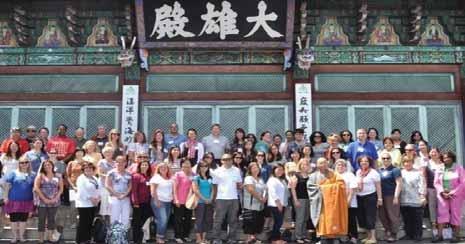
An estimated quarter of American Buddhists are considered “converts” from traditional Christianity, Judaism, or secularist philosophies. Researchers often see a distinct difference between immigrant Buddhism and those who have embraced its tenets as individuals seeking spiritual enlightenment. Converts to Buddhism are attracted largely by meditation practices.
The racial reckoning by Black Lives Matter, the murder of George Floyd, and the growing anti-American racism during the pandemic have led many of the younger generation of Asian American Buddhists to challenge the white-dominant narrative of Buddhism. As Asian Americans they want to unite and have a strong ethnic identity as well as a religious identity. Meanwhile, Asian American Buddhist leaders are responding to the violence against Asians by offering support by drawing lessons from their history and religion to inspire resilience against racism in their communities. Numerous temples have also been vandalized.
223
Baker, Don. 2007. “Introduction,” in Religions of Korea in Practice.
Buswell, Robert. E., Jr., ed., Princeton: Princeton University Press.
Choe, Sang-Hun. 2007. “Shamanism Enjoys Revival in Techno-Savvy South Korea, in The Korean Wave as Viewed through the Pages of the New York Times in 2007. New York: Korean Cultural Service.
Clark, Donald N. 2000. Culture and Customs of Korea. Westport, CT: Greenwood Press. Connor, Mary E. 2009. Editor. Asia in Focus: The Koreas. Santa Barbara, CA: ABC-CLIO Publishers.
Kang, K. Connie, “Asian American pastors minister across culture gap,” Los Angeles Times, September 29, 2007, California section B2.
Kim, Eungi. 2003. “Religion in Contemporary Korea: Change and Continuity,” in Korea Focus (July/August). Seoul: Korea Foundation.
Los Angeles Times
Molloy, Michael. 2005. Experiencing the World’s Religions: Tradition, Challenge, and Change. Boston: McGraw Hill.
Netburn, Deborah, “Buddhists lean on faith, history to counter hate: Temples inspire resilience amid a way of violence,” Los Angeles Times, March 19, 2022. California section B2.
Seth, Michael J. 2016. A Concise History of Korea: From Antiquity to the Present . Lanham, MD.: Rowland and Littlefield Publishing Group.
The Pew Forum on Religion and Public Issues, “South Korea’s Religious Demographic Profile,” http://pewforum.org/world-affairs/countries/?CountryID=194 (cited 10/2/07).
The Pew Research Center, https://www.pewforum.org/religious-landscape-study/religioustradition/buddhist/ (cited 3/24/2022)
The NBCNews.com, https://www.nbcnews.com/news/asian-america/young-asian-americanbuddhists-are-reclaiming-narrative-decades-white-rcna1236 (the younger generation)
The Pew Research Center, https://www.pewresearch.org/social-trends/2012/06/19 (Asian Americans and religion)
The Young Buddhist Editorial, https://www.youngbuddhisteditorial.com (cited 3/24/2022)
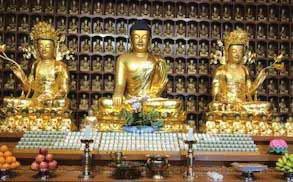
224
United States history textbooks inevitably provide information on the Enlightenment philosophers and their impact on the American Revolution and the adoption of the Constitution. However, most Americans are unaware of the fact that Confucius had some influence on political thinking in the late 18 th and early 19th centuries. There is a sculpture of Confucius along with Moses and Solon on the east entrance to the Supreme Court building. The sculpture may reflect the impact of Confucian thought on prominent leaders during the Revolutionary War era and the Young Republic.
In the years preceding the American Revolution, numerous prominent Americans, most notably Benjamin Franklin, spread Confucian ideas. It is believed that Franklin read The Morals of Confucius as early ashis 1724-1726 stay in London. Since his autobiography ultimately focused on the cultivation of personal virtue, he may well have been influenced by Confucius in his approach. Confucius designed the path for virtuous perfection – from oneself to one’s family, to the state, and then to the whole of China. In 1737, Franklin introduced this notion to the colonists when he published some excerpts adopted from The Moral of Confucius in his Pennsylvania Gazette.
Franklin agreed with Confucius that a man should not only cultivate personal virtues, but also publicize them to others, including political leaders. In a 1749 letter to George Whitefield, one of the most influential of all colonial clergy, Franklin believed wrote that knowledge of Confucian ideas could even foster social harmony.
Confucius yearned to see people, especially rulers, adopt better morals and more compassion. For him, virtue was the foundation of a good and flourishing empire. Confucius asserted that rulers should behave appropriately because they would definitely be imitated. During the Revolutionary War, Franklin promoted this important principle. Confucius believed that law and punishment were the minimum requirements for order, but social harmony could only be achieved by virtuous behavior. Most of Franklin’s advice in Poor Richard’s Almanac stresses virtuessuch as hard work, frugality, and attention to family.
Many of Franklin’s contemporaries were also influenced by Co nfucian thought. Thomas Jefferson believed that Confucianism served as a guide for exemplary leadership. Thomas Paine wrote “that Confucius like Christ was a great moral teacher.” Benjamin Rush “declared that he had rather see the opinions of Confucius ‘inculcated upon our youth than see them grow up wholly devoid of a system of religious principles.’” John Adams, in a letter to Thomas Jefferson, “criticized the English theologian Joseph Priestly for ignoring Confucius in his writing, even though Adams thought Christ the greater moral teacher.” James Madison, the father of the United States Constitution, even hung a portrait of Confucius in his home.
Education About Asia,
225
Korea and Confucianism

Dosan Seowon Confucian Academy
Subjects: Asian Studies, Cultural Studies, World History
Grade Levels: 6, 7, and 10
Time Required: Two to three class periods are recommended.
Instructional Objectives:At the conclusion of this lesson students will be able to:
1) understand the core beliefs associated with Confucianism and its impact on relationships, government, rituals, ethics, education and society
2) be aware of the impact of Confucianism on East Asia in general and Korea in particular
3) realize that Western culture emphasizes the individual, Korea the group
4) appreciate that Confucian views continue to influence Asians throughout the world and in your school
Background for the Lesson:
Confucius (also known as Kongfuzi) was born in 551 B.C. at a time when China was not a large empire, but a collection of small kingdoms that were in constant war with one another. Confucius believed that it was possible to end the chaos by establishing a system based on virtue and harmonious relations. As a result of his efforts, Confucius became the founder of a philosophical, moral, and ethical system that has lasted for 2,500 years. The Confucian philosophy particularly influenced China, Japan, Korea, and Vietnam.
Confucius thought that people could be molded and elevated by education and examples of virtuous people, starting within the family and extending to the ruler who was to be
226
honest and devoted to the welfare of the people. He believed he could create a harmonious society by developing ethical standards and principals for government, society, and family relationships.
Confucius decided that society would function properly only if virtues were taught and lived. He wanted to produce outstanding individuals who would serve in government. Those who aspired for positions in the government had to devote themselves to years of study to insure they would have the knowledge, integrity and right values to qualify for public service. For Confucius, this also meant more than knowledge; it also involved the development of skills in poetry, music, artistic appreciation, manners and religious ritual. Confucius valued education because it transmitted the lessons of the past into the present. Convinced that the past provides good models for the present, Confucius thought that education could show the way to wise and happy living.
Confucius believed that social harmony could be established when people would perform their social roles properly. The primary emphasis was laid on hierarchical norms, and social order would start in the home. The young are taught to respect their elders, children their parents, wives their husbands, daughters-in-law their mothers-in-law. Students must respect their teachers and when at work employees are to respect their employers. Friends are to respect their friends and to be loyal. Each family member must be committed to fulfilling his or her role. Confucianism made the role of the family and the roles of each person the foundation for morality and also harmony within the home.
The father is to be responsible for the education and moral foundation for the son and the son must be respectful and obedient to the father. The son must care for his father when he is old. The role of the mother is to see that her children perform well in school and she is judged by their performance. The eldest child (preferably a boy) is to be responsible for raising the younger members of the family and his siblings must obey him. The father is responsible for the care of his wife and she is responsible for caring for her husband. The husband has the authority in the marriage and is expected to be the protector of his wife. She is the homemaker and mother.
Children learn before the age of ten that their lives are not totally their own, but belong to their family. The family makes the decisions. The children do not. When a child becomes successful (such as being accepted to a prestigious university), it is not just because of the efforts of the child, but the success of the entire family.
The Confucian tradition also influenced one’s choice of a marital partner because spouses may not have the same paternal ancestor. The decision of whom to marry is one that is ideally made on the advice of the parents. The grandparents of one’s father have traditionally been considered to be the real grandparents. The Confucian system guides people in the names they use to address family members and relatives. Three traditional family rituals (marriage, ancestor worship and funerals), though changed over time continue to be celebrated.
In the Confucian culture, a friendship involves serious responsibilities and is expected to last throughout one’s lifetime. In friendships, there is a certain hierarchy related to age, position in society, health, wealth, and knowledge. One is to acknowledge these factors with respect and loyalty.
227
The role of the ruler is to act as a father and assume responsibility and care for his subjects who are his children. While the Confucian social order begins within the home, it ultimately extends to a town, the province, and then the entire country.
Confucianism also influenced concerns for social rank. Everyone had a specific place in society. The young were subordinate to the elders, women to men, commoners to the upper class, and everyone to the ruler. Everyone had moral obligations related to their position in society. Everyone was to pay respect to their ancestors.
Some Confucian virtues, such as love of education and the arts, help individuals develop their unique talent; however, the virtues most prized by Confucianism are primarily social virtues. Individual uniqueness, although valued by Confucianism, is expected to be subdued, subtle and relational. If one is particularly talented, they are to be humble.
1. Ren. The Ren virtues are sympathy, empathy, benevolence, kindness, and consideration. Everyone should be considerate of others through their actions and words.
2. Li.Li means good manners. One should do what is appropriate for the situation. For each situation, there are appropriate words to say, proper ways to dress and correct things to do. Self-control is a sign of strength.
3. Shu. This word relates to how one’s actions affect another person. One is to consider the other person’s viewpoint.
4. Wen.This word means culture and includes poetry, literature, calligraphy, painting and music. The educated person is expected to not only have knowledge of these arts but also some skills.
In the Confucian system, harmony is all-important. And personal excellence comes from the manifestation of these virtues. Confucianism stresses additional virtues, particularly loyalty, consensus, hard work, thrift, emotional control and sincerity. The Confucian sense of sincerity means to do what is right, particularly in fulfilling one’s duties at work and social obligations properly.
AlthoughConfucianism originated in China, Korea became the most Confucian society in Asia. This philosophical system influenced the growth of Chinese examinations that became the path to serve in high government positions and to achieve a high status in society. It also led to the creation of a stable society and a very rigid class structure for centuries. Ten percent of the people were the upper-class landowners. Their objective was to study hard, acquire mastery of Confucian classical literature, and serve in government and military service. It was very difficult for the commoner to move up in society; however, it helped to create the belief that if and you studied hard, you could move up in society and have a better life.
Both the Goryeo (936-1392) and the Joseon (1392-1910) dynasties adopted Confucian principles for government. The system included concepts of loyalty, filial
228
piety, respect for age and status, and reverence for learning. People were to be loyal to the government. The ruler and his officials had to be honest in order to serve in government. If a ruler was no longer virtuous, the people would have the right to revolt against the government.
Confucian philosophy also influenced economic development. Confucius believed that the most harmonious society would be based on agriculture. As a result, his convictions promoted contempt for the development of commerce in the belief that it would cause tensions within society. Road systems were developed, but trade within the country and with the outside world (except for China and Japan) remained limited.
Today more than 200 shrines and academies exist in what is now South Korea. Although large numbers of people claim to be Buddhists, Christians, or Shamanists, everyone is essentially still influenced in some way by the Confucianism beliefs that guide people in their social relations in the home, workplace, school and government. Most Koreans still look to their leaders for major decisions. Leaders are to be moral. If they are not, as in the case in recent Korean history, leaders lose legitimacy.
Confucianism Today
The Confucian system of virtues and behaviors are still very much alive. Although China, Japan, and Korea have adopted Western science into their curricula, their cultures maintain an ethic that is Confucian. They highly value the extended family, education, personal discipline and public order. In South Korea, Confucian temples and ritual temples are maintained throughout the country.
The leaders of Confucian countries are horrified by what they have seen of the chaotic individualism and violence in some Western countries. They see the Confucian ethic as a solution to social ills and therefore continue to view education as the building of good character. Confucian values continue to be approved in schools, companies and government work throughout East Asia. Confucian instruction appears on television and behavior expressing the values of harmony, loyalty and filial piety is visible both in historical dramas and stories of contemporary life.
It is now believed that Confucian values have contributed to rapid economic development in South Korea’s and in other Asian economies. The stress on harmonious relationships in the workplace, respect for those in authority, and loyalty to the company hascontributed to successful business operations.
There are changes in South Korea as to how Confucianism is practiced. Families are smaller and more people are living alone. Women are more educated and demand greater equality and opportunity. They are marrying later, want no more than two children, and are not opposed to being childless. Since many of them work, they want their husbands to help more with the raising of their children; however, men spend much of their time in the workplace as their employers want them to work long hours. Women want to make their own decisions and to be emotionally closer to their husbands. Divorce is much more common. There is obviously more individualism and less emphasis on the group or society as whole. Korea has definitely become a more fluid society and open to change.
229
The younger generation in South Korea is not necessarily observant or appreciative of Confucian traditions. They did not experience the Korean War, economic hard times or authoritarian government. The young tend to think of their family as united by affection and are more individualistic and independent than in the past in spite of being financially dependent on their families. Those who were born after 1990 are known as the Internet generation.
The Korean War (1950-1953) led to the division of the Korean peninsula. The Democratic People’s Republic (DPRK) was created in 1948 following the armistice in the Korean War. Kim Il Sung became the founder of the DPRK, and created an authoritarian form of government that incorporated traditional Confucian beliefs, such as respect for authority, loyalty, obedience, and the importance of the group over the individual. The leader of North Korea has absolute power to make decisions for the country, speak for the people, impose strict controls over society, and demand absolute loyalty.
Confucianism is in a new stage of its long life. The core beliefs of Confucius are unassailable. It has been primarily ethical, because it has focused on correct behavior; however, it has been more because it has rested on a vision of human unity and the harmony of the universe. In the case of North Korea, there is unity because of constant indoctrination. Traditional religion was replaced by the personality cult of the founder of the DPRK, Kim Il-Sung. The people of North Korea suffer in poverty in an authoritarian state while the people of South Korea live in a democratic and capitalistic republic in one of the largest economies in the world.
For Discussion and Increased Understanding:
1. Consider your own “home culture.” If Confucianism became an influence in your family,how would its principles or rules be expressed in everyday language, family dynamics, and activities? Would Confucian standards be helpful in any way to you and your family?
2. What Confucian values seem to be particularly important to you? If Confucianism exists in your home, how is it influencing your life and your family?
3. What Confucian virtues have contributed to South Korea’s economic growth?
4. At a time when there is great divisiveness in the United States, could Confucian be helpful to bring greater harmony? If so, how?
5. After reading about Confucianism what understanding do you have about students of Asian heritage at your school?
230
Supplementary Lesson
Confucius is considered one of the most influential persons in the history of the world. He was a teacher and philosopher who lived 2,500 years ago, a time of intense political turmoil and civil unrest. Based on his own research into the past and his thoughts on the tumultuous world of his time, he developed a philosophy that emphasized compassion and respect at all levels of society and promoted education as a way to develop the mind and to shape good character. It was his hope that rulers would adopt his approach to social and political morality and interpersonal relations to spread harmony and peace. The Analects, the most famous work associated with him, is a compilation of his teachings created by later generations of his followers. What quotations from The Analects seem to be relevant in today’s world and to you personally? Do you disagree in any way with his philosophy?
From The Analects
“Above all, be loyal and stand by your words. Befriend only those who are kindred spirits. And when you are wrong, do not be afraid to change.”
“It’s honoring parents and elders that make people human. Then they rarely turn against authority. And if people don’t turn against authority, they never rise up and pitch the country into chaos. The noble-minded cultivate roots. When roots are secure, the Way is born. To honor parents and elders –isn’t that the root of Humanity?”
“To be born enlightened: that is highest. To study and so become enlightened: that is next. To feel trapped and so study: that is third. To feel trapped and never study; that is the level of the common people, the lowest level.”
“If you scold your sovereign too often, you will end up disgraced. If you scold your friend too often, you’ll end up alone.”
“Is there any one word that could guide a person throughout life? The Master replied: “How about “shu “: never impose on others what you would not choose for yourself?
“How can you love people without encouraging them? And how can you be loyal to people without educating them?”
Bibliography
Confucius. The Analects (translation by David Hinton)
Connor, Mary. Asia in Focus: The Koreas
McArthur, Meher. Confucius
Molloy, Michael. Experiencing the World’s Religions : Tradition, Challenge & Change
Murphy, Rhoads. East Asia: A New History
Seth, Michael. A Concise History of Korea
231
Objective: Students will examine the foundations of Buddhism and living a moral life. Next, they will analyze their own moral beliefs and actions in given situations, comparing them with the Buddhist foundations of morality.
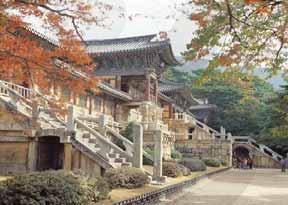
Teacher Presentation: The story of Buddhism begins in the fifth and sixth centuries BCE with a prince whose name was Siddhartha Gautama. Gautama’s father ruled a kingdom in what we know today as Nepal. At the age of twenty-nine, Siddhartha left the palace to seek spiritual improvement. He wanted to find the source of human suffering – and the way to become free from it. After searching for many years, at the age of thirty-five, he attained enlightenment and became known as the “Buddha –the Enlightened One.” This was the beginning of the Buddhist religion. Buddhism is the first world religion, a universal system of beliefs that spread to Central Asia, China, Korea, Japan, Southeast Asia, and the United States. (More information on Buddhism is located in the beginning section in the Religion and Philosophy chapter. An excellent website for teachers and students: http://www.primaryhomeworkhelp.co.uk/religion/buddhism.htm
Guided Practice: Buddhism is based on ethical and moral concepts: the Eightfold Path (EP), the Four Noble Truths (FNT), and the Five Precepts (FP). As you read the teachings of Buddhism, examine how Buddhists define right and wrong, good and evil, and moral behavior. Think of your beliefs and values and compare them with Buddhist moral teachings.
232
Students may refer to the information in the Religion and Philosophy chapter and/or a computer for additional information about the Buddhist ethical and moral beliefs: the Four Noble Truths, the Eightfold Path, and the Five Precepts. Write a brief description of each, some may need only one or two words, others may require more depth.
Teacher Presentation: Define “Morality” (ask a student to use the dictionary to look up the word), “doing what is right.” Explain that Buddhism attempts to answer what living morally means by following The Four Noble Truths (FNT), The Eightfold Path (EP), and The Five Precepts (FP). These truths came to Siddhartha while meditating on his past lives. He then realized that he had attained enlightenment.
To live is to suffer. Living can bring us great joy; however, in the course of one’s life there are always challenges. To live means to experience anxiety, loss, and sorrow. While this sounds very pessimistic, we have to be realistic. If we recognize why suffering comes about, we can lessen it.
Suffering comes from desire. The Buddha saw that suffering comes from wanting what we cannot have and from never being satisfied with what we do have. We all have needs: food, sleep, clothing, housing, and health. Other needs are more subtle: privacy, respect, friendship, security, variety, and beauty. Some desires are really “wants,” such as expensive clothes, alcohol, entertainment, travel, and expensive food. We all have certain desires, but some desires will cause us to be dissatisfied and sometimes miserable. To end suffering and desire: It would be hard to argue against this truth, but it goes against Western culture. Society is very competitive. We want to be successful in school, sports, and in the workplace. Buddhists believe that we should aim for inner peace and less on finding happiness. By accepting the situation we can find inner peace. By accepting what we cannot change, we can change ourselves and the way we experience the world around us.
Release from suffering is possible and can be attained by following the Noble Eightfold Path.
1. Right understanding. I know that life is not permanent. I understand that desires can cause suffering.
2. Right intentions. My thoughts and motives are pure and are not troubled by emotions or selfish desires.
3. Right speech. I speak honestly, I am kind, and I do not lie. I do not exaggerate or use harsh words.
4. Right action. I do not hurt any living being that can feel hurt, including animals.
5. Right work. My job does no harm to myself or others.
6. Right effort. I consistently strive to improve.
7. Right meditation. I must be aware of myself by examining my thoughts. I must be aware of what I am thinking. Fearful and disturbing sights must be meditated upon until one no longer experiences aversion toward them. The entire world should consist of loving thoughts.
8. Right contemplation. I cultivate states of blissful inner peace
233
Precepts are Buddhist rules to help people behave in a moral and ethical way that will lead to a morally good life. This helps to get rid of suffering and to achieve enlightenment, the realization of the truth about life.
1. Do not harm any life. Do not kill.
2. Do not steel.
3. Do abstain from sexual misconduct.
4. Do abstain from hurtful speech.
5. Do not consume alcohol or other drugs (the concern here is that intoxicants cloud the mind).
Independent Practice: Students will complete the chart independently.
Column 1: Read the question
Column 2: answer (yes/no) from a Buddhist point of view.
Column 3: which of these actions are they related to?
Column 4: your answer should come from your own personal experiences.
Talking about people behind their backs.
Not listening or respecting others opinions.
Saying something kind when your friend is having a bad day.
Helping my elderly neighbor with yard work.
Never lying
Overeating, simply because there’s plenty of food.
Limited time on the computer.
Showing kindness to a stranger.
Killing a bumble bee. Taking things that don’t belong to you.
234
Group Evaluation: Students will discuss and share answers from their charts, comparing and exploring their own moral beliefs with that of Buddhism.
Discussion of prompts:
Does Buddhist morality differ from your own definition of morality?
· Why do you agree or disagree?
· After completing the chart did you find yourself asking the question “Why do I do it or not do it?”
· Did you learn any new ways of coping with problems you might encounter with your family, friends, and school?
Do you feel the moral character of one’s actions determines one’s character? Can you think of someone who you feel displays moral character?
· Is there a guideline that we can compare our lives to in relation to The Five Precepts?
· What have you learned about yourself after completing the chart?
Closure/Evaluation: Many of the Buddhist principles have been applied to our lives in different concepts. Generally speaking, Buddhist morality is universal, and has been applicable to all times and most cultures.
https://drive.google.com/folderview?id=0B3fhil7FKrm5ZkVFUHVqdWp4X0E&usp=sharing
235
Chapter 7
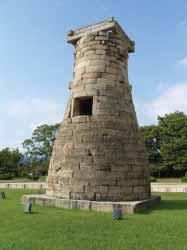
Science and Technology
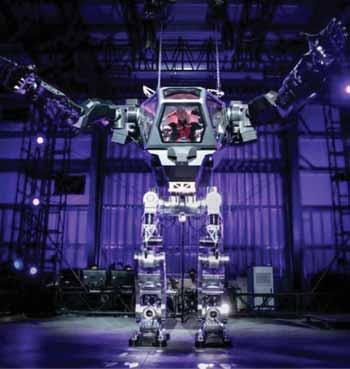 Left: Cheomseongdae, the oldest surviving astronomical observatory in Asia and possibly even the world; Right: Amazon CEO Jeff Bezos controls a giant Avatar-style robot “Method-2” built by a South Korean company, Hankook Mirae (Courtesy of Korea Daily)
Left: Cheomseongdae, the oldest surviving astronomical observatory in Asia and possibly even the world; Right: Amazon CEO Jeff Bezos controls a giant Avatar-style robot “Method-2” built by a South Korean company, Hankook Mirae (Courtesy of Korea Daily)
229 235 235
Science and Technology:The Past
The Korean Spirit and Cultural Promotion Project (KSCPP) provides excellent resources for educating students about Korea’s achievements in the fields of science and technology. The KSCPP website (http://www.kscpp.net)offersinformative and engaging videos and paperback books that teachers and students can download for classroom use. If educators would like copies of the organization’s paperback books, the organization will mail books free of charge. KSCPP will also provide free classroom sets. The organization’s only request is that the teachers follow up with KSCPP as to how they adopted the organization’s educational resources for classroom use. The editorial board prepared the following resource books in collaboration with scholars and experts in each field.
Eighth Grade – California Science Framework includes a unit on astronomy for students titled “Earth’s Place in the Universe, Stars, and the Solar System.” The following selections could be of interest to students: “Kingdom of Astronomy,” “Noteworthy AstronomicalRecords,” “The World’s Oldest Surviving Observatory,” and “Astronomy under King Sejong ” Early research in the field of astronomy provided knowledge about auroras, calculation of the movement of planets, comets, meteors, meteoric showers, solar eclipses, and understanding of the formation of the universe. Since the telescope was not invented until the early 17th century, the discoveries by Koreans are quite remarkable.
The following listed articles are from Fifty Wonders of Korea vol. 1: A discussion of fifty world-class cultural and scientific achievements, advances and discoveries from the history of Korea.
1.“The Invention of Moveable Metal Type” –Korea’s method of printing using moveable type was first used in Korea 200 years before the first European printing press was made by Gutenberg in 1455. Explore the importance of the invention of moveable type. What changes came to Korea and to Europe and a result of these discoveries? What were some of the reasons why the impact of moveable type was not as significant in Korea as it was in Europe? A student might wish to answer these questions through Internet research in addition to the reading of the chapter.
239
2. “The Tripitaka Koreana” The Tripitaka Koreana is located at the Haeinsa Temple, a thousand year-old monastery located in the mountains in south-eastern part of Korea. The Tripitaka Koreana is the most complete and important set of Buddhist teachings. It was carved in the 13th century on 81,340 woodblocks that altogether weighed about 280 tons. The blocks are housed in two large buildings complete with a simple, but effective ventilation system that has preserved the woodblocks in virtually perfect condition. The article explains the scientific methods that the Koreans adopted to preserve the woodblocks. In fairly recent years, the woodblocks were removed to a modern building that many thought would be better in terms of preservation; however, within a short amount of time they began to deteriorate. Needless to say, the woodblocks were returned to their original home at Haeinsa. KSCPP has a ten minute video on its website on the Tripitaka Koreana.
3. “The Sokkuram Grotto” The grotto is the only man-made grotto of its kind. In order to achieve their goal, the people of Silla had to use highly accurate mathematical calculations and geometric accuracy in the creation of the grotto. In the center of the grotto is a beautifully carved huge Buddhist statue. The early Koreans had the technological skills to create a beautiful Buddha out of granite which is hard and course grained. Despite this, the granite structure is extremely detailed and realistic. Another remarkable achievement is the domed ceiling which is made up of 108 stones, each weighing tens of tons. Without any adhesive agent, they were able to support the weight of the stones. The KSCPP website has a ten minute video on the Sokkuram Grotto.
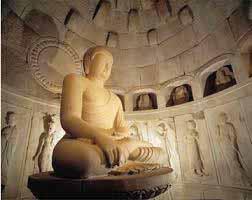
The following articles are from Fifty Wonders of Korea vol. 2: A discussion of fifty world-class scientific and technology achievements from the history of Korea.
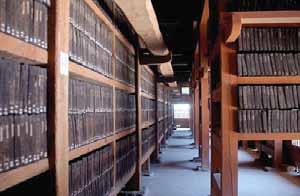
240
1.”Kingdom of Astronomy” The history of astronomy in Korea is rich and varied, with over 20,000 observations of astronomical phenomena accumulated over the course of 2,000 years. These records are a valuable source for modern astronomers, firstly for their historical reach, and secondly for their reliability. Of the main nations in East Asia, for example, Korean records of solar eclipses show the highest rate of accuracy.
2.”Noteworthy Astronomical Records” Ancient Korean astronomical data is still used in research today, as it gives us valuable information about cosmic events that occurred before the use of telescopes. The records of sunspots and auroras were detailed enough to allow conclusions to be drawn about astronomical cycles that have only recently become established theories. Comets were also faithfully observed; for example, Korea possesses the most exhaustive account of a comet appearance ever written. Reports of meteors and meteoric showers also provide astronomers with an insight into the evolution of the solar system.
3. “The World’s Oldest Surviving Observatory.” Chomsongdae (constructed in the 7th century), the world’s oldest observatory, was built during the Silla period, and is rich in astronomical symbolism as well as being carefully designed for its scientific purpose. Built on the palace grounds, it was tall enough to offer a wide and unobstructed view of the heavens.
4.”The Legacy of Koguryo” (current Romanization - Goguryeo)” Goguryeo (37 BC – 668 CE), one of the Three Kingdoms of Korea, left behind many stone-chamber murals depicting star patterns. Its most important legacy is a star map confirmed as the oldest complete representation of the skies in the world. It lies hidden within a later Joseon star map, based upon the Koguryo original, but its true age and origins can be inferred from the stellar positions.
5. “Astronomy under King Sejong (1397-1450)” The construction of an advanced astronomical observatory in 1438 meant that eclipses could be predicted with accuracy to the very second of their occurrence. It also enabled national ceremonies to be performed without error and to calculate calendar periods correctly to six significant figures. As a result, Korea was one of only

241
three 15th century nations able to calculate the movements of the planets with respect to their own latitude of observation.
6. “Kobukson or “Turtle Ship” The Kobukson, or Turtle Ship, was the first iron-clad warship and developed more than 250 years before the Monitor and the Merrimac used in the American Civil War. The Turtle Ship was used for the first time by Admiral Yi Sun-sin in the 16th century. With its exceptional capabilities and firepower, it played a significant role in almost all of the sea battles of a war between Korea and Japan, known as the Imjin War (1592-1598). The chapter includes information about Korea’s ongoing achievements in shipbuilding.
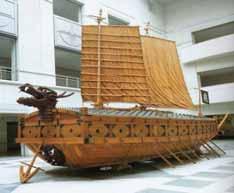
7. “An Automatic Water Clock” The Chagyongnu was an automated water clock created in 1434. Building on Chinese and Arabian innovations, it was powered by flowing water, and the time signals were triggered by a system of falling marbles. The purpose of the automated clock was to provide a means of time-keeping that required no human input, and was therefore reliable. The clock was commissioned by King Sejong, and destroyed in a fire during the Imjin War (1592-1598). Originally completed in one and one half years, it took a professor at Konkuk University 23 years to reconstruct it successfully!
8. “Kudle: Traditional Underfloor Heating” The first form of underfloor heating in the world, the Kudle (also called ondol) was sophisticated enough to be an effective source of heat and within the means of both the rich and the poor to build and use. Early forms of Kudle have been discovered in excavated sites more than 2,000 years ago. Still found in Korean homes, it has been shown to help allergies, aid sleep, and improve the general quality of life. Frank Lloyd Wright was the first western architect to develop a system of underfloor heating in modern times.
The new Romanization adopted by the Republic of Korea has been adopted in this guide for exploring science and technology in Korea.
______________
242
Science and Technology: The Present
The Korean Spirit Culture and Promotion Project (KSCPP) website (kscpp.net) includes a Korea Foundation video that explains economic and technological development since the Korean War. Another KSCPP website video, “Korea Today,” includes Construction, Shipbuilding, Electronics, and IT and Living. The IT and Living will be of particular interest to students. Semiconductors, steel, shipbuilding, autos, mobile phones, internet, robotics, and biotech industries are all important areas and reflect South Korea’s achievements in science and technology.
Science and Technology in Korea
http://www.stofficeseoul.ch/ science-and-technology/ science-technology-in-korea/
Two South Koreancompanies among top-10 semi-conductor manufacturers: http://anysilicon.com/top-20-semiconductor-companies-2016/
South Korean Cloning
http://time.com/3822573/snuppy/
South Korea Leads in Internet Speeds
http://www.usatoday.com/story/tech/news/2016/06/30/superfast-internet-south-korea-wins-uslags-far-behind/86516042/
South Korea Leads in Internet Use(see map)
http://www.pewglobal.org/2016/02/22/smartphone-ownership-and-internet-usage-continues-toclimb-in-emerging-economies/2-23-2016-10-31-42-am-2/
Smartphones by Country/ South Korea/Leads in Use of Smartphones
http://www.pewglobal.org/2016/02/22/smartphone-ownership-and-internet-usage-continues-toclimb-in-emerging-economies/2-23-2016-10-31-58-am-2/
Global market share of cellphones by maker (Samsung and LG are Korean companies)Samsung is the Leading Vendor of Cell Phones.
https://www.statista.com/statistics/271496/global-market-share-held-by-smartphone-vendorssince-4th-quarter-2009/
Korean Robot named Hubo/South Korea’s Impressive Achievements in Robotics
http://spectrum.ieee.org/automaton/robotics/humanoids/how-kaist-drc-hubo-won-darpa-roboticschallenge
Korean Auto Industry Production Statistics/ South Korea is the 4th Leading Auto Manufacture
http://www.oica.net/category/production-statistics/
243
South Korea is the 6th Largest Steel Producer in the World
http://www.tradingeconomics.com/south-korea/steel-production
South Korea’s Shipbuilding/Hyundai Heavy, Daewoo Shipbuilding and Samsung Heavy Industries Co., the world’s three biggest shipyards
https://www.bloomberg.com/news/articles/2016-10-31/korea-to-spend-9-6-billion-by-2020-tosupport-shipping-industry
Two lessons in the history chapter will provide additional information:
“Economic Development and Democratization of South Korea” and “South Korea’s Economic Development” (A document-based lesson)
244
Chapter 8
Korean American History
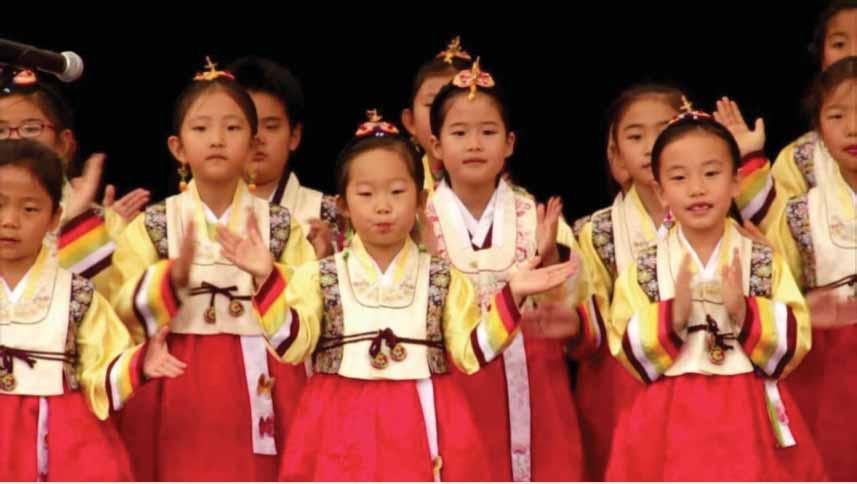 Young students dressed in Korean traditional clothes, hanbok, on Korean American Day (Courtesy of Melissa Fox)
Young students dressed in Korean traditional clothes, hanbok, on Korean American Day (Courtesy of Melissa Fox)
237 243 243
Inclusion
of Korean American History: 2016 California History Social Science Framework And Opportunities to Teach Korean American History
Standard 1.4 (3) Recognize similarities of earlier generations in such areas as work (inside and outside the home), dress, manners, stories, games, and festivals, drawing from biographies, oral histories, and folklore.
This allows for stories from parents and grandparents on what life was like at an earlier time.
Quality literature books may be shared to help students acquire deeper insights into life in the past and the cultures from which the families came: the stories, games, and festivals parents or grandparents might have enjoyed as students.
Standard2.1 (1) Trace the history of a family through the use of primary and secondary sources, including artifacts, photographs, interviews, and documents.
Standard 2.1(2) Compare and contrast their daily lives with those of their parents, grandparents, and/or guardians.
Students may share family photographs, artifacts, and interview their parents and grandparents. They can locate on a map where their ancestors lived, describing when their Korean family came to America, and how and why they left Korea.
Standard 2.5 Students understand the importance of individual action and character and explain how heroes long ago and the recent past have made a difference in others’ lives. (This will allow for an opportunity for students to learn about famous Korean Americans past and present.)
Dear Juno
A lesson on Dear Juno is currently in Teaching East Asia: Korea. Short biographies on influential Koreans will be included in the second edition.
247
Quality literature books may be shared to help students acquire deeper insights into life in the past and the cultures from which the families came: the stories, games, and festivals parents or grandparents might have enjoyed as students.
Standard2.1 (1) Trace the history of a family through the use of primary and secondary sources, including artifacts, photographs, interviews, and documents.
Standard 2.1(2) Compare and contrast their daily lives with those of their parents, grandparents, and/or guardians.
Students may share family photographs, artifacts, and interview their parents and grandparents. They can locate on a map where their ancestors lived, describing when their Korean family came to America, and how and why they left Korea.
Standard 2.5 Students understand the importance of individual action and character and explain how heroes long ago and the recent past have made a difference in others’ lives. (This will allow for an opportunity for students to learn about famous Korean Americans past and present.)
Dear Juno
A lesson on Dear Juno is currently in Teaching East Asia: Korea. Short biographies on influential Koreans will be included in the second edition.
Standard 3.3 (1) Research the explorers who visited here, the newcomers who settled here, and the people who continue to come to the region, including their cultural and religious traditions and contributions.
Standard 3.3 (3) Trace why their community was established, how individuals and families contributed to its founding and development, and how the community has changed over time, drawing on maps, photographs, oral histories, letters, newspapers, and other primary sources. Explain the first Korean immigrants and their settlement in Hawaii and the mainland. See http://arirangeducation.com/main.Accessing this site will provide an interactive classroom activity with lessons about Korean American history. The DVD of the Arirang’s classroom activity can be purchased.
If a school is located in a Koreatown, there is an opportunity to examine the growth of this area and the Korean American experience. See Amazon.com for Katherine Kim’s Los Angeles’s Koreatown.
Standard 4.4 (3) Discuss immigration and migration to California between 1850 and 1900, including the diverse composition of those who came; the countries of origin and their relative
248
locations; and conflicts and accords among the diverse groups (e.g., the 1882 Chinese Exclusion Act).
Standard 4.4 (4) Describe rapid American immigration, internal migration, settlement, and the growth of towns and cities (e.g. Los Angeles).
The history of California is rich with ethnic, social, and cultural diversity, economic energy, geographic variety, and growing civic community. The study of California history in the fourth grade provides students with foundational opportunities to learn in depth about their state, including the people who live here, and how to become engaged and responsible citizens.
This clearly allows for teaching Korean American history and showing the Arirang Classroom DVD that includes four lessons and interviews. See http://arirangeducation.com/main. Essays will be developed on famous Koreans who came to the U.S in Teaching East Asia: Korea.
Standard 5.5 Students explain the causes of the American Revolution Students could compare the American Independence Movement with the Korean Independence Movement.
Standard 5.8 Students trace the colonization, immigration, and settlement patterns of the American people from 1789 to the mid-1800s, with emphasis on the role of economic incentives, effects of the physical and political geography, and transportation systems.
Standard 8.12 (7) Identify the new sources of large-scale immigration and the contributions of immigrants to the building of cities and the economy; explain the ways in which new social and economic patterns encouraged assimilation of newcomers into the mainstream amidst growing cultural diversity; and discuss the new wave of nativism.
The Framework discusses the waves of immigrants and migrants to the American West in the 19th century.
.
249
Students could do research on famous Koreans who settled in the United States, such as Ahn Chang Ho (Korean Independence Movement) and Young Oak Kim (World War II hero who led the famous 100th Infantry Battalion of the U.S. Army)
There is no specific reference in the 2016 California History-Social Science Framework to Korean Americans; however, all textbooks mention the Immigration Act of 1965 and inevitably discuss Asian immigration to the United States.
250
Korean American History
is Professor of Ethnic Studies and founding Director of the Young Oak Kim Center for Korean American Studies at the University of California at Riverside. He earned his B.A. (1982) in Sociology and Ph.D. (1990) in Ethnic Studies at UC Berkeley and M.A. (1984) in Asian American Studies at UCLA.Professor Chang is considered as one of the foremost interpreters of the Los Angeles civil unrest and race relations and has received many prestigious awards for his contributions in the field of Ethic Studies and Korean American history.
Professor Chang is author of eight books, seven edited volumes, and numerous articles in The Los Angeles Times, Korea Daily, and the Korea Times. His mostrecent book is the Korean translation of Lonesome Journey published by Korea University Press in 2016. He translated the Korean book Unsung Hero: The Story of Col. Young Oak Kim (2011). Chang is also the author of "Ethnic Peace in the American City: Community Building in Los Angeles and Beyond ," (with Jeannette Diaz-Veizades) in 1999. His commentaries have aired on the Korea Broadcasting System and Radio Korea.
A Concise History of Korean Americans (
Today, Korean Americans are a growing ethnic group whose history in the United States reaches back to the late 1800s. The first Koreans came to the U.S. as diplomats, students and ginseng merchants. Official Korean immigration to the U.S. began in 1903. A group of 102 Koreans boarded the SS Gaelic and sailed to Hawaii. On January 13, 1903 those pioneering Koreans landed in Honolulu. Today, January 13 is recognized and celebrated by the United States as Korean American Day.
Koreans in Hawaii established the first Korean American church in November 1903. However, most of these Korean worshipers resided and worked on plantations and were dispersed across several islands. The Korean Methodist Church of Hawaii provided a haven for Korean laborers who had no formal community of their own because they lived on plantations as workers. The living arrangements on the plantations resembled a pyramid, where the owner lived on the top of the hill and the supervisor known as the Luna, resided in the middle acting as a buffer, and the diverse labor force lived in cottages or camp sites.
Korean laborers resided on these plantations with other minorities including the Chinese, Japanese, and later Filipinos. In fact, Hawaii had become a multiethnic/multiracial society because the plantation owners continually imported foreign labor
400,000 workers from 33 different countries to work on the sugar plantations from the 1860s to the 1940s. Koreans in Hawaii formed their own organizations including a village council for each plantation. The council, known as the Dong-hoe, was led by the eldest person who was known as the Dong-jang. Each plantation Dong-hoe provided Korean laborers a sense of stability in their chaotic plantation lives.
Many of the Korean plantation workers were bachelors and very few came with families. However, beginning in 1910, Korean “Picture Brides” began to arrive in Hawaii. The women
_____________
–
251
typically came from poor families. Parents of both groom and bride would consult each other and based upon recommendations and photographs, a match would be made. The women were motivated by several factors including the hope they would have more freedom in America, escaping Japanese rule, filial obligation, and the prospect of economic prosperity.
The age difference between brides and grooms averaged about 15 years. Thus, many Korean picture brides were often widowed and ended up working and supporting their families on their own. Picture Brides brought stability, focus, and economic prosperity for their families. They labored with their husbands and moved with them when they left Hawaii for the US mainland.
Church continued to be a strong and influential part of Korean lives in Hawaii. After Koreans moved to the US mainland, they continued to worship at churches and eventually, in October 1905, the Korean Methodist Church of San Francisco was founded.The bustling city of San Francisco served as the port of entry for Koreans who came to the United States mainland. The city was already saturated with Chinese Americans who had established a Chinatown in the city. While there were a small number of Koreans living, and working in San Francisco, there were not enough of them to constitute a Korean settlement. Instead, Koreans who came to San Francisco used it as a temporary station to learn about job opportunities elsewhere. San Francisco had a high rate of anti-Asian sentiment and very little employment opportunities for Asian immigrants as they faced overt discrimination. Thus, Koreans found themselves migrating to other cities such as Riverside, CA, Redlands, CA, Hastings, Nebraska, and even as far away as New Jersey.
Dosan Ahn Chang Ho, famed Korean patriot and leader, was one of those early Korean settlers who came to the U.S. before official Korean immigration to the U.S. and arrived in SF on October 14, 1902.Some of those Koreans moved from Hawaii to the United States mainland. Dosan had five children. Phillip became an actor with well-known roles on television series like Kung Fu. Philson became an engineer. Susan joined the US military during World War II. Soorah opened a restaurant – the Moongate – in Panorama City, CA with the help of Philip in the 1950s. Ralph also enlisted in the US Navy and later became an actor. Dosan’s children continued to be active community members and leaders, carrying on their father’s legacy of honesty and integrity. Dosan was eventually deported in 1926.
Meanwhile, Dosan arrived in Riverside, CA, in March 23, 1904 and established a Korean Labor Bureau in 1905 in an effort to help organize the Korean community. The Korean Labor Bureau attracted many Koreans who settled in Riverside and lived at Pachappa Camp. The settlement was known as Pachppa Camp, or Dosan’s Republic. It housed about 100 Koreans (1910 census) who worked on neighboring citrus farms. Korean men, women, and children resided at Pachappa and held weddings, social activities, and other community functions like English classes. The community flourished and Dosan’s wife and children also moved to Riverside where they resided until 1913.
The importance of Pachappa Camp and the role the settlement played in the growth of the Korean American community and the global Korean independence movement in the early 1900s
252
has long been overlooked by historians and academics. But, new discoveries including local church records, maps, and newspaper articles illustrate just how important and significant Pachappa Camp was. It is important to note that Korean women at Pachappa Camp played a very important and active role in the independence movement as well. They helped with fund raising, donated what little they had to the cause, and actively participated in meetings. In fact, they also fundraised, gave lectures, and participated in discussion groups. Korean women not only worked as well as the men, they also took care of the family, cooked, and maintained the Pachappa Camp buildings.(PBS News Hour link: https://www.pbs.org/newshour/show/buried-past-ofamericas-first-koreatown-uncovered-in-californias-riverside)
Koreans living in the United States spent much of their time working for the independence of Korea which became a protectorate of Japan in 1905 and was formerly colonized in 1910. Ahn Chang Ho, Syngman Rhee, and other Korean independence activists worked to liberate Korea. While the Korean National Association fought for Korea’s independence during the early 1900s, Koreans in America were about to engage in their own independent recognition as non-Japanese. On June 26, 1913, a group of eleven Koreans were contracted to work in Hemet, CA picking apricots. But at the time anti-Asian sentiment was high. The Korean workers, who went to Hemet by train, were greeted by white protestors who threw their baggage back at them and forced the Koreans back on the train. This incident would later prove to be invaluable to the Korean American community. As word spread of the event, Koreans became the subject of American newspapers who reported on the story which became known as the “Hemet Valley Incident.”
According to the news reports, the Japanese Consulate moved quickly to represent the Koreans, who they claimed as Japanese subjects at the time. Outraged by the Japanese government’s interference, the Korean National Association’s president David Lee, sent a telegram to then Secretary of State William Jennings Bryan proclaiming that Koreans in America were not Japanese subjects and should be treated as Koreans.
Secretary of State Bryan took this opportunity to deflect criticism from the Japanese government and issued a press release stating that “Koreans are not Japanese subjects.” The Hemet Valley Incident would serve as an important moment in Korean American history. Koreans in America were now unofficially recognized by the U.S. government and were considered free from Japanese authority. In essence, the Korean American community gained semi-formal status and the Korean National Association became the unofficial diplomatic representative of Koreans in America.
The March 1, 1919 Mansei uprising in Korea which protested Japanese occupation inspired Koreans living abroad to become more active in independence movements. Shortly after, on April 13, 1919, the Korean Provisional Government was formed and its president Syngman Rhee oversaw operations. Syngman Rhee also formed an independence organization known as the Dongji-hoe, or Comrade’s Association. Established in Hawaii by Rhee, the organization moved its headquarters to Los Angeles in 1929.
253
The early Korean community in the U.S. evolved around Church and the independence movement. In fact, church and the independence movement were inseparable as the Korean immigrant church was the center of independence movement activities. Despite economic hardship and racial discrimination, Korean immigrants supported and actively participated in the independence movement by voluntarily paying a “duty fund.” One Korean American, Park Yong Man, went as far as establishing a youth military school in Hastings, Nebraska and later in Hawaii to prepare for armed resistance against Japan.
With new hope and motivation after the March 1, 1919 Mansei movement, a group of visionary Koreans, aided by the newly established Korean Provisional Government, set forth on an endeavor to form a combat pilot training school in Willows, CA – it became the Willows Korean Aviation School/Corps. Thus, sometime in March 1920, the Willows Korean Aviation School Corps was established. For about one year the school trained Korean American men in the art of flying airplanes. Classes were structured like a military school. Under the direction of the Korean Aviation Board which received its blessing from the Korean Provisional Government, the school admitted about 25 students to start. Several dozen students trained at the Willows Korean Aviation School/Corps. At some point, plans to train up to 100 pilots were made. But, misfortune and bad weather would change the tide of the school’s fate. Today, the school is regarded as the origin of the Korean Air Force.
From the 1920s to the early 1940s the Korean American population grew very slowly. Korean Americans found work throughout the U.S. as farmers, house servants, bakers, cooks, coal miners, and various other hard labor occupations. Some even opened stores and shops, selling fruits and vegetables. The Korean American population never gave up on their mother country and strived to support the independence movement. Many Korean Americans joined the Korean National Association, Comrade's Association (Dongji-hoe), other independence organizations and donated money, and held meetings to support the cause.
With the United States now firmly entrenched in the violence and chaos of World War II, Korean Americans saw an opportunity to fight the Japanese; this was their chance to help the Korean independence movement. Even though Korean immigrants were not eligible to become naturalized American citizens until 1952, they still felt the call to arms. More than 200 Korean Americans were able to enlist or were drafted by the US military.Many Korean Americans viewed enlisting in the US military was beneficial to the independence of Korea.
The most famous of Korean American military war heroes who served during World War II was Col. Young Oak Kim. He would then be assigned to the 100th Infantry Battalion. This battalion would become the famed Nisei Unit of the US Army. The mostly-Japanese American men did not trust Kim at first. When Kim arrived in Hawaii to take command of this fledgling unit, his commanding officer told him that he would be transferred citing the fact that at the time, Koreans and Japanese did not get along. Kim, however, saw beyond the color lines and said: “We’re all Americans and we’re all fighting for the same cause.”
Kim would earn the respect of his men after he showed them compassion, leadership, and
254
genuine care for their well-being. Kim would lead this unit through Europe, fighting on the frontlines in Italy, France, and Germany. Kim would later receive the equivalent of the Medal of Honor from Italy, France, and the Republic of Korea.
Another amazing Korean American who served his country with honor was Dr. Sammy Lee. Dr. Lee was the first Asian American to win a Gold Medal for the United States during an Olympic Games. Four years later, during the 1952 Helsinki, Finland Olympic Games he won gold again. Dr. Lee’s life and accomplishments include coaching Olympic divers Bob Webster and Greg Louganis. Dr. Lee was a well-known man and he and Col. Young Oak Kim were life-long friends.
After years of relentless fighting, World War II would finally end in 1945. For Korean Americans, the surrender meant the liberation of their homeland. After thirty-five years of occupation, Korea was now free from Japanese rule.
Korea would be divided. The Soviet Union would take the Northern half of the Korean peninsula and the United States the southern portion. Syngman Rhee would become the Republic of Korea’s president in the South. Kim Il-Sung would become the Supreme Leader of the Democratic People’s Republic of the North. The newly divided country would not see peace for long.Today, Korea is the only country still divided against its own will.
In the United States, the Korean War shined a light on this small community living and working in America. Between 1950 and 1965, Korean American population grew steadily. Many of these Koreans were orphans, adoptees, GI brides, students, and diplomats who migrated to the US after the Korean War. In fact, GI brides played a critical role in helping to bring Koreans to the United States after the passage of the 1965 Immigration Act. The act allowed Korean Americans to sponsor their family members and bring them to the United States. Thus, many GI brides sponsored their fathers, mothers, sisters, brothers, and even cousins, aunts and uncles. The Korean American community flourished and grew with the help of the Korean GI brides.
With the passage of the 1965 Immigration and Nationality Act, the doors were opened for Asians to come to the United States. Quotas and bans were lifted. The Korean American population skyrocketed after 1965. In 1970, the Korean American population was 69,130! This was an increase of about 60,000 since 1940!The new wave of Korean Americans found themselves trying to live the American dream. Many came to the United States after the Korean War, seeking a better life and opportunities.
Korean immigrants who came after the passage of 1965 Immigration Act are known as “New Urban Immigrants.” Unlike traditional immigrants who enter the U.S., Korean immigrants were educated, middle class, and had managerial backgrounds. They sought opportunities in the U.S. and were driven to achieve the American Dream they had heard so much about. These New Urban Immigrants also came to the United States so they could find economic success and send their children to the best universities. It is also important to note that the 1965 Immigration Act was based on family reunion and a preference for skilled workers. Thus, GI brides who sponsored family members or Koreans who came on their own, were skilled laborers. But, they
255
would soon realize, their skills were not transferable in the U.S. and would not be valued. So, they turned to self-employment and opened small businesses; this, they believed, was the fastest way to achieve the American Dream.
When these Korean New Urban Immigrants came to the United States, one distinct characteristic stood out about the community: almost 70 percent attend church regularly, even to this day. The Protestant church is the focal point of the Korean American community today. Another characteristic of the Koreans who migrated to the US in the 1970s and 1980s is that they were unaware of the Civil Rights Movement. They knew little of the anti-war movement or of the race riots of the 1960s. Essentially, Koreans in the United States had no idea that the businesses they were buying or the locations they were now occupying were once owned by the Jewish community. The Jewish community left inner cities after riots including the Watts Riots of 1965. The vacuum that was created by the exodus of the Jewish store owners in inner cities provided an opportunity for the new Korean immigrants.
The LA Riots represented a watershed moment for Korean Americans who realized they needed to have political representation and better community relationships. The unfair depiction of the Korean American community as the middle man minority or gun toting vigilante by American media, put Korean Americans in a hopeless position.
It is often said, that the Korean American identity was born or reborn on April 29, 1992. Korean Americans suffered triple oppression during and after the riots: Economic loss, Post-Traumatic Stress Disoder, and portrayal by the media portray as “vigilantes.” In fact, the Korean American community had no voice in city hall and the LA city council prohibited Korean immigrant merchants from rebuilding their stores.
Korean American shop owners became the target of looters and arsonists. The LA Riots would decimate the Korean American community’s livelihoods as their businesses went up in smoke. During 1980s, many Korean Americans opened shops in inner cities like Chicago, Flushing, NY, andSouth Central Los Angeles. Grocery markets, wig shops, liquor stores, and other small businesses were the main types of businesses Korean Americans operated in those inner cities. Soon the black-Korean conflict, as it was called, began to take up headlines in news reports. As the Korean American population continued to increase – by 1980 the Korean American population would reach more 354,000 – tensions began to brew between the black and Korean communities.
Korean immigrant merchants were no w the “middleman minority.” This meant that they served as the buffer between the dominant white and subordinate black populations in the U.S. The anger and frustrations of underclass blacks were directed toward Korean immigrant merchants. Tensions increased, boycotts, and violence exacerbated the divide and animosity between the two minority communities.
Robberies and murders of Korean Americans increased as well. In 1991, there were 30 Korean American homicides in Los Angeles County. That number would dramatically decrease by 1995; there were 8 homicides in LA County that year.
By April 1992, the trial for the Rodney King beating would grab headlines. The African American community expected justice this time. Instead, not guilty verdicts were given by the
256
jury and the police officers were not convicted. The verdicts became the straw that broke the camel’s back as the African American community gathered in protest, demanding justice and equality.
Many valuable lessons were learned from the LA Riots and Korean Americans worked to become more visible in America. Korean Americans began to participate in politics and gained empowerment and voice. They also encouraged generational cooperation within their community and involved their American born children in the effort to gain visibility and voice in the United States. And, most importantly, Korean Americans became proactive members of the multiethnic and multiracial societies they were part of.
The wake-up call was heard by the Korean American community and they began to participate in politics and give back to the communities they were part of. Cultural misunderstandings were explained and the African American community began to understand a little better the Korean Americans that were also a struggling minority class. Korean Americans spent the next decade raising their voices. David Ryu was elected as a city council member in Los Angeles in 2015. He is the first Korean American and second Asian American to ever be elected to LA City Council.
From 2000 to current day, the popularity of Korean culture hit the American scene hard. Suddenly, Koreatown became a popular place to eat and hang out as interest in Korean food was spurred by trending K-drama and K-pop music. Korean actors like Steven Yeun and Sandra Oh also helped increase interest in Korean culture.
The Hallyu Wave, as this interest is known, increased awareness of Korean culture and helped Korean Americans become more visible and accepted in mainstream American culture. Today, Korean Americans are an integral part of cities like Los Angeles, New York, and other major metropolitan cities. While there are Koreans in nearly every state in America, Koreans are still concentrated in Los Angeles.
Korean Americans also became more organized and sought better voice and representation. In 2010, a group of Korean American leaders formed the Council of Korean Americans. CKA works to raise the voice and identity of Korean Americans on a national scale.
Today, Korean American students excel in school and professional fields. While the success and visibility of Korean Americans has increased dramatically since the days of the 1992 LA Riots, this small community of almost 2 million still faces many challenges. Today, there are still a number of undocumented workers and students who face deportation and poverty. The working Korean immigrant class continues to struggle to make ends meet. Meanwhile, the older Korean American generation – senior citizens – also struggle to survive.
Korean Americans also still face the challenge of how to incorporate these marginalized groups within their community. How can they connect, help, and work with undocumented workers and students? How can American-born Koreans connect with the older generation? As the Korean American population continues to grow, the struggle becomes about how to function, fit in, and live within America’s multiethnic communities.
The answers lie within the 1.5 and the second generation of Korean Americans whose efforts –like the CKA – to raise the voice and identity of their community is the hope for the future. The
257
1.5and the second generation have the advantage of being fluent in English and Korean. They can help bridge the gap between the generations, articulate the needs of the Korean American community, and teach their children about Korean American history and the journey, struggles, and successes of their ancestors so they can forge onward and not repeat the mistakes of the past.
Arirang is a two part DVD documentary about Korean American history created by filmmaker Tom Coffman. Each part is one hour and begins with images of the life of the first Koreans who came to Hawaii in 1903. The second part includes a riveting segment on the L.A. Riots and its impact on Korean Americans.Scholars consider this two part documentary to be the best resource available on Korean American history. If you wish to purchase a copy of the documentary, contact Mary Connor (MaryConnor3838@gmail.com. The segments on the L.A. Riots and its impact on Korean Americans will be very engaging for high school and college students, especially those who are enrolled in Ethnic Studies or United States History. The price of the documentary is $25 plus postage.
Arirang (1:56 minutes), is a DVD documentary on Korean American history also created by Tom Coffman. It is available for purchase ($10 plus postage) by contacting Mary Connor (MaryConnor3838@gmail.com. The documentary begins with the beautiful sounds of Korea’s most famous song, Arirang, and followed by segments that include: conditions in Korea in the late 19th early 20th century, the first Koreans who came to Hawaii in 1903 and their experiences working on sugar plantations, the first Korean settlements in California, Japanese occupation of Korea, the church and the Korean Independence Movement, Ahn Chang Ho, the Korean National Association, World War II (Col. Young Oak Kim),the Korean War, the Immigration Act of 1965, the experience of Koreans in Los Angeles, and the L.A. Riots followed by discussions about the impact of the riots and the response of the Korean community. The documentary includes interviews of historians, journalists, and community leaders. Some segments could be shown to upper elementary and middle school students. The following paragraph indicates what is available and how to locate the segments. The two part Arirang documentary includes all of the above information.
1- 8:33 (the experience in Hawaii), 8:33 – 15:00 (Japanese occupation of Korea, Korean Independence Movement, World War II) 15:00 -18:00 (Korean War) 18:00 -30:00 (Immigration Act of 1965 and life in Koreatown, Los Angeles) 30:00 – 53:00 (Angelo Oh, Racial tensions , the L.A. Riots, and Solidarity), 53:00 – 1:15 (Korean values, Korean achievements, Japanese occupation, March First Movement, Syngman Rhee, the Korean War, the division of Korea), 1:15 – 1:26 (Charles Kim, Korean American Coalition, how to be a Korean in America and retain one’s heritage, the need for Koreans to become involved politically in America), 1:26- 1:33 (Professor Charles Armstrong, the importance of education, the Korean work ethic and life in the suburbs, issues of identity and assimilation) 1:33- 1:44 (Helen Kim Griffin, a researcher, discusses her experience in the U.S. and her pride in being Korean) 1:44-1:56 (Harold Sunoo, discusses his father’s and his own involvement in the Korean Independence Movement, his life experiences that include being a Korean pastor, and his pride in being a Korean.
You Tube includes many videos of the L.A. Riots.Some are excellent.
For more information on Korean American history: KoreanAmericanStory.org (The mission of Korean American Story is to create and preserve the stories of the Korean American Experience).
258
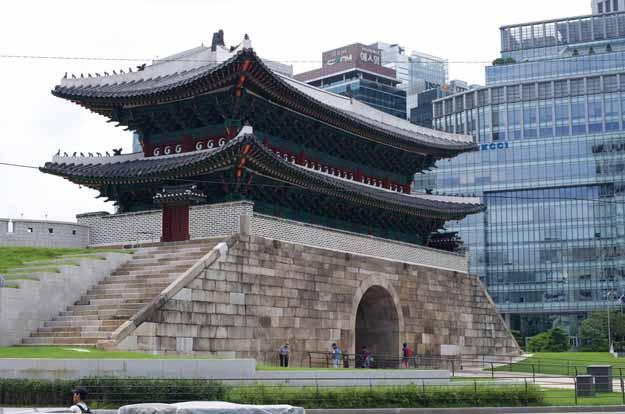
Tourism 251 257 257
Sungnyemun Gate, Korea’s National Treasure No. 1, standing amidst business buildings in Seoul (Courtesy of Dr. Rob Malouf)
Chapter 9
Tourism in South Korea: Places to visit
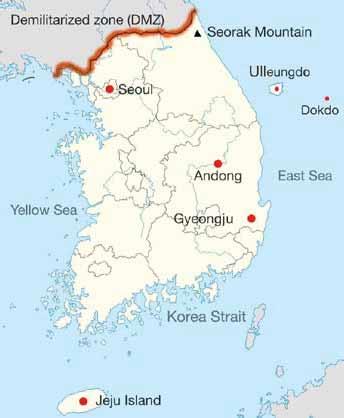
So far, we have learned about Korea in general, including its geographical location, climate, politics, economy and culture. In lesson 8, we will guide you to the must-see attractions in Korea, imagining you are now visiting Korea.
Attractions in Korea

8.1 Seoul: Dynamic city where the past and present coexist in a fascinating way
Over the last 600 years, Seoul has been the capital city of Korea, and it is the center of Korea’s politics, economy and culture. Seoul lies in a large basin encircled by mountains, with the Han River passing through the city. Seoul is the world’s 10th largest city. The total area is 605 27 km² about three times bigger than Amsterdam with a population of over 10 millions. In spite of its high population density, traffic congestion is not as severe as other metropolitan cities in the world. It is because the convenient and affordable subway in Seoul carries over 7 million people every day to any place in Seoul, with a basic fare of $1.00.
Lesson 8
261
There are five royal palaces in the center of Seoul: Kyungbok-gung, Changduk-gung, Changkyunggung, Kyunghee-gung, and Kyungwoon-gung. Kyungbok-gung, the main royal palace was built in 1395. Though it is not ostentatious, it illustrates moderation and dignity. You can experience the life of the city’s past in the Bukchon and Namchon, traditional Korean Houses Villages, and in Insadong where you can shop for traditional handcrafts and antiques.
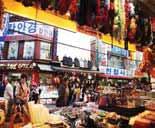
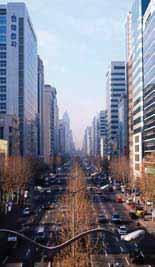
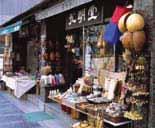
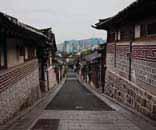


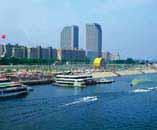
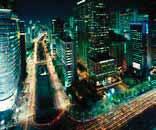
The main streets in the Gangnam District, southern part of Seoul, filled with high rise buildings, global corporations’ billboard advertisements and modern style cafés represent the dynamic energy of Korean enterprises. Myung-dong, crowded by tourists from all over the world, proves that Seoul is a global city. If you visit South Gate Market, an old style market with more than 10,000 shops and over 300,000 visitors per day, you will witness hard working and diligence of Korean people
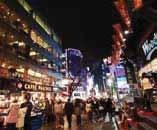 Seoul Night SceneHan RiverSubway in Seoul
Kyungbok-gungBukchonInsadong
Seoul Night SceneHan RiverSubway in Seoul
Kyungbok-gungBukchonInsadong
262
One of the main streets, GangnamMyung-dongSouth Gate Market
8.2 Gyeongju: Ancient Capital of the Silla Kingdom for a thousand years
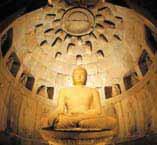
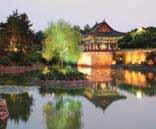
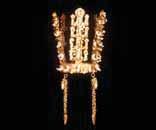
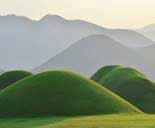
Gyeongju, located in the southeast part of Korea was a capital city of the Silla Dynasty from BC 57 to AD 935. In 676, Silla eventually united three kingdoms (Silla, Goguryeo and Baekje) on the Korean Peninsula and established a national state identity, which was handed down to Goryeo and Joseon.
Gyeongju is designated as World Cultural Heritage listed by UNESCO, thus Gyeongju is also nicknamed “museum without walls”. Gyeongju has 37 royal tombs, where a great wealth of historical items, such as golden crowns, belts and earrings were discovered. Walseong, the site of demolished royal palace, and Anapji offer you a peek into the past daily life of Silla royal family.
religion of the Silla dynasty. Bulguksa Temple and the Seokguram Grotto are the most representative Buddhist historical sites there, and as of today, a total of 147 temples,118 Buddha statues, 96 stapes, and 22 stone lanterns have been found in the south mountain of this historic city.
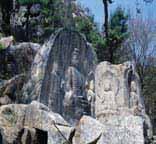
8.3 Andong: The Spiritual Capital of Korea
Confucianism has significantly affected the daily lives of Korean people. Koreans do not hesitate to name Andong as the home of Korean Confucianism. In Andong, there is Dosan-Seowon, a private Confucian school built over 500 years ago. Dosan-Seowon taught its students two core Confucian values – loyalty and filial piety – and honored the sages with regular memorial rites
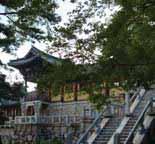 Royal tombsGolden CrownAnapji pond
Bulguksa TempleSeoguram GrottoGyeongju Namsan Chilbumam Maaeseokbul
Royal tombsGolden CrownAnapji pond
Bulguksa TempleSeoguram GrottoGyeongju Namsan Chilbumam Maaeseokbul
263
Hahoe Village in Andong is a one-clan community town established around 1,600, where the Ryu clan of Pungsan gathered together and built houses and private Confucian academies. It well preserves the past tradition of Korea. In this village, buildings for the upper class are harmoniously mixed with houses of the commoners.
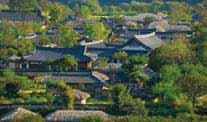
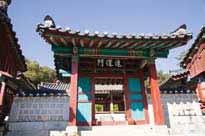
8.4 Seorak Mountain and the East Sea: high mountain and blue ocean
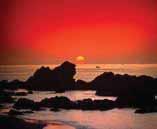
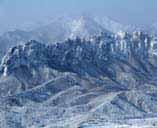
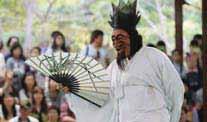
Seorak Mountain is located on the east coast. Daechung-bong, its peak is 1,708m high. UNESCO designated the mountain as a Biosphere Preservation District given the fact that the rare and endangered plants and animals such as moon bears and goats live there.
According to Gallup research in 2009, mountain climbing was chosen as a top leisure activity (9%) in Korea, many Koreans climb Seorak Mountain for the autumn leaves and snowy scenery. Just as a beautiful sunset is valued in The Netherlands, a sunrise over the East Sea is something many Koreans travel to see.

 Dosan-SeowonFront gate of Dosan-Seowon
Hahoe VillageHahoe Byulsin-gut Mask Nori (performance)
Seorak Mt. in AutumnSeorak Mt. in WinterSunrise in the East Sea
Dosan-SeowonFront gate of Dosan-Seowon
Hahoe VillageHahoe Byulsin-gut Mask Nori (performance)
Seorak Mt. in AutumnSeorak Mt. in WinterSunrise in the East Sea
264
There are two beautiful islands in the East Sea, which are Ulleungdo and Dokdo. Dokdo is the home of many sea birds. During the breeding season, from April to June, Dokdo provides a fantastic sight when sea gulls are calling to each other in packs and flying in formations. Dokdo also plays an important role as a resting area for the migratory sea birds crossing the East Sea. The Korean government has designated the area as the Dokdo Nature Preservation Zone in order to protect this pristine natural environment and the ecological system of Dokdo.

8.5 DMZ: the Legacy of the Cold War
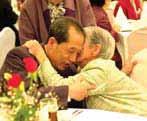
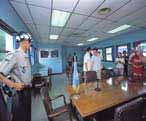
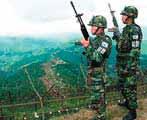
With the Armistice Agreement after the Korean War in 1953, Korea was divided into South and North Korea alongside the Military Demarcation Line (MDL). The MDL area is one of the most heavily fortified areas in the world. South and North Koreas each withdrew 2 km from the line, and set up the DMZ which means Demilitarized Zone. The total area of the DMZ is 992 km2, accounting for 0.45% of the whole Korean peninsula.
The underground tunnels built in the DMZ areas for military infiltration by North Korea in the 1970’s demonstrate well the tension of this area. Panmunjom, the Joint Security Area maintained by both South and North Korea, is the most popular place for tourists in the area. It is a place where the bilateral meetings between South and North Korea are held. There are about 10 million people who were separated from their family members as a result of the Korean War. From time to time, family reunion events take place in Panmunjom.
Although the MDL is a symbol of Korea’s division, the high security has allowed the DMZ to grow into one of the world’s most abundant and well-preserved nature reserves, free from public access. The largest marsh, 13 endangered species and conserved species were found there. South Korea, in cooperation with the UN, is pursuing to construct a “World Peace Park” in the DMZ, in order to make it a land of peace and life.
Panmunjom
South Korean soldiers on duty to watch the border
Scene of separated families at a reunion event
265
Dokdo, a beautiful island of Korea
A story about Korea: Bicycle path in The Netherlands and Olle walking paths in Jeju Island
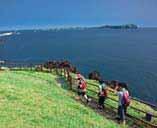
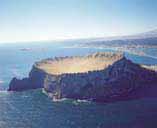
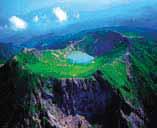


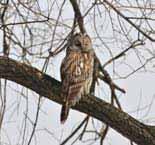
What Koreans envy most about The Netherlands is its many bicycle paths, which enable people to travel all over the country safely. On Jeju Island, however, something similar is gaining in popularity. Jeju Island is located 140km away from the southern part of the peninsula, and the total area is 1,848.5km². Halla Mountain, which is a dormant volcano, is at the center of the island with a height of 1,950m. Jeju Island has many volcano caves and uniquely designed thatched houses roofed with woven grass and stones designed to withstand the windy weather of the island.
In Jeju dialect, which varies greatly from that of mainland Korea, Olle means “a very narrow pathway that connects a street to the front gate of a house.” Courses for Olle walking paths are currently being developed to allow sightseers to walk along the stonewalled winding streets while thoroughly enjoying and experiencing Jeju-do’s unique culture. A total of 21 seashore paths were developed in 2012, and the distance covered by the paths is 422km. The Olle walking paths for pedestrians fit well with the recently spotlighted trends of eco-friendly tourism and the health-conscious movement.
Ural OwlLarge CopperKorean Crevice Salamander
( Wild Life in DMZ ) 266
Halla Mountain in Jeju IslandSeongsan-po in Jeju IslandOlle walking paths
Review Lesson 8
What is a correct statement regarding Seoul’s geographic condition?
Seoul is located near seaside. Seoul is a basin surrounded by mountains. Nakdong River is passing through Seoul.
What is a false statement regarding Kyungbok-gung?
Kyungbok-gung has a luxurious appearance. Kyungbok-gung illustrates both moderation and dignity. Kyungbok-gung was built in 1395.
What is the most representative national treasure in Gyeongju?
Insa-dong Anap-ji Myungdong
What is a correct statement regarding Andong?
Andong is called the home of Korean Confucianism. Andong is also called as a Museum without walls. There are many royal tombs.
What is a false statement regarding Hahoe folk village in Andong?
There are many Buddhist heritage sites in Hahoe village.
Hahoe Byulsin-gut Mask-Nori is a kind of rituals performed in Hahoe village
The houses of upper class people and commoners are harmoniously mixed in Hahoe village.
What is the DMZ?
What is an incorrect statement regarding the South Korea’s important policies towards North Korea?
South Korean government tries to isolate North Korea.
South Korean government has been conducting reunion events for the separated families in South and North Korea.
South Korean government plans to construct a “World Peace Park” within the DMZ.
1.
2.
3.
4.
5.
6.
7.
267
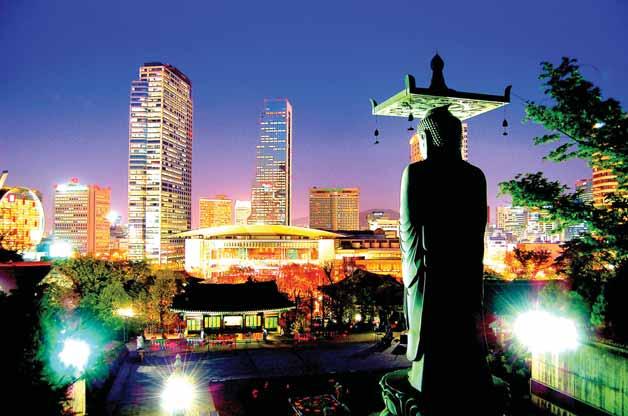
10 259 267 267
1. Korea in World History - Donald N. Clark (high school and adults) Well-written, clear, and succinct information on Korean history. Excellent introduction to Korea. See review in the resources chapter.
2. Tears of Blood: A Korean POW’s Fight for Freedom, Family, and Justice by Young-Bok Yoo is an absorbing and personal account of a survivor of the Korean War, harsh imprisonment, and fifty years of extreme hardship in North Korea until he escaped to freedom to finally return home to South Korea at age seventy. The book was translated by a 16 year old Korean American student (middle and high school) See review in the history chapter.
3. Lost Names: Scenes from a Korean Boyhood - Richard Kim - Japanese occupation of Korea (possibly middle school, but definitely for high school students). The book is beautifully written, accurate, very moving and memorable. Lesson is provided.
4. Brother’s Keeper – Julie Lee – Korean War (middle school and high school. The book is an award winning riveting new book of courage and strength that will inspire all readers. A review of the book is located in the chapter on literature.
5. Waxen Wings (Anthology of contemporary short stories) A very accessible collection of Korean short stories that has been well received by high school and college students. Edited by Bruce Fulton A review of the book appears in the literature chapter.
6. Our Twisted Hero - Yi Munyol (age 12 and up). 20th century - Lesson information is available in the literature chapter.
7. Dear Juno - Soyung Park (ages 3-7) Contemporary story - Lesson
8.Good Fortune in a Wrapping Cloth - Joan Schoettler (ages 4- 8) - Joseon Dynasty (1392-1910) - The book is beautifully illustrated. Lesson is provided.
9. Kite Fighters – Linda Sue Park (ages 8-10) Joseon Dynasty (1392-1910) - Lesson
10. Bee-Bim Bop - Linda Sue Park (ages 5-8) Contemporary – Lesson
11.Name Jar –Yangsook Choi (ages Pre-K-2 and up) Contemporary – Lesson
12. See Saw Girl - Linda Sue Park (ages 9-12) Joseon Dynasty (1392-1910) – Lesson
13. The Year of Impossible Goodbyes – Sook Nyul Choi (ages 12 and up) Japanese occupation to the division of Korea (1910-1945)
14. A Single Shard - Linda Sue Park (ages 9-13) Newberry Award - Korea during the Goryeo Dynasty (918-1392) Lesson
15. When My Name Was Keoko - Linda Sue Park (ages 10 and up) Japanese occupation of Korea (1910-1945) This short historical novel is historically accurate, objective and very readable.
16. A Yang for Every Yin: Dramatizations of Korean Classics – John Holstein –The book includes five well known plays, helpful commentary, and information on how to obtain the musical scores. Access more information at the end of the music chapter.
17. Images of America: Los Angeles’s Koreatown – Katherine Yungmee Kim – A short and engaging history of Koreatown with many photographs.
271
272
273
Websites (List of Highly Recommended Sites)
Articles and Lessons on Asia Education About Asia (EAA) is the most important single resource for teachers in the entire field of Asian Studies. To subscribe to EAA, visit the secure order page at https:www.asianstudies.org/EAA. There are three issues per year and the cost is $30. The website archives include more than 1,250 articles and lessons for teaching about Korea and all of Asia. You will be able to download all of these excellent recourses. https://www.asianstudies.org/publications/eaa/archives/
Professional Associations for Teaching about Asia and Asian Americans
The Association for Asian Studies (AAS) is a scholarly, non-political, non-profit professional association open to all persons interested in Asia and the study of Asia. With approximately 6,500 members worldwide, representing all the regions and countries of Asia and all academic disciplines, the AAS is the largest organization of its kind. Through its publications, online resources, regional conferences, and annual conference, the AAS provides its members with a unique and invaluable professional network. https:www.asianstudies.org
The Association for Asian American Studies (AAAS) - The Association for Asian American Studies was founded in 1979 and has emerged as a primary research and teaching hub for Asian American Studies, an interdisciplinary field born out of the 1960s movements for racial justice and student activism. https:www.aaastudies.org
Art/Architecture:
Asian Art Museum, San Francisco http://www.asianart.org
Asian Historical Architecture - http://www.orientalarchitecture.com (A photographic survey ofAsia’s architectural heritage, featuring nearly 6,000 photographs of 404 sites in fifteen countries.)
Buddhist Lanterns (An outstanding website created by Susan K. Kopecki, Art Educator, Hillcrest School, Wethersfield, CT. that includes information on Buddhism and how to make beautiful Buddhist lanterns)
https://drive.google.com/folderview?id=0B3fhil7FKrm5ZkVFUHVqdWp4X0E&usp=sh aring
Freer Sackler Gallery - http://www.asia.si.edu/collections/KoreanHome.htm
Hoam Museum http://hoam.samsungfoundation.org/eng/index.asp (Site of one of Korea’sleading museums)
Korean Spirit and Culture - http://www.kscpp.net (Highly recommended site for videos and books on art, culture, famous Koreans, and contemporary Korea)
274
Metropolitan Museum of New York - http://www.metmuseum.org.(The museum has an extensive collection of Korean art. The site includes ceramics, metalwork, decorative arts, Buddhist sculpture and painting).
National Museum of Korea - http://www.museum.go.kr (The biggest and best repository of Korean history and culture)
Republic of Korea’s Website -http://www.korea.net (The government’sofficial Englishlanguage homepage offers information about contemporary and traditional arts)
Asia inthe 20th Century:
Asia for Educators (Columbia University) - http://afe.easia.columbia.edu/ (This site is not entirely on the 20th century, but it is an outstanding resource that can be very useful)
Central Intelligence Agency - http://www.cia.gov. (Click on World Fact book and then enter South or North Korea)
Life inKorea - http://www.lifeinkorea.com/Information/index.cfm (This site isuseful for a brief overview of Korean contemporary culture)
U.S. Department of State - http://www.state.gov (Click on South or North Korea for information)
Civics and Government:
Central Intelligence Agency - http://www.cia.gov. (Click on World Fact book and then enter South or North Korea)
Republic of Korea - http://www.korea.net/ (The official site for the government of South Korea)
U.S. Department of State - http://www.state.gov (Click on South or North Korea for information)
Community Service Option:
Liberty in North Korea (LINK) - http://www.linkglobal.org (LINK is a non-profit, nonpartisan, non-ethnic group with a mission to educate the world about North Korea. It also acts asanadvocate for human rights and humanitarianaid. Students canbecome involved in learning about conditions in NK and support projects which will assist in LINK’s mission)
Economics:
Bank of Korea - http://ecos.bok.or.kr/EIndex_en.jsp(Statistics from the Bank of Korea)
275
Korea Economics Institute http://www.keia.org KEI provides anunderstanding of the importance of the U.S.-South Korea relationship and developments in South Korea)
Korea Society – http://koreasociety.org
“The Project Bridge Youth Ambassador Program is one of the longest running programs offered by the Korea Society. It was started in 1993 as a response to the 1992 Los Angeles riots to introduce African-American urban students to Korean people, history and culture in an effort to promote greater understanding.
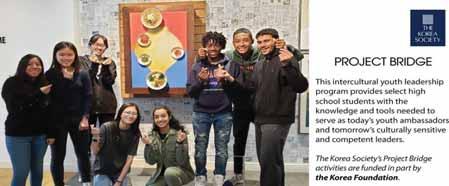
Since its inception Project Bridge has engaged urban youth in New York City and Los Angeles andovertime has expanded student diversity inthese twourban groups. Infall 2019 the Program added a rural and Indigenous youth perspective and voice with the addition of students from Missoula, Montana.
Project Bridge aims to “bridge‟ the gap among cultures through youth cultural awareness and leadership training. It cultivates understanding of race relations using Koreaas a case study. It is an intercultural youth leadership program geared to help young Americans of diverse ethnic backgrounds builds an understanding of Korea and the importance of the US-Korean relationship.
The Korea Society works in conjunction with the Los Angeles-based Pacific Century Institute and the Maureen and Mike Mansfield Center at the University of Montana to offer many exciting opportunities for Youth Ambassadors to not only learn about Korea but also to develop leadership and intercultural competence skills, improve their publicspeaking ability and grow their personal and professional networks. The academic yearlong program consists of three key components: bi-monthly workshops, a ten-day study tour to the Republic of Korea and individual research culminating in a spring community presentation.”
International Korean Educators Network – http://ikeneducate.org (The annual IKEN teachers‟ conference is held in Los Angeles in September and invites educators
276
throughout the nation to accomplish the following objectives:
1) Understand the implications of Common Core State Standards (CCSS) inKorean language classrooms,
2) Gain insight in a variety of methods to incorporate effective instructional strategies aligned to CCSS,
3) Offer opportunities to network, collaborate, learn, reflect and apply the best practices to prepare our youth to be college and career ready. In addition, IKEN provides Korean Language teachers with IKEN Korean Online Contents and a free Korean Online course: www.ikeneducate.org.Korean Online Content is aligned with the Standards for Foreign Language Learning in the 21st Century and developed to achieve the goal of the 5 Cs: Communication, Culture, Comparison, Connection, and Community)
National Korean Studies Seminar https//www.koreanseminar.org. (The National Korean Studies Seminar informs educators about Korea and Korean Americans in order to promote cross-cultural understanding. It is the only organization established by experienced award-winning educators who have created workshops on Korea throughout the United States for seventeen years. The programs offer opportunities for K-16 educators of all disciplines to learn about Korean history and culture, Korean American students, and their families. The founders of the non-profit have received awards from the Republic of South Korea and national organizations within the United States)
The National Consortium for Teaching about Asia (NCTA) http://www.nctasia.org
(Funded by the Freeman Foundation, the NCTA is a multi-year initiative to encourage and facilitate teaching and learning about Asia in world history, geography, social studies, and literature courses. NCTA offers educational programs in different delivery methods toaccommodate the different needs, schedules and preferences of teachers. Whether inour online courses or more traditional classroom settings, participants interact with East Asia specialists, are introduced to extensive readings and other materials, and discuss effective strategies for bringing East Asia into their classrooms. There are also opportunities for fellowships to study and travel in Asia).
DMZ Forum: For Peace and Nature Conservation - www.dmzforum.org (Information about conservationists' work toward establishing a peace park and environmental laboratory in the Korean Demilitarized Zone)
Asian Educational Media Service (AEMS) - www.aems.illinois.edu (This service helps educators find multimedia resources for teaching about Asia in order to promote understanding of Asian cultures and peoples)
Asian Pacific Online Films Library http://www.asianfilms.org (This site provides an understanding of the Asian and Pacific Island film cultures)
277
Korean Films - http://koreanfilm.org (Extensive information is provided on Korean films and includes film reviews, interviews with actors and filmmakers, and reports on festivals)
Asian Education Media Service - http://www.aems.uiuc.edu (Assists educators in locating outstanding multi-media resources on Asia)
Korean Cultural Center Los Angeles -http://www.kccla.org (This site includes considerable information about Korea: culture, economy, government, history, Korea in the world, life in Korea, speaking Korean, sports, and tourism)
Korean Spirit and Culture Promotion Project -http://www.kscpp.net (This site includes entire books: King Sejong, Admiral Yi Sunsin, Fifty Wonders of Art, and Chung Hyo Ye (a collection of folk tales). These books are outstanding resources for middle and high school classroom use. The Chung HyoYe collection of folk tales could possibly be readily adapted for elementary students) The website includes videos that contains information on Korea’s past as well as contemporary Korea. This website includes 35 documentaries in seven languages. The most highly recommended books are the following: Admiral Yi Sunsin, King Sejong, Fifty Wonders of Korea: Volume I, and Fifty Wonders of Korea: Volume II.
Republic of Korea -http://www.korea.net (The official site of the government of South Korea and includes information on culture, history, economy and society)
U.S. Department of State - http://www.state.gov/(Information is available on both South and North Korea)
Arirang: An Interactive Classroom DVD on Korean American Historyhttp://arirangeducation.com/main/ (This excellent documentary on Korean American history includes the soundtrack of Korea’s most famous folk song, Arirang,photographs, text, and lessons for teachers and their students) For more information, refer tothe last page of the Korean American history chapter.
Arirang: The Korean American Journey – A documentary in 2 parts (108 minutes)
Korean American history with a particularly dramatic coverage of the Los Angeles Riots and its significance for Korean Americans. It is ideal for United States History teachers. To order: Korean American history chapter and the order information at the end of the Korean American essay. For more information, refer to the last page of the chapter on Korean American history.
Korean American Adoptee Network – http://www.kaanet.com (Over 100,000 Korean children have been adopted in the United States. The organization works to build
278
understanding among adoptees, adoptive families, and Koreans and Korean Americans. The site maintains a monthly newsletter, provides information on itsannual conference, books, and birth family searches)
International Korean Educators Network (IKEN)http://ikeneducate.org (IKEN was founded to establish a systematic support network to educate the future generation of Korean heritage students by strengthening their identity as Koreans through Korean language and cultural education as productive, global citizens of the future. IKEN has taken an active role in supporting educators of Korean language and culture in different types of schools such as Korean Dual Language Program, Korean language classes as a foreign language in secondary schools, and Korean community language schools in the world toshare a common pedagogy inpositively influencing the future generation. This objective is made possible with the active support of Korean policy makers and community partners who promote the Korean language)
Korean Cultural Center Los Angeles – www.kccla.org (Information onlearning the Korean language) Harry S. Truman Library and Museumhttp://www.trumanlibrary.org/whistlestop/study_collections/korea/large/index.htm (The site examines the war from the perspective of the participants in policy, the battlefield, and those affected by the tragedy of the war)
Korean War FAQ - http://www.centurychina.com/history/krwarfaq.html (Provides extensive historical information on the Korean War)
Korea War Project - http://www.koreanwar.org (The site isfocused onlocating those that are still missing from the Korean War and a DNA project to identify the remains of individuals who continue to be found on the Korean peninsula)
#K-POP – You Tubehttps://www.youtube.com/channel/UCsEonk9fs_9jmtw9PwER9yg https://www.youtube.com/user/kpopKo (Since Korean pop culture has become an increasingly globalized phenomenon and globally popular in many parts of the world, this phenomenon allows South Korea to utilize its pop cultural sector to access markets throughout the world. During the past decade, the K-pop music market has experienced double digit growth rates. There is no doubt that Korean popular culture in music aswell as film has captivated the minds of young people).
279
Education About Asia – www.asian-studies.org/eaa The Education About Asia archives include more than 1,250 articles and lessons for teaching about Korea and all of Asia. Select an issue and view contents that may be downloaded. The journal is the best journal for educators who teach Asia)
Korea Society - http://koreasociety.org (Educators, regardless of location, have access to the Korea Society's digital resources including lesson plans, publications, and podcasts. Resources were created by alumni of our fellowship programs and Korean Studies experts around the nation. Free resources cover topics that range from folktales to architecture to women in society. Podcasts include videos of past lectures to offer teachers across the nation insight into Korea)
From the Korea Society homepage www.koreasociety.org, click on the tri-bar menu on the top right. Click on the downward arrow icon next to Education to expand the menu and select Resources. You may click on the following and download the Korea Society's resource book Silla Korea and the Silk Road: Golden Age, Golden Threads , PowerPoint Lecture Silla Korea and the Silk Road, Curriculum Materials, Audio-Video-Media Resources, Monographs about Korea, Monographs with Lesson Plans, Reading for General Readers, and Korean Romanization. There is also an introduction to Korean art and folk tales (lessons for K-6).
Stanford- Spice - http://spice.fsi.stanford.edu/spice-catalog-series/teaching-resourceskorea.(SPICE has created four carefully researched comprehensive units on Korea: U.S. South Korea Relations; Inter-Korea Relations: Rivalry, Reconstruction and Reunification; Uncovering North Korea; and Colonial Korea inHistorical Perspective)
The Sejong Cultural Society – http://www.sejongculturalsociety.org (The organization strives to advance awareness and understanding of Korea's cultural heritage amongst people in the United States by reaching out to the younger generations through contemporary creative and fine arts. It is the society’s hope that, through this, the rich culture behind Korea's colorful history will be accessible to people of any ethnicity and nationality while being a unique part of the larger, more familiar Western culture, and that such harmonizing of the two cultures will create a better understanding between them. The website provides information on music, essay writing, and sijo poetry competitions. It also includes a Power Point on Korean history and culture, teaching guides, and video examples of how to teach sijo).
Choson Ilbo - http://english.chosun.com,
Korea Herald - http://www.koreaherald.co.kr/,
Korea Times - http://www.koreatimes.co.kr/,
280
Yonhap News Agency - http://english.yonhapnews.co.kr,
Central Intelligence Agency - http://www.cia.gov. (Click on World Fact book and then enter South or North Korea)
Democratic People’s Republic (North Korea) - http://www.korea-dpr.com (The official North Korean website)
North Korean Human Rights Acthttp://www.internationalrelations.house.gov/nkhra.htm (Information on the Congressional Act, North Korean refugees, humanitarian aid, and international abduction issues)
PBS News - http://www.pbs.org/wgbh/pages/frontline/shows/kim (Examines the nuclear issue and includes interviews with individuals such as Madeleine Albright, Stephen Bosworth, Jimmy Carter, Donald Gregg, and William Perry)
U.S. Department of State - http://www.state.gov (Click on South or North Korea for information)
The Korea Tourism Organization – http://www.visitkorea.or.kr (The organization provides information about Korea and assistance inplanning a trip toKorea. The website includes quality photographs of Korea)
281
Teaching East Asia: Korea Lessons and Resources for K–12 Classrooms
By Mary Connor
Los Angeles: National Korean Studies Seminar and Korean Cultural Center,
2017
290 pages, Paperback
E book version available at https://tinyurl.com/ycv4fhpr
Reviewed by Franklin Rausch
In my experience as a university professor, teaching Korean history, while enjoyable, has its challenges. While most students are curious and eager to learn, much of the material is foreign to their own experiences, and they even find themselves struggling with something so seemingly simple as names (how can anyone unfamiliar with the Korean language be expected to pronounce the names of Sin Saimdang, Seondeok, or Yi Sunshin correctly based purely on the romanization?). However, dedicated K–12 teachers who recognize the importance of Korea and wish to integrate it into their lessons face even greater challenges. The vast majority do not speak Korean, are not Koreanists, and do not have much time on account of the demands of their profession. Moreover, they do not have the luxury of having an entire class in which they have almost-unfettered creative control in terms of what they can teach. Instead, with limited time and resources, they must determine how to integrate Korea into their classes while adhering to government-mandated standards. Fortunately, thanks to the excellent Teaching East Asia: Korea, Lessons and Resources for K–12 Classrooms, such instructors will find that with a minimal investment of time and energy, they can teach Korea-related units that are factually accurate, of interest to students, and relevant to the world in which we live.
Teaching East Asia: Korea is divided into ten chapters of varying length on the following subjects: history–social sciences (the longest, amounting to nearly half the book), language, literature, art, music, religion and philosophy, science and technology, Korean–American history, and tourism. The final chapter, titled “Resources,” includes such items as lists of recommended books, films, and websites, as well as some articles that might be of interest to teachers that did not fit neatly into any of the previous chapters. Each chapter is in turn divided into various sections aimed at different grade levels. For instance, chapter 1 includes a chronology that provides Korean events within a world history context, a timeline, informative articles on various topics with advice on how to integrate them into a lesson (some of these are original articles, most of which are by the editor, Mary Connor, with others being reprints from various sources, including Education
About Asia), document-based questions (DBQs) complete with readings on topics such as the Korean War, and suggestions for movies and advice on how they can be integrated into a classroom. A significant portion of these sections are complete lesson plans that identify which classes they can be best included in and what educational standards they fulfill, with detailed explanations for how they fulfill them. Moreover, this work is very good at identifying what grade level a particular section is best suited for, and true to its title, it does indeed include sections for K–12 classrooms.
In general, this text is well-organized, and the various articles, DBQs, and lesson plans are clear, concise, and therefore ideal to the harried teacher seeking to make the best use of limited prep time for maximum pedagogical payoff. The information provided is, on the whole, accurate, relevant, and able in a short amount of space to help readers make sense of complex issues. For instance, sections on North Korea are very well-done, as they rise above the common “North Korea is weird” and “They are all crazy” perceptions that drive much popular discourse on the country, doing an important service by helping students and teachers actually come to some understanding of the situation there and North Korea’s influence on the rest of the world. Moreover, a lot of these lessons are very creative and promise to combine learning and fun. For instance, lesson plans include a talk show based on Korean history, a dramatization of the lives of important Koreans from the past, making bojagi (useful items made out of scrap cloth), and a lesson combining writing sijo (a kind of tradition Korean poetry) with K-pop. I was particularly impressed by a lesson that combines a discussion of Korean money with the mathematics of currency conversion.
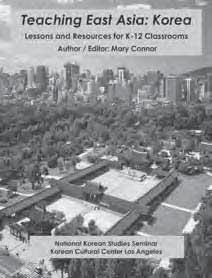
While this review is based primarily off a hard copy version of Teaching East Asia: Korea, an e-book version can be found on https://nationalkoreanstudies.com/. The e-book is freely available and includes links to many of the PowerPoints and images referred to in the text, making it easier for educators to incorporate those materials into their own classes. There are even videos of lectures from the free seminar made available for educators by the National Korean Studies Center, the organization that produced Teaching East Asia: Korea
Developing such an excellent resource as Teaching East Asia: Korea was most likely no easy task, as special consideration had to be made so as to make sure that everything could be seamlessly integrated into a classroom
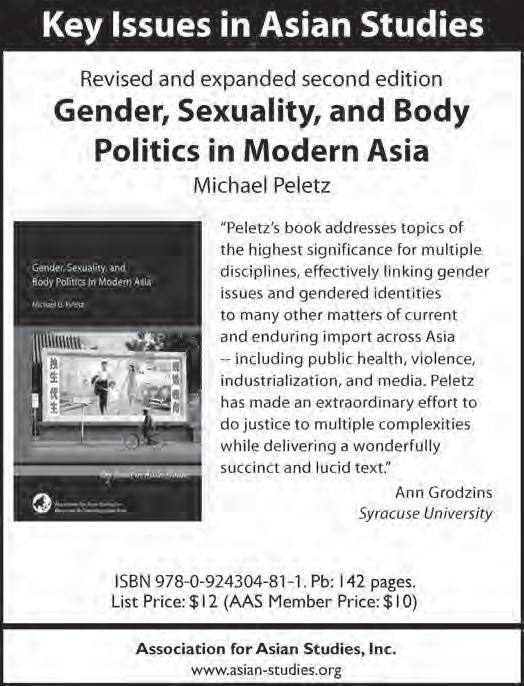
RESOURCES
BOOK REVIEW ESSAYS
282
RESOURCES BOOK REVIEW ESSAYS
bit.ly/asianow
the blog of the Association for Asian Studies



while following the necessary standards, something that this work does very well. Moreover, because of the close connection of the seminar and Teaching East Asia: Korea, it would seem that this work is very much a living document, and on that assumption, this reviewer will make a few comments regarding coverage and organization aimed at making this otherwise-excellent text even better. First, while the coverage is generally good, there is comparatively little on eighteenth-century Korea, which is considered a sort of golden age for art, literature, and philosophy. It might be helpful if relevant sections on that period were included. Similarly, while some material is included on Korea in the nineteenth and early twentieth centuries, much of it is focused on what people in other countries were saying about Korea and the justification of imperialism. More on internal attempts to maintain Korean independence and to “modernize” might be interesting and would help challenge the rhetoric of imperialism. And while the sections on the Japanese colonial period (1910–1945) are good, if possible, some excerpts from the excellent oral history Under the Black Umbrella, edited by Hildi Kang, would do much to show just how complex the relationship between individual Japanese and Koreans could be during that time.
ANALYSIS OF EVENTS AND TRENDS IN ASIA
A key resource for readers who want concise, accessible analysis of what’s happening in Asia at any given time.
ASSOCIATION AND CONFERENCE NEWS
Information about the annual conference and AAS-in-Asia, messages from the officers, member spotlight features, and other association news will be published at the blog.
PROFESSIONAL DEVELOPMENT INFORMATION

Religion is a subject that brings its own unique challenges, and though again, generally done well, it would be helpful if the chapter on that subject contained an additional section on religious practice, as many Koreans who do not belong to a religion will do such things as conduct ancestor rites or seek the services of a shaman. Similarly, the section on Buddhism is more of a general lesson on the morality of the religion (and one that seems to encourage that morality instead of simply examining it) rather than discussing how it is practiced in Korea. It should be noted that this work does mention in other sections the role Buddhism has played in Korean culture, history, and technology. Likewise, while the language chapter is interesting, it lacks clear guidelines for how it can be utilized in a classroom setting. In terms of organization, movie reviews on Chunhyang, J.S.A., and A State of Mind are in the final chapter on resources, when they might be better placed in an earlier relevant chapter. It also might be helpful if the DBQs and other lessons with handouts were available as separate PDF documents to make it easier to use them in class.
Such issues are relatively minor and do not detract in any material way from this work. Teaching East Asia: Korea is a highly useful resource for educators that clearly and concisely delivers accurate and relevant information with practical explanations on how to apply its lessons in a classroom setting in accordance with government-issued standards, often in creative and interesting ways. And considering that the e-book version of this text is freely available, any educator teaching K–12 who is interested in integrating Korea into their classes would find it well worth their time to have a look at this work.
FRANKLIN RAUSCH is an Assistant Professor in the Department of History and Philosophy at Lander University (Greenwood, South Carolina). He has written extensively on Korea, including a contribution, “Nationalists Movements before 1945,” to The Routledge Handbook of Modern Korean History
is
AAS seeks to support its members more in the professionalization process. posts will cover topics like publishing (in both the academic and non-academic spheres), graduate education, employment, working in a multi-disciplinary field, and other relevant matters as they arise. All about Asia’s #Trends #News #Info 283
Traditi onal and Cont empor ary Kore an Popular Cultur e Asia in Focus The Koreas
MARY CONNOR, EDITOR
ABC-CLIO, 2009
499 PAGES, ISBN 978-1-59884-160-2, HARDCOVER
Reviewed
by
Todd Golding
Anation torn asunder by Cold War animosity and ideologies is again united, at least in book form, by chief author and editor, Mary Connor. The latest release in a series on East Asia by publisher ABC-CLIO draws on the editor/author’s vast experience with Korea and taps into the expertise of five other Korea specialist co-authors. While these East Asian nations may unfortunately receive short shrift in our K-12 social sciences classrooms, Connor presents an airtight case that the peninsula has attained a primary importance we cannot ignore. The Koreas was written with teachers in mind (the editor is herself a veteran educator), but its in-depth and timely material offers business people, non-governmental organization (NGO) workers, military personnel, and anybody who intends to travel here an informative handbook for survival and success. The comprehensive, authoritative survey of Korean history will attract post-secondary Asian history scholars to consider this publication as a course textbook. Its scope, however, extends well beyond the peninsula’s past. From the first pages, we are immersed in everything Korean: politics, geography, food, music, language, art, and belief systems. Additionally, we take in a timely briefing on what could soon be one of the world’s ten leading economies.
Connor launches her ambitious volume with a detailed, yet engaging and accessible, description of Korean geography and its several thousand years’ traditions. Though later chapters progress to more current issues, each contributor continues to braid topics of East Asian history with vibrant descriptions of contemporary culture. Educators wishing to enrich their knowledge of this world region will appreciate the way authors guide the reader through several millennia of East Asian civilization. The accounts are enlightening and relevant to Korea’s role in the twenty-first century. This country’s unique heritage and deep-seated Confucian ethic are not mere curiosities of a bygone era, rather, the co-contributors demonstrate how these elements exert a fundamental influence on the lives of today’s Korean population and, in turn, the people who interact with Koreans.
The twentieth century saw the peninsula transformed into a paradox among the world’s countries—it is one nation but two states; it is perhaps the world’s most linguistically, ethnically, and culturally homogeneous population, yet it is of late the most physically and tragically divided. The North Korean conundrum is addressed in the history and politics chapters where readers are afforded a wide-ranging account of life in the world’s last Orwellian communist regime. Although the North receives the brunt of today’s negative press, we observe how the South, with its once byzantine political system, suffered its share of human rights woes for decades following the 1950–53 Korean War.
Extensive data tables, a glossary, an index of curricular resources, and a vast annotated bibliography make this collaborative effort the lat-
est, most relevant, and timely in-print resource on both the ROK and the DPRK. Anyone who has traveled to either or both of these states knows that both are rich in color. Though photos and illustrations are printed in black and white, the contributors’ captivating descriptions of the Korean people’s rich art, culinary, and other customs will no doubt move readers to take every opportunity to experience this colorful culture firsthand.
Short of a college “Korea 101” course or substantial study tour in country, this resource may be our best hope for comprehending a region that is increasingly catching world attention. Academics, Koreaphiles, travelers, and anybody with a stake in this part of Asia will greatly appreciate Mary Connor’s contribution. Her book offers a sound and thoroughly researched survey of Korea’s fascinating history and vividly shares with us its enduring magnificence. That this one country has, over the past sixty years, essentially become two radically different states adds another dimension to this remarkable project. The Koreas assesses both North and South in a balanced fashion yet affords each the individual attention it deserves. Crafting a great book about a great people must entail discipline, a sense of adventure, and something of the spirit of that nation. Exceptionally well researched, thoughtful, and highly practical, this work has to be a landmark accomplishment that showcases Connor’s passion for educating Westerners about the beauty and intrigue of the Korean phenomenon. Most importantly, The Koreas will help educators better understand this great culture, and give it the attention it merits. ■
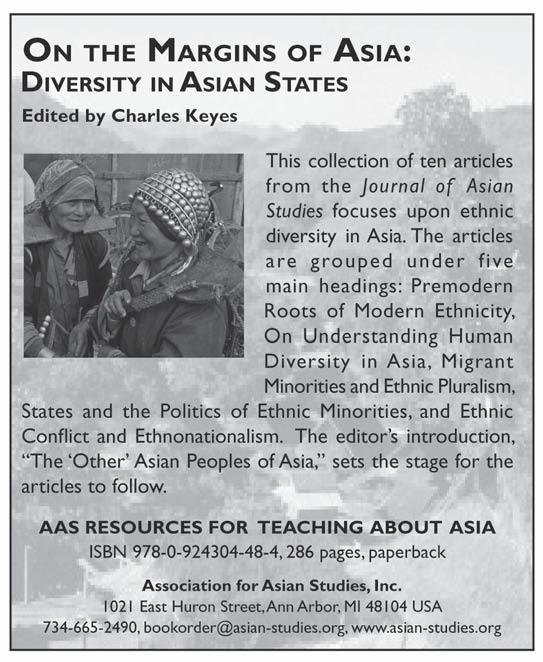
284
TODD GOLDING teaches World History, Advanced Placement World History, and Russian language at Jefferson High School in Lafayette, Indiana. He has done educational travel throughout the former Soviet Union, South America, Europe, and both Koreas.
Education About Asia
Teaching East Asia: Korea and Korean American History
1. Four Famous Koreans by Mary Connor (This is only part of what was published as Six Portraits in Volume 6.2 (Fall 2001).
2. Values Lesson Plan, How Currency Reveals Cultural Values by Mary Connor. Volume 18:1 (Spring 2013).
3. Admiral Yi Sun-Shin, The Turtle Ships and Modern Asian History by Marc Jason Gilbert. Volume 12.1 (Spring 2007).
4. Bringing Korea into the Curriculum: United States, World, and European History by Mary Connor. Volume 8.3 (Winter 2003).
5. Tears of Blood: A Korean POW’S Fight for Freedom, Family, and Justice by Mary Connor. Volume 18.2 (Fall 2013).
6. A Bully in the Classroom? Teaching Our Twisted Hero by Yi Munyol. Article by Constance Vidor. Volume 15:1 (Spring 2020).
7. Waxen Wings: The Acta Koreana Anthology of Short Fiction from Korea. Reviewed by Bruce Fulton. Volume 17.3 (Winter 2012).
8. History as Literature, Literature as History, Lost Names, Kathleen Woods Masalski, Interview of Richard Kim. Volume 4.2 (Fall 1999).
9. Brother’s Keeper by Julie Lee, Review by Mary Connor, Volume 26.1 (Spring 2021).
10. Using Korean Bojagi in the Classroom by Carrie Jeruzal, Volume 18.2, Fall 2013.
11. Korean Spirituality by Don Kim. Reviewed by Mary Connor. Volume 16.1, Spring 2021.
12. Korea in World History: Key Issues in Asian Studies by Donald Clark. Reviewed by Eric Cunningham. Volume 16.3 (Winter 2011).
13. Asia in Focus: The Koreas, Editor, Mary Connor. Reviewed by Todd Golding. Volume 15.1 (Spring 2010) Todd Golding was a fellowship recipient to our Korea seminar.
14. Asian Culture in the Classroom by Mary Connor. Volume 4.1 (Spring 1999).
15. Bringing Korean Films into the Classroom by Mary Connor. Volume 14.3 (Winter 2009).
16. Teaching East Asia: Korea: Lessons and Resources for the Classroom . Reviewed by Franklin Rausch. Vol. 23.1 (Spring 2018).
17. Silla and the Silk Road: Golden Age, Golden Threads, by Alan Whitehead. Volume 15.1 (Spring 2010).
285





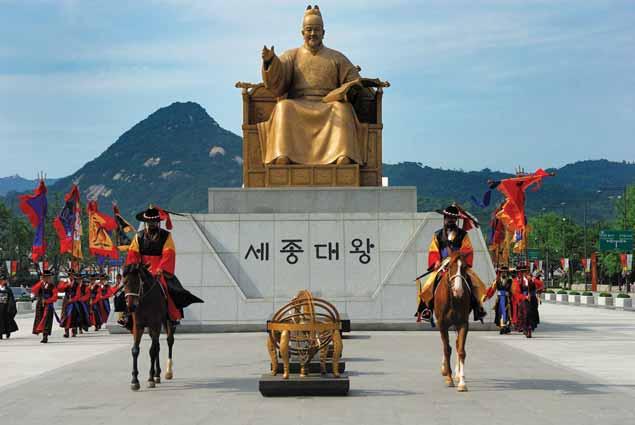
282 292















 Hall of Sokkuram Grotto, Gyeongju, 8th
Hall of Sokkuram Grotto, Gyeongju, 8th





















 By Mary Connor
By Mary Connor



 Yi I (Yulgok) 1536-1584: 5,000 won
Yi I (Yulgok) 1536-1584: 5,000 won















 By Young-Bok Yoo and Translated by Paul T. Kim Grades 8 and beyond
By Young-Bok Yoo and Translated by Paul T. Kim Grades 8 and beyond












 Chinese New Year Celebration with Dragon dancers and Tai chi Instructor
Chinese New Year Celebration with Dragon dancers and Tai chi Instructor






 DIRECTEDBY KANG JE-GYU DVD,140 MINUTES,2004,ENGLISH SUBTITLES
DIRECTEDBY KANG JE-GYU DVD,140 MINUTES,2004,ENGLISH SUBTITLES
































 Lucien Ellington
Lucien Ellington





 Reviewed by Tracy Kaminer
Reviewed by Tracy Kaminer



































 Lexi, twelfth grade. Image courtesy of author.
Nicholas, sixth grade. Image courtesy of author.
Students working on sewing bojagi. Images courtesy of author. Valory, eleventh grade. Image courtesy of author.
Lexi, twelfth grade. Image courtesy of author.
Nicholas, sixth grade. Image courtesy of author.
Students working on sewing bojagi. Images courtesy of author. Valory, eleventh grade. Image courtesy of author.











 What is LoveWinter SonataSome 5,000 Japanese fans filled an airport to welcome Mr. Bae in 2004
What is LoveWinter SonataSome 5,000 Japanese fans filled an airport to welcome Mr. Bae in 2004





 Big Bang
Big Bang
















 Left: Cheomseongdae, the oldest surviving astronomical observatory in Asia and possibly even the world; Right: Amazon CEO Jeff Bezos controls a giant Avatar-style robot “Method-2” built by a South Korean company, Hankook Mirae (Courtesy of Korea Daily)
Left: Cheomseongdae, the oldest surviving astronomical observatory in Asia and possibly even the world; Right: Amazon CEO Jeff Bezos controls a giant Avatar-style robot “Method-2” built by a South Korean company, Hankook Mirae (Courtesy of Korea Daily)



 Young students dressed in Korean traditional clothes, hanbok, on Korean American Day (Courtesy of Melissa Fox)
Young students dressed in Korean traditional clothes, hanbok, on Korean American Day (Courtesy of Melissa Fox)











 Seoul Night SceneHan RiverSubway in Seoul
Kyungbok-gungBukchonInsadong
Seoul Night SceneHan RiverSubway in Seoul
Kyungbok-gungBukchonInsadong





 Royal tombsGolden CrownAnapji pond
Bulguksa TempleSeoguram GrottoGyeongju Namsan Chilbumam Maaeseokbul
Royal tombsGolden CrownAnapji pond
Bulguksa TempleSeoguram GrottoGyeongju Namsan Chilbumam Maaeseokbul






 Dosan-SeowonFront gate of Dosan-Seowon
Hahoe VillageHahoe Byulsin-gut Mask Nori (performance)
Seorak Mt. in AutumnSeorak Mt. in WinterSunrise in the East Sea
Dosan-SeowonFront gate of Dosan-Seowon
Hahoe VillageHahoe Byulsin-gut Mask Nori (performance)
Seorak Mt. in AutumnSeorak Mt. in WinterSunrise in the East Sea






















